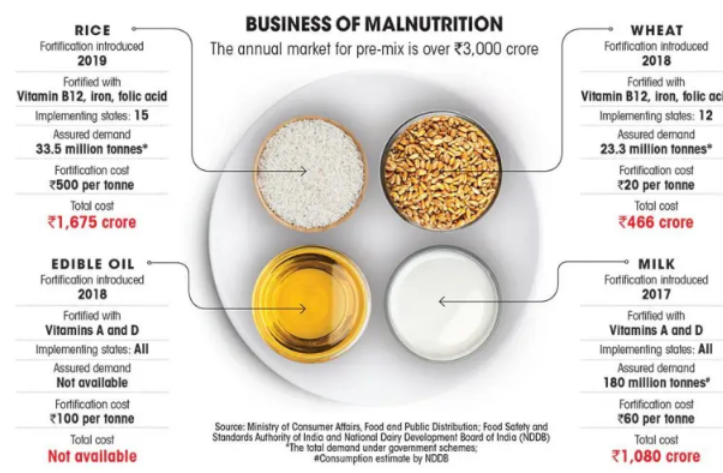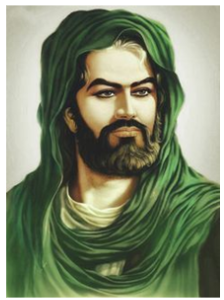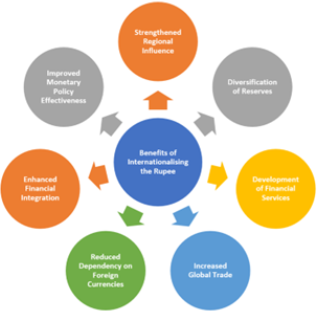September 2023 Current Affairs
Political Issue of Delimitation
In News: Recently, the Women’s Reservation Bill, providing 33 per cent quota to women in Lok Sabha and state Assemblies, was swiftly passed by both Houses of Parliament, but its fate hangs in balance because of its dependence on the delimitation exercise.
Delimitation:
- Delimitation is a Constitutional mandate, to be carried out after every Census, to readjust the number of seats and their boundaries on the basis of latest population data.
- But the number of seats for the Lok Sabha and state Assemblies has remained frozen for the last 50 years, due of opposition from political parties from the South. This is because the population growth rate in the northern Indian states is more as compared to the southern states.
- And they have no desire to enable delimitation even today, partly because this would result in a substantial increase in the number of Lok Sabha seats in the states of northern India, where population growth has been more pronounced.
Political connections between Women’s Reservation Bill and Delimitation:
- This bill provides 33 per cent quota to women in Lok Sabha and state Assemblies after delimitation.
- One of the reasons women’s reservation did not become a reality in the last 35 years was the fear among male politicians of having to let go of their seats.
- A 33 per cent reservation in the current 545-member Lok Sabha would mean 182 seats being kept for women. Only 363 seats would be available for men. The current Lok Sabha has 467 men.
- If, as a result of the delimitation exercise, the strength of the Lok Sabha increases to 770, as some calculations suggest, 257 seats would be reserved for women, and the remaining 513 could be available for men to contest.
- Linkage with delimitation could delay the implementation of women’s reservation even beyond 2029.
- Delimitation is a contentious issue. But now, a resistance to the delimitation exercise ahead of 2029 polls would give a handle to the BJP to accuse the Opposition of creating hurdles for the women’s reservation Bill
Some major concerns with Delimitation:
- The main rationale of delimitation is to ensure that every state has equitable representation in the Lok Sabha on the basis of its population, with the same logic running down within the states for Assemblies.
- In the 1977 Lok Sabha, for example, every MP in India represented about 10.11 lakh people, on an average. While there are large variations, especially in small states, the attempt is to keep this number in as tight a range as possible. But there is no restriction on what this number should be.
- If we attempt to retain the same number as in 1977, the strength of the Lok Sabha would have to be expanded to nearly 1,400, due to the increase in population. But the new Lok Sabha has been built with the maximum capacity of 888 seats. That means the average population size of every constituency would have to go up.
- The number of Lok Sabha seats in states like Uttar Pradesh or Bihar are likely to jump much more than south Indian states.
- If the delimitation exercise had happened after every Census, as mandated in the Constitution, seats for the north Indian states would have gone up progressively and not all of a sudden.
- Delimitation continues to be a political hot potato. By linking it with women’s reservation, BJP has tried to press its advantage, but the Opposition has not yet opened its cards.

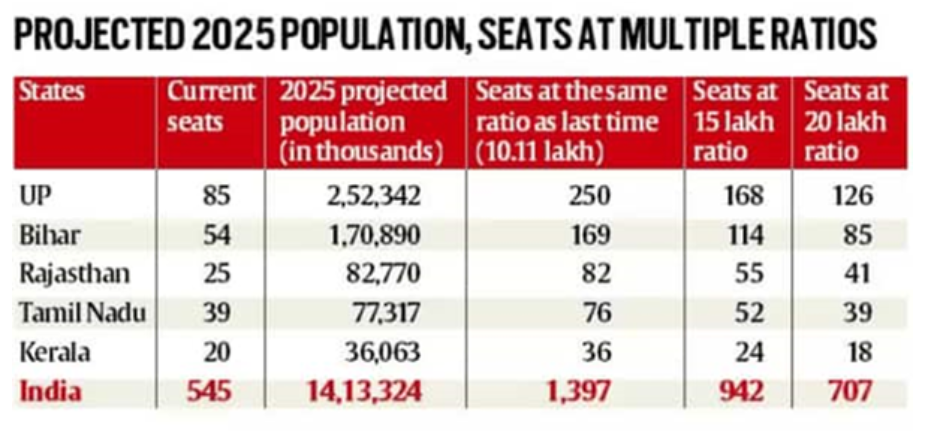
Immunity of legislators from bribery charges
In News: Recently, the Supreme Court has forwarded the question of whether legislators' legal immunity provided by Article 105(2) and 194(2) of the Constitution protects them from criminal prosecution in cases involving the offering or acceptance of a bribe to a seven-judge bench for consideration.
About
Article 105 of the Constitution:
- Article 105 deals with the "powers, privileges, etc. of the Houses of Parliament and of the members and committees thereof."
Article 105(2) of the Constitution:
- Article 105(2) states that no member of Parliament shall be subject to any legal proceedings in any court for anything said or any vote cast by them in Parliament or any of its committees.
- Additionally, no individual can be held liable for the publication, made under the authority of either House of Parliament, of any report, paper, votes, or proceedings.
Extension of Immunity under Article 105:
- This legal immunity extends not only to members of Parliament but also to certain non-members who participate in parliamentary proceedings, such as the Attorney General of India or a Minister who may not be a member but delivers speeches in the House.
Power of the Speaker:
- In cases where a member's speech or actions exceed the permissible boundaries of free speech, the Speaker of the House holds the authority to address such matters.
Article 194(2) of the Constitution:
- Article 194(2) extends the same immunity provided by Article 105(2) to Members of Legislative Assemblies (MLAs) in the states. This means that state legislators, like their counterparts in Parliament, are protected from legal proceedings in connection with their statements or votes within the state legislative bodies.
Current Legal Issue:
- The central question in the present case before the court is whether the legal immunity granted to parliamentarians and state legislators under Article 105(2) and Article 194(2) extends to protect them from prosecution in cases involving the demand for or acceptance of a bribe.
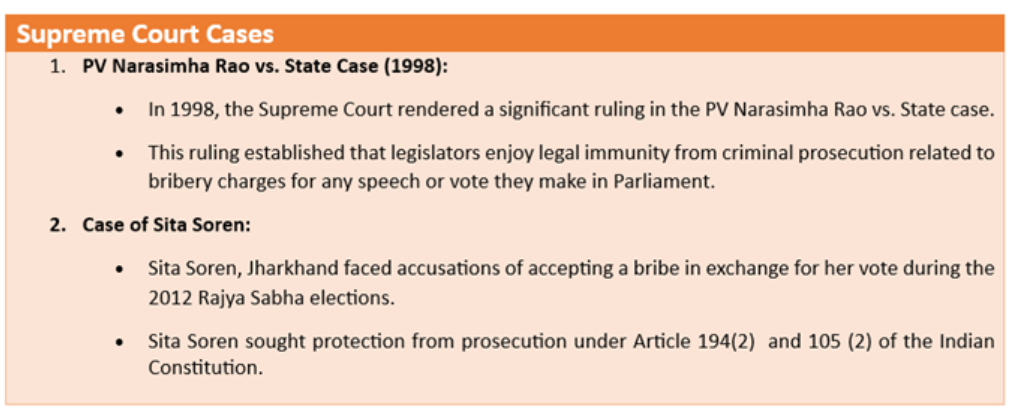
Parliamentary Conduct - Edukemy Current Affairs
In News: On the occasion of inauguration of the new parliament, the question of declining parliamentary productivity and deteriorating parliamentary conduct needs a reflection.
About Indian Parliamentary Democracy:
The parliamentary democracy of India has been patterned on the lines of Britain’s Westminster model. Few instances of continuing British traditions are:
- Indian MPs still thump their desks in approbation, rather than applauding by clapping their hands.
- Bills are put to a vote, an affirmative call is still usually “aye”, rather than “yes”
- Continuation of various British Parliamentary traditions in India such as Question hour and role of speaker.
Declining trend of Indian Parliamentary Conduct:
- Creating ruckus in assembly: Some of the State Assemblies have witnessed scenes of furniture overthrown, microphones ripped out and slippers flung by unruly legislators.
- Violation of Code of Conduct: The code of conduct applicable to all elected MPs such as including injunctions against speaking out of turn, shouting slogans, waving placards and marching into the well of the house etc. are routinely breached.
- Violent actions: Fisticuffs and torn garments have also been observed during scuffles among politicians in these assemblies. Pepper spray was once released in the well by a protesting MP, resulting in the hospitalisation of some MPs.
- Flouting of Parliamentary rules: MPs in the Upper and Lower Houses have been suspended from membership for such transgressions as charging up to the presiding officer’s desk, wrenching his microphone and tearing up his papers.
Shrinking space for opposition:
- Less space for opposition’s views: In a system where party-line voting is made obligatory by the anti-defection law, standards have been allowed to slide, with adjournments being preferred to expulsions.
- Democratic system under assault: Overweening government, media intimidation, the hollowing out of autonomous institutions and pressures by investigative agencies on political has made it difficult for opposition to present their views.
- Erosion of Parliamentary conventions: All major parliamentary committees dealing with sensitive issues are chaired by MPs of the ruling party or its allies, in disregard of conventional practice where opposition members headed the committee. Example External Affairs Committee was always chaired by an Opposition MP, to show that the nation was of one mind on foreign policy.
Reforms in the Parliamentary Process:
- Opposition Day: Opposition sets the agenda of a day in week a day. It permits Opposition parties to select specific policy areas or issues they want to bring to the floor of the House for debate. These debates allow the Opposition to focus on matters of political significance.
- It provides Opposition parties with the opportunity to draw attention to issues they believe are important, criticise government policies, and propose alternatives.
- Prime Minister’s Question Time (PMQs): It provides MPs an opportunity to question the Prime Minister about various issues and increases the accountability of the executive.
- Speaker’s Role: The Speaker should reconsider the frequent rejection of adjournment motions and the practice of grouping proposed amendments to bills for voice votes without discussion.
Nari Shakti Vandan Adhiniyam 2023/ Women Reservation Bill
In News: Women Reservation bill aka Nari Shakti Vandan Adhiniyam 2023 was passed in both Lok Sabha and Rajya Sabha with almost unanimous support (2 dissents in Lok Sabha).
About Nari Shakti Vandan Adhiniyam 2023
- The 128th Constitution Amendment Bill, was introduced in Lok Sabha and passed with more than two third majority. The Rajya Sabha witnessed unopposed passage of the bill.
- Now half of the state legislatures need to ratify the bill with a simple majority to enact the bill after the president's approval.
- Key Provisions of the bill are:
- Reservation Percentage and sub categorization: It provides reservations to one third of all seats for women in the Lok Sabha, the state legislative assemblies and the Legislative Assembly of the NCT. The reservation will also extend to the seats reserved for SCs and STs in Lok Sabha and state legislative assemblies.
- Commencement of reservation: The reservation will be effective once the census conducted after the commencement of this Bill has been published. Based on the census, delimitation will be undertaken to reserve seats for women.
- Duration of reservation: Reservation provided for a period of 15 years. However, it shall continue till such date as determined by a law made by Parliament.
- Rotation of Seats: Seats reserved will be rotated after each delimitation, as determined by a law made by Parliament
- Amendments in the articles of Constitution:
- Article 330A and 332A inserted for one third reservation in Lok Sabha and State Assemblies respectively.
- Article 330A inserts a clause for reserving one third of seats for women within SC and ST category seats of Lok Sabha.
- Article 239AA inserts a subsection reserving seats for women in the legislative assembly of NCT of Delhi.
History of Women Reservation Bill:
- National Movement: The demand for political reservation of women was first raised during the freedom struggle, when three women bodies sent a letter to the British Prime Minister in 1931 seeking political reservation for women.
- Constituent Assembly Debates: The issue of women reservation also came up in Constituent Assembly debates. But it was rejected saying that democracy is expected to give representation to all groups.
- Committee of the Status of Women 1971: The committee recommended the reservation of women in local bodies.
- The National Perspective Plan for Women in 1988: This plan also recommended the reservation of women in local bodies. Consequently, 73rd and 74th Constitutional amendments, mandated all State governments to reserve one-third of the seats for women in local bodies.
- Efforts by different political Parties: The Women Reservation Bill was first introduced in 1996 as 81st Constitutional Amendment Bill. However the bill got lapsed. Later it was reintroduced in 2003, 20004 and 2010 but could not be passed due to several objections.
Arguments in the Favour of the enactment of Women Reservation Bill:
- Political empowerment of women: According to the Inter-Parliamentary Union (IPU) report India ranks lower than 140 other nations in terms of women representatives in the national legislatures. Reservations would empower women and provide an increased voice of women in policy making.
- Significance of Women Leadership: Empirical evidence shows that women leaders focus on public goods related to women’s concerns. Women legislators have been associated with improved economic outcomes and infrastructure development.
- Decriminalization of politics as currently 159 MPs with charges of rape, murder, crime against women allegations in parliament. It can potentially reduce the presence of politicians with serious criminal charges.
- Breaking stereotypical role of women: With more representation of women the perceived role of women as homemakers would break and give them more respect and voice in the society.
- Breaking Patriarchy: Political representation would promote gender equality in political leadership and increase their self-worth.
Arguments against the Women reservation Bill:
- Concern of no separate OBC reservation: Bill provides reservation to SC & ST women within the existing one third reservation of seats. However OBC women constituting 60% of women population have not been provided separate reservation within the 33% reserved seats.
- Reservation in Rajya Sabha and legislative Councils: Bill does not reserve seats in Rajya Sabha and Legislative councils which are being disputed.
- Delayed Enactment of the Bill: Reservation for women in Parliament depends on the census and delimitation process. This can make actual implementation of the act politically sensitive.
- Women as proxies: Similar to the trend of Pradhan Patis, Parishad patis, etc. it is feared that MP Pati and MLA pati system could emerge where women are just proxies of their male counterparts.
- Homogeneity of Women as a group: Women are not a homogenous community like caste groups, making comparisons with caste-based reservations inappropriate.
Parliamentary conduct - Edukemy Current Affairs
In News: The members of India's Parliament frequently cause disturbances, which is characterised by their propensity for disruption over discussion. This undermines the efficacy and credibility of the legislative body and raises questions about the democracy in India.
Indian Parliament:
- The Parliament of India is the top legislative body of the Union government.
- Due to the adoption of the Parliamentary form of Government (often known as the "Westminster" model of government), it holds a dominant and important role in the Indian democratic political system.
- Part V of the Constitution deals with the organisation, membership, length, officials, processes, privileges, and powers of the Parliament in Articles 79 to 122.
- The Lower House (Lok Sabha), the Upper House (Rajya Sabha) and the President are the organs of the Indian Parliament.
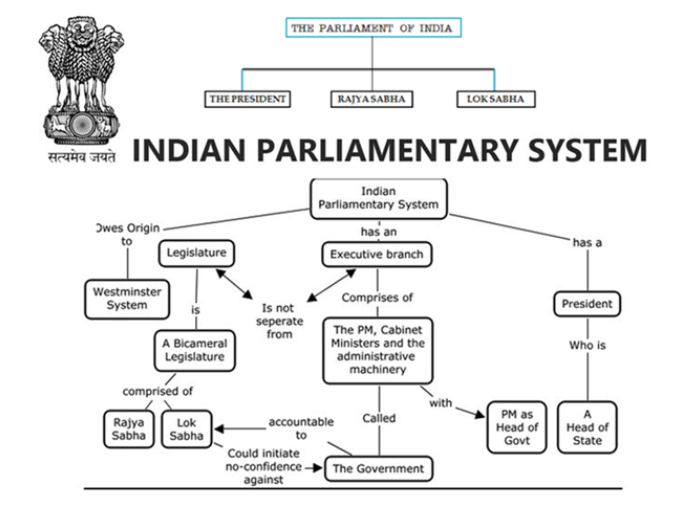
Issues in the Indian Parliament:
- Frequent Disruptions: Instead of participating in productive debates, MPs engage in disruptive activity.
- Declining Standards: Legislators frequently violate the rule of conduct, and parliamentary misbehaviour has become worse over time.
- Impunity: There is a culture of impunity among legislators since their violations of the law frequently go unpunished.
- Credibility Concerns: Disruptive behaviour may have damaged Parliament's legitimacy in the eyes of the people.
- Inadequate Opposition Influence: Due to party-line voting and the anti-defection rule, opposition MPs have difficulty in influencing legislative decisions. While interruptions are accepted in order to give the opposition room, moral standards have been lowered.
- Role of Speaker: Opposition representation is hampered by the Speaker's denial of adjournment motions, amendments, and division votes.
- Potential Damage to Democracy: The legitimacy of India's democracy might be damaged by frequent disruptions and deteriorating quality.
Probable Solutions for the issues:
- Through seminars and training, create a culture of productive discourse.
- Senior lawmakers should lead by example by maintaining the highest ethical standards during discussions and debates.
- Make sure that repercussions for wrongdoing are consistently applied, irrespective of party affiliation.
- Transparency, responsibility, and respect for legislative procedures will help to rebuild public trust.
- Establish consistent Prime Minister's Question Time (PMQs) to promote conversation and accountability.
- Granting the opposition access to establish the debate's agenda on a specific day each week.
- Enable spirited debates and guarantee the Speaker's judgments are unbiased.
- Put democratic principles and ideals first in order to win back the public's trust in the Parliament.
Business Responsibility and Sustainability Reporting (BRSR)
In News: IICA and UNICEF jointly organize a workshop on Business Responsibility and Sustainability Reporting (BRSR)
About
- In 2021, SEBI (Securities and Exchange Board of India) introduced the Business Responsibility and Sustainability Reporting framework.
- This framework requires the top 1000 publicly listed companies in India to disclose their performance across a range of environmental, social, and governance (ESG) dimensions.
- It draws its foundation from the nine principles outlined in the National Guidelines for Responsible Business Conduct (NGRBC).
What is Environmental, Social, and Governance (ESG)?
- Environmental, Social, and Governance (ESG) goals are standards for ethical, sustainable business practices.
- They cover environmental stewardship, social responsibility towards employees and communities, and effective corporate governance, including leadership and shareholder rights.
Fraternity in India - Edukemy Current Affairs
In News: Fraternity does not mean anything if it glosses over social inequalities and then invokes social solidarity.
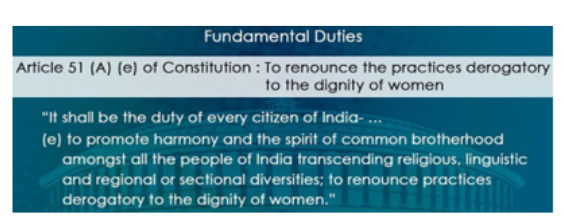
About the origins of ‘fraternity’
- In Plato’s Lysis, the philosopher invokes the word philia (love) for the strong desire to pursue wisdom.
- That is, love and friendship with others become more meaningful through the sharing of knowledge.
- The emphasis is on ‘share’ which gives us an early idea of the discourse of fraternity in ancient Greece.
- In Aristotle, we see the emergence of the polis, the logical location of a man who remains, first and foremost, a political being, and hence is part of the polis and not of the wild.
- Justice and friendship among citizens came to be the most enduring features of the polis.
- This here, is the birth of the idea of political fraternity.
- In the Middle Ages, fraternity flourished mostly through religion, within the churning of Christian society in Europe.
- The concept of fraternity then eventually found its entry into politics with the French Revolution of 1789 in the triptych of ‘liberté, égalité, fraternité’.
Why did India adopt fraternity?
- India’s independence struggle and the subsequent emergence of constitutional democracy saw the necessity of liberty, equality, and fraternity.
- In this context, Ambedkar’s stress on the inseparability of the three ideas and the underlining of fraternity cannot be emphasized enough.
- It was also necessitated by a complex Indian society at the precipice of becoming an independent republic, divided on the basis of various hierarchical social inequalities.
What is the status of fraternity in India today?
- Neglect of fraternity
- Fraternity happens to be the constitutional value that has received the maximum neglect both in the world of ideas and in the political field of action.
- The current nature of India’s fraternity is different from the political fraternity espoused in its Constitution.
- Lack of shared past
- In community ties, as M. C. Williams in The Idea of Fraternity in America (1973) explains, one sees an integral value system which is the foundation of the idea of fraternity.
- The privileging of the idea of community and the moral values associated with it, over the individual, gradually gave way to religious morality and its associated ‘way of life’.
- This elementary dimension of fraternity is missing when we assess fraternal ties in India.
- For, in order to have fraternal bonding between individuals, they must have an amicable shared past, not drawn from ideological differences rooted in the vast social inequalities among different communities.
- The shared history of India is marred by the caste system, and it militates against the principle of equality as well as the idea of liberty.
- But the Constitution privileges the individual, ensconced in the liberty, equality, and fraternity troika, leading to everyday conflict with the community.
- Therefore, the only conception of fraternity feasible for India must be rooted in politics. It is the only realm where caste privilege can be challenged.
- The ‘difference principle’
- John Rawls in his Theory of Justice (1971), stressed his ‘difference principle’. It works towards maintaining certain equality in order to realize political fraternity.
- The idea was and still is to create a level playing field between varying social groups, locked in structural hierarchies, to begin to understand what it takes to really actualize fraternal relations.
- In the absence of this crucial understanding, what we have is caste consciousness of unity, which remains aloof to members of other caste groups, and is often hateful to members of so-called lower caste groups in particular.
- India essentially then has fraternity within its caste communities, where forging political unity remains a forlorn goal.
What are the limits to fraternity?
- Glossing over social inequalities and then invoking social solidarity, turns fraternity futile.
- The call of such a fraternity is increasingly replaced with the rhetoric of belligerent nationalism which castigates a homegrown religious minority as its arch-enemy.
- Any sort of fundamentalism jettisons the possibility of fraternity.
- A fanatic can be anything but fraternal in the true sense.
In India, caste and the idea of political fraternity, given its social milieu, cannot coexist. One has to give way for the other to emerge.
Export Control of Dual-Use Items
In News: Recently, the Director General of Foreign Trade emphasized the government’s commitment to enhanced export control of dual-use items to prevent them from falling into the hands of non-state actors and terrorists.
About:
- These are items, technologies, materials, or equipment that serve both civilian and military or restricted purposes. While they are primarily designed for civilian use, they can also be employed for military or other prohibited uses. Some examples include precursor chemicals like sarin gas and components like centrifuges.
- Currently, the Directorate General of Foreign Trade (DGFT) in India compiles a specialized list known as SCOMET (specialty chemicals, organisms, materials, equipment, and technologies) that encompasses these dual-use items. These items are subject to regulation in accordance with India's Foreign Trade Policy.
- The new foreign trade policy places a strong emphasis on streamlining the SCOMET licensing process. This is done to ensure that sensitive and dual-use goods are traded in full compliance with international agreements, including the Missile Technology Control Regime.
Missile and Dual-Use Export Control Regimes
- These are cooperative agreements established by major supplier nations with the goal of averting the spread of specific military and dual-use technologies, especially those associated with Weapons of Mass Destruction (WMD).
- These agreements operate separately from the United Nations and are exclusively binding on the nations that are part of them, without imposing any obligation on non-member countries to participate.
India is a member of three out of the four MECRs, excluding the Nuclear Suppliers Group.
The four MECRs include:
- Nuclear Suppliers Group (NSG) for nuclear technology control
- Australia Group (AG) for chemical and biological technology control
- Missile Technology Control Regime (MTCR) for rockets and aerial vehicles related to WMD delivery,
- Wassenaar Arrangement for conventional arms and dual-use goods and technologies
Gramodyog Vikas Yojana - Edukemy Current Affairs
In News: Recently, The Chairman of the Khadi and Village Industries Commission (KVIC), recently, distributed toolkits and machinery to artisans in Bhubaneshwar, Odisha, as part of the Gramodyog Vikas Yojana.
About:
- During this event, Electric Wheels were distributed to 100 potters, Footwear Toolkits were provided to 75 Leather Artisans and Paper Massey Machines were given to 60 artisans.
Gramodyog Vikas Yojana (GVY)
- Gramodyog Vikas Yojana was launched in March 2020.
- It is one of the two components of Khadi Gramodyog Vikas Yojana, which aims to promote and develop the village industries through common facilities, technological modernization, training etc.
- The other component of Khadi Gramodyog Vikas Yojana is the Khadi Vikas Yojana (KVY) which includes two new components such as Rozgar Yukt Gaon, Design House (DH).
- Included Activities:
- Agro Based & Food Processing Industry (ABFPI)
- Mineral-Based Industry (MBI)
- Wellness & Cosmetics Industry (WCI)
- Handmade Paper, Leather & Plastic Industry (HPLPI)
- Rural Engineering & New Technology Industry (RENTI)
- Service Industry
- Components
- Research & Development and Product Innovation
- Capacity Building
- Marketing & Publicity
|
KVIC |
|
Significance and legacy of Parliament in India’s democracy
In News: Recently, the Speaker said that Parliament has created an elegant symphony of democracy, that rises above the occasional.
About
The Indian Parliament is the highest deliberative body and supreme representative institution of the largest working democracy in the world. It is in its Chambers that the destiny of a nation of a billion-plus people is shaped, and their expectations, concerns, problems, and dreams are fulfilled. It is in this temple of democracy that the members of the two Houses of Parliament keep the Executive accountable at all times and closely monitor the policies and programs for national welfare.
Significance of Parliament in India’s democracy:
- Historical Legacy: Deeply rooted in India’s historical and cultural heritage, reflecting participative governance for millennia. For example, India is widely regarded as the “mother of democracy”. Ancient texts and local self-governance traditions—Sabhas, Samitis, Republic.
- Founding Fathers’ Vision: India’s founders had faith in people’s wisdom, leading to the adoption of an enlightened Constitution. For example, adoption of a democratic system post-independence.
- Accommodative Democracy: Effective management of conflicts, celebration of diversity, and promotion of unity for development and prosperity. For example, Unity in diversity is a fundamental national ethos.
- Watchdog of Public Exchequer: Oversight of public finances, budget approval, and accountability of the Executive. For example, Approval of budgets and financial allocations.
- Voice of the People: Platform for citizens to raise concerns, and promote socio-economic change through legislation and debates. For example, the issue of the Manipur crisis discussed in Parliament sessions.
- Living Institution: Vibrant representation of the will of over a billion Indians, dedicated to citizens’ welfare and unity. For Example, Consistent legislative work for national progress.
- Symphony of Democracy: Creation of an elegant symphony of democracy, upholding constitutional values and national interests. For example, successful parliamentary functioning despite disagreements.
- Evaluation by Parliamentary Committees: Detailed scrutiny of bills, budget proposals, and ministries, enhancing oversight and accountability. For example, Committees’ role in policy evaluation and formulation.
- Autonomy and Parliamentary Privileges: Protection of members’ autonomy and dignity through immunity and privileges for free expression. For example, Immunity from prosecution for parliamentary speech.
- Accountability: Parliament is entrusted with securing accountability of the Executive through various instruments such as the Rules of Procedure and Conduct of Business, tradition and well-settled precedents.
- Empowering the Grassroots: India's democracy is not confined to the national level alone; it extends to the grassroots through a vibrant system of local self-governance. For example, Panchayati Raj institutions in decentralizing power and involving citizens in the decision-making process.
- Use of Technology: In the digital age, technology has transformed the way democracy’s function. Technology makes parliamentary proceedings more accessible to the public and bridge the gap between citizens and their elected representatives.
Parliament shows the enduring elegance of Indian democracy, emphasizing unity in diversity, resilience, cooperation, accountability, and technological progress. India's democratic model continues to inspire and serves as a testament to the enduring strength of democratic principles.
|
KVIC |
|
Issue About RTI - Edukemy Current Affairs
In News: Activists raises concerns about the dilution of the Right to Information (RTI) over the years
About issues with RTI:
- The Right To Information (RTI) Act was enacted in 2005 to grant citizens the right to request access to government-held data, documents, and information.
- It empowers citizens to access information to identify delays in public works, shortcomings in welfare schemes, and provided insights into government decision-making.
- Previously, India's RTI Act has been hailed as one of the world's most comprehensive public records access legislations.
- Major issues:
- The RTI (Amendment) Act, 2019 gave the Union Government unilateral power to decide the tenure and salaries of information commissioners who handle appeals against unsatisfactory RTI responses.
- The effectiveness of the RTI Act depends on subordinate Rules made by both the Union Government and State Governments, leading to inconsistencies in implementation.
- The choice of payment method for filing RTI requests varies by state, with some, like Tamil Nadu, not accepting convenient options like Indian Postal Orders.
- Delays in appointing information commissioners in Central and State Information Commissions have undermined confidence in the RTI framework, resulting in prolonged appeals.
- Amendments to RTI Act:
- The Digital Personal Data Protection Act, 2023, amended the RTI Act by introducing a blanket ban on disclosing personal data, raising concerns about transparency.
- The National Campaign for Peoples' Right to Information (NCPRI) highlighted that this amendment could hinder 'social audits' in ration distribution, preventing citizens from verifying beneficiaries.
- The amendment also raises concerns that powerful public officials could evade accountability by using the ban on disclosing personal information.
- While online RTI applications simplify the process, not all states have online portals, and some government bodies are not registered on these platforms.
- The Union Government's RTI portal, launched in 2013, has experienced technical issues, including the disappearance of past data and the removal of the account creation feature.
- There is a rising trend of first appeals being filed, indicating increasing dissatisfaction with the information provided by public officials.
- Weakening of the RTI Act is not solely due to changes in the law's text but also stems from institutional and implementation issues, hindering citizens' ability to conveniently access information.
- Concerns have also been raised about the RTI Act's limited applicability and broad exemptions for political parties, the judiciary, and intelligence agencies.
- Overall, there is need to increase the effectiveness of the RTI Act in holding public officials accountable and improving the transparency in functioning of Union and State Governments.
Special Session” of Parliament
In News: Union government announces a 'Special Session of Parliament'
About Special session of Parliament:
- The term "special session" is not defined in the Constitution and is typically used for specific occasions like commemorating milestones.
- Previously, a committee in 1955 proposed a parliamentary session timetable, but it was never implemented.
- As India's Parliament does not have a fixed calendar of sittings, the union government decides when Parliament meets, and the Cabinet Committee on Parliamentary Affairs makes these decisions.
- The President is informed about the committee's decision, and Members of Parliament are summoned accordingly.
- The Constitution mandates that no more than six months should elapse between two parliamentary sessions.
- This provision was borrowed from the Government of India Act of 1935, aiming to prevent excessive taxation and evade legislative scrutiny.
- Article 352 (Proclamation of Emergency) mentions a "special sitting of the House," added through the Constitution (Forty-fourth Amendment) Act, 1978.
- It outlines procedures for convening a special meeting in the event of an Emergency if Parliament is not in session.
Key features:
- A special session of Parliament is a unique and distinct session convened for specific purposes and occasions outside of the regular parliamentary calendar.
- These are often called to address pressing legislative matters that cannot wait until the next regular session such as emergency laws, financial bills, or critical policy decisions.
- It can also be convened to commemorate significant national milestones, anniversaries, or historical events of national values.
- In some cases, the Constitution or legal provisions may require a special session for specific purposes, such as the President's address at the beginning of a new parliamentary term.
- Special sessions follow the same parliamentary procedures as regular sessions including debates, voting, and discussions on bills and resolutions.
- The presiding officers of both Houses of Parliament—Lok Sabha and Rajya Sabha—oversee the proceedings during special sessions.
- The duration of a special session can vary widely, depending on the agenda and the issues being addressed.
- Before independence, the central assembly met for around 60 days a year, which increased to 120 days annually in the early post-independence years.
- Previously, various bodies including the conference of presiding officers and the National Commission to Review the Working of the Constitution, have recommended increasing the number of sitting days.
- The US Congress and parliaments of countries like Canada, Germany, and the UK meet throughout the year with fixed sitting day calendars.
- Overall, these sessions help government in pushing legislative agenda however, as it is not explicitly defined in the Constitution there is need to bring more transparency and consensus in its implications.
One Nation, One Election
In News: The Centre set up an eight-member committee to examine various legal and logistics aspects for implementing the “one nation, one election” idea.
The Law Ministry has outlined seven terms of reference which include examining if a constitutional amendment to facilitate simultaneous polls would have to be ratified by the states.
About Simultaneous Elections/ One Nation, One Election:
- Simultaneous Elections refer to restructuring the Indian election cycle in a manner such that elections to Lok Sabha and State Assemblies are synchronized together. Elections to Local bodies, which is a state subject, are not included in it.
- The current electoral system holds separate polls for the Lok Sabha and state assemblies in a gap of five years, aligned to the respective conclusion of their five-year tenure.
- If India implements simultaneous elections, India would be the fourth country to do so after Belgium, Sweden, and South Africa
- Historically, Parliament and state elections were held simultaneously until 1967, but over the years as Assemblies and Lok Sabhas were dissolved before the end of their terms, the elections fell out of sync with each other.
Need for simultaneous elections:
- Frequent elections: Elections are held in one or more states every year. Frequent elections divert precious time, energy, and resources of the nation and slow down developmental processes.
- Implementation of Model Code of Conduct: Elections in states lead to the imposition of the Model Code of Conduct (MCC), which puts on hold the entire development programme and activities. Simultaneous elections would ensure consistent governance.
- Affects social unity: Elections are also polarising events that perpetuate caste, religion, and communal issues because candidates are often forced to talk politically for the sake of electoral benefits. Simultaneous elections would prevent such incidents.
- Reduced manpower: Crucial manpower is often deployed on election duties for a prolonged period of time. If simultaneous elections are held, then this manpower would be made available for other important tasks.
- Reduced disruption of Public Life: Continuous election has an impact on the functioning of essential services. Simultaneous elections will limit the disruption to normal public life associated with elections such as rallies and traffic problems.
- Provision for alternate government: The Law Commission has recommended that a no-confidence motion against a government should be followed by a confidence motion so that if the Opposition doesn't have the numbers to form an alternative government, the regime in office cannot be removed.
Challenges in implementing simultaneous polls:
- Logistics challenges: Currently there are only 13.06 lakh control units (CUs) and 17.77 lakh ballot units (BUs) of EVMs. Simultaneous elections would require 30 lakh EVMs and VVPAT machines
- Confusion for voters: Limited knowledge of voters about the process and lack of clarity about varying national and state issues might make the voters vote for the same parties at the Centre and State. This could result in marginalising regional parties.
- Lack of manpower: There is a dearth of enough security and administrative officials to conduct simultaneous free and fair elections throughout the country in one go.
- Complex Legislative Process: To implement the new election rules, five articles in the Constitution and Representation of the People Act (1951) would have to be amended. Every recognised state and national party would also have to agree to the change.
- Against federal spirits: Assembly elections deal with local issues and parties are judged in the context of their work done in the state. Clubbing them with the general election could lead to a situation where the national narrative submerges the regional developments.
- Against multi-party democracy: Simultaneous elections may favour national parties and specially the parties in power which have more resources, potentially marginalising regional parties and issues.
Way Forward
- As per the recommendations of the Parliamentary Standing committee, elections to some legislative assemblies whose term end within six months to one year before or after the election date could be held during the midterm of Lok Sabha .For the rest of the states, elections could be held along with the general elections to Lok Sabha.
- Accomplishing one year, one election could be the first step towards one nation, one election.
“RAISE” for Business
In News: Recently, Prime Minister Shri Narendra Modi addressed the B20 Summit India 2023 in New Delhi.
Background:
- The Business 20 (B20) is the official G20 dialogue forum with the global business community.
- Established in 2010, B20 is among the most prominent Engagement Groups in G20, with companies and business organizations as participants.
- The B20 works to deliver concrete actionable policy recommendations to spur economic growth and development.
B20 Summit India 2023:
- The B20 Summit India is a platform for policymakers, business leaders, and experts to discuss policy recommendations for G20.
- Its theme is R.A.I.S.E – Responsible, Accelerated, Innovative, Sustainable and Equitable Businesses.
- R- Emphasizes the need for businesses to act responsibly and consider their impact on society and the environment.
- A- Refers to the need for businesses to drive economic growth and development through rapid progress and innovation.
- I- Highlights the importance of innovation in business strategies to adapt to changing global dynamics.
- S- Advocates for businesses to adopt practices that ensure long-term sustainability for both the economy and the planet.
- E- Focuses on promoting fairness and inclusiveness in business practices, ensuring benefits are shared widely.
Key Points:
- PM said it is about humanity, and about ‘One Earth, One Family and One Future’.
- The PM also proposed the idea of an “International Consumer Care Day” to strengthen trust between businesses and consumers.
- The Prime Minister emphasized India’s role in creating a trusted global supply chain and promoting sustainability.
- He called for businesses to go beyond profit and focus on supply chain resilience and sustainability.
‘Self-respect’ marriages
In News: Overview of the Supreme Court's order on the validity of 'Self-Respect' Marriages
About 'Self-Respect' Marriages:
- Supreme Court has recently clarified that there is no blanket ban on advocates solemnizing 'self-respect' marriages under Section 7(A) of the Hindu Marriage Act, 1955.
- The aim was to simplify weddings, allowing declarations in the presence of friends or family, and eliminating traditional ceremonial requirements.
- Key features:
- 'Self-respect' marriages, also known as "suyamariyathai" or "seerthiruththa marriage," are solemnized between two Hindus.
- Amendment to Hindu Marriage Act in Tamil Nadu in 1968 introduced Section 7-A, recognizing "self-respect and secular marriages."
- Section 7-A allows marriages in the presence of relatives or friends, with a simple ceremony like exchanging garlands or rings.
- Under these marriages, the willing parties declare each other as husband and wife using a language understood by them.
- It legally acknowledges marriages between Hindus conducted without the need for priests, holy fire, or rituals and requires registration as per the law.
- Previously, in 2014 Madras High Court deemed such marriages invalid and stated that they couldn't be conducted in secrecy and declared such marriages conducted by advocates as invalid.
- Overall, the recent Supreme Court clarification affirms the legality of 'self-respect' marriages under the Hindu Marriage Act and upholds the principles of personal choice in marriage ceremonies.
Minority Scholarship Scheme Scam
In News: Central Bureau of Investigation (CBI) Registers FIR: Minority Scholarship 'Scam' Causing Rs 144 Crore Loss
About Minority scholarship scheme scam:
- The CBI on findings of National Council of Applied Economic Research (NCAER) has recently registered an FIR related to a minority scholarship 'scam’ involving 830 "fake" institutions.
- These institutions were benefiting from the Pre-Matric Scholarship Scheme, resulting in a loss of over Rs 144 crore to the Ministry of Minority Affairs between 2017-18 and 2021-22.
- Key findings:
- The scholarship focuses on the Pre-Matric Scholarship Scheme for minority students with annual family income below Rs 1 lakh.
- Scholarships are awarded in two tiers viz., Class 1 to 5 students receiving Rs 1,000 per year, while Class 6 to 10 students receiving Rs 10,700 (hostellers) or Rs 5,700 (day scholars).
- Investigation has exposed collusion involving brokers, bank correspondents, school staff, and state government employees.
- The losses have been calculated for the period with "clean digitized data on NSP," but applicants from these institutions may have availed scholarships in earlier years.
- The findings highlight the misuse of the National Scholarship Portal (NSP) and the Public Finance Management System (PFMS) leading to fraud and corruption in scholarship distribution.
- Common irregularities included non-operational institutions benefiting from the scheme, fake beneficiaries, and manipulation of UDISE details.
- In Bihar cybercafé owners listed as INOs have likely submitted fake applications for coaching center students.
- Some schools in Madhya Pradesh reported registrations for students beyond Class 7, even though they were not recognized after that grade.
- Overall, the scholarship scam serves as a stark reminder of the challenges and the need for safeguarding public resources beside continuous vigilance to prevent such incidents in the future.
Fali S Nariman on Basic Structure Doctrine
In News: It was only in Kesavananda Bharati case (April 1973), that by a narrow majority of 7:6, in a bench decision of 13 judges, the basic structure doctrine was propounded and since then the basic structure doctrine has not been debated.
Basic Structure Doctrine:
- The doctrine of basic structure is a judicial innovation that puts a limitation on the amending powers of the Parliament.
- The doctrine was propounded by the Supreme Court in Keshavananda Bharati v. State of Kerala (1973) and its objective is to ensure that the basic features of the Constitution remain unaltered and to preserve the core identity of the Constitution.
- It was Influenced by German expert Dietrich Conrad’s 1965 speech, emphasizing that a constitution’s foundational pillars shouldn’t be modified by the governing entity.
Evolution of Basic Structure Doctrine:
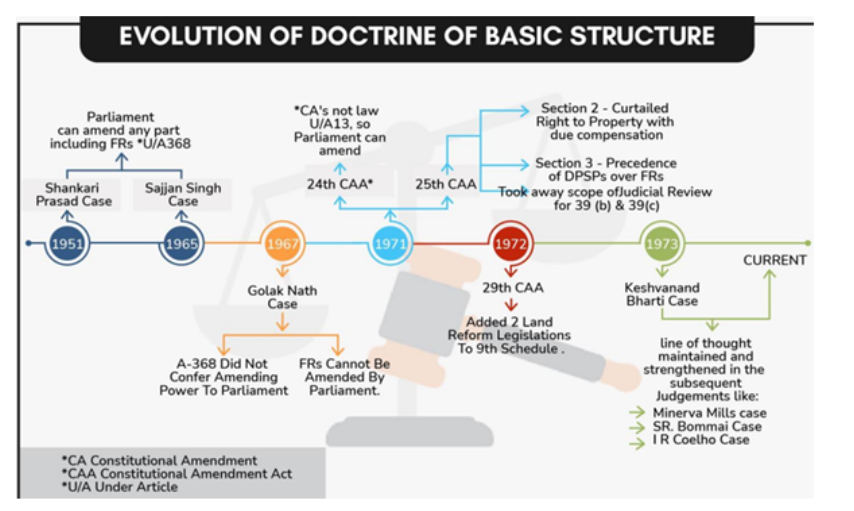
Upholding the Basic Structure Doctrine over the time:
- 1973: Kesavananda Bharati case introduces basic structure doctrine in a bench decision of 13 judges.
- 1975: Union of India seeks reconsideration of the doctrine; a bench of 13 judges convened in November. The bench dissolved without decision, indicating continued adherence to the doctrine.
- 1975: Constitution 39th Amendment passed, including Article 329A (4) attempting to validate Indira Gandhi’s election.
- 1975: Supreme Court declares Article 329A (4) unconstitutional and void, reinforcing the doctrine’s principles.
- 1978: Constitution 44th Amendment Act abolishes remaining clauses of Article 329A, cementing the doctrine’s foundation.
- 1980: Minerva Mills vs. Union of India case reaffirms the basic structure doctrine in a Constitution Bench decision of five judges.
- 2007: IR Coelho vs. State of Tamil Nadu reaffirms the doctrine in a bench decision of nine judges.
Significance of Basic Structure Doctrine:
- The Chief Justice of India D. Y. Chandrachud called Basic Structure Doctrine a North Star. This is because it guides and gives directions to law-makers, implementers and interpreters.
- It prevents damage to the Constitution by ruling the majority’s brute majority.
- It limits constituent power to avoid totalitarian regimes.
- It maintains founders’ meticulously framed principles.
- It ensures independent Judiciary, and separation of powers.
- It allows adaptation over time, unlike rigid past judgments.
Criticism of Basic Structure Doctrine:
- It is not found in the text of the original Constitution itself and therefore by inventing this test the judiciary is encroaching on the Parliament’s powers.
- The power of “unelected judges” to strike down amendments to the Constitution on the basis of this doctrine is “anti-democratic and counter-majoritarian.
SVAMITVA Scheme - Edukemy Current Affairs
In News: Recently, SVAMITVA Scheme of Ministry of Panchayati Raj has been conferred with the prestigious National Award for e-Governance 2023 (Gold) for its innovative use of emerging technologies to provide citizen-centric services.
About:
- The award was presented at the 26th National Conference on e-Governance (NCeG), organized by the Department of Administrative Reforms and Public Grievances (DARPG), Government of India in Indore, Madhya Pradesh.
- SVAMITVA stands for Survey of Villages Abadi and Mapping with Improvised Technology in Village Areas.
- The scheme employs advanced technologies such as drones and GIS (Geographic Information System) to conduct surveys and mapping of inhabited areas in villages.
- This allows property owners in rural regions to receive official ownership documents, known as Property Cards.
- The Scheme is implemented with the collaborative efforts of Survey of India being the technology implementation partner, State Revenue and Panchayati Raj Departments, and NIC–GIS.
Benefits:
- These cards have multiple benefits, including enabling property owners to access bank loans and other financial opportunities using their rural residential assets as collateral.
- The technology aids in resolving land-related disputes through the creation of highly accurate maps with 5cm precision.
India’s First Solar Roof Cycling Track
In News: Recently, Hyderabad is embracing a sustainable shift towards cycling, with the introduction of an innovative solar roof cycling track (23 KM long) near the city’s Outer Ring Road (ORR).
About:
- Cycling in a big city can be a real challenge with the pollution, uncontrollable traffic, and the risk of being knocked down by passing cars.
- Now, Hyderabad is leading the way with a first-of-its-kind sustainable solar roof cycling track near the Outer Ring Road.
- The track encompasses three lanes and consists of two segments.
- Distinguished by its 16MW solar panels fixed on the roof, this project sets an impressive sustainability precedent.
9 years of PM Jhan Dhan Yojana
In News: The Pradhan Mantri Jan Dhan Yojana (PMJDY) – the National Mission for Financial Inclusion – has completed nine years of successful implementation.
Pradhan Mantri Jan Dhan Yojana (PMJAY):
- It is a National Mission for Financial Inclusion. Financial Inclusion can be defined as the process or provision that ensures access to financial services and credit for vulnerable groups at an affordable cost.
- It was launched in 2014 to ensure universal access to financial services namely, Banking/ Savings & Deposit Accounts, Remittance, Credit, Insurance, Pension in an affordable manner through the use of technology.
- The scheme was launched based upon the following 6 pillars:
- Universal access to banking services
- Basic savings bank accounts with overdraft (OD) facility of Rs. 10,000/- to every household
- Financial Literacy Program– Promoting savings, use of ATMs, getting ready for credit, availing insurance and pensions, using basic mobile phones for banking.
- Creation of Credit Guarantee Fund – To provide banks some guarantee against defaults.
- Insurance – Accident cover up to Rs. 1,00,000 and life cover of Rs. 30,000 on account opened between 15 Aug 2014 to 31 January 2015
- Pension scheme for Unorganized sector.
Impacts of PMJAY:
- PMJDY has been the foundation stone for people-centric economic initiatives. Whether it is direct benefit transfers, COVID-19 assistance, PM-KISAN, wages under MGNREGA, the first step of all these initiatives is to provide every adult with a bank account, which PMJDY has nearly completed.
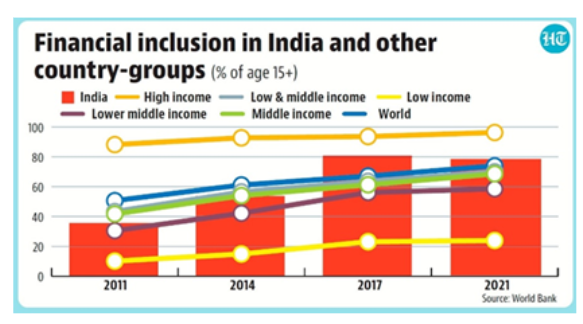
- One in 2 accounts opened between March 2014 to March 2020 was a PMJDY account.
- Within 10 days of nationwide lockdown more than about 20 crore women PMJDY accounts were credited with financial assistance of Rs 500 per month for three months through DBT in each women PMJDY account.
Achievements of PMJAY:
- Number of total PMJDY Accounts: 50.09 crore, of which 55.6% account holders are women and 66.7% accounts are in rural and semi-urban areas.
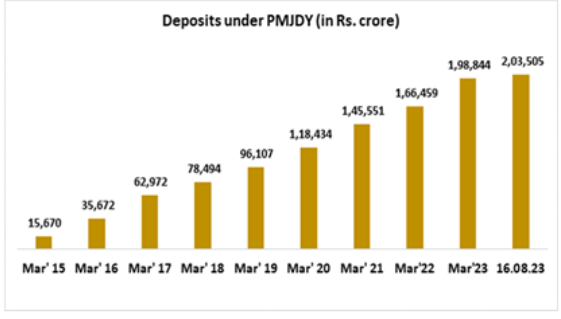
- Deposits: Deposits have increased about 13 times which is over Rs 2 lakh crore. Average deposit per account has increased over 3.8 times. Increase in average deposit is another indication of increased usage of accounts and inculcation of saving habits among account holders.
- DBT transactions: About 6.26 crore PMJDY account holders receive direct benefit transfer (DBT) from the Government under various schemes. Digital transactions in India have experienced remarkable growth due to various initiatives:
- The issuance of over 33.98 crore RuPay debit cards through the Pradhan Mantri Jan-Dhan Yojana (PMJDY).
- The installation of 79.61 lakh Point of Sale (PoS) and mobile Point of Sale (mPoS) machines.
- The introduction of mobile-based payment systems like UPI (Unified Payments Interface).
- Jan Dhan Darshak App (JDD App): JDD App is a mobile application which provides a citizen centric platform for locating banking touch points such as bank branches, ATMs, Banking Correspondents (BCs), Indian Post Payment Banks etc in the country.
National e-Vidhan Application - Edukemy Current Affairs
In News: Recently, the President of India inaugurated the ‘National e-Vidhan Application (NeVA)
About
- The National e-Vidhan Application (NeVA) is a significant component of the "Digital India Programme" by the Government of India, encompassing 44 Mission Mode Projects (MMPs).
- Its primary objective is to facilitate the transition of all State Legislatures into a paperless environment, effectively converting them into 'Digital Houses.'
- NeVA is designed as a versatile and member-centric application, agnostic to the type of device used. Its purpose is to empower legislators by providing comprehensive information at their fingertips.
- This information includes member contact details, procedural rules, notices, bills, starred/unstarred questions and answers, committee reports, and more, all accessible via handheld devices or tablets.
- As of the present status, 21 State legislatures have entered into Memorandums of Understanding for the implementation of NeVA, with the project receiving approval from 17 of these legislatures.
- The Nodal Ministry overseeing the NeVA initiative is the Ministry of Parliamentary Affairs.
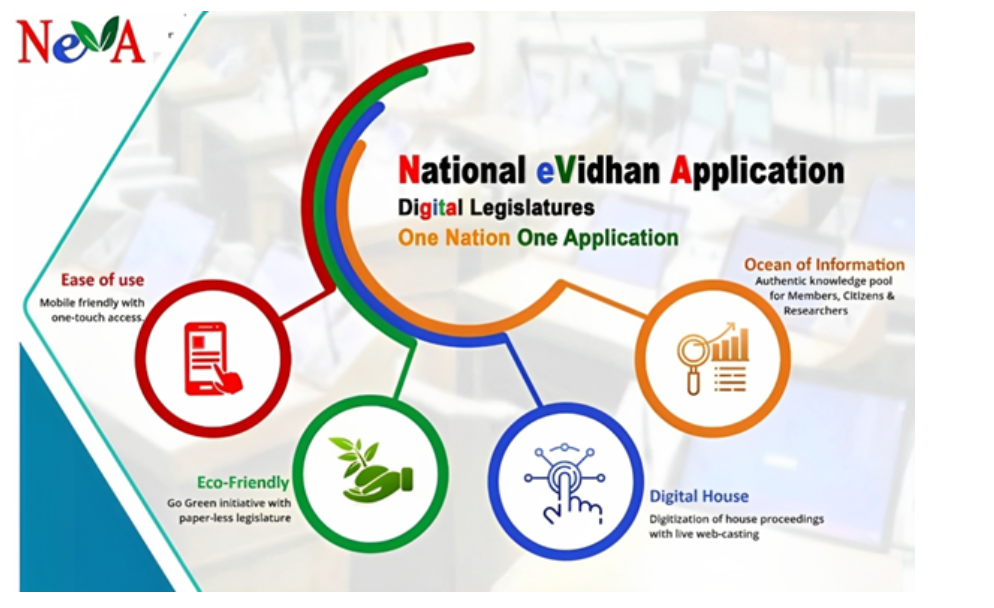
Vishwakarma Scheme - Edukemy Current Affairs
In News: Recently, Prime Minister Narendra Modi launched the PM Vishwakarma scheme in New Delhi on the occasion of Vishwakarma Jayanti, to give government support to workers engaged in traditional crafts and skills.
About the Scheme:
- The scheme was earlier announced during the speech on Independence Day.
- The scheme focuses on uplifting and empowering people engaged in traditional crafts.
- It has dual purpose:
- Providing financial support to artisans and craftspeople
- Preserving and celebrating India's age-old traditions, culture, and diverse heritage through local products, art, and crafts.
- The scheme is fully funded by the Union Government with an allocation of Rs 13,000-15,000 crore.
- Families associated with 18 such different sectors like Carpenters, Boat Makers, Armourers, Blacksmiths, etc. will be helped.
- The scheme is to help enhance the skills of workers employed in these fields and help them avail loans easily to aid their earnings.
- The Vishwakarma workers will be registered for free through Common Services Centres using the biometric-based PM Vishwakarma portal.
- They will then be provided recognition through the PM Vishwakarma certificate and ID card, given skill upgradation involving basic and advanced training, a toolkit incentive of ₹15,000, collateral-free credit support up to ₹1 lakh (first tranche) and ₹2 lakh (second tranche) at a concessional interest rate of 5%, incentive for digital transactions and marketing support.
- A toolkit booklet has also been released in 12 Indian languages, with accompanying video elements, to aid the knowledge of workers on new technologies in their field.
- Five lakh families will be covered in the first year and 30 lakh families over five years.
- The scheme also aims to ensure that Vishwakarmas are integrated with the domestic and global value chains.
Significance of the Scheme:
- Preservation of traditional skills and practices: It strives to support and maintain a customary family-based practise of transferring knowledge from one generation to the next. This epitomises India's cultural tradition, in which skill and knowledge are passed down through families.
- Quality upgradation: By providing skill upgradation, training, and toolkit incentives, it focuses to enhance the quality of products and services offered by artisans.
- Integration into Value Chains: The scheme is designed to integrate artisans and craftspeople into both domestic and global value chains. By doing this artisans can sell their products to a broader customer base, potentially increasing their income and sustaining their livelihoods.
- Wider Market Access: The scheme focuses on marketing support and incentives for digital transactions helps artisans expand their market reach. It assists them in tapping into domestic and international markets, thereby creating more opportunities for growth and recognition.
Challenges associated with the implementation of the scheme:
- Addressing the disparity: Artisans in rural areas may face different challenges compared to those in urban areas. Addressing these disparities and ensuring that all eligible artisans can participate in the scheme is essential.
- Effective monitoring and evaluation mechanisms are critical to prevent misuse of funds and ensure that artisans are not excluded from the scheme.
- Digital Literacy: Providing training and resources for digital literacy is a challenge (particularly for those who may not be familiar with digital technologies) that needs to be addressed to maximize the scheme's impact.
Gita Mittal Committee - Edukemy Current Affairs
In News: Recently, The Supreme Court of India has informed petitioners involved in the Manipur ethnic violence case that it cannot oversee the administration of the state and encouraged petitioners to place their trust in the Justice Gita Mittal Committee to address the issues raised in the case.
About:
- The Justice Mittal Committee was constituted by the Supreme Court to intervene and monitor relief and rehabilitation, restoration of homesteads, religious places of worship, etc, in Manipur.
- The committee will look into the issues include:
- The distribution of Aadhaar cards and disability certificates to the displaced people of the State,
- distribution of compensation to the families of the dead,
- reconstruction of religious buildings and homes damaged during the violence,
- handling of bodies, and
- the functioning of courts in the state.
SC judgments regarding Manipur violence:
- The State shall appoint a nodal officer in Delhi to guide people who had fled Manipur during the violence by helping them file complaints and petitions with the appropriate authorities in the State.
- The video-conferencing facilities shall be installed in district courts of Manipur within a week, and violation of it may bring the case of “contempt of court” against the State.
Foreign Contribution Regulations Act
In News: Recently, Ministry of Home Affairs (MHA) has amended the rules related to the filing of annual returns by Non-Government Organizations (NGOs) registered under the Foreign Contribution Regulation Act (FCRA).
About:
- These changes involve the requirement for NGOs to provide details about both movable and immovable assets created using foreign funds.
- Significance: The amendment aims to enhance transparency and accountability in the utilization of foreign contributions received by NGOs.
Foreign Contribution Regulations Act (FCRA)
- FCRA was enacted during the Emergency in 1976 amid apprehensions that foreign powers were interfering in India’s affairs by pumping money into the country through independent organisations.
- The law sought to regulate foreign donations to individuals and associations so that they functioned in a manner consistent with the values of a sovereign democratic republic.
- Criteria:
- The FCRA requires every person or NGO seeking to receive foreign donations to be:
- registered under the Act
- to open a bank account for the receipt of foreign funds in the State Bank of India, Delhi
- to utilize those funds only for the purpose for which they have been received and as stipulated in the Act.
- FCRA registrations are granted to individuals or associations that have definite cultural, economic, educational, religious, and social programs.
- The FCRA requires every person or NGO seeking to receive foreign donations to be:
Five Eyes Alliance - Edukemy Current Affairs
In News: The recent India-Canada standoff regarding allegations of Indian government involvement in the killing of a separatist leader in Canada has brought attention to the role of the Five Eyes Alliance.
About:
- “Five Eyes” refers to an intelligence-sharing alliance of the United States, United Kingdom, Australia, Canada and New Zealand.
- It was founded in 1941.
- Origins of the Alliance:
- The alliance traces its origins back to World War II when the UK and the US decided to share intelligence after successfully breaking German and Japanese codes.
- It began as the Britain-USA (BRUSA) agreement, later evolving into the UK-USA (UKUSA) agreement, with Canada joining in 1949 and New Zealand and Australia in 1956.
- Features:
- The Five Eyes agreement parties are “diverse societies, governed by rule of law and robust human rights and are bonded by a common language.
- These nations collaborate closely on intelligence matters, sharing information to protect their shared national interests.
UNCITRAL South Asia Conference
In News: Recently, India hosted the inaugural United Nations Commission on International Trade Law (UNCITRAL) South Asia Conference.
United Nations Commission on International Trade Law (UNCITRAL):
- It is the principal legal entity in the UN system that is dedicated to international trade law.
- It is a legal body with universal membership that specializes in commercial law reform worldwide.
- It is an international organization of lawyers that focuses on changing business law around the globe.
- For more than 50 years, it has worked to update and harmonise the laws governing transnational commerce.
- The main objective of UNCITRAL is to promote fairness, transparency, and efficiency in cross-border commercial transactions by developing legal frameworks and tools.
- India has been a member of UNCITRAL since its inception being one of the first 29 member states.
UNCITRAL South Asia Conference:
- The conference aimed to strengthen India’s engagement with UNCITRAL and encourage interaction between UNCITRAL, the judiciary, bureaucracy, academia, and the legal fraternity.
- It was organized jointly by the Ministry of External Affairs, UNCITRAL, and the organization’s national coordination committee for India.
- The conference covered various topics, including the digital economy, MSMEs and access to credit, insolvency, investor-state dispute settlement reform, international commercial arbitration, and mediation.
- It also discussed on alternative dispute resolution developments and how to make India a hub for arbitration.
India-Saudi Arabia Relationships
In News: The relationship between New Delhi and Riyadh has been improving steadily. During the recent visit of Crown Prince Mohammed bin Salman, India is engaging with Saudi Arabia on a multitude of issues.
Background of India –Saudi relationship:
- The two countries established diplomatic relations in 1947, and since then there have been cordial and friendly relations reflecting their historical socio-cultural and economic ties.
- The visit of King Abdullah to India in January 2006 saw the signing of the Delhi Declaration, which laid the framework for upgrading ties to the level of “strategic partnership” in 2010 by the Riyadh Declaration.
- The visits of the Indian PM to Riyadh in 2016 and the conferment of Saudi’s highest civilian honor to the Indian PM indicated the mutual importance of India and Saudi Arabia for each other.
- The 2019 visit of the Crown Prince brought an investment of approximately $100 billion in India. An agreement was also signed to pave the way for Saudi Arabia to join the International Solar Alliance (ISA)
- The Indian PM’s visit to Riyadh again in October 2019 led to the signing of the Strategic Partnership Council (SPC) Agreement, which established a high-level council to steer the Indo-Saudi relationship.
Highlights of the visit of Saudi Arabia’s Crown Prince:
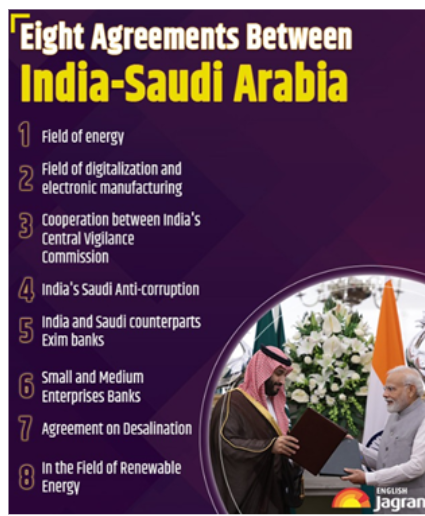
- The Crown Prince visited New Delhi for the G20 Leaders’ Summit, where he, along with the Indian PM and US President, announced the India-Middle East-Europe Economic Corridor.
- The Crown Prince and Indian PM co-chaired the first meeting of the India-Saudi Arabia Strategic Partnership Council.
- Eight agreements were signed between the two sides, which include upgrading their hydrocarbon energy partnership to a comprehensive energy partnership for renewable, petroleum, and strategic reserves, and creating a joint task force for $100 billion in Saudi investment.
- Possibility of trading in local currencies, and expediting negotiations for a free trade agreement between India and the Gulf Cooperation Council was also discussed.
Pillars of the India- Saudi Arabia relationship:
1. Economic Ties
- Trade Ties: India is Saudi Arabia’s second-largest trade partner; Saudi Arabia is India’s fourth-largest trade partner. Trade with Saudi Arabia accounted for 4.53% of India’s total trade in FY23 and bilateral trade was valued at $52.76 billion.
- Indian Companies in Saudi: Around 2,800 Indian companies are registered as joint ventures/ 100% owned entities with investments worth $2 billion in Saudi. Indian companies such as L&T, Tata, Wipro, TCS, Shapoorji Pallonji etc. have strong presence in Saudi.
- Investment in India: Saudi’s direct investments in India amounted to $3.15 billion (March 2022) with major investors being Aramco, SABIC, Zamil, e-holidays, Al Batterjee Group.
- Saudi Arabia’s Public Investment Fund (PIF) has invested in several Indian startups such as Delhivery, FirstCry, Grofers, Ola, OYO, Paytm, and PolicyBazaar through SoftBank Vision Fund.
- Proposed Investments: A major proposed investment is the $44 billion West Coast Refinery & Petrochemicals Project in Maharashtra is being jointly built by Saudi Aramco, Abu Dhabi National Oil Company, and an Indian consortium (IOCL, HPCL, BPCL).
2. Energy Cooperation
- Crude and Petroleum imports: Saudi Arabia was the third largest crude and petroleum products source for India in FY23. India sourced 16.7% of India’s total crude imports in FY23 from Saudi.
- India’s LPG imports from Saudi Arabia stood at 11.2% of its total petroleum product imports, in FY 23.
3. Defence Partnership
- Defence Exercises: There is extensive naval cooperation between India and Saudi Arabia. There have already been 2 editions of the bilateral naval exercise, Al Mohed al Hindi.
- Defence Cooperation: There is an increasing defence cooperation, and both sides have agreed to continue working together to consider possibilities of joint development and production of defence equipment.
4. Diaspora in Saudi
- Diaspora as a Living bridge: The Indian community in Saudi is more than 2.4 million strong, widely respected for its contribution to the development of Saudi Arabia.
- Support to Indian diaspora: Supporting the evacuation of Indian nationals stranded in Sudan through Jeddah under Operation Kaveri, and facilitating Indian Hajj & Umrah pilgrims.
India-Middle East-Europe Economic Corridor (IMEE-EC)
In News: Recently, on the side-lines of the G20 Summit in New Delhi, an MoU was signed between India, the US, Saudi Arabia, the European Union, the UAE, France, Germany, and Italy to establish the India-Middle East-Europe Economic Corridor (IMEE-EC).
India-Middle East-Europe Economic Corridor (IMEE-EC):
- It is an infrastructure development project that aims to create connectivity through rail and shipping networks, energy cables, and data links.
- It is part of the Partnership for Rail and Shipping Corridors Global Infrastructure Investment (PGII) and focuses on enhancing global trade and cooperation through critical infrastructure development.
- PGII is a collaborative effort by G7 nations to fund infrastructure projects in developing nations. It emphasizes loans over charity, benefiting both lending and receiving countries.
- It seeks to boost trade, clean energy, and economic growth while providing an alternative to China’s Belt and Road Initiative (BRI).
- Components of the Corridor:
- It will comprise two separate corridors, the Eastern Corridor, and the Northern Corridor. The former will connect India to the Arabian Gulf and the latter will connect the Arabian Gulf to Europe.
- It will include a rail link as well as an electricity cable, a hydrogen pipeline and a high-speed data cable.
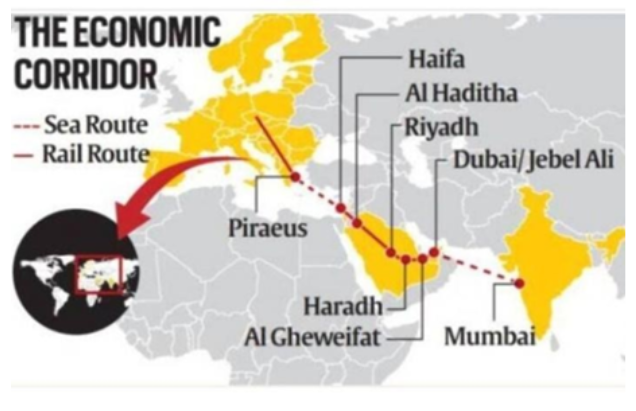
Significance of IMEE-EC Project:
- This would speed up trade between India and Europe by up to 40%.
- The plan is expected to be a possible game changer for global trade, presenting an alternative to China's wide-ranging strategic infrastructure investments.
- Enhancing food security, regional supply chains, trade accessibility, environmental considerations, economic cohesion, job creation, and reduces greenhouse gas emissions.
- It offers India a crucial role in global commerce, digital communication, and energy networks.
- It firmly positions India along the trade route spanning South East Asia to the Gulf, West Asia, and Europe.
Other Initiatives announced under PGII:
- Trans-African Corridor: It will connect the port of Lobito in Angola with Katanga province in Congo and the copper belt in Zambia.
- Clean Energy Projects in Indonesia: The PGII announced clean energy projects in Indonesia to support sustainable energy sources and infrastructure development.
- Investments in India’s Health Infrastructure: The US government’s International Development Finance Corporation (DFC) pledged over $15 million to invest in India’s health infrastructure, including eye clinics and women’s hygiene products.
- EU’s Global Gateway Program: The European Union (EU) committed to activating 300 billion USD in investments for critical connectivity projects, with a focus on Africa and various regions around the world.
African Union in G20 - Edukemy Current Affairs
In News: Recently, the African Union (AU) became a new permanent member of the G20 during the 18th G20 Heads of State and Government Summit in New Delhi.
G20 Group:
- The G20 or Group of 20 is an intergovernmental forum comprising 19 sovereign countries, the European Union (EU), and the African Union (AU) (Added in 2023).
- It works to address major issues related to the global economy, such as international financial stability, climate change mitigation and sustainable development.
- It accounts for around 80% of gross world product (GWP), 75% of international trade, two-thirds of the global population, and 60% of the world's land area.
- There is no permanent Secretariat or Headquarters of G20. 19 Countries are divided into 5 groups and the presidency rotates annually between each group.
- Troika is a working association between the current presidency, past presidency and the future presidency.
Key Highlights of G20 Summit 2023:
- The G20 leaders agreed to admit the African Union as a permanent member of the G20. It offers an opportunity to reshape global trade, finance, and investment and would provide a greater voice to the Global South within the G20.
- A Memorandum of Understanding (MoU) was signed between the Governments of India, the US, Saudi Arabia, the European Union, the UAE, France, Germany and Italy to establish the India – Middle East – Europe Economic Corridor (IMEC).
- The World Bank prepared the G20 Global Partnership for Financial Inclusion document in which the transformative impact of India's Digital Public Infrastructure (DPI) over the past decade under the Central Government has been praised. It emphasized various initiatives like JAM Trinity, Pradhan Mantri Jan Dhan Yojana (PMJDY), UPI Dominance, Data Empowerment and Protection Architecture (DEPA), etc.
- G20 countries promised to work towards tripling the global renewable energy capacity by 2030. It aligns with global efforts to limit global warming to 1.5 degrees Celsius.
- The agriculture working group during the G20 Presidency reached a historic consensus on two aspects: Deccan G20 High-level principles on Food Security and Nutrition and the Millet initiative called MAHARISHI.
- India's G-20 presidency has laid the foundation for a coordinated and comprehensive policy and regulatory framework for cryptocurrencies.
- Prime Minister of India handed over the customary gavel of the G20 chair to Brazilian President Luiz Inacio Lula da Silva, who will officially take over the presidency on December 1, 2023.
African Union (AU):
- The African Union (AU) is a continental body consisting of 55 member states in Africa.
- In 1963, the Organization of African Unity (OAU) was founded to promote cooperation among African states.
- In 2002, the OAU was succeeded by the AU with a goal to accelerate economic integration of the continent.
- African Continental Free Trade Area (AfCFTA) was established in 2018 which seeks to create a single continental market for goods and services.
ASEAN summit - Edukemy Current Affairs
In News: Recently, Prime Minister attended the 20th ASEAN-India Summit and the 18th East Asia Summit (EAS) in Jakarta.
About:
- ASEAN was established in 1967 with the signing of the Bangkok Declaration.
- It initially consisted of five member states: Indonesia, Malaysia, the Philippines, Singapore, and Thailand.
- Over the years, it expanded to include Brunei Darussalam, Lao PDR, Cambodia, Myanmar, and Vietnam.
- ASEAN’s core principles include regional cooperation in various fields, promotion of regional peace and stability, and adherence to the principles of the United Nations Charter.
- The chairmanship of the ASEAN Summit and Ministerial Conferences has rotated annually in alphabetical order between member states.
- ASEAN Secretariat: Indonesia, Jakarta.
Highlights of 20th ASEAN-India summit:
- Theme: ‘ASEAN Matters: Epicentrum of Growth’
- KeyPoints of PM’s address:
- ASEAN is the central pillar of India’s Act East Policy.
- India supports ASEAN’s outlook on ASEAN-India centrality and Indo-Pacific.
- The progress of a free and open Indo-Pacific and elevating the voice of the Global South is in the common interest of all.
More Information:
- India is part of the ASEAN Plus Six grouping, which includes China, Japan, South Korea, New Zealand, and Australia.
French laïcité
In News: Recently, the French government announced that the practice of wearing an abaya would be banned in state-run schools
About
Laïcité, the principle of secularism in France, represents the complete separation of religious values from the public sphere, with a strong emphasis on promoting secular values such as liberty, equality, and fraternity.
Its primary objective is to encourage tolerance and assimilation while relegating religion to the private sphere. The French state plays a pivotal role in enforcing and upholding Laïcité principles.
History of French laïcité
- Emergence Post-French Revolution: Laïcité began to take shape after the French Revolution in 1789 when the revolutionary government aimed to establish a clear separation between the Church and the state. During this period, there were efforts to diminish the influence of the Catholic Church in public affairs.
- The Law of 1905: Laïcité became more concrete and institutionalized with the passage of the Law of 1905 during the Third Republic. This law officially separated religious institutions from the state and established state-run secular schools. It also ensured that the state would not fund religious organizations.
- 20th Century: Laïcité was not a prominent issue for much of the 20th century when France was relatively homogeneous in terms of religious and cultural identity. During this time, the French state upheld secularism as a core value.
- Demographic Changes in the 1950s and 1960s: Demographic shifts resulting from decolonization in the 1950s and 1960s brought significant numbers of immigrants from predominantly Muslim countries to France. This led to tensions and debates about the application of Laïcité principles in a more diverse and multicultural society.
Artifacts to grace G-20 corridor
In News: Several objects of cultural significance will be displayed at the special Culture Corridor which will be set up at the venue of the G-20 summit in New Delhi.
About:

- A copy of the Magna Carta, United Kingdom’s famous charter of rights, a 15th century bronze statue of Belvedere Apollo from Italy, and an 18th century Fahua-lidded jar from China would be Some of the physical items on display.
- India’s contribution would be Panini’s Ashtadhyayi, the ancient text.
- Notable digital contributions include France’s Mona Lisa, Germany’s Gutenberg’s Bible, and Mexico’s statue of the deity ‘Coatlicue’.
- The Culture Corridor-G-20 Digital Museum has been conceptualised by the Ministry of Culture to represent and celebrate the shared heritage of G-20 members and invitee countries and will create a “museum in the making”.
- The Culture Corridor-G-20 Digital Museum will be unveiled at the G-20 Leaders’ Summit venue, ‘Bharat Mandapam,’.
- This project is based on India’s G20 theme Vasudhaiva Kutumbakam’ and the Culture Working Group’s (CWG) hallmark campaign ‘Culture Unites All”.
More Information:
- Submissions were requested from G-20 countries and nine guest nations under five categories:
- Object of Cultural Significance (as a physical display); Iconic Cultural Masterpiece (as a digital display); Intangible Cultural Heritage (digital display); Natural Heritage (digital display); and Artefact Related to Democratic Practices (physical or digital display).
National Carbon Registry - Edukemy Current Affairs
In news: UNDP deliberates on a transformative tool National Carbon Registry for climate action
About National Carbon Registry
- The National Carbon Registry is an innovative digital platform developed by the United Nations Development Programme (UNDP) to enhance global climate action efforts.
- It is the result of ongoing collaboration within the Digital4Climate (D4C) Working Group, comprising UNDP, the World Bank, UNFCCC, EBRD, and others.
- It has been accredited as a Digital Public Good (DPG) as an open-source software is designed to facilitate the management of carbon credits and revolutionizing the carbon credit ecosystem.
- Key Features:
- The National Carbon Registry utilizes open-source code, allowing countries to customize it to meet their specific needs and contexts.
- Its modular structure and technical documentation enable easy adaptation, potentially reducing production costs and implementation timelines for nations.
- It is aligned with the Global Goals for sustainable development, the registry promotes integration and collaboration across different sectors and stakeholders.
- The registry adheres to national and international best practices, incorporating inputs from various countries.
- It is designed as an interoperable digital system, it seamlessly integrates with national measurement, reporting, and verification (MRV) systems.
- It also interfaces with international digital systems like UNDP's cooperation platform and the World Bank's Climate Action Data Trust (CAD Trust), expanding its capabilities.
Benefits:
- Digital market infrastructure is significant to amplify high-integrity and transparent carbon markets recognised by World Bank's Climate Warehouse program.
- By offering an open-source carbon registry platform, it enables countries to elevate their climate action and ambition levels.
- National Carbon Registry can address broader issues related to nature, climate, and energy especially for countries striving to meet their climate targets and contribute to a sustainable future.
- To achieve effective climate action, developing countries require over US$6 trillion by 2030 to fund their climate goals outlined in their Nationally Determined Contributions (NDCs).
- Carbon finance is instrumental in NDC implementation, and the Paris Agreement's Article 6 provisions enable the use of market mechanisms.
- Overall, the National Carbon Registry can help fill critical gaps in climate financing and will help in accelerating global climate action and supporting the transition to a low-carbon world.
Eastern Maritime Corridor (EMC)
In News: Recently, the Ministry of Ports extended an invitation for an Indo-Russian Workshop on Eastern Maritime Corridor in Chennai
About
- The Eastern Maritime Corridor (EMC) is a proposed sea route that would connect the Indian port of Chennai with the Russian port of Vladivostok.
- This corridor is expected to reduce the transportation time between Indian and Russian ports in the Far East Region by as much as 40 percent, bringing it down from the current 40 days to 24 days.
- Currently, the trade route between Mumbai, India, and St. Petersburg, Russia, covers a distance of 8,675 nautical miles.
- EMC is projected to cover a distance of approximately 5,600 nautical miles, which is significantly shorter than the existing route via the Suez Canal.
- Once completed, the EMC is expected to facilitate the transportation of goods from India to Far East Russia in just 24 days, which is a significant improvement over the current journey duration of over 40 days.
- For India, the EMC holds the potential to offer a more efficient and shorter route to access the markets of the Far East, including countries like China and Japan. This improved connectivity can have positive implications for trade and economic relations in the region.
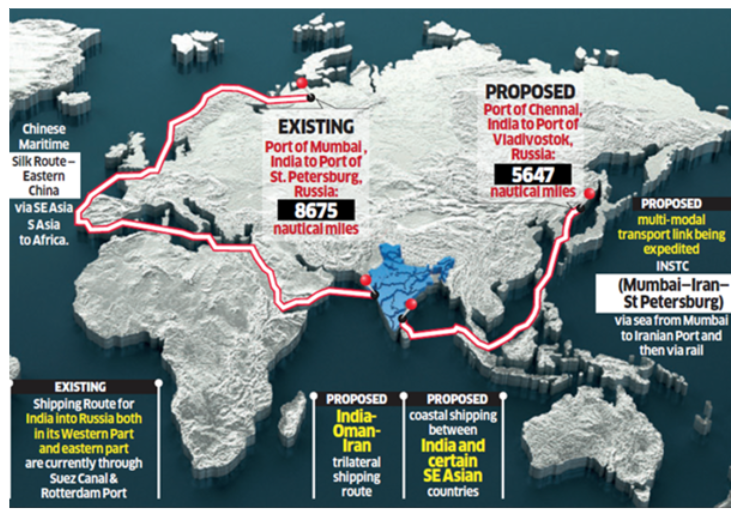
Operation Sajag - Edukemy Current Affairs
In News: Recently, the coastal security drill ‘Operation Sajag’ conducted by the Indian Coast Guard along the west coast
About
- Operation Sajag was organized by the Indian Coast Guard along the western coastline and engaged all key participants within India's coastal security framework.
- A total of 118 vessels, including those representing Customs, Marine Police, Ports, and the Indian Navy, actively participated in this exercise.
- The primary objective of this drill is to reaffirm and evaluate the effectiveness of the coastal security apparatus while concurrently raising awareness among fishermen operating at sea.
- Operation Sajag has formalized efforts related to island security and community interaction programs under the broader coastal security framework.
Three Years of Abraham Accords
In News: The Abraham Accord between the United Arab Emirates, Bahrain and Israel has completed three years.
Abraham Accords:
- The Abraham Accord (2020), brokered by the USA, is a normalisation pact to establish formal diplomatic ties between the UAE and Israel.
- The name "Abraham Accords" was chosen as a sign of unity and as a reference to the historical figure of Abraham, who is said to be the ancestor of both Jews and Arabs.
- Bahrain, Sudan, and Morocco also joined the agreement, and in return Israel agreed to put a halt to its aspirations to annexe portions of the occupied West Bank.
- After Egypt (in 1979) and Jordan (1994), the UAE is the third Arab country to recognise Israel as a result of this agreement.
Significance of the Abraham Accords:
- The accord demonstrates how the Arab nations are rapidly disengaging from the Palestine issue.
- Israel, the United Arab Emirates, and Bahrain will establish full diplomatic connections, which will benefit the whole region.
- The agreement restores the UAE's reputation in the US, where its participation in the Yemen conflict has damaged it.
- Pakistan will be forced to choose between following the UAE's lead (which would be perceived as giving up the Islamic cause of Palestine) and not doing so (because it is already at odds with the Saudis over its refusal to take up the Kashmir issue and cannot afford another unfriendly Islamic country).
- Trade between Israel and other West Asian countries increased by 74% between 2021 and 2022.
- Tourism, mostly non-existent in the past, has skyrocketed. In 2021, visits from Israel to the UAE increased by 172%.
- In a region where 65% of the population is under 30 years of age, providing the younger generation with opportunities is a key factor in preventing instability.
- The Prosperity Green & Blue agreement between Israel, the UAE, and Jordan determined that a solar field to supply 600 megawatts of electricity to Israel and a desalination plant in Israel would deliver 200 million cubic meters of water to Jordan.
- The Abraham Accord encourages collaboration and education. The UAE incorporated Holocaust education into its school curriculum as a mandatory subject, fostering coexistence and religious tolerance.
India’s Interest:
- The Abraham Accords create the right conditions for India to forge closer connections with both Arab nations and Israel.
- As a result of the Abrahamic Accords, the formation of I2U2 was witnessed. Additionally, it was referred to informally as the "West Asian Quad" and the "Indo-Abrahamic construct."
- The coalition promotes collaboration in six sectors—food security, health, transportation, space, water, and energy.
- Collaboration between the three countries may result from Israel's inventive qualities, UAE financial support, and India's technological prowess. For example, Eccopia, an Israeli company with a manufacturing base in India, supported an Emirati project for a robotic solar panel.
- There are now convenient direct flights between Bahrain and Israel as well as the UAE, benefiting the expanding Indian diaspora in the Gulf.
- Indian students now have easier access to colleges, more opportunities to explore overseas education options, and greater travel convenience.
India’s GDP measurement and its limitations
In News: Recently, a number of experts have drawn attention to a disparity in India's GDP numbers that masks underlying problems including growing inequality.
Gross Domestic Product (GDP):
- GDP is the gross valuation of all the goods and services generated within a country's borders for a specific period, generally one financial year.
- The GDP of a nation may be utilized to measure its growth and economic advancement.
- India’s GDP is calculated by the Central Statistics Office (CSO), which is part of the Ministry of Statistics and Program Implementation (MoSPI).
Types of GDP:
- Real GDP:
- Real GDP is an economic metric that is used to describe the economic output of a country within a specific year. It reflects the value of all goods and services produced while factoring inflation into its calculation. At present, the base year for calculating India's Real GDP is 2011-12.
- Nominal GDP:
- Nominal gross domestic product (GDP) is GDP given in current prices, without adjustment for inflation.
- Nominal GDP is seen by the government as a more realistic indication of economic growth.
Calculation of GDP:
- Expenditure Method:
- This method considers the total expenditure on goods and services made by every individual inside a single economy.
- GDP = Consumption Expenditure (C) + Investment Expenditure (I) + Government Spending (G) + Net Export (Nx)
- Income Method:
- This method takes account of the gross revenue generated inside a nation's borders by different production factors, such as labor and capital.
- GDP calculated based on this approach is known as GDI or Gross Domestic Income.
- GDP = Wage + Rent + Interest + Profit
- Output Method:
- This approach is used to determine the market value of all the services and products produced within a country.
- This method aids in removing any discrepancy in GDP measurement brought on by fluctuations in pricing levels.
Limitations Of GDP:
- GDP excludes non-market activities including domestic, volunteer, and other participations that have a beneficial effect on productivity. Additionally, goods produced for personal use are not included.
- GDP does not reflect the unequal distribution of income as seen in the case of India.
- The Standard of Living cannot be estimated by GDP, India has a high GDP but the living standards is relatively low in India.
- The Environmental Impact of growth and social well-being are not explained by GDP.
Concerns with the current calculation of GDP:
- The country’s GDP is presently computed with the base year of 2011-12 which is now more than 10 years old. Under normal circumstances, the base should have been revised after five years in 2016-17, with the readiness for another revision for 2021-22.
- GDP estimates based on an outdated base would not adequately capture new activities being undertaken in the economy like large investments in infrastructure, large inflow of foreign investment, value addition due to diversification, adoption of efficient technologies, and increased capacity.
- The Ministry of Statistics and Programme Implementation (MoSPI) has not come out with the results of various surveys like the consumer expenditure survey and the annual survey on unincorporated enterprises which are crucial for the base revision exercise.
- There is a need for the introduction of Supply Use Tables (SUTs) which are critical for the validation of national accounts statistics. This would also take care of confusion faced by some of the followers of national account statistics in understanding the “discrepancies” brought out in the estimates as a balancing term on the expenditure side of GDP.
Way Forward:
- MoSPI should initiate the process by constituting an advisory committee on National Accounts Statistics with professional experts from academia, industry and civil society and also set up working groups for the revision of the base year.
- A decision on the new base year should be taken at the highest level after due consideration of data availability and an assessment of whether the year has been normal or not.
- Steps should also be taken to change the base for all relevant price and production indices.
JP Morgan global bond index - Edukemy Current Affairs
In News: Recently, JP Morgan Chase & Co. has announced the inclusion of Indian government bonds into its emerging markets bond index, effective from June 2024, which will likely to attract 25 billion dollars foreign investments.
About:
- The GBI-EM (Government Bond Index-Emerging Markets) is a global bond index maintained by JP Morgan, and it plays a crucial role in shaping international capital flows.
- The JP Morgan GBI-EM is a widely followed and influential benchmark index that tracks the performance of local-currency-denominated Sovereign Bonds issued by emerging market countries.
- It is designed to provide investors with a representative measure of the fixed income market within emerging market economies.
- It Includes government bonds issued by various emerging market countries.
- These bonds are denominated in various currencies, including the US dollar and local currencies of the respective countries.
- Criteria for inclusion:
- Bonds included in the index must meet certain criteria set by JP Morgan, including minimum outstanding issue size, liquidity, and credit quality standards.
- The composition may change over time based on eligibility criteria.
Significance of Inclusion:
- India will reach a maximum weight of 10 per cent in the GBI-EM Global Diversified Index (GBI-EM GD) as part of the inclusion.
- Analysts estimate that the inclusion could result in nearly $26 billion in passive inflows, with the potential for additional active flows of around $10 billion, bringing the total inflows to approximately $40 billion over the next one and a half years.
India’s supply Chain Opportunities
In News: Amidst the efforts to cut dependence on China-centric global supply chains, the G20 announcement on the India-Middle East-Europe Economic Corridor (IMEC) has the potential to make India an Asian hub in global supply chains.
About India-Middle East-Europe Economic Corridor (IMEC):
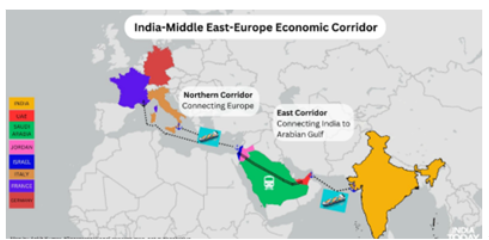
- The launch of IMEC was announced by the Indian PM at the G20 leader’s summit. The project includes India, UAE, Saudi Arabia, European Union, France, Italy, Germany and the US.
- The rail and shipping corridor is part of the Partnership for Global Infrastructure Investment (PGII), a collaborative effort by G7 nations to fund infrastructure projects in developing nations. PGII is considered to be the bloc’s counter to China’s Belt and Road Initiative.
- The corridor will include a rail link as well as an electricity cable, a hydrogen pipeline and a high-speed data cable to enable greater trade among the involved countries.
What are Supply Chains?
- Supply chains, also known as global production networks or global value chains, refer to the geographical location of various stages of production such as design, production, assembly, marketing, and service activities in a cost-effective manner.
- The shift in industrial production from local and regional supply to global supply took place gradually over the last 100 years. Global supply chains have been the leading model of industrial production since the 1980s
Reasons for shifting of global supply chains moving away from China:

- Declining preference for China: Even before Covid-19 pandemic, Western firms had begun to reduce their reliance on China, and its popularity as a sourcing market was diminishing.
- Shift to cost-effective locations: Some production stages in Chinese supply chains, particularly the labor-intensive ones, are moving to lower-cost locations due to rising wages and supply chain bottlenecks within China, and investor concerns about tighter regulation of foreign firms.
- Risks of concentration of Supply chains in China: The global risks of supply chains concentrated in mainland China and Hong Kong together account for 20% of world exports of intermediate goods.
- Geopolitical relations of China: Internal risks and the country’s trade war with the US, are forcing multinational companies to rethink their global sourcing strategies.
- Considerations of profitability are influencing a trend of relocating production either to friendly countries or back to the US despite high costs of shifting a supply chain.
India as an attractive supply chain hub:
- Emerging Manufacturing Hubs: India can become a complementary Asian manufacturing hub to China by reaping gains from foreign technology transfers and creating value-adding jobs.
- Mature sectors: Manufacturing sectors in India such as automotives, pharmaceuticals, and electronics assembly are already mature sectors, and likely to emerge as winners in this race.
- Geopolitical and economic factors: WTO lists India as the fifth largest importer of intermediate goods in 2022 Q4, suggesting that geopolitical and economic stability will attract foreign investors.
- New Trade Policy: Trade policy has placed renewed emphasis on preferential trade through a flurry of bilateral deals with trading partners.
- India’s Free Trade Agreements (FTA) with several countries such as UAE-India CEPA, early harvest for the Australia-India FTA. These new deals reflect plans for deep economic integration.
Strategies to promote regional supply chains in South Asian:
- Upscaling the Make in India Programme into a Make in South Asia Programme: India can provide fiscal incentives to Indian manufacturers to expand into Bangladesh and Sri Lanka, which are in apparel supply chains.
- Conclusion of comprehensive bilateral FTA with Bangladesh and Sri Lanka to support regional rules-based trade and investment.
Way Forward:
- Promotion of export-oriented FDI: Maintaining an open-door policy toward FDI in manufacturing and facilitating investment at a high level, with competitive fiscal incentives and creation of modern SEZ as public-private partnerships.
- Local companies need smart business strategies to join global supply chains as compared to big companies who have advantages due to the larger scale of production and access to foreign technology, and ability to spend more on marketing.
- Cautious approach towards adopting China’s interventionist styles as there is a significant risk of government failure and cronyism
- Better targeting of multinationals in new industrial activities in which there may be a potential comparative advantage and better coordination between the central and state governments.
- Upstream investment in tertiary-level education in science, technology, engineering, and mathematics.
2023 World Trade Report: Re-globalization
In News: Recently, the World Trade Organization (WTO) published its World Trade Report 2023 which emphasizes the role of International Trade in building a more secure, inclusive, and sustainable world.
Key Highlights of the Report:
- The report promotes "re-globalization," which would include extending trade integration to additional economies, individuals, and problems.
- It places a focus on political objectives outside trade efficiency, such as world peace, security, alleviating poverty, and sustainability.
- The paper discusses the change in the globalization narrative.
- The COVID-19 pandemic highlighted the importance of resilient supply chains.
- Global trade trends have been influenced by geopolitical tensions such as the crisis in Ukraine, and the emergence of China.
- Geopolitical boundaries are progressively being followed in trade. Trade flows are increasing more quickly inside fictitious geopolitical "blocs" than they are between them, pointing to a move towards friend-shoring.
- Despite challenges, bilateral trade between China and the United States reached record highs.
- During the COVID-19 pandemic, international supply networks were crucial in addressing supply shortages.
- Millions of people have been rescued from poverty via trade integration. Trade may promote sustainability by making green technology more accessible.
Re-Globalization:
- Re-globalization is a theory that promotes increasing and bolstering global economic and trade interconnectedness with an emphasis on making it more equitable, secure, and sustainable.
- It emphasises the requirement for more international collaboration and trade integration in order to handle today's global concerns, such as geopolitical conflicts, economic inequality, and climate change.
- Benefits:
- It may spur economic growth and lower the rate of poverty, as was the case in India from 1994 to 2005.
- It can help reduce poverty by enhancing economic possibilities and income distribution, as seen by the roughly 1.5-point drop in the headcount poverty rate.
- International cooperation on environmental issues can be facilitated by re-globalization.
- As seen in India between 1990 and 2010, resource reallocation from inefficient to efficient enterprises can result in a substantial reduction in emission intensity.
- Role of WTO in encouraging Re-Globalization:
- By enforcing trade regulations and agreements among member nations, WTO can support multilateral trading laws.
- Addressing Global Challenges by Promoting Policies to Reduce Poverty and Inequality Through Trade and Facilitating Discussions on Trade's Role in Peace and Security.
- Increasing Economic Security by Stressing the Value of Crisis-Resilient Supply Chains.
- Implementing agreements like the Fisheries Subsidies Agreement and the Trade Facilitation Agreement will facilitate trade. Reducing trade costs for middle and low-income nations is the key to addressing trade cost disparities.
Vidya Samiksha Kendras - Edukemy Current Affairs
In News: Under the National Digital Education Architecture (NDEAR), the Ministry of Education is pushing States to open Vidya Samiksha Kendras (VSKs).
About
- Vidya Samiksha Kendra (VSKs) is a significant initiative aimed at creating a comprehensive data repository that will encompass information from all schemes administered by the Ministry of Education (MoE) in India.
- These centers will serve as control rooms to collect and manage data, enabling the tracking of key performance indicators and the analysis of data through the application of artificial intelligence (AI) and machine learning.
The repository will include regularly updated data from various educational programs and initiatives, including:
- PM-POSHAN Mid-day Meal Programs: Information related to the implementation and impact of the mid-day meal programs aimed at providing nutritious meals to schoolchildren.
- Teacher Training Data: Data regarding teacher training activities conducted through the National Initiative for School Heads' and Teachers' Holistic Advancement portal.
- Textbook Content: Content related to textbooks and educational materials available through the Digital Infrastructure for Knowledge Sharing.
- School Dropout and Attendance Data: Data on school attendance and dropout rates, managed under the Unified District Information System for Education (UDISE+).
- Students Learning Outcomes: Information on students' learning outcomes, typically assessed through initiatives like the National Achievement Survey.
- Performance Grading Index: This index evaluates the performance of the school education system at the state and union territory (U.T.) level.
Funding:
- The central government has allocated funds ranging from 2 to 5 crore rupees to each state for the adoption and establishment of Vidya Samiksha Kendras.
Significance:
- Mapping School Locations with Population: VSKs will facilitate the mapping of school locations with population distribution, allowing for the assessment of the Gross Access Ratio. This can help identify areas with a shortage of educational facilities and guide the establishment of new schools where needed.
- Planning for Industry Clusters: By analyzing data from VSKs, policymakers can gain insights into the skill requirements of specific regions or industry clusters. This information can be instrumental in tailoring educational and skill development programs to meet local demands.
- Higher Education Planning: VSKs can aid in the planning of higher educational institutions based on current and future educational needs and scenarios. This can lead to more strategic and efficient resource allocation in the higher education sector.
Self-Regulatory Organisation (SRO) for fintech entities
In News: Recently, Reserve Bank of India (RBI) Governor Shaktikanta Das has asked fintech entities to form a Self-Regulatory Organisation (SRO).
About:

- Fintech, short for “financial technology,” refers to the innovative use of technology to deliver a wide range of financial services and products.
- Fintech companies leverage cutting-edge technology, including software, applications, and digital platforms, to create more efficient, accessible, and user-friendly solutions in the financial industry.
- They often operate in areas such as digital payments, lending, investing, insurance, and wealth management.
- Some examples include mobile banking, peer-to-peer payment services (e.g., Gpay, PhonePe), automated portfolio managers (e.g., Fintoo, Motilal Oswal), or trading platforms (e.g., Zerodha, Groww).
Self-Regulatory Organisation (SRO)
- Self-Regulatory Organisation (SRO) is a non-governmental organization that sets and enforces industry rules to protect customers, and promote ethics, equality, and professionalism.
- Framing of Rules: SROs typically collaborate with all stakeholders in framing rules and regulations.
- Their self-regulatory processes are administered through impartial mechanisms such that members operate in a disciplined environment and accept penal actions by the SRO.
- SRO regulations complement existing laws and regulations.
- Recognition: Reserve Bank of India will be authority of issuing letters of recognition.
Functions of SROs:
- Establishing codes of conduct: To foster transparency, fair competition, and consumer protection.
- Communication Channel: Serve as a link between members and regulatory bodies like the RBI.
- Establishing Standards: Set industry benchmarks and encourage professional conduct.
- Training and Awareness: Provide member training and awareness programs.
- Grievance Redressal: Establish a uniform grievance resolution framework.
- Others: SRO is expected to address concerns such as to protect workers, customers or other participants in the ecosystem.
Advantages of SROs
- SROs are experts in their industries, providing valuable knowledge and insights to their members.
- They enforce ethical standards among their members, fostering trust in the industry.
- SROs act as watchdogs, preventing unprofessional practices.
Hallmarking in India - Edukemy Current Affairs
In News: The third phase of the mandatory hallmarking vide Hallmarking of Gold Jewellery and Gold Artefacts (Third Amendment) Order, 2023 comes into force from September 8, 2023.
About:

- It will include an additional 55 districts, making the total number of districts covered under mandatory hallmarking as 343.
Hallmarking
- Hallmarking is like a quality stamp for jewellery and precious metal items.
- Hallmarks are thus official marks used in many countries as a guarantee of the purity or fineness of precious metal articles.
- The principle objectives of the Hallmarking Scheme:
- to protect the public against adulteration
- to obligate manufacturers to maintain legal standards of fineness.
Hallmarking in India:
- At present two precious metals namely gold and silver have been brought under the purview of Hallmarking.
- Mandatory hallmarking order is applicable on 14, 18 and 22 carats of gold jewellery/artefacts only.
- Bureau of Indian Standards (BIS) assigns a unique HUID (Hallmarking Unique ID) number to all hallmarked items.
- HUID is a six-digit alphanumeric code.
- It is given to every piece of jewellery at the time of hallmarking and is unique for each piece.
- The Government has made it mandatory the introduction of a HUID number in every piece of jewellery.
- Consumers can verify the authenticity of hallmarked items using the ‘verify HUID’ feature in the BIS Care app.
- Applicable since: It is applicable for gold since 2000 and for silver since 2005.
World food price index - Edukemy Current Affairs
In News: Food and Agriculture Organization (FAO) reported that the world food price index fell to a new two-year low recently.
About:
- The FAO Food Price Index (FFPI) is a measure of the monthly change in international prices of a basket of food commodities.
- It consists of the average of five commodity group price indices – cereals, oilseeds, dairy products, meat and sugar, weighted by the average export shares of each of the groups over 2014-2016.
- Recent decline reversed a previous month’s rebound, with most food commodities experiencing decreases, although rice and sugar prices.
|
Food and Agriculture Organization (FAO) |
|
India Progress in DPI – World Bank
In News: Recently, the World Bank has lauded the transformative impact of DPIs in India over the past decade.
About
Digital Public Infrastructure (DPI) encompasses fundamental building blocks and platforms, such as digital identification, payment infrastructure, and data exchange solutions. These elements play a pivotal role in facilitating a country's ability to provide essential services to its citizens, ultimately fostering empowerment and an enhanced quality of life through digital inclusion.
DPIs serve as the conduits for the seamless movement of three critical components:
- First, they enable the smooth flow of individuals through a robust digital identification system.
- Second, they facilitate the swift transfer of financial resources via a real-time, high-speed payment system.
- Third, they govern the secure and consent-driven exchange of personal information, thereby unlocking the full potential of DPIs and granting citizens genuine control over their data.

Steps taken by the government in shaping the Digital Public Infrastructure (DPI) landscape:
- Financial Inclusion: The World Bank document notes that India has achieved in just 6 years what would have taken about five decades.
- JAM Trinity has propelled the financial inclusion rate from 25% in 2008 to over 80% of adults in the last 6 years, a journey shortened by up to 47 years thanks to DPIs.
- Since its launch, the number of PMJDY accounts opened tripled from 147.2 million in March 2015 to 462 million by June 2022; women own 56 percent of these accounts, more than 260 million.
- The Jan Dhan Plus program encourages low-income women to save, resulting in over 12 million women customers (as of April 2023) and a 50% increase in average balances in just five months, as against the entire portfolio in the same time period.
- Government to Person (G2P) Payments (World’s largest digital G2P):
- This approach has supported transfers amounting to about $361 billion directly to beneficiaries from 53 central government ministries through 312 key schemes.
- As of March 2022, this had resulted in a total savings of $33 billion, equivalent to nearly 1.14 percent of GDP.
- UPI:
- More than 9.41 billion transactions valuing about Rs 14.89 trillion were transacted in May 2023 alone. For the fiscal year 2022–23, the total value of UPI transactions was nearly 50 percent of India’s nominal GDP.
- DPIs’ Potential Added Value for the Private Sector:
- The DPI in India has also enhanced efficiency for private organizations through reductions in the complexity, cost, and time taken for business operations in India.
- NBFCs have been enabled 8% higher conversion rate in SME lending, a 65% savings in depreciation costs and 66% reduction in costs related to fraud detection.
- According to industry estimates, banks’ costs of onboarding customers in India decreased from $23 to $0.1 with the use of DPI.
- Lower Cost of Compliance for Banks for KYC
- India Stack has digitized and simplified KYC procedures, lowering costs; banks that use e-KYC lowered their cost of compliance from $0.12 to $0.06. The decrease in costs made lower-income clients more attractive to service and generated profits to develop new products.
- Cross-Border Payments:
- The UPI-PayNow interlinking between India and Singapore operationalized in February 2023, aligns with G20's financial inclusion priorities and facilitates faster, cheaper, and more transparent cross-border payments.
- Account Aggregator (AA) Framework:
- India’s Account Aggregator (AA) Framework aims to strengthen India’s data infrastructure, enabling consumers and enterprises to share their data only with their consent through an electronic consent framework. The framework is regulated by RBI.
- Total of 1.13 billion cumulative accounts are enabled for data sharing, with a 13.46 million cumulative number of consents raised in June 2023.
- Data Empowerment and Protection Architecture (DEPA):
- India's DEPA grants individuals control over their data, enabling them to share it across providers. This promotes tailored product and service access without requiring new entrants to invest heavily in pre-existing client relationships, fostering innovation and competition.
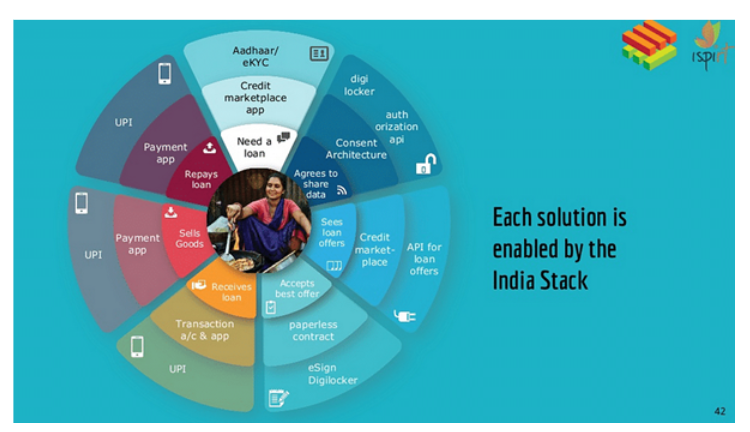
New UPI features - Edukemy Current Affairs
In News: Recently, the National Payments Corporation of India (NPCI) has introduced new features for the Unified Payments Interface (UPI) with the goal of achieving 100 billion monthly transactions.
About:
- UPI is a system that powers multiple bank accounts into a single mobile application (of any participating bank), merging several banking features, seamless fund routing & merchant payments into one hood.
- National Payments Corporation of India (NPCI) launched UPI with 21 member banks in 2016.
New UPI features:
- The latest offerings by NPCI encompass a credit line on UPI, a conversational payment mode known as ‘Hello UPI,’ BillPay Connect, UPI Tap & Pay, and UPI Lite X.
- The credit line on UPI allows users to make purchases by scanning a QR code with their UPI-linked app, choosing their bank, entering the transaction amount, and opting for the credit line as the payment option.
- ‘Hello UPI’ is a conversational payment mode that can understand spoken language and silence, convert text to numerical values, and offer text-to-speech capabilities.
- UPI Tap & Pay involves small cards with NFC chips linked to a user’s QR code and UPI ID.
- Users can obtain these cards from partner banks, personalize them, and attach them to their mobile phones for convenient tap-based payments.
- UPI Lite X enables peer-to-peer transactions without an internet connection, using near-field communication (NFC) functionality on compatible phones.
Financial inclusion to reduce inequality and fasten growth
In News: Recently, G20 deliberations identified three policy pillars with priority themes aimed at achieving inclusion
About
Financial inclusion means that individuals and businesses have access to useful and affordable financial products and services that meet their needs – transactions, payments, savings, credit, and insurance – delivered in a responsible and sustainable way.
- Financial inclusion has been identified as an enabler for 7 of the 17 Sustainable Development Goals.
- The G20 committed to advancing financial inclusion worldwide and reaffirmed its commitment to implement the G20 High-Level Principles for Digital Financial Inclusion.
- The World Bank Group considers financial inclusion a key enabler to reduce extreme poverty and boost shared prosperity.
- Financial Inclusion helps strengthen the livelihoods of those at the bottom of the economic pyramid and also contributes to global economic growth.
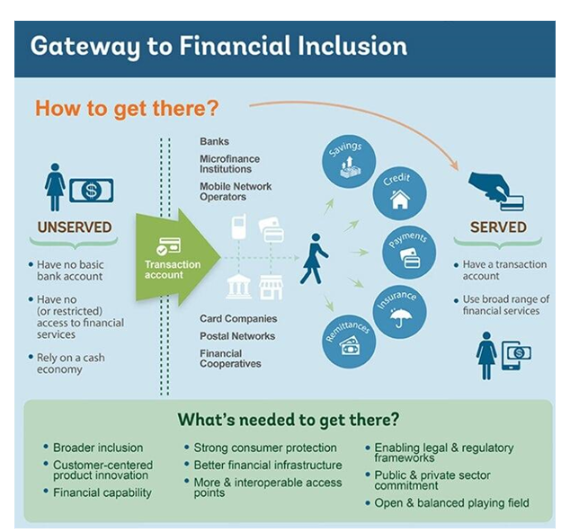
Challenges in Promoting Financial Inclusion
- Limited Financial Access: Approximately 24% of adults worldwide do not have access to formal financial accounts, which impedes their participation in the financial system.
- Low Savings and Borrowing Rates: Globally, only 29% of adults deposit their savings in financial institutions, and a mere 28% borrow from formal financial institutions.
- Disparities in MSME Financing: Micro-enterprises in developing countries often encounter obstacles, such as loan rejections or unfavourable loan terms, affecting 21% of them. Small and medium-sized enterprises face even greater barriers, with 30% experiencing difficulties accessing financing.
- Gender Disparities: Women face unique challenges in financial inclusion due to restrictive social norms, limited mobility, and lower financial literacy. This gender gap is particularly pronounced in low-income and developing countries, leading to disparities in bank account ownership.
- Limited Adoption of Digital Payments: In developing nations, men with bank accounts are more likely to utilize digital payment methods, creating a 6-percentage-point gap compared to women. This further excludes women from accessing digital financial services.
- Limited Access to Emergency Funds: Women in developing countries encounter more significant difficulties in accessing emergency funds, with only 50% reporting consistent access, compared to 59% of men.
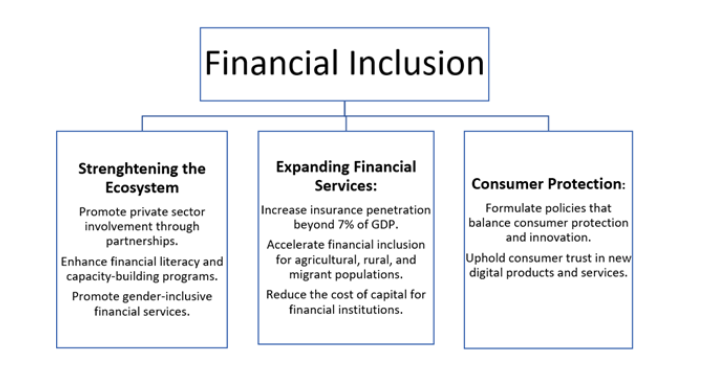
UPI QR Code-Central Bank Digital Currency interoperability
In News: Recently, RBI launched the UPI QR Code-Central Bank Digital Currency interoperability
About
- The interoperability of the Unified Payments Interface (UPI) with the digital rupee means that all UPI Quick Response (QR) codes are now compatible with Central Bank Digital Currency (CBDC) apps.
- During the pilot phase of the retail digital rupee, users of the e₹-R (retail digital rupee) had to scan a specific QR code to perform transactions related to the digital rupee.
However, with the introduction of interoperability between UPI and the digital rupee, payments can now be made using a single QR code.
How does this interoperability work?
- Digital Rupee Wallet: The e₹ is stored in a digital wallet, which is linked to a customer's existing savings bank account. This digital wallet holds the digital rupee, allowing users to make transactions and payments seamlessly.
- UPI Integration: UPI is a widely used payment system in India, directly linked to a customer's bank account. With the interoperability of UPI and the digital rupee, users can now use their existing UPI-enabled apps to make payments related to the digital rupee.
- Single QR Code: Instead of needing a separate QR code for digital rupee transactions, users can now use a single QR code. This QR code can be scanned using CBDC apps or UPI-enabled apps, making the process more user-friendly and efficient.
Malaviya Mission – Teachers Training Programme
In News: Recently, the Union Minister for Education and Skill Development & Entrepreneurship launched the Malaviya Mission - Teachers Training Programme by the University Grants Commission.
About
The Malaviya Mission is an initiative aimed at enhancing the quality of education in India, particularly focusing on the training and development of teachers in higher educational institutions (HEIs).
About Malaviya Mission:
- Teacher Training Programs: The mission is designed to provide customized training programs for teachers, with a specific focus on capacity building within higher educational institutions.
- Capacity Building: Its primary objective is to enhance the professional development of faculty members in HEIs. This initiative seeks to empower and build the capacities of approximately 15 lakh (1.5 million) teachers in higher education across India.
- Nationwide Presence: The Malaviya Mission is planned to operate through 111 centers across the country, ensuring broad coverage and a time-bound approach to teacher capacity building.
- Alignment with NEP: The mission aligns with the goals of the National Education Policy (NEP) and aims to improve the quality of teacher training, foster leadership skills among educators, and contribute to the realization of NEP objectives.
- Career Progression: It intends to map capacity-building activities under the Mission to a credit framework, enabling career progression pathways for educators, thereby recognizing and rewarding their professional development efforts.
- Incorporation of Indian Knowledge System: The program modules include aspects of the Indian Knowledge System, emphasizing the importance of indigenous knowledge in education.
About Madan Mohan Malaviya
He was a prominent Indian educationist, freedom fighter, and moderate political leader. Some key facts about him include:
- Presidency of Indian National Congress: He was elected as the president of the Indian National Congress four times during his political career.
- Round Table Conference: Malaviya attended the Round Table Conference in 1931, representing India's interests and discussing constitutional reforms.
- Founding Hindu Mahasabha: He played a significant role in founding the Hindu Mahasabha in 1906, a socio-political organization.
- Banaras Hindu University (BHU): Malaviya is most renowned for founding Banaras Hindu University (BHU) in Varanasi in 1916. BHU was established under the B.H.U. Act, 1915, and it has since become a prominent educational institution in India.
- Vice Chancellor of BHU: He served as the Vice Chancellor of Banaras Hindu University from 1919 to 1938, contributing significantly to its development and growth.
Vizag International Cruise Terminal
In News: The Vizag International Cruise Terminal (VICT) in Visakhapatnam will be inaugurated by the Ministry of Ports, Shipping and Waterways.
About:
The enhancements at the Visakhapatnam Port Authority (VPA) include the Vizag International Cruise Terminal, which is designed to accommodate passenger vessels with a capacity of 2,000 passengers per vessel and a draft of 8.1 meters.
Key statistics and facts about India's port sector:
- India enjoys a strategic geographical advantage with a coastline spanning 7,517 kilometers.
- Maritime transport plays a pivotal role in handling 70% of India's trade.
- India commands a significant share, accounting for 30% of the global ship-breaking market.
- The Sagar Mala Program is a prominent initiative that prioritizes port-led development and involves a substantial investment of $123 billion.
- India permits 100% Foreign Direct Investment (FDI) in the port sector through both government approval and automatic routes.
- India's port infrastructure includes 12 major ports and approximately 200 non-major or intermediate ports.
- Among major ports, the Jawaharlal Nehru Port Trust stands out as the largest, while Mudra Port holds the distinction of being the largest private port in the country.
- The Jawaharlal Nehru Port is notably India's first 100% Landlord Major Port.
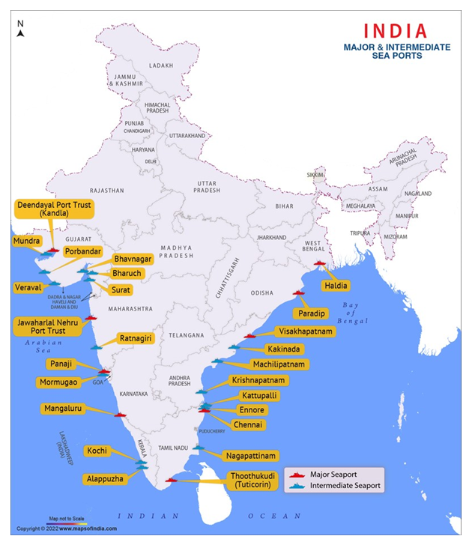
Multi-Purpose Seaweed Park (Tamil Nadu)
In News: Recently, On the third day of Sagar Parikrama Phase VIII, the Ministry of Fisheries, Animal Husbandry & Dairying laid the Foundation Stone for a Multi-Purpose Seaweed Park in Tamil Nadu.
About:
- In the Union Budget 2021, the finance minister announced the proposal to set up ‘Multipurpose Seaweed Park in Tamil Nadu’.
- Seaweeds are a type of marine algae, often found in coastal waters.
- It can vary in size and color and is used in various industries, including food, cosmetics, and agriculture.
- Seaweed is rich in nutrients and has diverse applications worldwide.
- The park aims to promote seaweed cultivation for employment, value-added products, and conservation.
Key Features:
- The seaweed park includes the promotion of seaweed cultivation in 136 coastal fishing villages in 6 coastal districts of Tamil Nadu namely Nagapattinam, Thanjavur, Tiruvarur, Pudukottai, Ramanathapuram and Thoothukudi.
- The Multipurpose Seaweed Park is a significant investment to promote seaweed cultivation and research, benefiting scientists, researchers, and local communities.
- The seaweed park will also provide a single window support for the entrepreneurs, processors etc. to access information on schemes, licenses/approvals required, while also providing space to set up processing centers.
|
Sagar Parikrama Yatra |
|
Third Rail of Kolkata Metro Railway
In News: Recently, Indian Railways’ Kolkata Metro has decided to replace its steel third rail with a composite aluminum third rail.
About:

- The third rail system is a means of providing electric power to a train through a conductor placed alongside the rails.
- Kolkata Metro Railway has been using steel Third Rail for the last 40 years.
- Kolkata Metro Railway has now decided to use composite Aluminium Third Rail in all the upcoming corridors being undertaken for construction along with retrofitment in existing corridors with steel Third Rail.
- This move aligns Kolkata Metro with prestigious international metro systems like those in London, Moscow, Berlin, Munich, and Istanbul, which have also made the shift from steel to aluminium third rails.
The advantages of aluminium composite third Rail over steel third Rail include:
- Reduction in resistive current loss and improved Traction voltage level.
- Reduced maintenance and life cycle cost.
- Improved acceleration with the same rolling stock.
- Enhanced efficiency of train operations.
- Significant improvements in energy efficiency and a reduction in carbon footprint.
- Improved train headway, leading to better train scheduling and operations.
Agricultural Cess - Edukemy Current Affairs
In News: The government has recently exempted imports of LPG (liquid petroleum Gas), liquified propane, and liquified butane from the 15% Agriculture Infrastructure Development Cess (AIDC) with effect from September 1.
About:
- This exemption reverses the previous imposition of the agriculture cess (also called Agriculture infrastructure and development cess (AIDC)) on these goods in July.
- It is also imposed on Crude Palm Oil.
Cess
- Cess is a kind of special-purpose tax which is levied over and above basic tax rates.
- It is levied by the government for a specific purpose.
- For example, a cess for financing primary education – the education cess (which is imposed on all central government taxes) is to be spent only for financing primary education (SSA) and not for any other purposes.
Agriculture Infrastructure Development Cess (AIDC)
- The AIDC was introduced in the Budget 2021.
- It is a type of special-purpose tax that aims to raise funds specifically for financing the development of agriculture infrastructure in India.
- The purpose of the AIDC is to raise funds to finance spending on developing agriculture infrastructure.
Curbs on rice exports - Edukemy Current Affairs
In News: Recently, government has levied certain restrictions on rice export to check the domestic rise in prices and to ensure domestic food security.
Rice Production in India and Export:
- India is the second-largest producer of rice in the world, after China. As per Second Advance Estimates, the estimated production of Rice for 2022-23 is 1308.37 Lakh Tonnes.
- West Bengal is the largest rice producer in India. In certain states like Tamil Nadu, some farmers anticipate delayed planting due to insufficient rainfall from the southwest monsoon.
- India is the world’s largest exporter of rice, with a 45% share.
- Shipments of non-Basmati rice recorded a growth of 7.5% in May despite the imposition of a 20% export duty on white rice and the prohibition of broken rice exports by the government in September last year.
- The export of non-Basmati rice has demonstrated a consistent upward trend over the past three years.
- According to government-provided statistics, up until August 17 of this year, total rice exports have surged by 15%. It reached 7.3 million tonnes in contrast to the 6.3 million tonnes during the same period last year.
Restrictions on Rice Export:
- In May 2022, the government banned wheat exports.
- In June 2023, restrictions on stock holdings were imposed.
- In September 2022, the export of broken rice was prohibited, and a 20% tariff was imposed on non-parboiled white grain shipments.
- In July 2023, non-basmati white rice exports were entirely prohibited, with only parboiled non-basmati and basmati rice allowed.
- Recently, a 20% duty was introduced on all parboiled non-basmati rice exports.
Benefits for the farmers:
- Increase in MSP- The government has increased the Minimum Support Price (MSP) for rice.
- Increase in price- Paddy procurement by rice millers are at a price higher than the MSP.
- Check in price rise- The prices will not decline for farmers, restrictions on exports will ensure that there is no steep climb in rice prices in the market.
Challenges of the restriction:
- Export limitations can be bypassed through inaccurate classification. White non-basmati rice has been exported using codes intended for parboiled and basmati rice.
- The $1,200 Minimum Export Price is considered too high. Only specific rice varieties achieve these prices, accounting for just around 15% of basmati exports.
- The earnings of the farmers are impacted due to the restrictions.
Way Forward:
- Proper classification of rice should be done as common and speciality rice, rather than just as Basmati and non-Basmati.
- Protect varieties of rice with Geographical Indication (GI) recognition from general market interventions.
- For Basmati rice, permit exports to continue or set a minimum export value, such as $900 per tonne, as new crop arrivals are expected to meet demand due to good quality and consistent supply.
AYUSHMAN BHAV CAMPAIGN - Edukemy Current Affairs
In News: Recently, the President of India virtually launched the Ayushman Bhav Campaign.
About
Ayushman Bhava is an umbrella campaign that will ensure the optimum delivery of health schemes to every intended beneficiary, including those in the last mile.
Component of Ayushman Bhava Campaign
- Ayushman Apke Dwar 3.0: It aimed at the creation and distribution of Ayushman cards to all remaining eligible beneficiaries;
- Ayushman Mela: Weekly health melas will be held at the level of AB-HWCs and Community Health Centres (CHCs) and
- Ayushman Sabha: A village/ward level sabha to be held to enhance awareness about various health care schemes and services.
- Ayushman Gram Panchayat’: The campaign will eventually ensure gram/nagar panchayat to attain the status of ‘Ayushman Gram Panchayat’ or ‘Ayushman Ward’ with saturation of selected health indicators.
PM-WANI: India's Digital Landscape
In News: The (PM-WANI) scheme is set to revolutionize public Wi-Fi in India. PM-WANI can be a potential game-changer for India’s digital public infrastructure.
About Digital Public Infrastructure
- DPI is a digital network that enables countries to safely and efficiently deliver economic opportunities and social services to all residents.
- DPI allows people to open bank accounts and receive wages faster and more easily. It allows governments to support citizens more quickly and efficiently, especially during emergencies. And it enables entrepreneurs to reach customers far and wide.
- DPI can be compared to roads, which form a physical network that connects people and provides access to a huge range of goods and services.
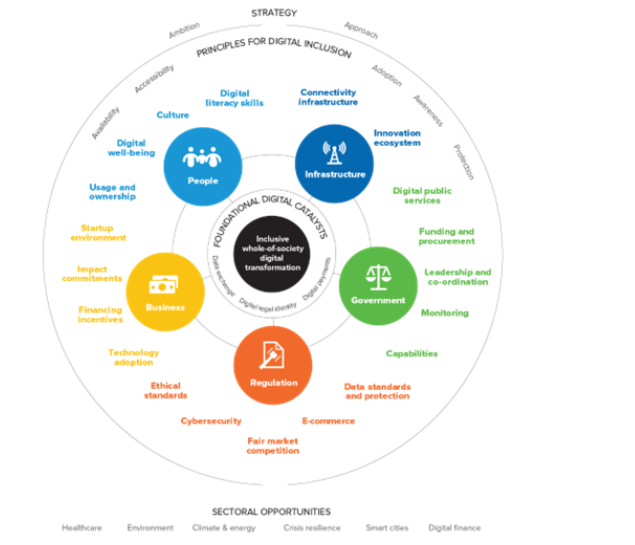
About PM-WANI
- PM-WANI, initiated by the Department of Telecom (DoT) in December 2020, is a significant program aimed at enhancing the accessibility of public WiFi hotspots to establish a robust digital communication network across the country, especially in rural areas.
- This framework enables various entities, such as shopkeepers, tea stall owners, or Kirana store owners, to establish public Wi-Fi hotspots and offer internet services to customers.
- PM-WANI aligns with the objectives outlined in the National Digital Communications Policy, 2018 (NDCP), which focuses on building a strong digital communications infrastructure.
Importance:
- To promote ease of doing business and encourage local businesses to provide Wi-Fi, it has been decided that last-mile Public Wi-Fi providers do not need licenses, registrations, or fees to the DoT.
PM-WANI Ecosystem:

Status:
- As of November 2022, the PM-WANI central registry recorded 188 PDO aggregators, 109 app providers, and 11,50,394 public WiFi hotspots.
Benefits of PM-WANI:
- Expanding internet access in rural and remote areas.
- Offering an affordable and convenient alternative to internet access compared to expensive options like 5G.
- Encouraging innovation and competition in the internet market.
|
Sachet Internet:
|
Challenges of PM-WANI:
- Ensuring Wi-Fi quality and user experience, involving bandwidth, user management, device compatibility, and data security.
- Addressing security concerns like data breaches, hacking, and malware.
- Potential challenges for mobile telecom companies regarding market share and revenue due to PM-WANI's affordability.
- Expanding and maintaining PM-WANI in areas with low internet demand and high operational costs.
PM-WANI as a Game-Changer for India’s Digital Public Infrastructure:
- PM-WANI is a vital component of India's Digital Public Infrastructure (DPI), making internet access more inclusive and bridging the digital divide.
- Leveraging existing physical and social infrastructure like shops, post offices, and schools to create a widespread network of Wi-Fi hotspots.
- Utilizing existing digital infrastructure, such as Aadhaar and UPI, for secure authentication and payment of Wi-Fi services.
- Empowering citizens and communities by granting access to information, knowledge, opportunities, and services, fostering participation in the digital economy and society.
Old Pension Scheme (OPS): Red Flag by RBI
In News: Recently, the Reserve Bank of India (RBI) has warned that reverting to the Old Pension Scheme (OPS) from the New Pension Scheme (NPS) can be a “major step backwards” in fiscal management.
Key Points of the Observations by RBI:
- Reverting to the Old Pension Scheme (OPS) might briefly reduce state expenses, but it will surpass the New Pension Scheme (NPS) contributions by the 2030s.
- This shift could inflate the pension burden by around 4.5 times compared to NPS.
- By 2060, this additional OPS burden could reach about 1% of GDP annually for states.
- This action is seen as fiscally unsustainable and goes against the prevalent pattern of adopting defined contribution plans.
New Pension Scheme (NPS):
- Proposed by the Project OASIS report became the basis for pension reforms and what was originally conceived for unorganised sector workers, was adopted by the government for its own employees.
- The NPS was for prospective employees; it was made mandatory for all new recruits joining government service from January 1, 2004.
- The defined contribution comprised 10 percent of the basic salary and dearness allowance by the employee.
- In 2019, the government increased its contribution to 14 percent of the basic salary and dearness allowance.
- Schemes under the NPS are offered by nine pension fund managers. It is sponsored by SBI, LIC, UTI, HDFC, ICICI, Kotak Mahindra, Aditya Birla, Tata, and Max.
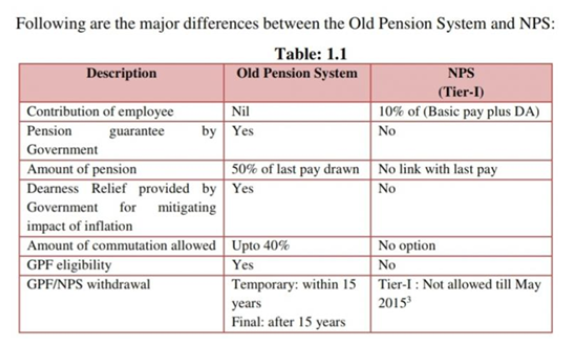
Advantages of New Pension Scheme:
- NPS subscribers have complete freedom to allocate their savings to equities, corporate bonds or government securities, or any combination of the three.
- Risk-averse investors can simply allocate all their money to bonds or gilts in NPS, altogether skipping stocks.
- A review of Nifty50 over the past 20 years reveals that while it commonly provided losses during one-year intervals, extending one's holding time to 10 years lowered the loss probability to zero while earning an 11–12% return.
- Over the past ten years, NPS managers have achieved a 13–14% return on stocks and a 5–9% return on bonds and government securities, compared to the EPFO's struggle to report an 8–8.5% return on its "safe" debt portfolio.
- With NPS, an employee has greater control over his pension as he can save more or allocate more to equities.
SHREYAS scheme - Edukemy Current Affairs
In News: According to the Ministry of Social Justice and Empowerment the “SHREYAS” has played a significant role in empowering students from Scheduled Castes (SC) and Other Backward Classes (OBC) in India since 2014-15.
About
The umbrella scheme of "SHREYAS" comprises 4 central sector sub-schemes namely "Top Class Education for SCs", "Free Coaching Scheme for SCs and OBCs", "National Overseas Scheme for SCs" and "National Fellowship for SCs".
About the Subscheme of SHREYAS
- Free Coaching Scheme for SCs and OBCs: The objective of the Scheme is to provide coaching of good quality for economically disadvantaged Scheduled Castes (SCs) and Other Backward Classes (OBCs) candidates to enable them to appear in competitive and entrance examinations
- Top-Class Education for SCs: The Scheme aims at recognizing and promoting quality education amongst students belonging to SCs, by providing full financial support. The Scheme will cover SC students pursuing studies beyond the 12th class.
- National Overseas Scheme for SCs: Under this scheme financial assistance is provided to the selected students from SCs (115 slots); De-notified, Nomadic, and Semi-Nomadic Tribes (6 slots); landless agricultural laborers and traditional artisan categories (4 slots), for pursuing masters and Ph.D. level courses abroad.
- National Fellowship for SC Students: Under the scheme, fellowship is provided to Scheduled Castes students for pursuing higher education leading to M.Phil/Ph.D. degrees in Sciences, Humanities, and Social Sciences in Indian Universities/Institutions/ Colleges recognized by University Grants Commission (UGC).
Kisan Rin Portal - Edukemy Current Affairs
In News: Recently, the government launched the Weather Information Network Data Systems (WINDS) portal and the “Kisan Rin Portal”.
About Kisan Rin Portal:
- The Kisan Rin digital platform aims to provide a holistic perspective on farmer-related information, encompassing details about scheme utilization progress, loan disbursement specifics, and claims for interest subvention.
- Kisan Rin Portal was launched as part of the Kisan Credit Card (KCC) scheme to revolutionize the agriculture sector.
- This initiative seeks to foster improved collaboration with financial institutions, streamlining the process of granting agricultural credit for enhanced efficiency.
Weather Information Network Data Systems (WINDS) portal:
- WINDS harnesses sophisticated weather data analytics to furnish stakeholders with actionable insights for making informed decisions pertaining to agriculture and weather-related matters.
- The portal also comprises a comprehensive manual designed to assist stakeholders in comprehending its functionalities, interpreting data, and maximizing its effective utilization.
Data-driven innovations in agriculture
In News: Recently, United Nations Development Programme (UNDP) and the National Bank for Agriculture and Rural Development (NABARD) signed a Memorandum of Understanding (MoU) to co-create data-driven innovations in agriculture and food systems to support smallholder farmers.
About:
- The partnership’s focus is on improving climate resilience in agriculture, and it involves the dissemination of collaborative digital public goods such as DiCRA (Data in Climate Resilient Agriculture).
- DiCRA provides open access to key geospatial datasets relevant to climate-resilient agriculture and is curated by UNDP and partner organizations.
- This collaboration aims to enhance the lives and livelihoods of smallholder farmers by sharing open-source data for product development, technology transfer, and policy framing.
- This is seen as a significant opportunity to leverage data and present it as a digital public infrastructure for India’s rural farming community.
- Open data innovations like this can promote best practices, optimize agricultural investments, and enhance the resilience of smallholders, especially women, against various risks.
‘Bima Sugam’ online platform
In News: Recently, Insurance Regulatory and Development Authority of India (IRDAI) has formed a steering committee to act as the apex decision-making body for the creation of its ambitious ‘Bima Sugam’ online platform.
About:
Bima Sugam platform:
- Bima Sugam will be a ‘one-stop destination’ for people's insurance-related needs. These include services such as policies, portability facilities, change of agents, settling of claims, and more.
- Buyers can directly purchase life, motor, or health policies through web aggregators, brokers, banks, and insurance agents.
- Insurance companies will be major shareholders in the platform, which will offer services via an ‘e-insurance account’ (E-IA).
- Ownership:
- Life insurance and general insurance companies will own a 47.5 per cent stake each, while brokers and agent bodies will own 2.5 per cent each.
- Benefits of the portal:
- Act as a centralised database;
- Assist the insured/buyers in porting their respective policies based on coverage and pricing;
- Give people a wide choice to pick and choose policies and view all their policies;
- Reduce commission paid to intermediaries; and,
- Pave the way for a speedy acceptance of new/sandbox products.
|
IRDAI: |
|
Unified Registration Portal for GOBARdhan
In News: Recently, The Department of Drinking Water and Sanitation (DDWS), Ministry of Jal Shakti has introduced a Unified Registration Portal for GOBARdhan to streamline the registration of Compressed Bio-Gas (CBG) and biogas plants nationwide.
About:
- Galvanizing Organic Bio-Agro Resources Dhan (GOBARdhan) is an umbrella initiative of the Government of India.
- It aims to transform organic waste, including cattle dung, agricultural residues, and biomass, into valuable resources like biogas, CBG, and organic manure.
- The Department of Drinking Water and Sanitation, Ministry of Jal Shakti is the coordinating department for GOBARdhan.
- This initiative supports high-value Biogas/CBG production and promotes the use of bio-slurry to improve soil health, carbon content, and water retention.
Unified Registration Portal for GOBARdhan:
- Anyone who operates or intends to set up a biogas/ CBG/ Bio CNG plant in India can obtain a registration number by registering in this unified registration portal.
- The registration number is required to avail benefits/ support from other Ministries/ Departments.
More information about the news:
- Department of Drinking Water and Sanitation (Nodal Department for GOBARdhan) announced that over 1163 biogas plants and 426 CBG plants have successfully registered on the portal to date.
- These registered CBG/Biogas plants are eligible for assistance under the Market Development Assistance (MDA) scheme of the Department of Fertilizers, Ministry of Chemicals & Fertilizers.
|
Market Development Assistance (MDA) scheme: |
|
Indian Standards on Biofuel to Aid GBA’s Clean Energy Goals
In News: The Bureau of Indian Standards (BIS), the National Standards Body of India commits to complement the green initiatives of the country through the development of relevant standards.
About
- The Bureau of Indian Standards (BIS) has developed nine Indian standards on biofuels, including specifications for anhydrous ethanol, biodiesel, biogas, biodiesel-diesel fuel blends, hydrous ethanol, E85 fuel, E20 fuel, aviation turbine fuel containing synthesized hydrocarbons, and ethanol as a fuel for spark-ignition engine-powered vehicles.
- BIS is working on a standard for paraffinic (green) diesel derived from 2G feedstock.
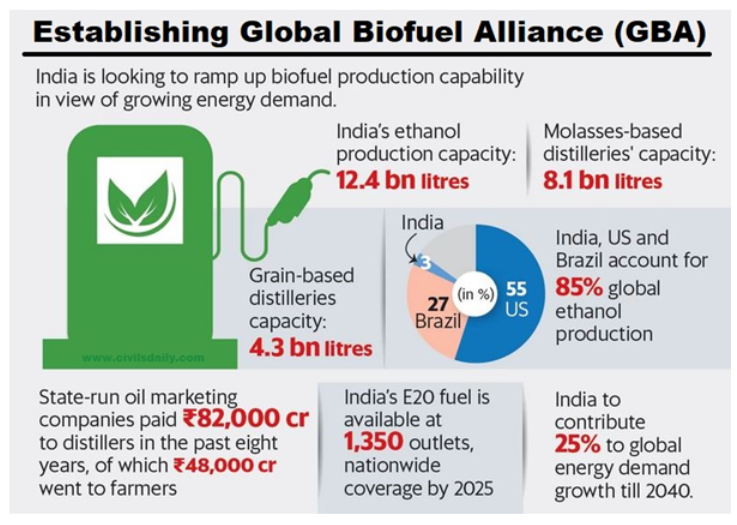
Pharma-MedTech R&D & Innovation Policy
In News: Recently, the Union Minister of Chemicals and Fertilizers and Minister of Health & Family Welfare in India, has launched the National Policy on Research and Development and Innovation in the Pharma-MedTech Sector.
About the Policy:
- The Policy will help to create an ecosystem of skills and capacities including the academia and the private sectors, and give impetus to new talent among the youth through start-ups.
- The Scheme will focus on transforming India into a high volume, high value player in the global market of pharmaceuticals, meeting the quality, accessibility, and affordability goals.
Benefits of the Scheme:
- Development of research infrastructure- The scheme would help in building a world-class research atmosphere at NIPERs and other institutes and help in creating talent pool of qualified trained students.
- This scheme will promote industry-academia linkages by promoting collaboration between the private sector and govt institutes.
- Focus on certain priority areas which will help India's pharma industry leapfrog and radically strengthen its position in the world market as innovation accounts for 2/3rd of global pharmaceutical opportunities.
- The scheme would help in launching of commercially viable products which will accelerate the growth of the Indian pharmaceutical sector by increased revenue and creating employment opportunities.
- The scheme would help in the development of affordable, accessible solution for primary area of health concern thus reducing healthcare burden.
RoDTEP scheme: Duty-Tax Remission for Exports
In News: Recently, the government extended export benefits under the RoDTEP scheme for one more year till June 2024.
About:
- The RoDTEP scheme provides exporters with refunds for taxes, duties, and levies incurred during the manufacturing and distribution of goods, which are not reimbursed through other mechanisms at the central, state, or local levels.
- The scheme is operational since September 2021.
- It will help the exporting community to negotiate export contracts in the present international environment on better terms.
- The RoDTEP scheme replaced the Merchandise Exports from India Scheme (MEIS), which concluded the previous year.
- The RoDTEP Committee operates within the Department of Revenue.
- Its primary responsibility is to review and recommend ceiling rates for different export sectors under the RoDTEP Scheme.
Social bonds - Edukemy Current Affairs
In News: Recently, The National Bank for Agriculture and Rural Development (Nabard) issued India’s first ‘AAA’ rated Indian Rupee-denominated Social Bonds aggregating ₹1,040.50 crores at a coupon rate of 7.63 percent.
About:
- The social bonds issued by NABARD have received ‘AAA’ ratings from CRISIL and ICRA, and they will be listed on the BSE (Bombay Stock Exchange).
Social bonds
- A social bond is a type of financial instrument issued by governments, international organizations, or corporations to raise funds for projects and initiatives that have a positive social impact on society.
- These bonds are designed to finance projects that address various social issues, such as healthcare, education, affordable housing, poverty alleviation, and environmental sustainability.
Sustainability Bond Framework:
- NABARD recently introduced a Sustainability Bond Framework, aimed at financing and refinancing green and social projects.
- Eligible social projects include affordable basic infrastructure, access to essential services, affordable housing, employment generation, food security, socioeconomic advancement, and empowerment.
Balsams - Edukemy Current Affairs
In News: Recently, Balsams (genus Impatiens) have been in full bloom in Munnar, Kerala.
About:
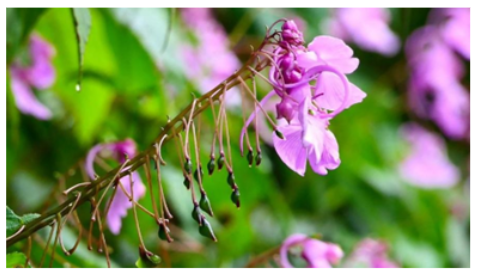
- Balsams are sometimes referred to as ‘touch-me-not’ due to their tendency to burst and distribute mature seeds upon touch.
- Balsams refer to plants belonging to the genus Impatiens. These are flowering plants known for their small pink flowers.
- They are locally called as Kasithumba and Onappovu.
- Balsams are considered significant indicator species for climate change, reflecting alterations in plant populations when climate change occurs.
- Found in:
- Of the 220 balsam species in India, 135 are found in the southern Western Ghats.
- Anamudi, the highest mountain in the Western Ghats, and the surrounding high ranges are known for the diversity of wild balsams.
- Idukki district, where Munnar is located, is renowned for its diverse range of balsams, earning it the nickname of a “balsam paradise” among scientists.
- Around 46 species of balsams have been discovered in the altitude of Munnar. No other place in the world has such diversity.
Kaimur Wildlife Sanctuary - Edukemy Current Affairs
In News: Bihar is set to get a second tiger reserve in Kaimur district (Kaimur Wildlife Sanctuary) by the end of 2023 or early 2024.
About:
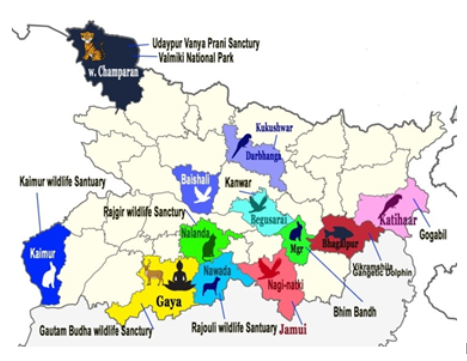
- Kaimur Wildlife Sanctuary, Bihar’s largest, covers Kaimur and Rohtas Districts.
- It was established in 1979.
- It is home to rare and endangered flora and fauna. Rohtasgarh Fort and Shergarh Fort are also located in these forests.
- Kaimur district has a large forest cover and is home to tigers, leopards and chinkaras.
- Vegetation: Tropical Dry Mixed Deciduous, Dry Sal Forests, Boswellia Forests and Dry Bamboo Brakes.
- There are several waterfalls of which the finest are Karkat Waterfall, Manjhar Kund, Dhua Kund.
- There are several Dams and lakes, including Anupam Lake, Karamchat dam and Kohira Dam.
More Information:
- 1st tiger reserve of Bihar:
- The Valmiki Tiger Reserve (VTR) in West Champaran district, is currently the 1st and only tiger reserve of the state.
- Need for the 2nd tiger reserve:
- A report of the NTCA said that the tiger population in the Valmiki reserve has increased from 31 in 2018 to 54.
- The total tiger count in the State currently is 54.
- There is a need for the second tiger reserve in the state as Valmiki TR has reached its saturation point of 50 tigers.
PET46 - Edukemy Current Affairs
In News: A recent study involving scientists from Kiel University (Germany) has discovered a deep-sea enzyme, PET46, capable of continuously breaking down PET plastic, commonly found in plastic bottles.
About:
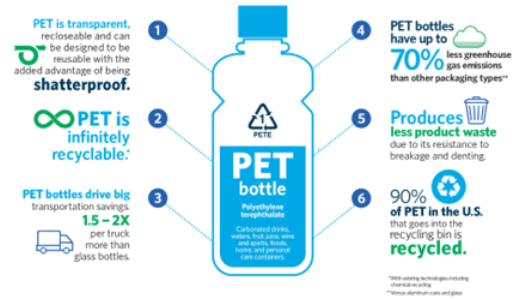
- PET46 has the ability to degrade both very long-chain PET molecules (polymers) and short-chain PET molecules (oligomers), which means that degradation can be continuous.
- It uses a completely different mechanism for substrate binding than previously known PET-degrading enzymes.
- A 'lid' of 45 amino acids above the enzyme's active center is crucial for binding, whereas in other PET enzymes, aromatic amino acids close to the active site are typical.
- This research is part of the PLASTISEA project and sheds light on the potential for plastic waste degradation in the sea and on land.
- The discovery of PET46 has been made from deep-sea organisms belonging to the archaea domain.
- Archaea is a domain of single-celled microbes lacking cell nuclei and are therefore prokaryotes.
PET plastic
- PET plastic, or polyethylene terephthalate, is a common type of plastic used to make bottles, containers, and synthetic fibres.
- It is known for its transparency, lightweight nature, and recyclability.
- PET is widely used for packaging beverages, food, and personal care products.
Kole wetlands - Edukemy Current Affairs
In News: Kole wetlands of Kerala face the threat of alien plants
About
- The Kole wetlands in Kerala, a Ramsar site of international importance celebrated for its rich biodiversity, are confronting a fresh menace in the form of an invasive alien plant species known as ‘Cabomba furcuta’, commonly referred to as Pink Bloom.
- This species, originally hailing from Central and South America, was initially introduced to Kerala as an aquarium plant but has now emerged as a serious threat to the Kole fields, exacerbating existing challenges posed by invasive species like water hyacinth and Salvinia molesta.
- Despite its visually striking pink flowers, ‘Cabomba furcuta’ presents a substantial risk to the region's biodiversity and agricultural productivity.
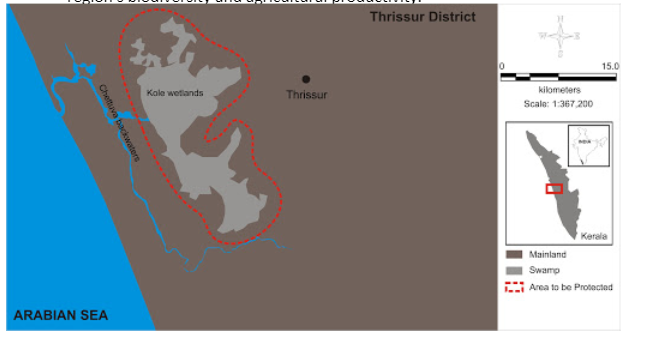
Climate Change and the Indian Dairy Sector
In News: India, the world’s largest milk producer for over half a century, is struggling with runaway milk prices. Despite producing a quarter of global milk production, milk prices are at an all-time high. Average retail price of milk has increased by 18 % in the past two years.
Causes of Inflation in prices of milk:
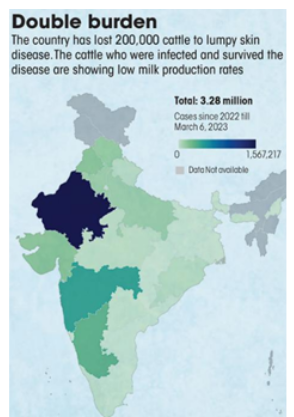
- Infectious lumpy skin disease: The viral pox disease LSD is novel to the country and has infected 3.2 million cattle and buffaloes across the country in the past year and killed over 0.2 million animals.
- Milk production of the surviving animals has dropped by 20 to 50%,
- Rebound in consumer demand: During COVID the demand and production of milk took hit. However post COVID increased demand for milk and milk products were witnessed, leading to increase in price. .
- Missing 17 million Cattles: According to an estimates the country has likely missed 16.84 million artificial inseminations and have led to stagnation in the number of high-yield dairy cattle and buffaloes between 2020 and 2022.
- This led to double burden of milk loss and incurring additional maintenance cost till the animal enters the next oestrus cycle.
- Fodder Inflation: Farmers faced an acute shortage of dry fodder (wheat straw, along with other items) in 2022, and have been facing a steady fodder inflation since then. The shortage was fuelled by fall in wheat stocks due to an unusually hot March 2022.
What is Artificial Insemination?
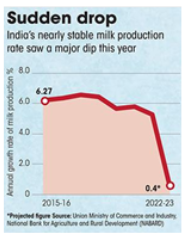
- In artificial insemination technology, semen is collected from a bull with proven superior genetic merits and is stored at ultra-low temperatures (known as cryopreservation) at the country’s more than 99,000 artificial insemination centres.
- It is then introduced to the reproductive tract of the female cattle at a time when it is ready for conception (also known as oestrus period that coincides once in 21 days).
- The Union government implements the Nationwide Artificial Insemination Programme (NAIP), as part of the Rashtriya Gokul Mission scheme for genetic upgradation of all breeds of bovines and enhances their milk productivity using advanced technologies.
Factors affecting the Indian Dairy Sector:
- Climate Impact:
- Milk Productivity: Increasing temperatures could decrease milk production and reproductive success in cattle. Increasing temperatures could reduce milk production in India’s arid and semi-arid regions by 25% by the end of 2085.
- Increased sensitivity to heat stress: Lactating dairy cows have an increased sensitivity to heat stress. Furthermore, higher yielding cows are more challenged by heat stress than lower yielding animals.
- Reproductive success: Heat stress also decreases reproductive success. Elevated temperatures affect the cow’s ability to display natural mating behaviour, as it reduces both the duration and intensity of oestrus expression.
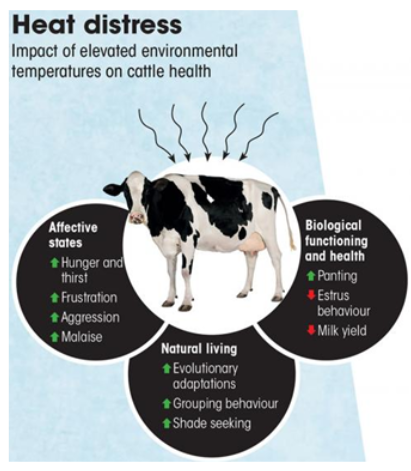
-
- Exodus of Dairy Farmers: Dairy farmers find the sector is no longer lucrative and that they are incurring huge losses. This is leading to an exodus of farmers from the dairy sector.
- Government Policies:
- Sex-sorted semen production: The policy aims to produce semen of only female calves up to “90% accuracy”. This has been done to enhance milk production and limit stray cattle population. However this policy overlooks the utility of male cattle and could eliminate them slowly.
- Anti-Slaughter rules: There is also the issue of the utility of female animals after they become unproductive, because it has become difficult to sell cows due to the anti-slaughter rules across many States.
The State of the Rhino Report, 2023
In News: Recently, the International Rhino Foundation (IRF) has released the “State of the Rhino, 2023” report, which provides population estimates and trends for the five remaining rhino species in Africa and Asia.
About:
- Every year, World Rhino Day is observed on 22nd September to spread awareness for all five species of rhino and the work being done to save them.
- It was first announced by the World Wildlife Fund (WWF) - South Africa in 2010.
Key Findings of the Report:
- According to the report, the two most significant factors causing rhino populations to decline are poaching and habitat loss, but climate change is also increasingly impacting many facets of their survival.
- Poaching still threatens all five rhino species -- black, white, greater one-horned, Sumatran, and Javan -- and has increased in several regions that had not previously been targeted.
- The collaboration among India, Bhutan, and Nepal, along with strict government protection and management, has led to a 20 percent increase in their population over the past decade. India is estimated to be home to 3,262 rhinos.
- Black rhino populations are increasing despite poaching pressure. However, South Africa is grappling with devastating poaching losses of its white rhinos, particularly in certain reserves.
- One concerning aspect highlighted in the report is that the status and whereabouts of 12 of the approximately 76 remaining Javan rhinos are unknown. Sumatran rhinos are also increasingly difficult to find, raising uncertainty about their population in the wild.
- The report underscores the need for continued efforts to protect and conserve rhinos and their habitats, address poaching, and mitigate the effects of climate change to ensure the survival of these iconic species.
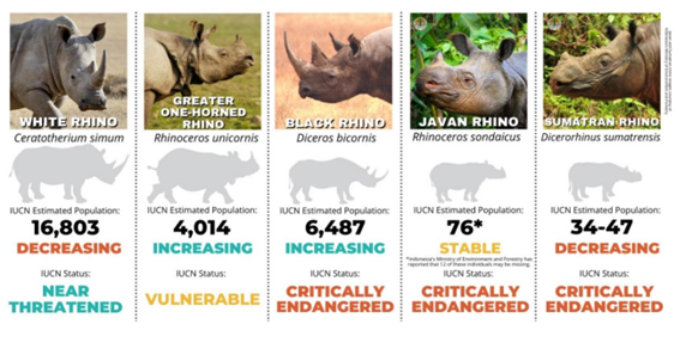
Veerangana Durgavati Tiger Reserve
In News: Recently, Madhya Pradesh, which is home to the most number of tigers in the country, has got a new protected area for the big cats named ‘Veerangana Durgavati Tiger Reserve’, the seventh in the state.
About:
- Veerangana Durgawati Wildlife Sanctuary is spread across Sagar, Damoh, and Narsinghpur districts of Madhya Pradesh.
- It is the seventh tiger reserve in Madhya Pradesh.
- Area: 2,339 square kilometers.
- Naming: It is named after Rani Durgavati, a queen of the Gondi people.
- Culture: The Singorgarh Fort can be found inside the reserve.
- It will encompass areas within the Nauradehi Wildlife Sanctuary and Durgavati Wildlife Sanctuary.
- A green corridor linking Panna Tiger Reserve (PTR) with Durgavati will be developed for the natural movement of the tiger to the new reserve.
- Rivers: Some areas of the reserve are situated in the Narmada and Yamuna River basins.
- Vegetation: Dry deciduous type
- Flora: The chief floral elements include Teak, Saja, Dhaora, Ber, Amla, etc.
- Fauna: Tiger, leopard, wolf, jackal, Indian fox, striped hyena, Nilgai, Chinkara, Chital, Sambhar, Black Buck, Barking deer, Common Langur Rhesus Macaque, etc.
More Information:
- Madhya Pradesh has consistently held the title of the “tiger state,” with its tiger population increasing from 526 in 2018 to 785 in the 2022 census.
Tungareshwar Wildlife Sanctuary
In News: The Surya Regional Water Supply Project has achieved a milestone by completing the tunneling work of the Tungareshwar tunnel recently.
About:
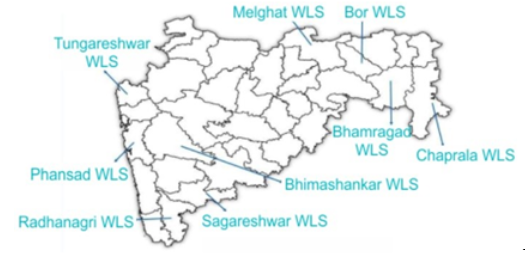
- Tungareshwar Wildlife Sanctuary also known as Tungareshwar National Park is located in the Palghar district of Maharashtra, 75 km away from Mumbai.
- The sanctuary forms a corridor between Sanjay Gandhi National Park and Tansa Wildlife Sanctuary.
- It is characterized by hilly terrain, dense forests, and small rivers or streams.
- Vegetation:
- There are three different types of forests – Dry Deciduous, Moist Deciduous and Semi Evergreen.
- Flora and Fauna:
- It is home to several species of trees, including teak, bamboo, and mango.
- Some commonly spotted animals in the sanctuary include Leopard, Wild Boar, Barking Deer, Langur, Bonnet and Rhesus Macaque, and Black-naped Hare.
- A multitude of birds, including the Crested Serpent-eagle, Jungle Owlet, White-eyed Buzzard, Oriental Honey-buzzard, Emerald Dove and Heart-spotted Woodpecker, can be found here.
- Temple:
- Several ancient temples are within its boundaries. The most famous of these temples is the Tungareshwar Temple, dedicated to Lord Shiva.
Mithun (‘Food Animal’)
In News: Recently, Northeast’s Mithun got a ‘food animal’ tag from the Food Safety and Standards Authority of India (FSSAI).

About:
- Mithun is a ruminant species of the Bovidae family found in Arunachal Pradesh, Nagaland, Manipur and Mizoram.
- It is also the state animal of both Arunachal Pradesh and Nagaland.
- The Mithun or gayal (Bos frontalis) is considered a descendant of the Indian Gaur or bison.
- It is known as the ‘cattle of the mountain’.
- Characteristics:
- The mithun is semi-domesticated and is reared in a free-range forest ecosystem.
- Since the soil in these parts is acidic and low in salt content, mithuns have an affinity for salt.
- Conservation status
- IUCN: Vulnerable
- CITES: Appendix I.
- Initiatives:
- Indian Council of Agricultural Research (ICAR) has launched the M-ANITRA app to register mithun farmers as “buyers” and “sellers” with the aim to help them do business at competitive prices.
- Objective of recognition
- To help farmers and tribal village communities benefit commercially from the sale and processing of mithun meat.
- Other animals having food animal tag: Himalayan yak.
World Ozone Day - Edukemy Current Affairs
In News: Recently, The Ministry of Environment, Forest and Climate Change (MoEF&CC) has celebrated the 29th World Ozone Day.
About:
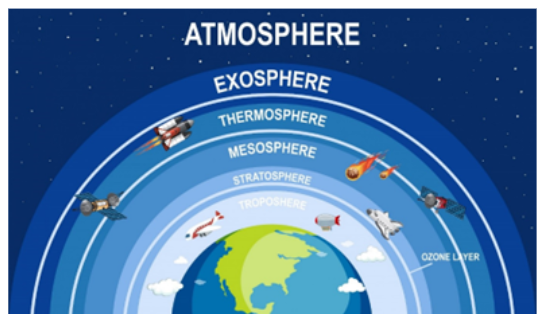
- World Ozone Day is celebrated on 16th September each year to commemorate the signing of the Montreal Protocol.
- Montreal Protocol an international environmental treaty for phasing out of production and consumption of Ozone Depleting Substances, that came into force on 16th September in 1987.
- World Ozone Day is celebrated to spread awareness among people about the depletion of Ozone Layer and the measures taken/ to be taken to preserve it.
- The theme for World Ozone Day 2023 is “Montreal Protocol: fixing the ozone layer and reducing climate change”.
Ozone layer
- It is located in the stratosphere between 10 and 40 kilometers above Earth's surface, shields us from harmful UV radiation.
- This protective layer, known as stratospheric ozone or good ozone, prevents adverse health effects like cataracts and skin cancer and safeguards agriculture, forestry, and marine life.
- However, man-made Ozone Depleting Substances have caused ozone depletion in the stratosphere.
- The international community recognized the need for action, leading to the Vienna Convention in 1985 and the subsequent Montreal Protocol in 1987.
Vienna Convention
- Vienna Convention is an international treaty on the protection of the Ozone Layer.
- It came into force in 1985.
- Under this convention, the Montreal Protocol came into force in 1987 to repair the ozone layer to protect the earth’s Ozone Layer by phasing out production and consumption of Ozone Depleting Substances for end applications.
India’s achievements in implementation of Montreal Protocol
- India, a signatory since June 1992, has made significant strides in implementing the Montreal Protocol:
- India successfully phased out ODS like Chlorofluorocarbons, Carbon Tetrachloride, Halons, Methyl Bromide, and Methyl Chloroform for controlled uses by 1st January 2010.
- Hydrochlorofluorocarbons (HCFCs) are currently being phased out, with Stage-I completed from 2012 to 2016 and Stage-II in progress until the end of 2024.
- India exceeded its target, achieving a 44% reduction in HCFCs by 1st January 2020, compared to the baseline's 35%.
- India Cooling Action Plan (ICAP) launched in March 2019, focuses on reducing cooling demand, transitioning to alternative refrigerants, enhancing energy efficiency, and technological advancement.
- It aims to maximize socio-economic and environmental benefits through synergies with existing government programs.
- India has ratified the Kigali Amendment to the Montreal Protocol.
- As per the Kigali Amendment, India will complete its phase down of production and consumption of HFCs for controlled uses in 4 steps from 2032 onwards with cumulative reduction of 10% in 2032, 20% in 2037, 30% in 2042 and 85% in 2047.
- The Ozone Cell collaborates with the Indian Institutes of Technology to promote research and development of low global warming potential chemicals.
Gender Impact of Climate Change
In News: Climate change has impacted population groups unevenly and women face unique challenges due to the weather disruptions in Jharkhand.
Impact on Women and Girls:
- Due to male migration for work because of poor productivity in agriculture, women have to take on extra chores traditionally carried out by men such as roof repair.
- In case of health emergency, they are not willing to seek emergency medical services at night in male absence. This results in increased health risks due to limited access to healthcare.
- Due to scarcity of resources like water and firewood, burden on girls have increased with more responsibilities leading to school dropouts and early marriages.
- Due to limited awareness of migration safeguards, there have been cases of safety concerns, abuse and harassment during migration.
- Women working in factories endure poor conditions, lower wages and health hazards which make them vulnerable to health hazards, skin reactions, etc.
- Water and firewood scarcity increase the time spent collecting them by women, and cattle must graze in distant areas due to a lack of available grass (creating issues about the safety of girls).
- When women migrate for work and leave their children in the care of their father or grandparents, caregiving gets disrupted in their absence.
- Many times, the men use the money they send back for alcohol, which makes the children more vulnerable.
- Due to scarcity of water, they are unable to maintain proper hygiene which makes them vulnerable to several diseases.
Solutions to tackle the problems due to climate change:
- Rainwater harvesting systems
- Reviving traditional eating habits
- Promoting the cultivation of millets and local nutritious foods
- Awareness and preparedness for climate change impacts
- Awareness regarding legal safeguards regarding migration and harassment.
Deoxygenation in riverine ecosystems
In News: The findings of a study led by the Pennsylvania State University showed that of nearly 800 rivers across the United States and Central Europe, warming occurred in 87 percent and oxygen loss in 70 percent.
About the study:
- The study found that the rivers are warming and losing oxygen faster than oceans, and deoxygenation could “induce acute death” for certain aquatic species.
- Of nearly 800 rivers across the United States and Central Europe, warming occurred in 87 percent and oxygen loss in 70 percent.
- While urban rivers showed the most rapid warming, rural rivers witnessed the slowest warming but the fastest deoxygenation.
- The researchers also forecast future rates.
- Across all the rivers they studied, future deoxygenation rates were between 1.6 and 2.5 times higher than historical rates.
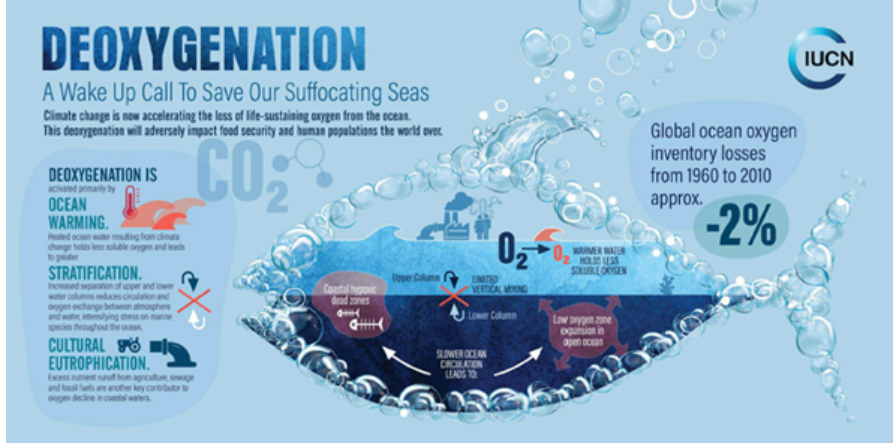
Why is this study significant?
- The implications of deoxygenation on riverine ecosystems have historically been overlooked.
- And there are significant implications for water quality and the health of aquatic ecosystems worldwide.
- Though riverine water temperature and dissolved oxygen levels are essential measures of water quality and ecosystem health, they are poorly understood as they are hard to quantify.
- Lack of consistent data across different rivers and the myriad of variables involved that can change oxygen levels in each watershed are the reasons for flawed assessments.
What are the implications of deoxygenation on riverine ecosystems?
- Deoxygenation drives greenhouse gas emissions.
- It leads to the release of toxic metals.
- If the oxygen levels get low enough, it becomes dangerous for aquatic life.
- Within the next 70 years, certain species of fish could die out completely due to longer periods of low oxygen levels, according to the study.
- Coastal areas, like the Gulf of Mexico, often have dead zones in the summer.
- It is reducing the quality and quantity of suitable habitat, also known as habitat compression, reducing growth rate, changing visual function, interfering with reproduction, and increasing disease susceptibility.
Collaborative Partnership on Forests
In News: Recently, the Collaborative Partnership on Forests (CPF) has issued a joint call to action looking ahead to 2030, stressing the immediate requirement for global efforts to unlock the potential of forests for the betterment of both people and the planet.
Key highlights
Significance of Forests: The CPF underscores the increasing recognition of the pivotal role forests play in attaining Sustainable Development Goals (SDGs). This involves their support for sustainable agricultural and food systems, their role in combatting climate change, reversing biodiversity decline, addressing desertification, and providing essential goods and services.
Progress and Obstacles: Swift action is essential to meet international goals and targets. This includes the imperative of expanding global forest cover by 3 percent by 2030. This expansion contributes to the preservation of carbon stocks, landscape restoration, and the creation of resilient ecosystems.
Four Key Focus Areas: The CPF outlines four primary areas of focus to tackle the challenges related to the protection, restoration, and sustainable management of forests.
- Strengthening Policies and Governance
- Enhancing Accessibility to Data and Decision-Making Tools
- Increasing Finance and Investment
- Boosting Communication and Awareness
Persuasion: Green Nudge - Edukemy Current Affairs
In News: According to a Chinese research, awarding customers with "green points" and altering the default choice for no single-use cutlery in online food purchases resulted in a 648% rise in such orders.
Nudge Theory:
- Richard Thaler, an economist, devised the nudge theory, which underpins the idea of using minor stimuli to promote actions that are in the best interests of an individual over the long run.
- He won the Nobel Prize in economics in 2017.
- Nudge policies are gaining popularity in India as decision-makers explore for alternatives to typical command-and-control legislation to encourage constructive social and economic development.
- Nudge policies used in programs such as Swachh Bharat Mission, GiveItUp campaign and Beti Bachao Beti Padhao (BBBP), etc.
Persuasion:
- Influencing someone's views, attitudes, or actions via argument and communication is the act of persuasion.
- It entails persuading or inspiring others to embrace a specific viewpoint by presenting facts in a convincing way.
- To accomplish its goals, it frequently relies on strong communication, empathy, trustworthiness, and the application of persuasive strategies.
- To persuade people to make ecologically responsible decisions, Green Nudges employ persuasive strategies include public awareness campaigns, social norms marketing, and community-based projects.
Green Nudge:
- A Green Nudge is a subtle intervention or persuasion technique designed to influence individuals to make environmentally friendly choices without limiting their options.
- These nudges encourage eco-conscious behaviour and have been effective in addressing environmental issues by guiding people toward sustainable decisions.
- Green Nudge Examples:
- India: Zomato’s “no-cutlery” option; Government’s LiFE movement, promoting environmentally conscious living, etc.
- UK: “The Big Switch Off” campaign to save energy by encouraging people to turn off lights and appliances when not in use.
- Netherland: “Pay as you throw” policy for garbage collection, where residents pay based on the amount of waste they produce, incentivizing reduced waste generation.
- USA: San Francisco’s ban on plastic bags discourages their use and promotes reusable alternatives.
Segur elephant corridor - Edukemy Current Affairs
In News: Recently, a Supreme Court-appointed committee has declared 12 private resorts along the Segur elephant corridor illegal.
About

- Segur elephant corridor is vital for the movement of elephants and other wildlife between habitats in the Nilgiri Biosphere Reserve.
- The Sigur Elephant Corridor, the only one of its kind connecting Western and the Eastern Ghats and facilitating easy movement of about 6,300 Asiatic elephants from Kerala, Tamil Nadu, and Karnataka.
- Corridor causes displacement of over 12,000 people is facing stiff resistance from rights activists and agencies supporting indigenous communities as the project lack provisions for co-existence and community-based forest management.
- The corridor will connect Nagarhole, Bandipur, Wayanad, Mudumalai, Nilgiri North, B.R. Hills, and Sathyamangalam forest areas spread in Kerala, Tamil Nadu, and Karnataka.
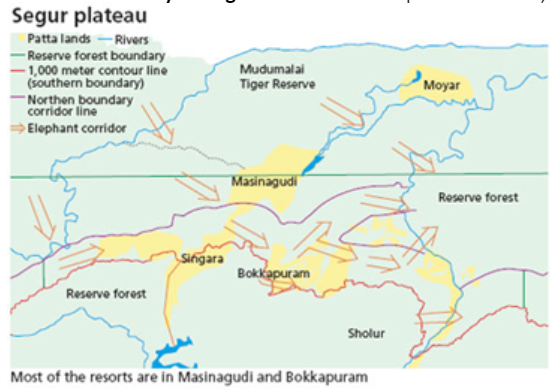
Anamudi Shola national park - Edukemy Current Affairs
In News: The Munnar Wildlife Division in Idukki, India, has achieved a remarkable transformation of the Pazhathottam area within the Anamudi Shola National Park.
About
- Pazhathottam area was once a scorched landscape, dominated by exotic tree species, has been rejuvenated into a lush 50-hectare forest through a successful eco-restoration project.
- It is supported by the United Nations Development Programme (UNDP), involved the removal of invasive exotic species and the planting of natural grass.
- Project has contributed to the revival of natural streams, ensuring water security downstream.
- To enhance community involvement, an eco-development committee named "Haritha Vasantham" was established for the project, engaging local residents in its implementation and fostering a sense of ownership in the restoration efforts.
About Anamudi Shola National Park
- The Anamudi shola National Park is located in the western Ghats. It lies just east of Eravikulam National parak.
- Anamudi shola National Park consists of three Shola Reserve Forests namely
- Pannavan shola
- Pullaradi shola
- Indivara shola
- This together occupying an area of 42068 Sq.Km. This forest patch is situated in Devikulam Taluk in Idukki District.
- The Anamudi Shola National Park is home to a plant called Neelakurinji (Strobilanthes kunthiana). This plant only blooms once every 12 years.
Paris agenda for the people and the planet
In News: After the G20 meet, it is clear that world leaders are serious about delivering on the Paris Agenda and “One Earth, One Family, One Future.”
About the Paris agenda for the people and the planet:
- At the end of June, a historic summit on international solidarity concluded the Paris Agenda for People and the Planet.
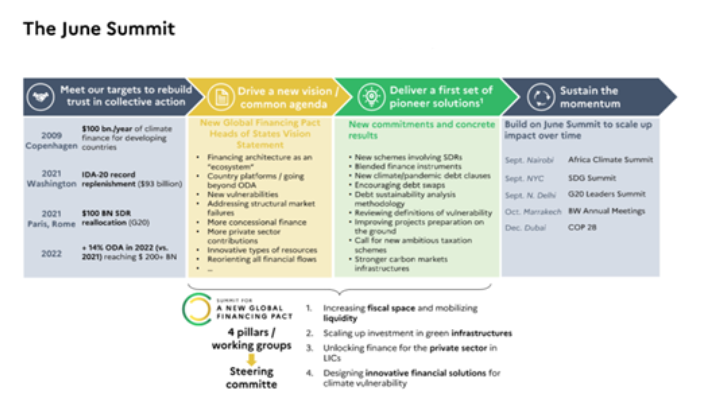
- African leaders amplified this dynamic by adopting the Nairobi Declaration during the first Africa Climate Summit in Kenya.
- The G20 summit in New Delhi, pushed this agenda forward with the New Delhi Declaration.
What are the principles that must guide the actions to fulfil the Paris agenda?
- No country should have to choose between fighting poverty and fighting to protect and preserve the planet.
- Facing different needs, countries may need to pursue diverse transition paths while coming together to meet the goals of the 2015 Paris climate agreement.
- This is why the Just Energy Transition Partnerships and Country Packages for Forest, Climate and Nature is being accelerated.
- More financial resources are needed to support vulnerable economies, lifting their populations out of poverty while protecting the planet.
- Meeting today’s global challenges will depend on scaling up the use of private capital flows to emerging and developing economies.
- The target of $100 billion worth of special drawing rights or equivalent contributions has already been achieved, to be channelled to the world’s most vulnerable countries, especially in Africa.
- Each dollar of lending by multilateral development banks (MDBs) should be complemented by at least one dollar of private finance.
- An overall increase of $200 billion in MDBs’ lending capacity over the next ten years is possible by optimising their balance sheets and enabling them to take more risks.
- There is a need for more efficiency in using this capital.
What is the way forward to achieve the Paris agenda?
- Improving the timeliness and predictability of the debt restructuring coordination mechanism for low-income countries (the G20’s Common Framework for Debt Treatments) and extending it to lower-middle-income countries.
- Accelerating debt suspension when needed, including to increase fiscal space for countries that are in debt distress.
- The Common Framework has already been delivered for Chad and Zambia and it can and must be used on a larger scale.
- Countries must support each other when one is hit by a disaster.
- That calls for specific tools to strengthen their resilience, including a climate-crisis clause in debt contracts.
- All financial institutions and actors will need to work together to fulfil it.
- Part of this cooperative effort must involve coordinating the MDBs and public development banks in the ‘Finance in Common’ global network of development banks.
- Cooperation on the energy transition can be achieved through the Climate Club, which the G7 established in order to fulfil the Paris climate agreement.
- New avenues for international taxation will also need to be found in order to meet our climate commitments.
- Governments will need to clamp down on financial flows that escape legitimate tax systems.
- Developing countries will need fair partnerships that enable them to generate added value by processing raw materials and critical minerals locally, and that reinforce the commitment to strengthen health-care and food infrastructure.
- An ambitious financial replenishment of the International Development Association, a deepening of the IMF’s Poverty Reduction and Growth Facility, and increased funding for the World Bank and IMF’s other concessional facilities could also play a big part in helping the world’s poorest countries.
- Including climate vulnerability in the World Bank and IMF’s mission will enable more investment in projects that assist poor countries in combating climate change.
Banning Glue pads for rodent control
In News: Recently, Delhi has joined several Indian states in banning glue pads for rodent control.
About
- Glue pads are widely criticized as a cruel method of rodent control because they subject trapped animals to prolonged suffering, as they slowly die from starvation and extreme pain while stuck in the strong adhesive.
- Rat poison, often used as an alternative to glue pads, is similarly considered inhumane. It poses risks not only to the targeted rodents but also to the wider ecosystem. Animals that consume poisoned rats, such as cats, snakes, mongooses, and predatory birds, can be harmed by the toxins, leading to unintended consequences and harm to non-target species.
- The Animal Welfare Board of India (AWBI) took a stand against the use of glue pads for rodent control by releasing advisory notices in both 2011 and 2021, effectively banning their use.
Climate change causing deluge across the world
In News: Recently, more than 11,000 people were killed and 30,000 were displaced in Libya after torrential rains caused once-in-a-century floods that burst dams and swept away buildings.
Floods due to the Mediterranean storm Daniel:
- More than 11,000 people were killed and 30,000 were displaced in Libya.
- Severe rainfall inundated parts of central Greece, north-western Turkey, southern Brazil, central and coastal Spain, southern China, Hong Kong and the southwestern US.
- While a Mediterranean storm called Daniel led to floods in Libya, Greece and Turkey, a cyclone wreaked havoc in Brazil and another storm known as Typhoon Haikui caused flooding in Hong Kong and China.
- These extreme weather events took place against the backdrop of soaring global temperatures.
Relation between flood and climate change:
- Although it is unclear if climate change is directly causing floods, experts say that it is undoubtedly making many of the elements that do so.
- Heavier Precipitation: Since more water vapour is evaporated from land, the oceans, and other bodies of water at higher temperatures, a warmer atmosphere may contain more moisture. The atmosphere can store around 7% extra moisture, according to experts, for every 1-degree Celsius increase in average temperature. As a result, precipitation becomes more intense, persistent, and/or frequent during storms, increasing the risk of catastrophic floods.
- Amplification of Drought: The earth has gotten both drier and wetter as a result of rising average temperature. Droughts can be made worse by warmer air sucking moisture from the soil. On the other hand, warm air can store more moisture, which allows it to carry more water into a wet area.
- Rising Sea Levels: The melting of glaciers and ice sheets brought on by higher global temperatures has raised sea levels, increasing the danger of flooding in coastal areas. According to a 2022 report by NOAA Climate, the global mean sea level has risen about 21–24 centimetres since 1880.

Hard to attribute floods to climate change:
- Particularly for the most devastating floods, which occur less frequently, there are few historical records.
- There are too many variables involved to point out one to be held responsible for flooding in a location (such as regional weather patterns, soil characteristics, and geography of the affected area).
- In the same way, researchers are still trying to determine how climate change and tornadoes are related. However, not all severe weather events are like this.
- There is enough evidence to show that global warming has increased the number of hot days.
Other factors that affect flooding:
- Local conditions like topography and how wet the soil is contributing to the flood development. E.g., drier soils are more capable of absorbing most of the rainfall in comparison to wetter soils — however, both really dry and really wet soils can’t absorb much water.
- Weather patterns: In the 2022 Australian floods much of the eastern coast of the country was inundated due to persistent heavy rainfall.
- Deforestation: A 2007 study done by researchers from Australia’s Charles Darwin University and the National University of Singapore found that with every 10% increase in trees being cut down, the flood risk increases by up to 28%.
- Inadequate maintenance of infrastructure: In Libya’s port city of Derna, the severity of floods was so huge because heavy rainfall caused two of the city’s dams to burst — they collapsed under the pressure of water gathered behind them during the storm.
- Human encroachment into floodplains: In July, Delhi witnessed its worst floods in history. The Yamuna River rose to 208.66 meters, submerging the Ring Road and leaving Kashmere Gate, Civil Lines, ITO, and Rajghat waterlogged. The main reason behind the deluge was excessive encroachment.
2nd Berlin Forum on Chemicals and Sustainability
In News: Recently, the environment minister participated in ‘High-Level Dialogue on Human Health and Environment convened under the 2nd Berlin Forum on Chemicals and Sustainability
About
- The 2nd Berlin Forum on Chemicals and Sustainability is a prestigious event focused on offering strategic direction and impetus for addressing critical global concerns related to the responsible handling of chemicals and waste.
- Hosted by the German Federal Ministry for the Environment, Nature Conservation, Nuclear Safety, and Consumer Protection (BMU).
- This forum seeks to galvanize political support and enhance the level of ambition for the ' Strategic Approach to International Chemicals Management (SAICM) Beyond 2020 agenda during the forthcoming 5th meeting of the International Conference on Chemicals Management (ICCM5).
- The inaugural Berlin Forum on Chemicals and Sustainability underscored the imperative of establishing a science-policy interface (SPI) for the management of chemicals and waste.
United Nations Global Stocktake Report
In News: Recently, United Nations released Global Stocktake report.
About
The Global Stocktake report from the United Nations serves as a guiding framework for deliberations during the Conference of Parties (COP), with its primary objective being the evaluation of countries' advancements in reducing greenhouse gas emissions since 2015.
Positive Findings:
- Impact of the Paris Agreement: The report underscores that the Paris Agreement has played a pivotal role in inspiring widespread climate action across the globe.
- Improved Temperature Projections: Notably, the report presents an improved outlook for global temperature rise, estimating it to be in the range of 2.4-2.6°C. This represents a significant improvement from the earlier, more alarming projection of 3.7-4.8°C in 2010.
Negative Findings:
- Excessive Emissions: Despite some progress, the report raises concerns about global emissions exceeding the limits established in the Paris Agreement. This underscores the urgency of further action.
- Ambitious Emission Reductions Needed: The report emphasizes the need for ambitious actions to achieve net-zero CO2 emissions. Specifically, an 84% reduction in global greenhouse gas emissions below 2019 levels by 2050 is deemed necessary.
- Deficits in Climate Action: The report identifies shortfalls in various aspects of climate action, including mitigation (reducing emissions), adaptation (adjusting to climate impacts), and finance. These deficits highlight the necessity for more comprehensive and robust efforts in addressing climate change.
Recommendations from the Report:
1. Mitigation: The report advocates for an inclusive and equitable transformation of energy systems, moving away from fossil fuels towards renewable energy sources such as solar and wind. This transition is seen as vital for mitigating greenhouse gas emissions.
2. Adaptation: To enhance resilience to climate change, the report suggests integrating climate change risks into all aspects of planning and implementation. It also emphasizes the importance of transparent reporting on adaptation efforts to track progress effectively.
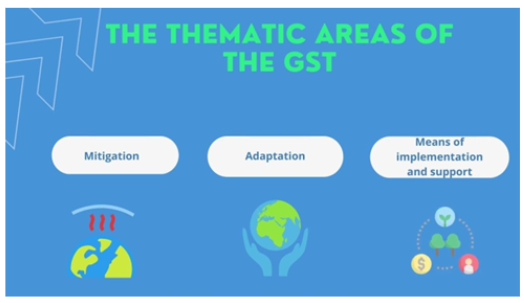
3. Climate Finance: Recognizing the financial challenges faced by developing countries, the report recommends improving access to climate finance. Ensuring that developing nations have adequate resources to combat climate change is essential for achieving global climate goals.
Stocktaking the calamity: The Hindu Editorial on climate crisis and the U.N. Global Stocktake report
Fujianvenator - Edukemy Current Affairs
In News: Recently, Scientists in China have uncovered fossils of a peculiar, bird-like dinosaur named Fujianvenator prodigiosus, which lived around 148 to 150 million years ago in southeast China.
About:
- The dinosaur had elongated legs and arms built much like wings, suggesting it either was a fast runner or lived a lifestyle like a modern wading bird.
- Fujianvenator is a member of a grouping called avialans.
- This group includes all birds and their closest non-avian dinosaur.
Features:
- Its forelimb is generally built like a bird's wing, but with three claws on the fingers, which are absent from modern birds.
- Its lower leg bone – the tibia – was twice as long as its thigh bone – the femur.
- It also had a long bony tail.
- It cannot be determined whether it could fly or not.
- Fujianvenator’s discovery contributes to our understanding of the evolutionary history of birds, which evolved from two-legged, feathered dinosaurs known as theropods during the late Jurassic period.
White sambar deer - Edukemy Current Affairs
In News: Recently, A rare white sambar deer (leucistic sambar deer) was spotted in a camera trap at Cauvery Wildlife Sanctuary limits, in Chamarajanagar district.
About:
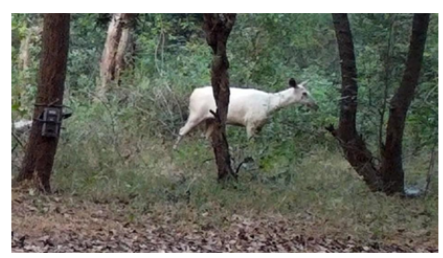
- This is the first time a leucistic sambar deer has been spotted in this forest area. A White Sambar Deer was previously recorded in Bandipur Tiger Reserve in 2014.
- Leucism is a genetic condition that affects the pigmentation of an animal’s skin, feathers, scales, or fur.
- Unlike albinism, which causes a complete absence of pigment, leucism results in a partial loss of pigment, leading to white or pale colouration in affected areas.
Sambar deer:
- The Sambar (Rusa unicolour) is a large deer native to the Indian subcontinent and Southeast Asia.
- They are quite elusive and are most active at dusk and at night.
- They are found in a broad range of forest habitats like dry deciduous forests, rainforests and mixed forests.
- Distribution: Their range is distributed from the foothills of the Himalayan Mountains across southern Asia and reaching the islands of Taiwan, Sumatra and Borneo.
- Conservation status
- IUCN: Vulnerable
- The Wildlife (Protection) Act, 1972: Schedule-III
|
Cauvery Wildlife Sanctuary: |
|
Management of e-waste in India
In News: Recently, the Indian Cellular and Electronics Association (ICEA) released a report on ‘Pathways to Circular Economy in Indian Electronics Sector’ in collaboration with NITI Aayog, aiming to explore opportunities for managing electronic waste (e-waste) more effectively.
Key Highlights of the ICEA Report:
- According to the report, e-waste management in India is predominantly informal, with approximately 90% of e-waste collection and 70% of recycling being managed by a competitive informal sector.
- The report emphasizes the need to shift the outlook on e-waste management towards establishing a circular economy. For example, China targets 5% of secondary raw material in new products by 2019 and aims for 35% by 2030.
- The report suggested the following initiatives:
- Establish public-private partnerships for a reverse supply chain
- Create an auditable database of collected materials
- Develop geographical clusters for processing devices
- Incentivize high-yield recycling centres
- Support the right to repair by users
E-wastes in India:
- E-waste refers to all items of electronic and electrical equipment (EEE) and its parts that have been discarded by their owner as waste without the intent of re-use.
- According to the Global E-waste Monitor 2020, India is the third-largest e-waste generator in the world after China and the USA.
- The volume of e-waste in India has witnessed a significant surge to 1.6 million tonnes in 2021-22.
E-waste Management in India:
- At present the management of e-waste is addressed within the framework of the E-Waste (Management) Rules 2022. The key provisions are mentioned below:
- It has increased the range of electronic goods covered e.g., laptops, mobile, cameras etc.
- It has restricted the use of hazardous substances (such as lead, mercury, and cadmium) in manufacturing electrical and electronic equipment that have an adverse impact on human health and the environment.
- Producers of electronic goods have to ensure at least 60% of their electronic waste is collected and recycled by 2023 with targets to increase them to 70% and 80% in 2024 and 2025, respectively.
- ‘Environmental compensation’ to be provided by the companies that don’t meet their target.
- Extended Producer Responsibility Certificates (similar to carbon credit mechanism) will allow the offsetting of e-waste responsibility to a third party.
- The Central Pollution Control Board shall conduct random sampling of electrical and electronic equipment placed on the market to monitor and verify the compliance of reduction of hazardous substances provisions.
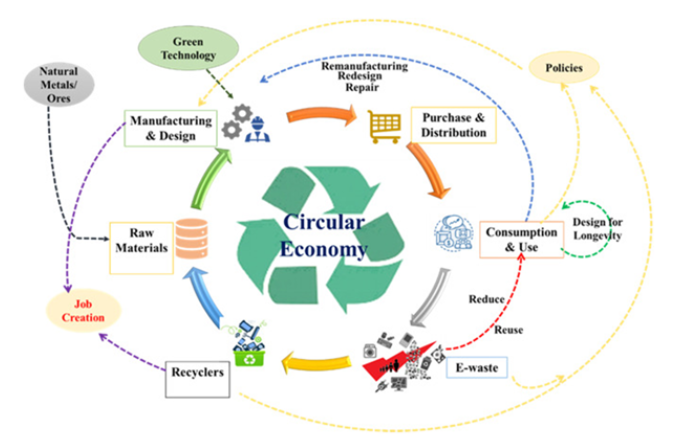
Current Initiatives:
- The Bhopal e-waste clinic is a pilot project in this field. It enables door-to-door collection or direct deposit at the clinic, offering a fee-based exchange.
- ‘Karo Sambhav’, a Delhi-based initiative has integrated informal aggregators in its collection mechanism.
Siang River - Edukemy Current Affairs
In News: Recently, The Centre has proposed to construct a large barrage on the Siang River to protect it from potential hazards posed by the massive Chinese dam being built on river Tsangpo in Tibet.
About:
- The Tsangpo flows through Tibet before entering Arunachal Pradesh as the Dihang or Siang. It becomes the Brahmaputra in Assam and the Jamuna in Bangladesh before it empties into the Bay of Bengal.
- It originates at Angsi Glacier in western Tibet, southeast of Mount Kailash and Lake Manasarovar.
- It is the longest river in Tibet and the fifth longest in China.
- The river forms the world’s largest and deepest canyon, YarlungTsangpo Grand Canyon.
- The YarlungTsangpo River is the highest major river in the world.
- Its longest tributary is the Nyang River.

In India, its main tributaries are:
- Main tributaries on the North are: namely Subansiri, Ronganadi, Dikrong, Buroi, Borgong, Jiabharali, Dhansiri (North) Puthimari, Manas, Beki, Aie, Sonkoshare.
- Main tributaries on the south are: Noadehing, Buridehing, Desang, Dikhow, Bhogdoi, Dhansiri (South), Kopilli, Kulsi, Krishnai, Dhdhnoi, Jinjiran.
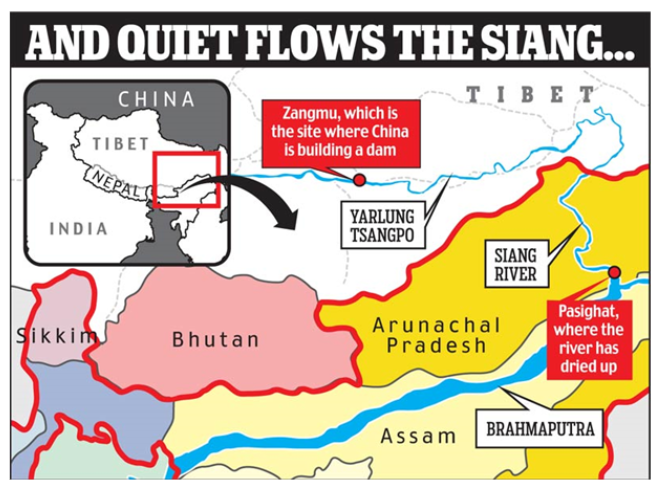
More Information:
- The Chinese government is planning to build a dam over the Siang River with a capacity of around 60,000 MW on the Tibet side.
- It is expected to produce triple the electricity produced by the Three Gorges – the world’s largest power station.
‘Atlantification’ of the Arctic Ocean
In News: Recently, Researchers have discovered the cause of the Arctic Ocean Sea ice decrease since 2007.
About:
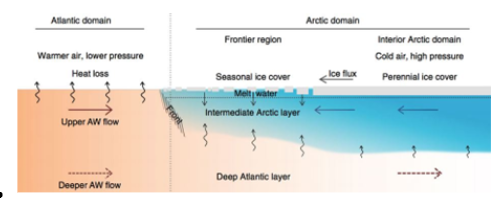
- The study, published in the journal Science, explores the ecosystem responses to the Arctic dipole and its impact on the Arctic Ocean climate, a phenomenon referred to as Atlantification.
- Atlantification is the increasing influence of Atlantic water in the Arctic. Warmer and saltier Atlantic water is extending its reach northward into the Arctic Ocean.
Key highlights of the Study
- Researchers found that the periodic reversal of an atmospheric phenomenon known as the Arctic dipole plays a significant role in driving drops in sea ice.
- The Arctic dipole follows a roughly 15-year cycle, and data spanning several decades suggest that it is approaching the end of its current regime.
- In the Arctic dipole’s present “positive” regime, which has been in place since 2007, high pressure is centered over the Canadian sector of the Arctic and produces clockwise winds.
- Low pressure is centered over the Siberian Arctic and features counterclockwise winds. This wind pattern drives upper ocean currents, with year-round effects on:
- regional air temperatures,
- atmosphere-ice-ocean heat exchanges,
- sea-ice drift and exports, and
- ecological consequences.
- The study highlights the importance of water exchanges between the Nordic seas and the Arctic Ocean for the Arctic climate system, with sea ice decline serving as a significant indicator of climate change.
- Researchers observed changes in Atlantic water flow into the Arctic Ocean, including decreased flow through the Fram Strait and increased flow into the Barents Sea, which they referred to as a “switchgear mechanism” driven by the Arctic dipole.
- This change in water flow has had a significant impact on sea ice loss, slowing it down from 2007 to 2021.
- The study also notes that these changes in water inflow have profound effects on marine life, creating more favourable conditions for sub-Arctic boreal species in certain areas.
|
Arctic Dipole |
|
India's Falling Cotton Production
In News: While Bt-Cotton gave a huge impetus to production during the first decade-and-a-half of this century, the yield gains from it have been somewhat eroded by the emergence of new dominant pests, especially Pink Bollworm (PBW).
Significance of Cotton in India:
- Cotton, like coconut, is a source of all the three Fs: Food, Feed and Fibre.
- It constitutes only about 36% of kapas (raw cotton), the rest is seed (62%) and wastes (2%) separated from the lint during ginning.
- Cotton seed contains 13% oil used for cooking and frying. The 85% residual cake, after extraction of oil from the seed and 2% processing losses, is a protein-rich feed ingredient for livestock and poultry.
- Cotton has a roughly two-thirds share in India’s total textile fibre consumption.
- The cottonseed is the country’s third largest domestically-produced vegetable oil (after mustard and soya bean) and its second biggest feed cake/meal (after soya bean).
Bt – Cotton Production:
- From 2002, Indian farmers began planting genetically-modified (GM) cotton hybrids incorporating genes isolated from a soil bacterium Bacillus thuringiensis or Bt.
- The Bt genes coded for proteins toxic to the deadly Helicoverpa armigera or American bollworm insect pest.
- As the share of Bt hybrids in the country’s area sown under cotton touched 95%, average per-hectare lint yields more than doubled from 278 kg in 2000-01 to 566 kg in 2013-14.
- However, the gains didn’t last. The production and yields falling after 2013-14, to 343.5 lakh bales and 447 kg/hectare in 2022-23.
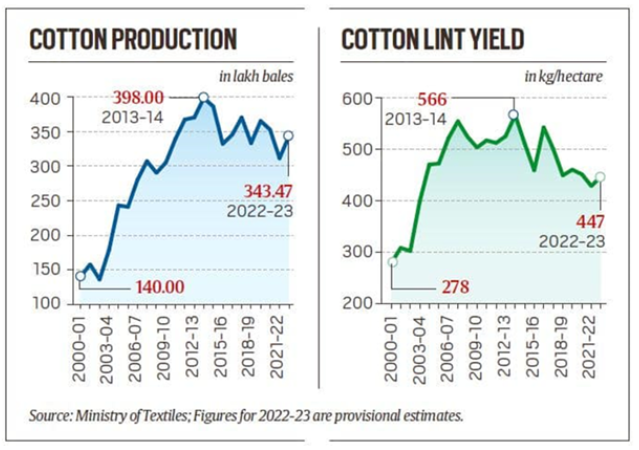
Reasons for fall in Production and yield:
- The Bt toxins were originally supposed to provide protection against both the Helicoverpa and PBW caterpillars that burrow into the bolls or fruits of the cotton plant in which the lint and seeds grow.
- Helicoverpa that is polyphagous, with alternative hosts from arhar (pigeon pea), jowar (sorghum) and maize to tomato, chana (chickpea) and lobiya (cowpea).
- Pectinophora gossypiella or Pink Bollworm (PBW) is a monophagous pest that feeds mainly on cotton.
- Being monophagous enabled the PBW larvae to develop resistance to Bt proteins over time.
- The PBW population that became resistant from continuously feeding on Bt hybrids, therefore, gradually overtook and replaced the ones that were susceptible.
- Bt cotton has retained its effectiveness against the American bollworm.
- But in 2014, an unusually large survival of PBW larvae was detected on cotton flowers at 60-70 days after sowing in Gujarat.
- In the 2015 season thereafter every 25-30 days – PBW survivals were reported from Andhra Pradesh, Telangana and Maharashtra too.
- In 2021, even Punjab, Haryana and northern Rajasthan saw heavy infestation of the pest for the first time.
Controlling the Pest:
- The conventional route of spraying insecticides has had limited efficacy against the PBW larvae. These feed on the cotton bolls as well as the squares (buds) and tender flowers, affecting lint quality and yields.
- Mating Disruption:
- It involves deploying Gossyplure, a pheromone signaling chemical that is secreted by female PBW moths to attract male adults.
- The pheromone is artificially synthesised and filled into pipes or lures. The male adult moths are, then, attracted towards the lures and do not mate with females during their 7-10 days’ time.
- In the event, eggs aren’t laid and they don’t grow into larvae (which feed on the cotton plant parts).
- The Central Insecticides Board & Registration Committee under the Agriculture Ministry has approved two mating disruption products – PBKnot and SPLAT for controlling PBW.
- PBKnot:
- PBKnot is a dispenser having a 20-cm hollow polyethylene pipe, into which 140-160 mg of Gossyplure is impregnated.
- Each such “rope” that is tied to a cotton plant can release the pheromone over a 25 square-metre area. It translates into roughly 165 PBKnot-tagged plants every acre.
- South Asia Biotechnology Centre (SABC) has been conducting field experiments of PBKnot technology – sourced by the Gurugram-based PI Industries Ltd from Japan’s Shin-Etsu Chemical Company – during the last three seasons from 2021.
- SPLAT:
- SPLAT-PBW, a flowable emulsion formulation technology for delivering Gossyplure, has been developed by ISCA Technologies in Riverside (California) and introduced in India by ATGC Biotech Pvt. Ltd, Hyderabad.
Amended Forest (Conservation) Act imperils the Northeast
In News: Recently, the Mizoram Assembly has passed a resolution opposing the Forest (Conservation) Amendment Act (FCA), 2023, highlighting the ongoing challenges in forest conservation and tribal rights in Northeast India.
Key Provisions of the Forest (Conservation) Amendment Act (FCA), 2023:
- It amends the Forest (Conservation) Act, 1980.
- It allows for the diversion of forest land for various projects, including roads, railways, and strategic national security projects, within 100 km of India’s international borders.
- It expanded to include check posts, fencing, bridges, zoos and safaris under the Wild Life (Protection) Act, 1972; eco-tourism facilities; and silvicultural operations (enhancing forest growth), etc.
Provisions for the Protection of forests in North-Eastern India:
- Article 371A and 371G:
- Special Constitutional protections in Article 371A (Nagaland) and 371G (Mizoram) prohibit the application of laws that impinge on tribal customary law, land ownership, and transfer without the State Legislative Assemblies' resolutions.
- Mizoram, unlike Nagaland, falls under the purview of FCA due to its status as a State. The amendment affects 84.53% of its forest areas.
- Special Constitutional protections in Article 371A (Nagaland) and 371G (Mizoram) prohibit the application of laws that impinge on tribal customary law, land ownership, and transfer without the State Legislative Assemblies' resolutions.
- Scheduled Tribes and Other Traditional Forest Dwellers (Recognition of Forest Rights) Act (FRA) 2006:
- Forest Land includes unclassified forests, un-demarcated forests, existing or deemed forests, protected forests, reserved forests, Sanctuaries, and National Parks.
- This complied with the 1996 Supreme Court redefinition.
- Forest Rights Act (FRA) 2006:
- It recognizes traditional forest rights in various forest types, including unclassed forests, providing an additional layer of protection for tribal communities.
- The potential benefits, most North-eastern states, except Assam and Tripura, have not implemented FRA, citing reasons such as land ownership patterns and lack of forest-dependent communities.
Concerns raised by the North-Eastern States:
- FCA allows for forest land diversion for projects located within 100 km of India's international borders without requiring forest clearance. Most of Northeast India falls within the 100 km range, raising concerns about the environmental impact and infringement on tribal rights.
- Areas not officially classified as forests in government records, even if they are standing forests, won’t be protected from commercial exploitation or diversion. A substantial portion of North-eastern forests is privately owned, including unclassed forests, which may not be covered by the Act unless included in government records.
- More than 50% of the Recorded Forest Areas (RFA) in the North East falls under “unclassed forests” – forests which are not notified under any law. 97.3% of RFA in Nagaland, 88.2% in Meghalaya, 76% in Manipur, 53% in Arunachal Pradesh, 43% in Tripura, 33% in Assam, and 15.5% of Mizoram fall under unclassed forests category.
- Mizoram and Tripura have passed resolutions opposing the amendment, expressing their commitment to protecting the rights and interests of their people.
- Nagaland faces demands to follow suit, and Sikkim has also opposed the 100 km exemption clause.
Forest Restoration
In News: For more than 200 years India has experimented with tree plantations, offering important lessons about the consequences different approaches to restoring forests.
Deforestation:
- It is a process of removing or clearing a large forest area or trees mainly due to human activities such as logging, agriculture, urban development, or infrastructure expansion.
Major Factors of Deforestation:
- Economic Factors: Logging, mining, and agriculture due to economic incentives.
- Infrastructures: Highways and other facilitated access to remote areas, leading to deforestation.
- Demand of a particular crop or agricultural product such as palm oil, rubber, etc.
- Climate change: Due to climate change, that phenomenon like dieback of forests is peaking up.
- Government laws: In order to give preference to the industries and manufacturing, now governments are loosening the forest laws and restrictions.
Forest Restoration:
- It is the planned process of restoring and regenerating forests that have been degraded, damaged, or lost due to various human activities or natural causes.
- It involves tree planting, habitat restoration, and sustainable management practices to improve biodiversity, ecosystem services, and overall forest health.
- India aims to restore 21 million hectares of forest and create a carbon sink of 2.5-3 billion tonnes by 2030 through the Bonn Challenge.
- India’s national forest policy targets 33% tree coverage.
Status of Forest Restoration:
- In 2018, a report by the government and the IUCN indicated 10 million hectares were under restoration.
- The current global focus on tree planting has often led to the rapid establishment of fast-growing tree plantations of single species like eucalyptus or bamboo to quickly increase tree cover.
- This approach can yield quick results but also poses risks, including invasive species and land dispossession.
- The Forest Rights Act of 2006 empowered village assemblies (Gram Sabhas) in central India’s Gadchiroli district to restore degraded forests, sustainably utilizing tendu leaves for bidi (Indian tobacco).
- In western India’s Kachchh grasslands, communities successfully restored the ecosystem by removing the invasive “gando bawal” tree, introduced by British foresters in the late 19th century.
- The introduction of non-native species like wattle, pine, and acacia disrupted ecosystems, leading to resource loss and community hardships.
Way Forward:
- Prioritize planting diverse native tree species in reforestation efforts. Natural forests with varied species are more effective at carbon sequestration than monoculture plantations.
- Encourage sustainable forest crops through agroforestry, which enhances food security, empowers women, and boosts household income, reducing rural-to-urban migration.
Missing green growth
In News: A new study shows that It could take 11 high-income countries over 200 years to reduce their 2022 greenhouse gas emissions by 95 per cent.
Key Highlights about the Study:
- The 11 high-income countries include Australia, Austria, Belgium, Canada, Denmark, France, Germany, Luxembourg, the Netherlands, Sweden, and the United Kingdom.
- If current trends continue, these countries would emit 27 times their fair share of the 1.5 degrees Celsius carbon budget.
- Fair share in carbon budgets are the amount of carbon dioxide (CO2) that can still be emitted for a 50 per cent chance of warming staying below 1.5°C.
- The “green growth” is unattainable for these high-income countries, and their pursuit of economic growth contradicts the climate and equity goals of the Paris Agreement.
- The green growth can only occur if reduction in CO2 emissions per unit of gross domestic product (GDP) is fast enough to reduce emissions consistent with the Paris Agreement.
- The study emphasizes that there is nothing environmentally friendly about the economic growth in these countries, and the term “green growth” is misleading, akin to greenwashing.
- These 11 countries are likely to take between 73 years and 369 years (223 years, on average) to reduce their respective 2022 emissions by 95 per cent.
- They would use up to five times and 162 times (on average, 27 times) of their respective remaining post-2022 fair shares of the 1·5°C global carbon budget.
- These developed countries achieved emission reductions of an average of 1.6 per cent per year between 2013 and 2019, against a required reduction rate of 30 per cent per year by 2025 to not overshoot their fair share of the 1.5°C global carbon budget.
Measures suggested by the researchers:
- These rich countries should follow a “post-growth” approach to meet their climate targets and fairness principles of the Paris Agreement.
- These countries should focus on equitable reductions in carbon-intensive production and consumption while enhancing livelihoods and well-being through policies like public job guarantees, reduced work hours, living wages, minimum income guarantees, and universal access to affordable housing and quality public services.
Ecocide - Edukemy Current Affairs
In News: Recently, Mexico’s ‘Maya train’ project has been criticised as a “megaproject of death” causing an ecological disaster in the region.
About:
- Ecocide is defined as “extensive loss, damage or destruction of ecosystems such that the peaceful enjoyment by the inhabitants has been or will be severely diminished.” Here, “inhabitants” applies to all living creatures.
- Ecocide, derived from Greek and Latin, translates to “killing one’s home” or “environment”.
- Such ‘killing’ could include port expansion projects that
- destroy fragile marine life and local livelihoods;
- deforestation;
- illegal sandmining; and
- polluting rivers with untreated sewage.
- Mexico is pushing to elevate ecocide to the ranks of an international crime, warranting similar legal scrutiny as genocide.
- There is no accepted legal definition of ecocide, but a panel of lawyers in June 2021 for the Stop Ecocide Foundation prepared a 165-word articulation.
- The biologist Arthur Galston in 1970 is credited with first linking environmental destruction with genocide, which is recognised as an international crime.
- In 2010, British lawyer Polly Higgins urged the United Nations’ International Criminal Court (ICC) to recognise ecocide as an international crime.
- At present Rome Statute of the ICC deals with 4 atrocities.
- genocide
- crimes against humanity
- war crimes
- the crime of aggression.
- The provision on war crimes is the only statute that can hold a perpetrator responsible for environmental damage, but only if it is intentional and in wartime.
More Information:
- Ecocide is a crime in 11 countries, with 27 others considering laws to criminalise environmental damage that is wilfully caused and harms humans, animals, and plants.
PM-DAKSH - Edukemy Current Affairs
In News: Recently, The Pradhan Mantri Dakshata Aur Kushalata Sampanna Hitgrahi (PM-DAKSH) Yojana, was in News.
About:
- The Pradhan Mantri Dakshata Aur Kushalata Sampanna Hitgrahi (PM-DAKSH) Yojana, a Central Sector Scheme, was launched during 2020-21.
- The main objective of the Scheme is to enhance competency level of the target groups to make them employable both in self- employment and wage-employment for their socio-economic development.
The scheme primarily focuses on the following target groups:
-
- Scheduled Castes (SCs)
- Other Backward Classes (OBCs)
- Economically Backward Classes (EBCs)
- Denotified Tribes (DNTs)
- Safai Karamcharis, including waste pickers
- Eligibility criteria
- Age Criteria: Between 18 to 45 years.
- Income Criteria:
- No income limit for SCs, Safai Karamcharis (including waste pickers), and DNTs.
- Annual family income below Rs. 3 lakh for OBCs.
- Annual family income below Rs. 1 lakh for EBCs.
- The scheme offers various types of training programs with different durations and costs per candidate:
- Up-skilling/Reskilling
- Short Term Training
- Entrepreneurship Development Programme
- Long Term Training
- The cost of training is as per common norms issued by Ministry of Skill Development & Entrepreneurship; Government of India and it varies as per duration of the course.
Sand Mining: Irreversible damage to Ocean benthic life
In News: According to Marine Sand Watch (a new global data platform), approximately six billion tonnes of sand are extracted annually from the world’s oceans, causing irreversible damage to benthic life.
Benthic Life:
- The term "benthic life" describes organisms that dwell on or very close to the ocean floor as well as in lakes, rivers, and other bodies of water.
- Such organisms, which have evolved to live on river or ocean bottoms, are essential to the ecology because they break down organic matter and feed other aquatic species.
Impact of Sand Extraction on Benthic Life:
- It disturbs the seabed, destroying the habitat and shelter of benthic organisms such as worms, crustaceans, and small fish.
- Dredging activities stir up sediment, increasing water turbidity. This reduces light penetration, affecting photosynthetic organisms and altering the benthic environment.
- Changes in sediment composition and nutrient availability can disrupt the food web and nutrient cycling, affecting benthic communities’ survival and reproduction.
- The machinery and vessels used in sand extraction generate underwater noise, which can disturb and stress benthic organisms, impacting their behaviour and health.
- Benthic organisms may need to migrate or are forcibly displaced due to sand extraction, disrupting their natural life cycles and behaviours.
- Coastal or near-shore extraction can also affect the salinization of aquifers and future tourist development.
Measures taken by the Countries:
- Some countries including Indonesia, Thailand, Malaysia, Vietnam, and Cambodia have banned marine sand export in the last 20 years, while others lack any legislation and /or effective monitoring programmes.
10 Recommendations by UNEP to monitor sand extraction:
- Recognise sand as a strategic resource.
- Include place-based perspectives for just sand transitions.
- Enable a paradigm shift to a regenerative and circular future.
- Integrate policy & legal frameworks strategically.
- Establish ownership and access to sand resources through mineral rights and consenting.
- Map, monitor and report sand resources.
- Establish best practices, national standards, and a coherent international framework.
- Promote resource efficiency & circularity.
- Source responsibly.
- Restore ecosystems and compensate remaining losses.
Wastewater – Turning Problem into Solution
In News: Recently, the Global Wastewater Initiative (GWWI) released a report to tackle wastewater pollution titled “Wastewater – Turning Problem to Solution”. It aims to address the urgent need for sustainable water and wastewater management.
Key Highlights of the Report:
- Wastewater reuse could supply more than ten times the current global desalination. To unlock this potential, public perceptions and concerns about wastewater resource recovery and reuse must change.
- Elevating wastewater reuse in international policy is crucial to addressing climate, nature, and pollution crises.
- Wastewater could serve as an alternative energy source for up to half a billion people, reduce global fertilizer use by over 10%, and irrigate around 40 million hectares of land.
- Wastewater can be a source of raw materials for various industries, including paper, polymers, pesticides, rubber, paint, biodiesel, food additives, and more, contributing to economic and environmental sustainability.
Wastewater and its Challenges:
- Wastewater refers to water that has been used and contaminated through various human activities, such as domestic, industrial, or agricultural processes.
- Globally, the Improper management of wastewater is a challenge. This has been exacerbated by population growth, urbanization, and climate change.
- The domestic and municipal wastewater is projected to increase by 24–38% by 2030.
- Only 11% of domestic and industrial wastewater is currently being reused, indicating untapped potential.
- With 50% of untreated wastewater entering the environment, this problem is still quite serious.
- Poor wastewater management disproportionately affects vulnerable groups, particularly women and children.
Suggested Solutions in the Report:
- The Report suggested three Key Action Areas:
- Reduce the volume of wastewater produced
- Prevent and reduce contamination in wastewater flows
- Sustainably managing wastewater for resource recovery and reuse
- Building blocks required for these action areas:
- Effective and coherent legislation and governance
- Mobilize adequate and sustained investment
- Enhancing human, technical and institutional capacity at all levels (local to global)
- Technical and social innovation
- Stronger data and information
- Increase communications, awareness and accountability
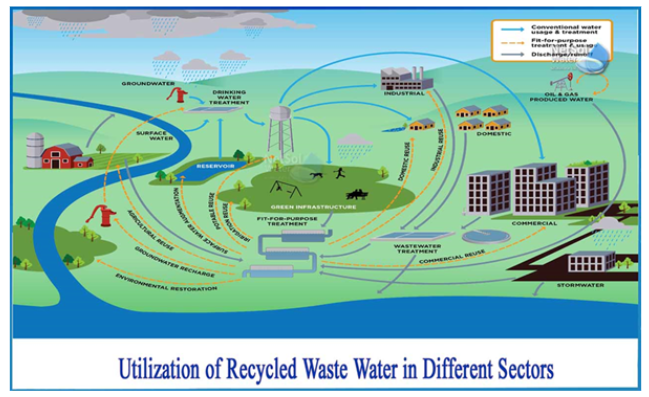
The impact of food on climate - Edukemy Current Affairs
In News: Agriculture and the food we consume have a significant impact on climate change.
About
The impact of food on climate is significant and multifaceted. Here are key aspects of this impact:
Greenhouse Gas Emissions:
- Agriculture contributed to approximately 11% of global greenhouse gas emissions in 2018.
- Methane emissions from livestock digestion account for about 10% of agricultural emissions. India, with its substantial livestock population, generates 8% of its total greenhouse gases from methane emissions.
- Emissions are also attributed to the use of synthetic fertilizers and rice cultivation.
- Land use change and deforestation for agricultural purposes release carbon dioxide (CO2) into the atmosphere.
Food Production:
- Energy-intensive processes in food production, including manufacturing and processing, contribute to CO2 emissions.
- The transportation of food over long distances results in the consumption of fossil fuels and associated emissions.
Food Waste:
- Decomposing food waste in landfills produces methane gas, which is a potent greenhouse gas.
- The resources used to produce food that ultimately goes to waste, such as water, energy, and land, also contribute to emissions.
Packaging:
- The production and disposal of food packaging materials generate CO2 emissions.
- Plastic packaging, in particular, contributes to plastic pollution and has adverse effects on ecosystems.
Food Choices:
- The choices individuals make regarding their diets have a direct impact on emissions. For example, the consumption of high-impact foods like red meat generates more emissions compared to plant-based diets.
- Food choices also influence land use and deforestation patterns, as certain types of agriculture require more land and can lead to habitat destruction.
Climate change has impacts on food systems
Climate change has profound impacts on food systems across the globe, affecting various aspects of crop production, food availability, food quality and safety, food security, distribution, waste, and ecosystems.
Crop Production:
- Climate change alters growing conditions, which can lead to changes in crop yields and quality.
- Increased temperatures can result in heat stress for crops.
- Shifts in precipitation patterns can lead to droughts or floods, harming crop growth.
- Altered pest and disease dynamics can affect the overall health of crops.
Food Availability:
- Climate change-induced alterations in growing conditions can affect the availability of food.
- Rising temperatures can lead to heat stress in crops, reducing their availability.
- Changes in precipitation patterns, such as prolonged droughts or intense floods, can impact food production.
- Altered pest and disease dynamics can reduce the quantity and quality of available food.
Food Quality and Safety:
- Changing climate conditions can influence the nutritional content of crops, potentially affecting the quality of food.
- Increased temperatures can lead to spoilage and food safety concerns.
- Variations in water availability can impact food processing and safety.
Food Security:
- Climate-induced crop failures can lead to food insecurity, particularly in regions heavily reliant on agriculture.
- Vulnerable populations, including low-income communities, are disproportionately affected by food shortages.
- Migration and conflict can result from food-related stressors exacerbated by climate change.
Food Distribution:
- Extreme weather events can disrupt transportation routes, impacting the distribution of food.
- Increased energy costs for transportation can lead to higher food prices.
- Changes in trade patterns may affect global food distribution.
Food Waste:
- Climate change can exacerbate food waste due to spoilage caused by temperature fluctuations.
- Resource-intensive food production contributes to food waste, as well as environmental degradation.
Ecosystem Disruption:
- Climate change alters ecosystems and biodiversity, affecting important elements such as pollinators and natural pest control.
- Loss of biodiversity can disrupt food production and the overall ecosystem, impacting food systems.
The UN Framework Convention on Climate Change (UNFCCC) has not sufficiently addressed the impact of food production on climate change. Efforts to curb emissions in this sector, like the Netherlands' attempt to reduce nitrous oxide emissions, have encountered resistance and protests. Similarly, New Zealand's proposal for a "burp" tax faced opposition. The influence of the meat industry on emissions remains a challenging issue, akin to the challenges posed by the fossil fuel sector.
Proposed Solutions:
- Importance of Adaptation: There is an urgent need to scale up support, including financial aid, capacity-building, and technology transfer, to enhance adaptive capacity and reduce vulnerability to climate change impacts.
- Crop Diversification: Promoting diversified cropping patterns, particularly focusing on millets, pulses, and horticulture, can contribute to more sustainable agriculture.
- Adaptation Finance: Multilateral banks, financial institutions, and the private sector should mobilize additional resources to support adaptation efforts in the agricultural sector.
- Multi-Pronged Approach: Addressing the climate-hunger crisis requires a multifaceted strategy. This includes creating resilient livelihoods, promoting climate-resilient food crops, empowering women in agriculture, supporting smallholder farmers, and increasing knowledge about vulnerability and food security.
- Sustainable Food Systems: Sustainability should be integrated into all aspects of food production, value chains, and consumption. Additionally, cash transfers for sustainable agriculture may prove more effective than traditional input subsidies.
- Non-Agriculture Sector: Reducing the pressure on agriculture, especially for smallholders and informal workers, can be achieved through labour-intensive manufacturing and services. Strengthening rural Micro, Small, and Medium Enterprises (MSMEs) and the food processing sector is a crucial part of this solution.
These solutions aim to address the complex interplay between food production and climate change while promoting sustainability, adaptation, and resilience in the agriculture sector.
Preserve Heritage: Conserve Biodiversity - UN
In News: According to the UNESCO and IUCN, protecting world heritage sites can help conserve biodiversity and meet the targets set by the Kunming-Montreal Global Biodiversity Framework (GBF).
World Heritage Sites (WHS):
- These are landmarks or areas of cultural, historical, scientific, or natural significance that are recognized and designated by the United Nations Educational, Scientific and Cultural Organization (UNESCO).
- These sites are considered to be of outstanding value to humanity, and their preservation is of global importance.
- There are two main types of World Heritage sites:
- Cultural Heritage Sites: These include historical buildings, cities, monuments, archaeological sites, and cultural landscapes that hold cultural and historical significance. E.g., Pyramids of Egypt, the Historic Centre of Rome, and the Great Wall of China, etc.
- Natural Heritage Sites: These encompass natural areas, ecosystems, and geological formations that are of exceptional natural beauty or scientific importance. E.g., the Galápagos Islands, the Great Barrier Reef in Australia, and Yellowstone National Park in the United States, etc.
Biodiversity in UNESCO WHS:
- The total of 1157 World Heritage sites take up only 1 per cent of the earth’s surface.
- UNESCO World Heritage sites (WHS) are home to 75,000 species of plants, and over 30,000 species of mammals, birds, fish, reptiles and amphibians — a fifth of all the species mapped globally.
- Today, up to 1/3rd of remaining elephants, tigers and pandas can be found in these sites, as well as at least one in 10 great apes, giraffes, lions and rhinos.
- They are home to all remaining Javan rhinos, vaquitas (the world’s smallest cetacean) and pink iguanas, as well as more than half of all Sumatran rhinos, Sumatran orangutans and mountain gorillas.
- Threats to these WHS:
- Agricultural expansion,
- Infrastructure development,
- Poaching,
- Overexploitation of resources and
- Proliferation of invasive species.
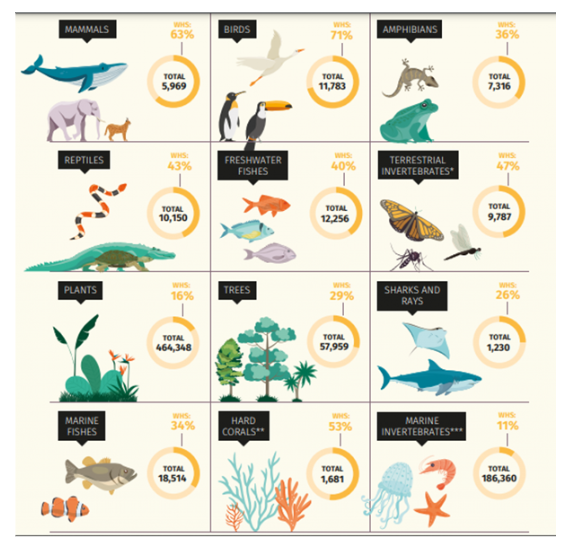
BS 6 Stage II ‘Electrified Flex Fuel Vehicle’
In News: Recently, Toyota Kirloskar Motor has launched the world’s first prototype of a BS 6 Stage II ‘Electrified Flex Fuel Vehicle’ in India.
Flex Fuel Vehicles (FFVs):
- It is designed to run on a flexible combination of fuels, typically gasoline and ethanol.
- These vehicles are equipped with engines that can adjust their fuel mixture based on the available fuel blend E.g., E20 (20% ethanol and 80% gasoline) or even higher percentages.
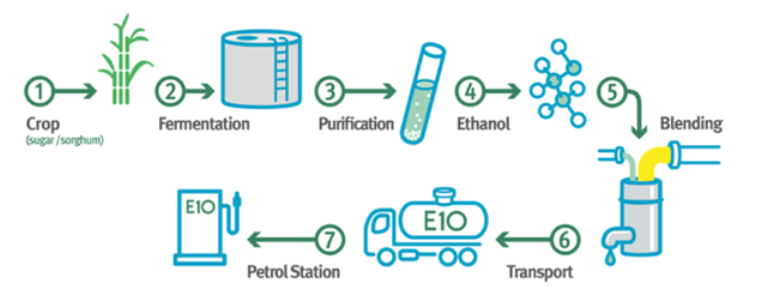
Electrified Flex Fuel Vehicles:
- They are a more advanced version of FFVs that offer the advantage of being able to operate on both ethanol-based fuels and electricity.
- They provide higher fuel efficiency and potentially reducing emissions compared to traditional gasoline-only vehicles.
Bharat Stage (BS6) Norms:
- The BS regulations are based on the European emission standards and the Central Pollution Control Board implements these standards.
- Presently, every newly sold and registered vehicle in India is required to adhere to the BS-VI version of emission regulations.
BS6 Stage II Norms:
- These are even stricter emission limits compared to the initial BS6 norms.
- BS6 (Stage II) incorporates Real Driving Emissions (RDE) and Corporate Average Fuel Economy (CAFE 2) and On-Board Diagnostics.
- The new RDE test figures will provide a more realistic estimation of the amount of emissions likely to be produced by vehicles in real traffic conditions with frequent changes in speed, acceleration, and deceleration.
- Onboard diagnostic (OBD) systems monitor and report the status and performance of various vehicle subsystems and sensors.
Significance of Flex Fuel Vehicles:
- These vehicles offer higher ethanol use and better fuel efficiency similar to Strong Hybrid Electric Vehicles (SHEVs).
- Electrified Flex Fuel Vehicles use minimal advanced chemistry batteries to reduce dependence on imports.
- It reduces reliance on conventional fuels, contributing towards sustainable transportation and India's 'Aatmnirbhar Bharat' initiative as production of ethanol increases.
- The vehicle represents a significant stride towards decarbonization and greener mobility, aligning with global efforts to combat climate change.
Challenges with FFVs:
- Higher cost of ownership and running cost for customers, which may affect their acceptance unless retail fuel prices are competitive.
- Developing FFVs requires significant effort and calibration with multiple fuel blends, making them less viable without widespread fuel availability.
Kākāpō parrots
In News: Recently, the genetic mapping of the kākāpō population, a critically endangered flightless parrot native to New Zealand, has provided crucial insights for conservation biologists striving to save this unique species.
About:

- Kākāpō are remarkable and unusual birds, found only in Aotearoa New Zealand.
- The kākāpō, also known as the owl parrot, is a large, flightless parrot.
- Kākāpō are known for their unique appearance, which includes a facial disc, owl-like eyes, and a large, gray beak.
- It is often referred to as the "night parrot" due to its nocturnal habits.
- They only breed every few years, triggered by the availability of certain forest foods.
- Rimu fruit, which is part of the kākāpō diet, is thought to trigger breeding.
- IUCN Status: critically endangered.
More Information
- Population Recovery: Due to conservation efforts, the kākāpō population has risen to 247 birds on predator-free islands.
- Disease and Infertility: Challenges include diseases like aspergillosis and high egg infertility rates.
Red sand boa - Edukemy Current Affairs
In News: Recently, A report by the Wildlife Conservation Society (WCS)-India has highlighted 172 incidents of seizures involving the red sand boa (Eryx johnii) between 2016 and 2021 in India.
About:
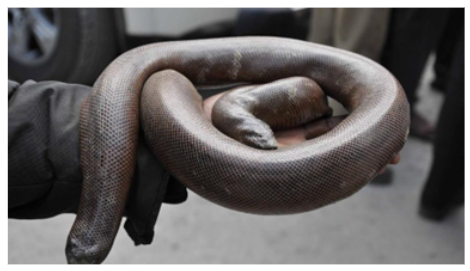
- The red sand boa (Eryx johnii) is a non-venomous snake that lives in the dry parts of the Indian subcontinent.
- It’s also known as the Indian sand boa.
- The Red Sand Boa is the largest of the sand boa in the world.
- It is ovoviviparous and nocturnal and spends the majority of its time under the ground.
- Appearance:
- The red sand boa is a thick-set snake that’s usually reddish-brown, known for its blunt tail, which it uses to mimic its head when it senses a threat.
- Unlike most snakes, the tail is almost as thick as the body and gives the reptile the appearance of being "double-headed".
- Distribution:
- Found in the whole of India excluding North-east states and North-Bengal; also not found in Indian islands.
- Status:
- IUCN Red List: Near Threatened
- CITES: Appendix II
- Indian Wildlife (Protection) Act of 1972: Schedule IV.
- Threats to Red Sand Boa:
- Demand upsurge in pet trade, as well as for use in black magic.
- Poached for perceived medicinal benefits.
- Expansion of human settlements and activities.
Key Highlights of the Report:
- The report aims to shed light on the illegal trade of red sand boas, particularly online, to raise awareness and prevent further illegal collection and sale of the species.
- The report reveals that illegal sand boa trade occurred in 18 Indian states and one Union Territory, spanning 87 districts across the country. Maharashtra recorded the highest number of incidents.
- The report recommends that local and international conservation organizations conduct research to better understand the illegal reptile trade.
- Social media, especially YouTube, aids illegal trade, with 200 sales-promoting videos in 2021.
- The report's findings underscore the urgent need for conservation efforts to prevent the further decline of the red sand boa population and protect India's biodiversity.
New species of leaf insects - Edukemy Current Affairs
In News: Recently, an international research team, has identified seven previously unknown species of leaf insects, also known as walking leaves.
About:
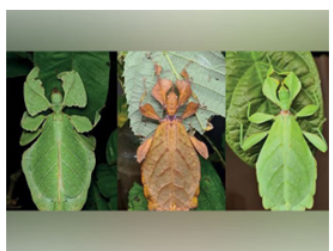
- Walking Leaves, also called leaf insects, are part of the phasmatodea order.
- They are also referred to as “phasmids” or “stick and leaf insects.”
- They are known for their remarkable camouflage that makes them appear like parts of plants such as twigs, bark, or leaves.
- They feed on plants and typically inhabit densely vegetated areas.
- They are also largely nocturnal, resulting in a relative lack of movement during the day that makes locating them quite difficult in the wild.
- Distribution:
- Their natural range extends from islands in the Indian Ocean, across parts of mainland South Asia and Southeast Asia, to Papua New Guinea and Australia in the western Pacific.
- This disguise offers protection from predators and poses challenges for researchers.
- Genetic analysis played a key role in identifying these “cryptic species” that cannot be differentiated based solely on their external appearance.
Features:
- They measure roughly 28 to 100 mm in body length.
- Males tend to be smaller than females.
- They are mostly brown or green, some slightly speckled or have serrated edges like nibbled leaves.
- Female walking leaves cannot fly but males can fly short distances.
Man-made Natural Disaster - Edukemy Current Affairs
In News: Heavy rains in several parts of north India, particularly Himachal Pradesh and Uttarakhand, damaged various infrastructures and took hundreds of lives. While a warming Arctic is said to be a cause for the unusually heavy rains, years of haphazard planning and construction have multiplied the tragedy.
Natural Disaster:
A natural disaster is a catastrophic event that is caused by the forces of nature. Examples of natural disasters include earthquakes, floods, hurricanes, tornadoes, and wildfires. E.g., The 2020 Haiti earthquake, and a recent landslide in Himachal Pradesh.
Impact of Human Activities on Natural Disasters:
- The frequency and intensity of hazards have increased, and anthropogenic climate change has played a major role in that.
- Humans have built on floodplains, encroached water bodies, and planned cities without thinking about sustainability.
- Some landscapes have changed drastically and exceeded their carrying capacity that exacerbated the extent of loss and damage in these areas.
- Rapid urbanization often leads to inadequate infrastructure such as roads, water supply, and sewage systems, causing congestion and public health issues.
- Unsustainable development harms ecosystems, leading to deforestation, pollution, and loss of biodiversity.
Solutions for Various Natural Disasters:
- Flood: Improved drainage systems, floodplain zoning, early warning systems, flood-resistant, infrastructure, flood insurance. E.g., Netherlands’ extensive network of dikes and levees to prevent river flooding.
- Wildfire: Controlled burns, firebreaks, forest management, public awareness campaigns, and firefighting infrastructure. E.g., Australia’s “Prepare, Act, Survive” strategy to educate and prepare communities for bushfires.
- Drought: Efficient water management, rainwater harvesting, drought-resistant crops, water conservation, drought monitoring and early warning. E.g., Israel’s advanced drip irrigation systems to maximize water efficiency.
- Cyclones: Advanced storm tracking, early warning systems, coastal defences, building codes, and evacuation plans. E.g., United States National Hurricane Centre’s forecasts and evacuation plans for hurricane-prone regions.
- Earthquakes: Seismic building codes, retrofitting existing structures, early warning systems, community. E.g., Japan’s stringent earthquake building codes and disaster preparedness.
- Tsunami: Tsunami warning systems, coastal land-use planning, public education on tsunami safety. E.g., Indian Ocean Tsunami Warning System (IOTWS) for early warnings.
- Volcanic Eruptions: Monitoring volcanic activity, evacuation plans, hazard mapping, and resilient infrastructure. E.g., Iceland’s comprehensive monitoring and response system for volcanic eruptions.
Emperor Penguin - Edukemy Current Affairs
In News: According to a new study, up to 10,000 emperor penguin chicks across four colonies in Antarctica’s Bellingshausen Sea may have died as the sea ice underneath their breeding grounds melted and broke apart in late 2022.
About:
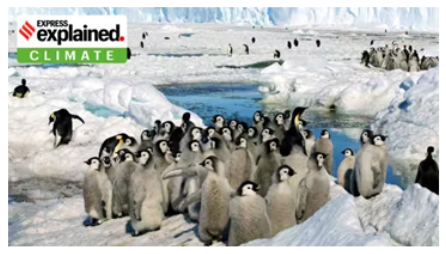
- The emperor penguin is the tallest and heaviest of all living penguin species and is endemic to Antarctica.
- Scientific Name: Aptenodytes forsteri.
- Like all penguins, it is flightless.
- Its diet consists primarily of fish but also includes crustaceans.
- While hunting, the species can remain submerged for around 20 minutes.
- It is the only penguin species that breeds during the Antarctic winter.
- The lifespan is typically 20 years in the wild, although observations suggest that some individuals may live to 50 years of age.
- It is the largest member of the penguin order (Sphenisciformes).
- They spend their entire lives on Antarctic ice and in its waters.
- They have a gray back, white belly, and orange markings behind their eyes and at the top of their chest.
- IUCN status: Near threatened.
More Information:
- Emperor penguins’ breeding cycle heavily relies on stable sea ice, where they spend their entire breeding cycle.
- The sea ice, present from April to December, provides the necessary platform for their breeding and fledging activities (the stage in the development of young birds when they acquire the feathers and abilities necessary for flight).
- As a result of the loss of sea ice, the penguin chicks were unable to develop their waterproof adult wings and regulate their body temperature.
- This led to their vulnerability to drowning or freezing to death.
- This incident marked the first recorded instance of widespread breeding failure of emperor penguins across multiple colonies due to sea ice loss.
|
Penguins |
|
Flora Fauna and ‘Funga’
In News: United Nations Biodiversity has urged people globally to use the word ‘funga’ whenever they say ‘flora and fauna’, in order to highlight the importance of fungi.
About Fungi:
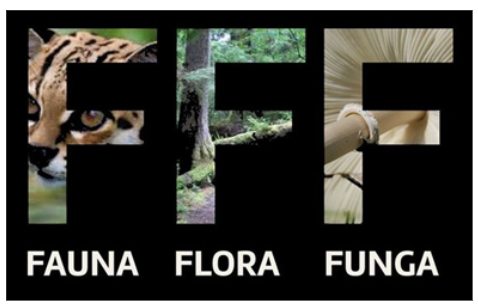
- Fungi, along with Animalia (animals), Plantae (plants), Protista, Archaea/Archaebacteria, and Bacteria or Eubacteria form the six ‘kingdoms’ of biology.
- They are a very diverse group of eukaryotic organisms encompassing a wide range of life forms, from single celled to very complex multicellular organisms. They can be microscopic or macroscopic.
- Two years ago, the Species Survival Commission (SSC) of IUCN announced that it would use “mycologically inclusive” language in its internal and public-facing communications i.e. “fauna, flora and funga” to incorporate fungi in conservation strategies with rare and endangered plants and animals.
- UN Biodiversity urged that fungi needs to be protected on an equal footing with animals and plants in legal conservation frameworks
Significance of Fungi:
- Nutrient Cycling: Fungi have the ability to transform nutrients in a way that makes them available for plants. They can also propel nitrogen fixation and phosphorus mobilisation.
- Carbon Cycling: Fungi are important contributors to the soil carbon stock. They play a major part in the carbon cycle through the soil food web.
- Soil Carbon sequestration: Together, plants and fungi capture carbon from the atmosphere and store it into the soil for decades. This process not only improves soil fertility but also reduces the excess carbon released by humans into the atmosphere.
- Nutrition and food security: Edible mushrooms are fungi, which are rich in nutrients such as vitamin B, C and D, fibre, minerals including potassium, phosphorus, calcium and they are also a good source of protein.
- Human Health: Fungi also provide health benefits for humans. 6% of edible mushrooms possess medicinal properties, which can help prevent diseases and boost our immune system.
- Environmental protection: Fungi also helps to degrade various pollutants from the environment, such as plastic and other petroleum-based products, pharmaceuticals and personal care products, and oil.
|
Penguins |
|
IUCN's Tiger Programme
In News: In a significant step towards preserving the world's big cats and their habitats, the Integrated Tiger Habitat Conservation Programme (ITHCP) has launched a Call for Concept Notes for Phase IV of the Tiger Programme.
About:
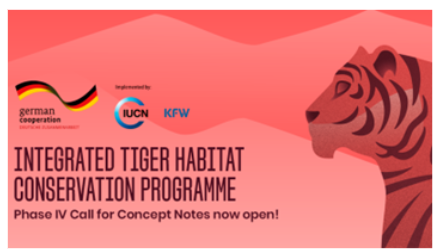
- This phase will expand eligibility to include species beyond tigers.
- Leopards and both mainland and Sunda clouded leopards are now eligible for funding.
- Countries eligible under this call for concept notes include Bangladesh, Bhutan, Cambodia, India, Indonesia, Myanmar, Nepal and Thailand, focusing on specific conservation areas.
- The Integrated Tiger Habitat Conservation Programme (ITHCP), launched in 2014, is a strategic funding mechanism supported by the German Federal Ministry for Economic Cooperation and Development (BMZ).
More Information:
- The ITHCP’s success in increasing tiger populations by 40% since 2015 highlights the effectiveness of such initiatives.
- This phase signifies a vital step towards safeguarding diverse species, their habitats, and surrounding communities.
- Project grant size can vary from a minimum of € 500,000 to a maximum of € 2 million, and sites currently being funded under ongoing ITHCP projects are not eligible for funding under this call.
6th Census Report on Minor Irrigation (MI) Schemes
In News: Recently, the Ministry of Jal Shakti, Department of Water Resources, River Development and Ganga Rejuvenation released the report on the 6th census on minor irrigation schemes.
About:
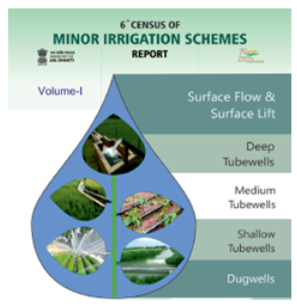
Key Highlights of the Report:
- The census reveals that there are a total of 23.14 million minor irrigation schemes in India, with 94.8% (21.93 million) being Ground Water (GW) schemes and 5.2% (1.21 million) being Surface Water (SW) schemes.
- Uttar Pradesh holds the highest number of Minor Irrigation (MI) Schemes, followed by Maharashtra, Madhya Pradesh, and Tamil Nadu.
- The report indicates a growth of 1.42 million MI schemes compared to the previous census, with a 6.9% increase in GW schemes and a 1.2% increase in SW schemes.
- The ownership of MI schemes is primarily private (96.6%), with a notable finding that 18.1% of individually owned schemes are owned by women.
More About the News:
- Leading States in GW schemes are Uttar Pradesh, Maharashtra, Madhya Pradesh, Tamil Nadu and Telangana.
- GW schemes comprise dugwells, shallow tube wells, medium tube wells and deep tube wells.
- In SW schemes Maharashtra, Karnataka, Telangana, Odisha and Jharkhand have the highest share.
- The SW schemes comprise surface flow and surface lift schemes.
- So far, five censuses were conducted in 1986-87, 1993-94, 2000-01, 2006-07, and 2013-14.
Fire Prevention Zone - Edukemy Current Affairs
In News: A well-constructed fire prevention zone created by a local Indigenous logging company played an important role in protecting a community from a wildfire in Canada.
About:
- Fire prevention zones are designated areas meticulously managed to mitigate the risk of wildfire spread and associated damage.
- These zones are typically created in or around communities, especially those located in wildfire-prone areas.
- The primary goal of Fire Prevention Zones is to create a buffer or barrier that hinders the advance of wildfires, protecting lives, property, and natural ecosystems.
- Indigenous logging company in Canada named Ntityix Development, created a fire prevention zone using traditional Indigenous forestry practices.
- These practices encompassed activities such as forest thinning, clearing debris from the ground, and controlled burning of debris and ground cover. This approach aimed to curtail the availability of fuel for wildfires.
Hollongapar Gibbon sanctuary
In news: Primatologists raise concerns against a proposed railway track through western hoolock gibbon's sanctuary
About Hollongapar Gibbon Sanctuary
- The Hollongapar Gibbon Sanctuary located in the eastern Indian state of Assam and stands as a vital refuge for the western hoolock gibbon or Hoolock hoolock.
- The sanctuary spans approximately 21 square kilometers and plays a pivotal role in the conservation of this endangered primate.
- The western hoolock gibbon is the only ape species found in India, making it a species of utmost significance for conservation efforts.
- It is categorized as "endangered" due to habitat loss and fragmentation, making sanctuaries like Hollongapar crucial for its survival.
- The Gibbon Sanctuary has a unique ecosystem characterized by its lush greenery and diverse flora providing a haven for a variety of wildlife with hoolock gibbons being the flagship species.
- Like many other gibbon species worldwide, the western hoolock gibbons face the threat of habitat loss, primarily due to deforestation and human encroachment.
- In recent years, the sanctuary has been affected by habitat fragmentation, leading to isolated populations of gibbons.
- In this regard, the Wildlife Institute of India (WII) has proposed artificial canopy bridges to facilitate the movement of hoolock gibbons across a railway track that divides their habitat.
- Beyond gibbons, the Hollongapar Sanctuary is also a biodiversity hotspot being home to a diverse range of flora and fauna, including various bird species, reptiles, and plant species.
- Overall, the preservation of the gibbon sanctuary through steps such as canopy bridge and railway track rerouting are vital to secure the sanctuary's future and the survival of this endangered primate species.
Flood Plain Zoning - Edukemy Current Affairs
In News: Punjab has been reeling under floods for well over a month and people settled in the villages lying in the sensitive flood plains are worst affected. The concrete encroachments in these areas have further exacerbated the devastation caused by flooding.
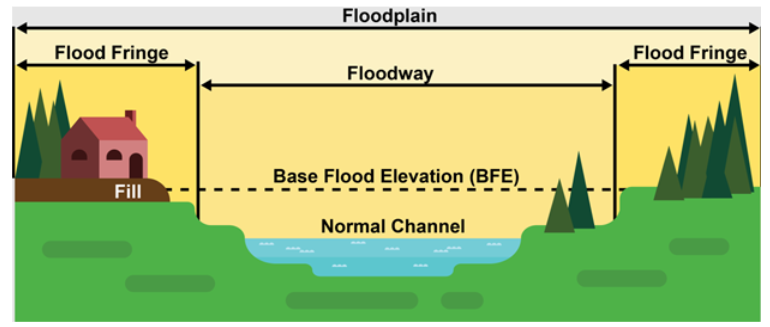
About Flood Plain Zoning:
- Floodplain zoning is a non-structural measure to mitigate flood disasters by preventing development in the floodplains. Encroachment and unauthorised development in floodplains reduces the carrying capacity of rivers and exacerbates the effects of floods.
- It is a land use planning strategy that designates specific areas along rivers and water bodies for various uses based on their susceptibility to flooding.
- A river expands and contracts naturally over seasons and in different years. A flood plain is an area adjacent to the river which normally gets flooded when the river swells.
- Zoning involves demarcating areas around rivers likely to be affected by floods of different magnitudes and frequencies, in order to specify the types of permissible developments there.
- As per guidelines of the NDMA, defence installations, industries, and public utilities like hospitals, electricity installations, water supply, telephone exchanges, railway stations, etc. should be located above the levels corresponding to the maximum observed flood levels.
Need for Flood Plain Zoning:
- Defence against flooding: Well-maintained flood plains, free from wanton construction and concrete, are natural defences against flooding farther inland.
- Groundwater recharge: They are also useful for recharging groundwater levels and maintaining the water table.
- Better land use planning: Identification of flood plains based on topography helps in better land use planning.
- Prevention of loss of life and property: Floods cause massive loss of life and property along with large scale migration. Adoption of flood plain zoning would resolve such crises.
Status of Flood plain zoning:
- Punjab is yet to carry out flood plain zoning, despite NGT’s directions for the same.
- Despite the Centre’s directions, so far only four states namely Manipur, Jammu & Kashmir, Rajasthan and Uttarakhand have adopted the act on paper. On ground implementation still remains unsatisfactory.
- Environmental activists and NGOs have been demanding flood plain zoning, but no progress is seen.
- India’s high risk and vulnerability is highlighted by the fact that 40 million hectares out of a geographical area of 3290 lakh hectares is prone to floods.
Impacts of lack of zoning and haphazard development:
- Encroachment and mismanagement of flood plains lead to non-suitable construction activity and concretization of flood plains.
- Unsuitable constructions result in pushing floods further inland, increasing the area harmed and damage caused during floods.
- Concretisation also leads to floods taking longer to subside as the water simply does not drain.
- Such kind of flooding is not good for flood plains themselves, affecting the fertility and quality of the soil as well.
Salem sago - Edukemy Current Affairs
In News: The Salem Starch and Sago Manufacturers Service Industrial Cooperative Society Ltd (popularly called SAGOSERVE) received a Geographical indication tag or GI tag for Salem sago.
About
- Sago, derived from raw tapiocas, is in the form of small hard globules or pearls and is pearl white in color.
- Tapioca is a major horticulture crop cultivated on nearly 3 lakh hectares in Tamil Nadu, producing 60 lakh tonnes of the crop.
- Sago is manufactured from the wet starch powder crushed from tapioca roots.
- The wet starch powder is used for producing sago and the dry powder has been used as a raw material for industrial purposes.
- Sago was produced first in Salem district, which is the main center for sago production in the country, on a cottage scale basis.
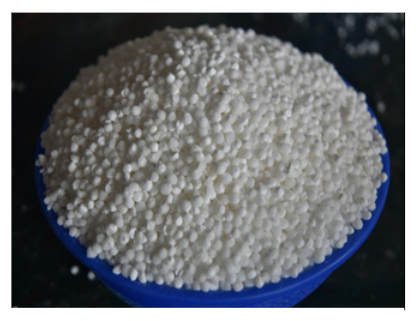
Global Biofuel Alliance - Edukemy Current Affairs
In News: Recently, on the side lines of G20 Summit, India has launched the Global Biofuels Alliance, which aims to accelerate the transition to sustainable biofuels and reduce the world’s dependency on traditional fossil fuels.
Biofuels:
- Biofuels are renewable energy sources derived from biomass, such as crop stubble, plant waste, and municipal solid waste.
- Biofuels may be solid, liquid or gaseous in nature.
- Solid: Wood, dried plant material, and manure
- Liquid: Bioethanol and Biodiesel
- Gaseous: Biogas
- Various Generations of Biofuels:
- First generation: It is produced from consumable food items containing starch (rice and wheat), sugar (beets and sugarcane) for bio-alcohols, or vegetable oils for biodiesel.
- Second generation: It is mainly obtained from non-food feedstocks such as forest/industry/agricultural wastes and waste or used vegetable oils.
- Third generation: It is known as ‘algae fuel’ and is derived from algae in the form of both biodiesel and bio-alcohols.
- Fourth generation: Like the third generation, 4G biofuels are made using non-arable land. However, unlike the third, they do not need the destruction of biomass.
Global Biofuels Alliance:
- It is an India-led Initiative to develop an alliance of Governments, International organizations and Industry to facilitate the adoption of biofuels.
- A total of 19 countries and 12 international organizations have so far agreed to join the alliance, including both G20 members and non-member countries.
- India, Brazil and the US are the founding members of the alliance.
- India, the US and Brazil account for a total of 85 percent of the global ethanol production with the US holding 55 per cent share followed by Brazil 27 per cent and India 3 per cent.
Significance of Global Biofuels Alliance:
- India sees this alliance as a means to advance energy transitions in developing countries and promote a circular economy.
- India, a major oil importer, is working on building its capacity to produce biofuels, particularly from sugarcane and agricultural waste.
- India aims to increase the blending of ethanol in petrol to 20% by 2025 and is establishing compressed biogas (CBG) plants.
- The initiative aligns with India’s goal of transitioning to alternative fuels and reducing its carbon emissions, with a target of achieving net-zero emissions by 2070.
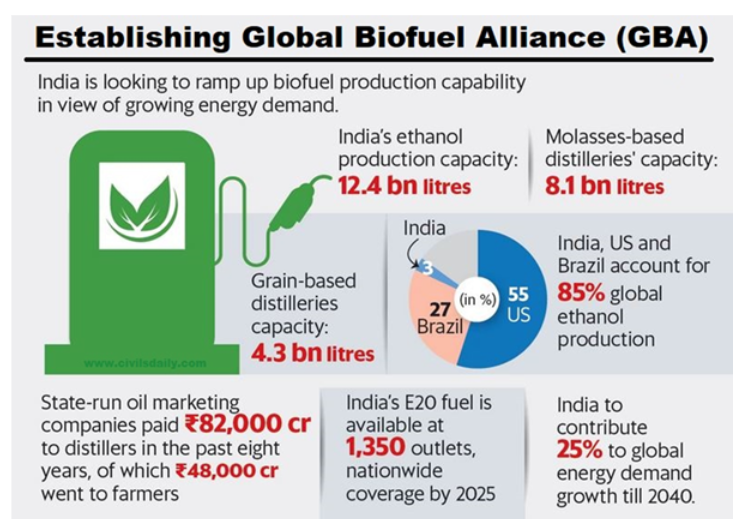
Araku Coffee - Edukemy Current Affairs
In News: Recently, Araku Coffee was gifted to G-20 delegates by the government of India
About
- Araku Valley Arabica coffee can be described as coffee from the Eastern Ghats hilly tracks of Visakhapatnam district of Andhra Pradesh and Odisha region grown at an elevation of 900-1100m Mean Sea Level (MSL).
- The coffee is grown in the hilly terrains of Ananthagiri, Paderu, Pedabayalu, G Madugula, Koraput, etc.
- These coffee beans bear the essence of the valley's rich soil and temperate climate. Pure Arabica with a rare aromatic profile, Araku Coffee is known for its unique texture and symphony of flavors.
- Farmers grow coffee without the use of machines and chemicals.
- This variety is produced by the tribals, who follow an organic approach in which they emphasize management practices involving substantial use of organic manures, green manuring, and organic pest management practices.

- Araku Coffee is often referred to as "India's answer to Blue Mountain coffee" due to its excellent flavor profile and premium quality.
Reasons behind Morocco’s earthquake
In News: Recently, Morocco has been hit by a powerful earthquake with a magnitude of 6.8, causing a death toll exceeding 2,400 people. Its epicentre was located in the Al-Haouz province, in the Atlas Mountains of the historic city of Marrakech.
Reasons for the earthquake in Morocco:
- Morocco is situated in a region where the Eurasian and African tectonic plates converge.
- The Atlas Mountains, where the earthquake occurred, are actively rising due to the convergence of these two large tectonic plates.
- Although the region had not experienced major recorded earthquakes before, stress had been accumulating underground for an extended period due to the slow movement of tectonic plates.
- The Oblique-Reverse Fault is present in areas of compression along the convergent plate boundaries. The stress along these fault lines can induce earthquakes as rocks abruptly shift to release accumulated stress.
Reasons for heavy damage in Morocco:
- The epicentre of the earthquake is roughly 18.5 km below the Earth’s surface. So, it was a very shallow earthquake. Shallow earthquakes carry a much higher amount of energy when they hit the surface.
- The earthquake’s epicentre was in the High Atlas Mountains which is close to the city of Marrakesh, causing it to affect populated areas and infrastructure.
- Earthquakes are not very common in North Africa. Therefore, Morocco was not prepared for such a calamity.
- Many changes were introduced to construction rules after Morocco faced the earthquake in 1960, but buildings in rural areas and older cities are not built to withstand the earthquake. Many houses collapsed in Marrakech, a UNESCO World Heritage Site.
Types of Faults:
- Dip Slips:
- In these faults, the movement is along the direction of the dip plane.
- Vertical movement either up (reverse dip-slip) or down (normal dip-slip) along the fault plane.
- Strike-Slip Faults:
- In these faults, the movement is horizontal along the fault plane and is parallel to the strike of the fault.
- These faults are common where tectonic plates slide past each other horizontally.
- Oblique-Slip Faults:
- These faults show characteristics of both dip-slip and strike-slip faults.
- Movement occurs in two directions – horizontal (strike-slip) and vertical (dip-slip) along the fault plane.
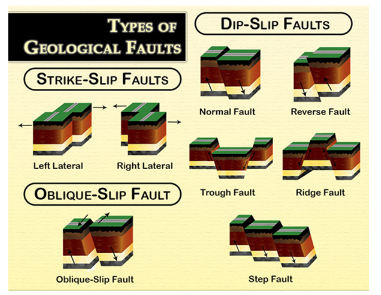
Earthquake prone areas in India:
- The Western Himalayas in India are considered one of the most dangerous seismic zones globally.
- The entire Himalayan region, spanning from the Hindu Kush mountains to Arunachal Pradesh, is at risk of a major earthquake with a magnitude exceeding 8 on the Richter scale.
- This is because of the substantial energy accumulation along fault lines due to the ongoing interaction of various tectonic plates.
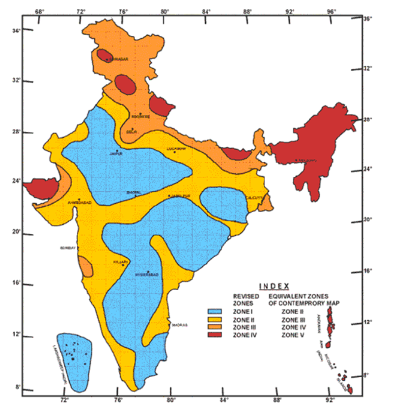
Way Forward:
- Earthquakes cannot be accurately predicted because there is currently no equipment or method to detect precursory signals within the Earth that would indicate an impending major earthquake.
- However, we can mitigate their impact. Through integrated studies of the region’s geology, geophysics and geodesy we can find out where there are active earthquake faults.
- We can also estimate how powerful the earthquakes on these faults could be and how often they might happen again.
- The best way to minimise earthquake damage is to improve seismic building design codes to withstand the highest possible seismic activity.
- Traditional homes and rock constructions in mountain villages should be reinforced to prevent future disasters.
Libya Flood Reason for High Death Toll
In News: Recently, over 5,000 individuals have died and thousands are missing after a disastrous flood in Derna, eastern Libya, caused by broken dams and flash floods brought on by the Mediterranean storm Daniel.
Mediterranean storm:
- A Mediterranean storm or Mediterranean cyclone is a weather condition formed over the Mediterranean Sea.
- Although the strength and effects of Mediterranean storms can vary, they frequently produce large amounts of precipitation, which can cause flooding, landslides, and other weather-related dangers.
Derna City of Libya:
- Derna is a port city in eastern Libya with a population of around 85,000 to 90,000.
- Libya is a country in the Maghreb region of North Africa.
- The Mediterranean Sea forms its northern boundary, and Algeria, Egypt, Sudan, Chad, and Tunisia make up its western, eastern, southern, and southernmost borders, respectively.
Flash Flood:
- Excessive or continuous rainfall over a period of days or during particular seasons, can lead to stagnation of water and cause flooding.
- Flash floods occur in a much shorter span of time (say, when rainfall creates flooding in less than 6 hours) and are highly localized.
- Flash floods can also be caused by factors apart from rainfall, like when a dam overflows.
Reasons for Flood in Libya:
- Despite being a port city there was a lack of a functioning weather agency and early warning system.
- Lack of maintenance of dam which caused the failure of the dam.
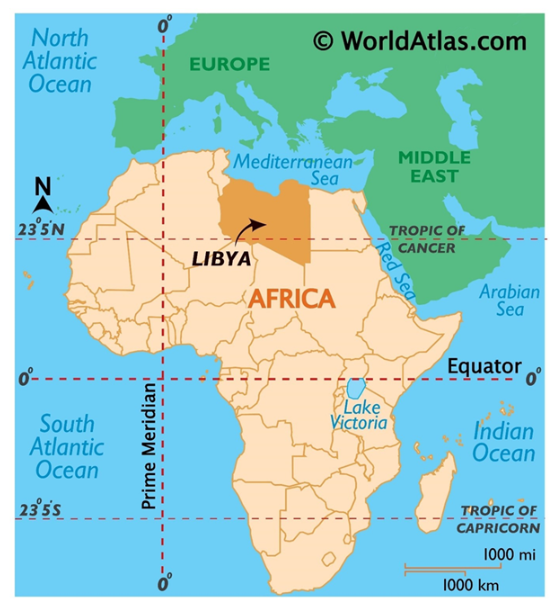
Rubber - Edukemy Current Affairs
In News: Rubber Board to increase the area under rubber in Northeast.
About
- The Rubber Board of India is embarking on a project aimed at expanding the area under natural rubber cultivation in the northeastern states of India.
- This initiative excludes Sikkim but includes the state of West Bengal.
- The objective is likely to promote and support the cultivation of natural rubber in the northeastern region, which could have economic and environmental benefits for the area and the rubber industry as a whole.
About Natural Rubber
- Natural rubber is a polymer derived from isoprene, an organic compound. It is a cohesive, elastic solid obtained from the latex of several tropical trees, with Hevea brasiliensis being the most significant source.
- Rubber trees typically have an economic lifespan of approximately 32 years in plantation settings.
- Natural rubber can be sourced from various plants, with the most common being the Pará rubber tree (Hevea brasiliensis). This tree thrives when cultivated and produces latex for several years.
- Congo rubber is obtained from vines within the Landolphia genus. These vines cannot be successfully cultivated, leading to the extensive harvesting of wild plants in the Congo for their latex.
- Additionally, rubber can be derived from dandelion milk, which contains latex and can be utilized in rubber production.
Condition Required
- Rubber is a tropical tree. It requires high temperature throughout the year – ranging between 20°-35°C or average monthly mean of 27°C. Less than 20°C temperature is detrimental. Similarly, rubber also requires heavy rainfall.
- The annual average rainfall of not less than 200 cm is optimum. Rubber tree thrives well when the distribution of rainfall is uniformly high all over the year. The equatorial regions of the world are suitable for rubber cultivation.
- Rubber is grown in literate or loamy soil, mostly in slope and undulated land or slightly high elaborated flat land where there is no possibility of water stagnation, and having well drainage facilities
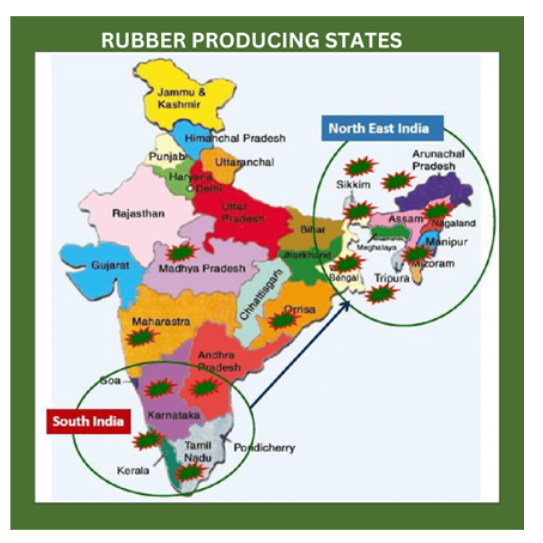
Critical Raw Materials Act - Edukemy Current Affairs
In News: EU Parliament votes in favor of Critical Raw Materials Act
About
- Critical raw materials refer to natural resources that hold a strategic value for a country or region because of their economic, industrial, and geopolitical significance.
- These resources play a vital role in various industries, encompassing technology, manufacturing, energy, and defence, and their accessibility can profoundly affect a nation's economic stability and competitive edge.
- Critical raw materials encompass rare earth elements, lithium, cobalt, graphite, platinum group metals, and specific minerals and metals pivotal for advanced technologies and the development of clean energy solutions.
Unified Portal for Agricultural Statistics
In News: Recently, the Unified Portal for Agricultural Statistics was officially launched by the central government.
About
- Unified Portal for Agricultural Statisticsplatform is designed to revolutionize data management in India’s agriculture sector, addressing complex governance challenges.
- The UPAg Portal addres ses key challenges in agriculture data, including lack of standardization, verification, dispersion, and different update frequencies.
- It offers data standardization, advanced analytics, granular production estimates, commodity profile reports, and flexibility for users to prepare their own reports.
- The UPAg Portal is part of the Digital Public Infrastructure for Agriculture, focusing on harnessing data for growth, transparency, and agility in India’s agriculture sector.
- This initiative aligns with e-governance principles and aims to enhance data-driven decision-making for policymakers, researchers, and stakeholders in the agriculture domain.
Phosphorus - Edukemy Current Affairs
In News: India is running out of phosphorus, which is essential for fertilizers but also a major environmental pollutant.
Reasons for Phosphorous shortage:
- Morocco and the Western Sahara region, control most of the world’s phosphorus reserves, raising geopolitical concerns.
- Coexistence of heavy metal cadmium with phosphorus in some deposits is a significant issue. Cadmium-laden fertilizers are often used in agriculture, leading to health concerns, including heart disease.
- The phosphorus shortage is due to its limited availability in geological formations and its contamination of water bodies when not properly managed.
- India is the world’s largest importer of phosphorus, primarily from cadmium-laden deposits in West Africa.
- Small portion of mined phosphorus is used in food production, with a significant amount lost to water bodies as agricultural runoff.
- Phosphorus consumed by people ends up in sewage, exacerbating environmental problems like algal blooms and fish deaths.
- To address the phosphorus scarcity, there is growing interest in mining urban sewage for high-quality phosphorus. This approach could create a sustainable source of phosphorus while mitigating environmental issues.
Narmada River - Edukemy Current Affairs
In News: Severe rains in Gujarat caused the Narmada River to flood, displacing thousands.
About:
- Some blame the Sardar Sarovar Dam operators for their delayed actions.
Narmada River
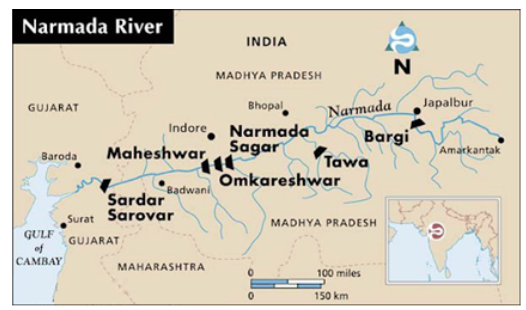
- Narmada is the largest west flowing river of the peninsular region flowing through a rift valley between the Vindhya Range on the north and the Satpura Range on the south.
- It rises from Maikala range near Amarkantak in Madhya Pradesh.
- It flows through Madhya Pradesh, Maharashtra, and Gujarat before reaching the Gulf of Cambay.
- The river near Jabalpur (Madhya Pradesh) forms the DhuanDhar Falls.
- It is the fifth largest river in India.
- Major Tributaries: Hiran, Orsang, the Barna and the Kolar.
- Notable dams in the Narmada Basin include the Sardar Sarovar Dam, Rani Avanti Bai Sagar (Bargi) Dam, and Maheshwar Dam.
Sardar Sarovar Dam
- The Sardar Sarovar Dam is a concrete gravity dam erected on the Narmada River near the town of Kevadiya in Gujarat’s Narmada District.
- The dam was constructed to provide water and electricity to four Indian states: Gujarat, Madhya Pradesh, Maharashtra, and Rajasthan.
- The dam is located on the boundary between Gujarat and Maharashtra in Gujarat’s Narmada district.
- To the west of the dam lies the Malwa plateau of Madhya Pradesh.
Formation of Pink Diamond - Edukemy Current Affairs
In News: Recently, Western Australian scientists have connected formation of the pink diamond to the Earth’s first supercontinent (Vaalbara or Nuna) and events 1.3 billion years ago.
Pink diamond:
- Rare and highly coveted pink diamonds are distinguished by their exquisite pink or reddish-pink colour.
- Pink diamonds are quite uncommon, and because of their compelling beauty and rarity, they are worth a lot of money.
- Instead of impurities like nitrogen or boron, which give other coloured diamonds their colours (such as in the case of yellow and blue diamonds), pink diamonds have distinctive structural imperfections in the crystal lattice of the diamond.
Key findings of the Study:
- More than 90% of all the pink (and Red) diamonds ever found were discovered at the recently closed Argyle mine in the remote northwest of Australia.
- By measuring the age of elements in the crystals, the researchers determined that Argyle was 1.3 billion years old. That lines up with the break-up of the world’s first supercontinent, known as Nuna.
- Two of the three ingredients for forming pink diamonds had already been known.
- The first ingredient is carbon, and it must be more than 150 km deep.
- The second is just the right amount of pressure, to damage the otherwise clear diamonds.
- The missing (3rd) ingredient was the event (collisions between western Australia and northern Australia 1.8 billion years ago) that sent the diamonds shooting up to the surface along with the magma.
- Old mountain belts of Canada, Russia, southern Africa, and Australia are the possible locations where pink diamonds can be found.
Nuna supercontinent:
- The former supercontinent of Columbia, also known as Nuna or Hudsonland formerly existed on Earth.
- It is believed to have existed between 2,500 and 1,500 million years ago, during the Paleoproterozoic Era, as initially suggested by John J.W. Rogers and M. Santosh in 2002.
- Supercontinent assembly most likely took place between 2100 and 1800 million years ago, amid global-scale collisional episodes.
- The cores of the continents Laurentia, Baltica, the Ukrainian and Amazonian shields, Australia, and maybe Siberia, North China, and the Kalahari were built up of proto-cratons that made up Columbia.
- Geological and paleomagnetic findings support the presence of Columbia.
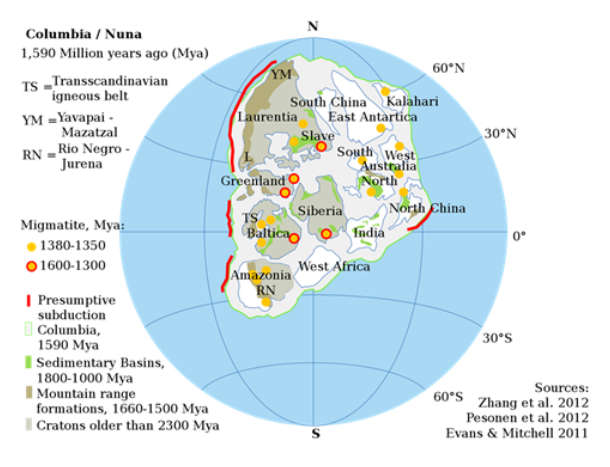
Vandanium Discovery in Gujarat
In News: Rare metal Vanadium, key for batteries, discovered in India’s Gujarat.
About
- Vanadium is a rare metal and a key raw material for many industrial applications. The metal has been found in the sediment samples collected from the Gulf of Khambhat, which opens into the Arabian Sea off Alang in Gujarat.
Application of Vandanium
- Enhancing Steel and Titanium Resilience:
- Vanadium is a significant metal in India due to its scarcity. It possesses the capability to improve the resilience and strength of steel and titanium alloys.
- Vanadium Redox Batteries (VRB) for Energy Storage:
- Modern applications of vanadium include its use in energy storage systems, particularly in VRBs. VRBs are utilized in various settings, including power plants and commercial applications.
- Unlimited Capacity with Sequentially Larger Tanks:
- VRBs offer the advantage of nearly unlimited capacity by using storage tanks of increasing size.
- Long-Term Discharge Tolerance:
- VRBs can be left completely discharged for extended periods without suffering any adverse effects.
- Rechargeability via Electrolyte Replacement:
- #BBD0E0 »
Kaobal Gali-Mushkoh Valley - Edukemy Current Affairs
In News: Kaobal Gali-Mushkoh Valley, once a battleground during the Kargil war, has now opened up for tourists.
About:
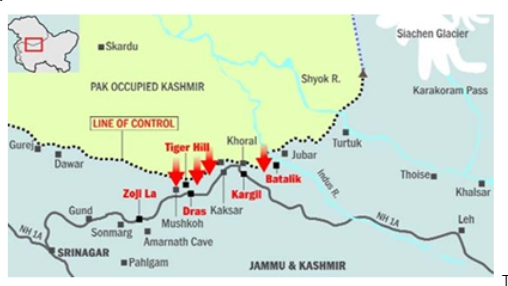
- This transformation is attributed to the enduring ceasefire between India and Pakistan sparking hope that tourism-driven commerce will thrive in the region.
Kaobal Gali-Mushkoh Valley
- It is located in Kargil’s Drass Sector and was a battlefield during the 1999 Kargil war between India and Pakistan.
- The region includes the Gurez Valley in north Kashmir, which was previously inaccessible to civilians due to shelling from Pakistan but now connects with the Mushkoh Valley in Kargil’s Drass Sector.
- Kaobal Gali, the highest pass at a height of 4,167 meters in Gurez, connects Gurez to Mushkoh Valley.
Gurez Valley
- The Gurez Valley is close to the Line of Control (LoC), in north Kashmir, with the Kishanganga river demarcating the line in several parts.
- It is also home to ibex, musk deer and marmots, Himalayan brown bear and snow leopard.
- The Gurez valley is one of few habitations in Kashmir where villages with only log houses exist, with no intervention of urban concrete materials.
Mushkoh Valley
- The Mushkoh Valley is situated in Dras, Ladakh.
- It is home to boisterous wild tulip flowers and endangered Himalayan yew.
Galactic tides - Edukemy Current Affairs
In News: Like the earth’s oceans at their shores, the universe’s galaxies also experience tides, on a larger scale.
About
- The gravitational forces within galaxies that result from interactions between celestial objects like stars and gas clouds are what drive galactic tides, which are similar to the tides in Earth's oceans but on a much larger scale.
- The evolution of galaxies is significantly shaped by these tidal forces. By forming features like tidal tails and bridges, promoting star formation, and upsetting smaller star systems, they can change the structure of a galaxy.
- Galactic tides over long periods of time also disturb star orbits, resulting in long-term modifications in galaxy structure. Even the interactions between nearby galaxies are influenced by galactic tides.
- Supermassive black holes at the centers of galaxies are also affected by galactic tides, which results in events that change how these cosmic giants interact with nearby stars.
World Coffee Conference - Edukemy Current Affairs
In News: Recently, the International Coffee Organisation (ICO) hosted the 5th World Coffee Conference (WCC) in Bengaluru.
Key highlights of the 5th World Coffee Conference (WCC):
- The ICO focused on highlighting the economic importance of coffee.
- It is being held for the first time in an Asian coffee-producing country.
- "Regenerative agriculture," a comprehensive agricultural method was one of the main themes covered during the conference.
- Regenerative Agriculture:
- It is a comprehensive agricultural strategy that emphasizes reducing soil disturbance, diversifying crops, utilizing cover crops, and including livestock in order to improve soil health, biodiversity, and sustainability.
- By adhering to concepts like conservation tillage, crop variety, soil cover with cover crops, and livestock integration, it seeks to increase resources rather than depleting them.
Conditions required for Coffee Plantation:
- Climate: Hot and Humid; Dry weather is necessary at the time of ripening of the berries.
- Rainfall: High (150 – 250 cm)
- Ideal Soil Conditions: Well-drained loamy soils, Presence of humus and minerals (iron, calcium), Fertile volcanic red earth, and Deep sandy loam soils.
Coffee Production:
- In India:
- Karnataka (Highest) > Kerala > Tamil Nadu > Andhra Pradesh.
- Karnataka accounts for approximately 70% of India's total coffee production.
- Global Production:
- Brazil is the largest producer.
- India’s position is 6th (65 – 70% of India’s coffee is exported).
Coffee Varieties in India:
- Arabica: Grown at higher altitudes and it has Higher market value due to its aroma.
- Robusta: Known for its strength and used in various blends.
International Coffee Organization (ICO):
- ICO was established in 1963, under the United Nations and is headquartered at London.
- It serves as the only intergovernmental organization for coffee.
- It administers the International Coffee Agreement (ICA), an important instrument for development cooperation.
- Aim to strengthen the coffee sector and promote sustainable growth for the Global Coffee Value Chain (G-CVC).
- It has 43 exporting members (including India) and 6 importing members.
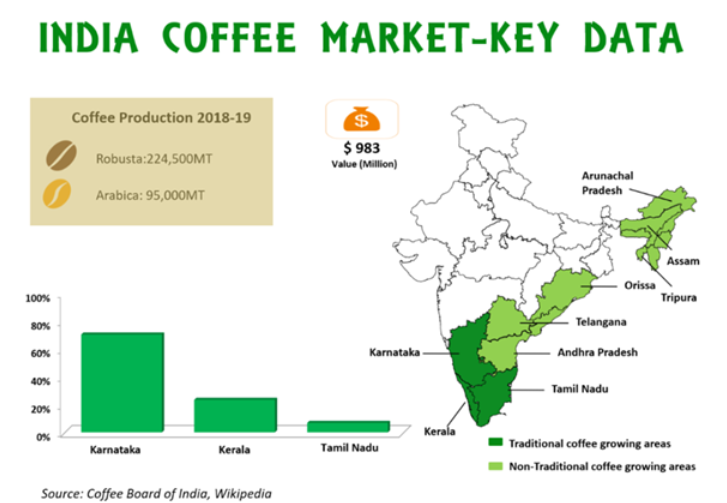
EXERCISE YUDH ABHYAS-23 - Edukemy Current Affairs
In News: The 19th edition of “EXERCISE YUDH ABHYAS” is scheduled to take place from 25th September to 8th October 2023 in Fort Wainwright, Alaska, USA.
About:

- It is an annual exercise conducted jointly by the Indian Army and the United States Army.
- The previous edition of the Exercise was conducted in Auli, Uttarakhand, India in November 2022.
- Yudh Abhyas training includes various types of technical and operational activities exchanged between the armies of India and the United States.
- The theme of the EXERCISE YUDH ABHYAS-23 is ‘Employment of an Integrated Battle Group in Mountain/ Extreme Climatic Conditions’ under Chapter VII of the United Nations mandate.
Key Features:
- The exercise will feature a Command Post Exercise, as well as Expert Academic Discussions on specific topics.
- The Field Training Exercise will validate Integrated Battle Groups against hostile forces at the Brigade level, Integrated Surveillance Grid at the Brigade/Battalion level, and the use of Heliborne/Airborne elements and Force Multipliers.
- It will also assess logistics and casualty management during operations, evacuation, combat medical aid, and other aspects relevant to High Altitude Areas and Extreme Climatic Conditions.
- The Exercise will also involve the exchange of views and best practices in drills on a wide spectrum of combat skills including combat engineering, obstruction clearance, mine and Improvised Explosive Devices warfare.
Perovskite - Edukemy Current Affairs
In News: Recently, A team from the University of Surrey discovered that a nanoscale “ink” coating could improve stability enough to make next-generation perovskite solar cells suitable for mass production.
About:
- Perovskite is a calcium titanium oxide mineral composed of calcium titanate.
- Perovskite solar cells are cheaper, lighter, and more efficient than traditional silicon-based cells.
- However, the emerging technology currently suffers from a drop in efficiency and energy output during the manufacturing process.
- The researchers identified an aluminium oxide that minimizes this efficiency drop during the conditioning of perovskite solar cells.
- Perovskite has been hailed as a “miracle material” for its potential to transform an array of industries, from ultra high-speed communications to renewable energy.
- Recent advancements have enabled the creation of self-healing solar panels and improved efficiency when combined with silicon in tandem cells.
- This innovation could potentially accelerate the transition to renewable energy sources.
‘Pralay’ ballistic missiles

In News: Recently, India's defence ministry has approved the acquisition of a regiment of ‘Pralay’ ballistic missiles for deployment along the Line of Actual Control and the Line of Control. About:
- ‘Pralay’ is a canisterised Tactical, surface-to-surface, short-range ballistic missile (SRBM) for Battlefield use.
- It has been developed by the Défense Research and Development Organization (DRDO).
Features
- ‘Pralay’ has a strike range of 150 to 500 kilometres.
- It can carry a conventional warhead of 350 kg to 700 kg.
- It is highly versatile, capable of carrying different types of warheads, and features advanced technology to counter interceptor missiles.
- It can alter its trajectory mid-flight and is powered by a solid propellant rocket motor.
- ‘Pralay’ will become the longest-range surface-to-surface missile in the Army’s inventory and will form a key part of India’s Rocket Force, alongside the BrahMos supersonic cruise missile.
Dhanush guns - Edukemy Current Affairs
In News: The Indian Army is on track to complete the induction of 114 Dhanush artillery guns by 2026, with one regiment already operational.
About:
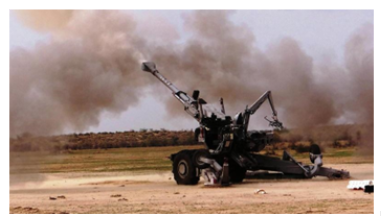
- Dhanush is the indigenously upgraded gun of the Swedish Bofors gun procured in the 1980s.
- It is a 155 mm, 45-calibre towed artillery gun with a range of 36 km and has demonstrated a range of 38 km with specialized ammunition.
- It is the first indigenously built long-range artillery gun.
- It is an upgrade of the existing 155m, 39 calibre Bofors FH 77 gun.
- The Advanced Weapons and Equipment India Limited, carved after corporatisation of the Ordnance Factory Board, is now manufacturing the Dhanush guns.
Features:
- Equipped with an inertial navigation-based sighting system, and auto-laying facility.
- An advanced day-night direct firing system.
- Self-propulsion unit allows the gun to deploy itself in the field.
Biohacking - Edukemy Current Affairs
In News: Biohacking has gained more attention and popularity in recent years.
About:
- Biohacking is the practice of modifying and enhancing human biology and physiology, often using technological and genetic interventions, to improve various aspects of health, cognition, and physical capabilities.
- It is using various methods, such as diet, supplements, devices, implants, or genetic engineering, for modifying or enhancing one’s own body or biology.
- The most well-known type of biohacking is genetic engineering, where individuals experiment with new technologies to enhance their physical appearance or capabilities.
- However, biohacking also raises ethical and safety concerns, particularly when individuals engage in risky or unproven procedures.
More Information:
- Example: Biohacking: Elon Musk’s brain-chip startup, Neuralink, has received approval to begin the first human trial of its brain implant designed for paralysis patients.
- The trial will focus on individuals with paralysis due to cervical spinal cord injury or amyotrophic lateral sclerosis.
- Neuralink aims to implant a brain-computer interface (BCI) to allow participants to control a computer cursor or keyboard using their thoughts.
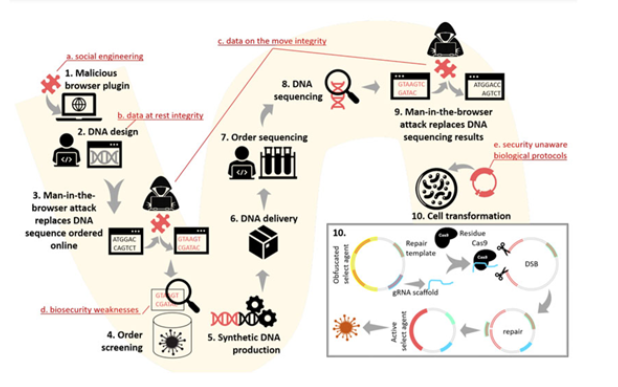
Supra Thermal and Energetic Particle Spectrometer (STEPS)
In News: Recently, one of the seven instruments on board India's first solar mission, Aditya-L1, the Supra Thermal and Energetic Particle Spectrometer (STEPS) sub-system, has started gathering data.
Supra Thermal and Energetic Particle Spectrometer (STEPS):

- It is a component of the Aditya Solar Wind Particle Experiment (ASPEX) payload on India's Aditya-L1 satellite.
- It is designed to measure swiftly moving charged particles produced by solar activities.
- STEPS offers useful information for solar science and space weather studies and aids with the analysis of the behaviour of particles orbiting the Earth.
Aditya L1:
- It was launched on 2nd September, 2023 and has left the Earth’s orbit towards the Earth-Sun System’s Lagrange 1 (L1) point.
- The objective of this mission is to study the Sun, its upper atmospheric dynamics (Chromosphere and Corona), and understand the physics of the Solar Corona and its heating mechanism for 5 years.
- The Polar Satellite Launch Vehicle (PSLV) has been used for its launch.
- Payloads on the satellite:
- Visible Emission Line Coronagraph (VELC)
- Solar Ultraviolet Imaging Telescope (SUIT)
- Solar Low Energy X-Ray Spectrometer (SoLEXS)
- High Energy L1 Orbiting X-Ray Spectrometer (HELIOS)
- Aditya Solar wind Particle Experiment (ASPEX)
- Plasma Analyser Package for Aditya (PAPA)
- Lagrange Points are the equilibrium positions in space where the gravitational forces of two large celestial bodies, like the Earth and the Sun, produce enhanced regions of attraction and repulsion.
- L1 point provides an unobstructed view of the Sun, even during phenomena like an eclipse; allow payloads to directly observe the Sun and makes the mission fuel efficient.

Hypertension - Edukemy Current Affairs
In News: Recently, the World Health Organization (WHO) released its first-ever report on the global impact of high blood pressure (hypertension), stating approximately four in every five are not treated adequately.
About:
- Blood pressure is the force exerted by circulating blood against the walls of the body’s arteries, the major blood vessels in the body.
- Hypertension is when blood pressure is too high.
- It is defined as having a systolic blood pressure level greater than or equal to 140 mmHg or diastolic blood pressure level greater than or equal to 90 mmHg or/and taking anti-hypertensive medication to lower his/her blood pressure.
Key highlights:
- The WHO report states that hypertension affects one in three adults worldwide.
- Hypertension is a significant risk factor for death and disability in India, with less than one-fourth of hypertensive patients having their blood pressure under control during 2016-2020.
- The prevalence of hypertension in India has increased, with 24% of men and 21% of women reported to have hypertension in the 2019–2020 National Family Health Survey (NFHS-5).
- The number of people living with hypertension doubled from 650 million in 1990 to 1.3 billion in 2019, with nearly half of them unaware of their condition. Over three-quarters of adults with hypertension live in low- and middle-income countries.
- The WHO recommends lifestyle changes, such as a healthier diet, tobacco cessation, and increased physical activity, as ways to lower blood pressure.
- However, if countries can expand their coverage of hypertension treatment, it could potentially avert 76 million deaths between 2023 and 2050.
‘Anti-trust’ Law
In News: Recently, Google faced allegations in a U.S. court that it used illegal tactics to maintain a monopoly in an online search.
About
- Antitrust laws are regulations that encourage competition by limiting the market power of any particular firm. This often involves ensuring that mergers and acquisitions don’t overly concentrate market power or form monopolies, as well as breaking up firms that have become monopolies.
- Antitrust laws also prevent multiple firms from colluding or forming a cartel to limit competition through practices such as price fixing. Due to the complexity of deciding what practices will limit competition, antitrust law has become a distinct legal specialization.
- The Sherman Act, the Federal Trade Commission Act, and the Clayton Act are the three pivotal laws in the history of antitrust regulation.
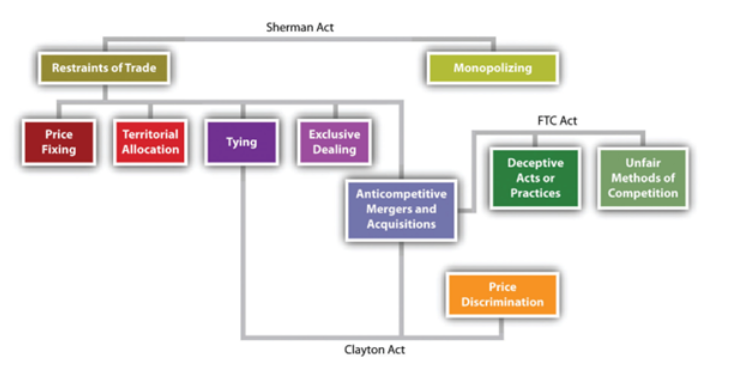
Nipah Virus - Edukemy Current Affairs
In News: Two deaths were reported in Kerala due to the Nipah Virus.
About
- Nipah virus (NiV) is a zoonotic virus (it is transmitted from animals to humans) and can also be transmitted through contaminated food or directly between people.
- In infected people, it causes a range of illnesses from asymptomatic (subclinical) infection to acute respiratory illness and fatal encephalitis.
- The virus can also cause severe disease in animals such as pigs, resulting in significant economic losses for farmers.
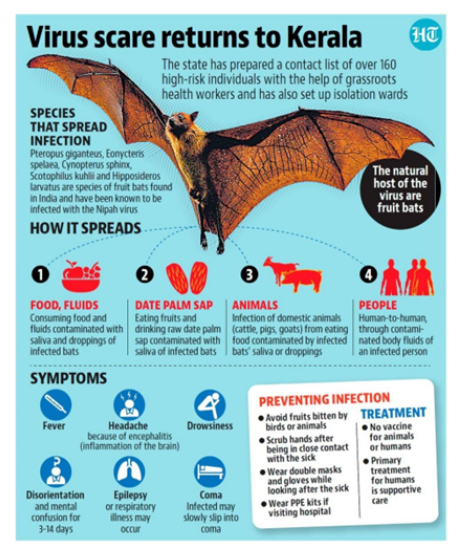
Project SamudraYaan - Edukemy Current Affairs
In News: Indian scientists are preparing for project Samudra Yaan to send three people 6,000 metres underwater beneath the ocean's surface in a domestically developed submersible called Matsya 6000.
About Mission Samudrayaan:
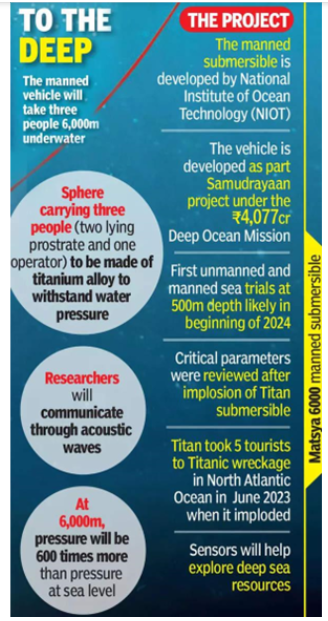
- The Samudrayaan mission is an integral part of the Deep Ocean Mission initiative, with sea trials planned at a depth of 500 meters slated for the first quarter of 2024.
- Only few countries, including the United States, Russia, Japan, France, and China, have successfully developed manned submersibles capable of exploring the depths of the ocean.
- Aim of Samudrayaan mission is primarily focused on exploring the ocean's depths in search of valuable metals and minerals, including cobalt, nickel, and manganese.
- It will also investigate the chemosynthetic biodiversity found in hydrothermal vents and low-temperature methane seeps in the ocean.
About Matsya 6000 Submarine:
- Matsya 6000 has been under development for nearly two years and is scheduled for its inaugural sea trials in the Bay of Bengal off the Chennai coast in early 2024.
- The submersible's design features a 2.1-meter diameter sphere constructed from an 80mm-thick titanium alloy, engineered to withstand the immense pressures at depths of 6,000 meters, which is approximately 600 times greater than sea level pressure.
- It has the capability to operate continuously for 12 to 16 hours, facilitated by a 96-hour oxygen supply.
Genetic engineering to control Mosquitoes
In News: Genetic engineering gives mosquito control an upgrade.
About
- Innovations in genome sequencing technology have granted researchers unprecedented access to mosquito genomes, with a particular focus on Anopheles stephensi, a significant vector in the transmission of malaria.
- Genetic manipulation techniques, such as gene-drive technology, are being utilized to manage mosquito populations by disrupting their reproductive processes.
- Gene-drive technology alters mosquito DNA to reduce their reproductive capabilities or make them sterile, preventing the transmission of diseases like malaria.
- Some technology involves enhancing genes in mosquitoes to produce antimicrobial substances, disrupting disease transmission.
- How technology works? Genetically modified mosquitoes, such as OX5034, have been released in certain areas to reduce mosquito populations, showing promising results in decreasing disease incidence.
- Potential risks of technology: Such as ecological disruptions and unintended consequences in the ecosystem.
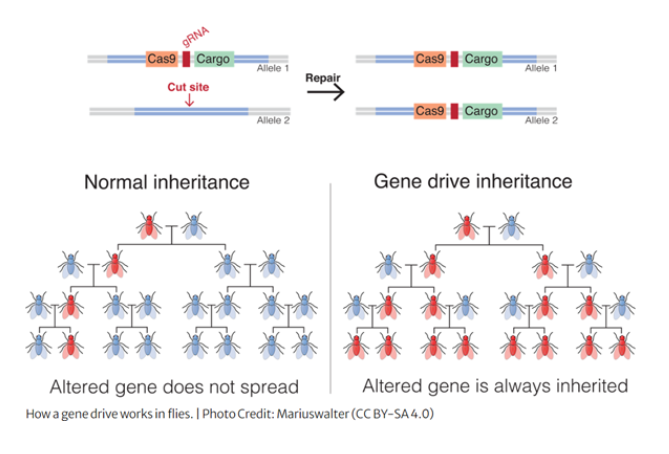
Human embryo - Edukemy Current Affairs
In News: Scientists have successfully grown a “human embryo” in the lab without using an egg or sperm.
About:
- Instead of a sperm and egg, Scientists used a combination of stem cells, which can differentiate into various cell types, and chemicals to create an embryo-like structure that mimics the molecular characteristics of an early human embryo.
- Stem cells as the “master cells” in your body. They are special because they can turn into different types of cells that make up your body, like skin cells, muscle cells, or blood cells.
- The process involved a mixture of stem cells and chemicals, with only 1% of the mixture spontaneously forming different types of cells needed for foetal development, including those providing nutrients, those guiding body development, and cells responsible for structures like the placenta and umbilical cord.
- The embryo models were allowed to grow and develop until they were comparable to an embryo 14 days after fertilization.
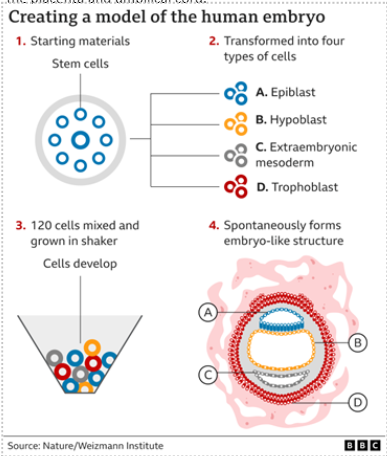
- In many countries, this is the legal cut-off for normal embryo research.
Importance:
- Studying the initial stages is crucial because the majority of miscarriages and birth defects occur during this period.
- Understanding why some embryos develop normally and others do not can enhance IVF success rates and shed light on genetic and inherited diseases.
- Embryo-like models allow scientists to explore genetic, epigenetic, and environmental influences on development.
Limitations
- These lab-grown embryo-like models cannot be used for pregnancy, and they are typically destroyed after 14 days of study, in line with legal and ethical regulations in many countries.
- The 14-day limit on embryo research corresponds to the point when embryos naturally complete implantation and become individuals.
14-day limit on embryo research:
- The limit was first proposed by a committee in the UK in 1979 after the birth of the first test tube baby Louise Brown demonstrated that embryos could be kept alive in laboratories.
Gujarat Declaration - Edukemy Current Affairs
In News: The World Health Organization (WHO) has unveiled the “Gujarat Declaration,” the outcome document of the first WHO Traditional Medicine Global Summit 2023.
About
- Gujarat declaration outlines measures to integrate traditional, complementary, and integrative medicine (TCIM) into national health systems, promote standardized documentation, and establish a global network of TCIM reference clinical centers.
- It also highlights the role of digital health technologies and emphasizes the importance of biodiversity conservation and the rights of indigenous peoples in TCIM.
- The declaration calls for evidence-based TCIM interventions to support universal health coverage and sustainable development goals. It emphasizes standardized documentation and the establishment of TCIM reference clinical centers.
Significance of Gujarat Declaration
- The declaration reaffirms global commitments to indigenous knowledge, biodiversity, and traditional, complementary, and integrative medicine (TCIM).
- It emphasizes the need for rigorous scientific methods to understand, assess, and apply holistic and context-specific approaches to health and well-being.
- It highlights India’s role in advancing these commitments as the host of the WHO Global Traditional Medicine Centre.
Cartesian coordinates - Edukemy Current Affairs
About
- A coordinate system serves as a numerical framework for precisely locating a point within a given space.
- One of the most renowned coordinate systems is the Cartesian coordinates, which employ sets of three numbers to define a point's position relative to three mutually perpendicular planes.
- Cartesian coordinates utilize pairs of numbers (x and y) for two-dimensional spaces and triples of numbers (x, y, and z) for three-dimensional spaces to pinpoint a point's location.
- This innovative system was devised by the 17th-century French philosopher and mathematician René Descartes, effectively bridging the gap between algebra and geometry and giving birth to the field of analytic geometry.
- Cartesian coordinates find extensive applications in various domains such as astronomy, engineering, and computer graphics. They enable the precise representation of spatial data and facilitate the creation of geometric designs.
Largest indigenously developed Nitrogen plant
In News: The third unit of the indigenously developed 700-megawatt electric (MWe) nuclear power reactor at the Kakrapar Atomic Power Project (KAPP3) in Gujarat, has started operations at full capacity.
About:
- The Kakrapar Atomic Power Project (KAPP3) is situated in the Kakrapar in Gujarat, India.
- The plant boasts a total installed capacity of 1,950 MWe, comprising three units, each with a capacity of 700 MWe. KAPP3 represents the third unit of this facility.
- The primary power source employed by the plant is Pressurized Heavy Water Reactors (PHWRs).
- These PHWRs utilize natural uranium as fuel and heavy water as both moderator and coolant.
- KAPP3 is anticipated to generate sufficient electricity to meet the annual power needs of approximately 4 million people. Furthermore, it is poised to contribute to reducing India's reliance on fossil fuels for power generation.
- To ensure safety, the plant is equipped with several key features, including a containment building, a reactor pressure vessel, and a cooling system.
- These features are meticulously designed to prevent the release of radioactive materials in the event of an unforeseen accident.
- The Nuclear Power Corporation of India Limited (NPCIL) is the entity responsible for operating the plant.
- NPCIL is a government-owned enterprise tasked with the development and operation of nuclear power plants throughout India.
More Information:
- This marks a significant achievement in India’s civilian nuclear program, as it is the country’s first 700 MWe unit and represents a scale-up in technology.
- The reactor uses Pressurized Heavy Water Reactor (PHWR) technology and is seen as a milestone in India’s effort to expand its nuclear power capacity to 22,480 MWe by 2031.
- The reactor design also incorporates enhanced safety features, including a Passive Decay Heat Removal System.
Global Fund to slash HIV treatment price.
In News: Recently, The Global Fund has reached an agreement with generic drug manufacturers to significantly reduce the price of an advanced HIV medication called TLD.
About:
- This deal will make TLD available for under $45 per person per year, marking a 25% reduction in price.
TLD
- The TLD pill contains three essential drugs for HIV treatment: tenofovir disoproxil fumarate, lamivudine, and dolutegravir.
- It is a three-in-one pill.
- This combination has been recommended by the World Health Organization as the preferred first-line treatment for HIV in adults and adolescents due to its effectiveness in suppressing the virus, minimal side effects, and ease of use.
- This drug rapidly suppresses the virus that causes AIDS.
- The price reduction of the drug will help resource-limited countries enhance treatment programs, and prevention efforts and ultimately save more lives while reducing new infections.
Global Fund:
- The Global Fund is an international financing and partnership organization.
- It was created in 2002 and its secretariat is located in Geneva, Switzerland.
- The Global Fund was established to raise and disburse funding for programs that reduce the impact of HIV/AIDS, tuberculosis, and malaria in low- and middle-income countries.
- The Global Fund raises and invests $4 billion a year to fight these diseases.
- The majority of the Global Fund’s financial support comes from public resources.
- More than 80 countries have made or pledged contributions to the Global Fund.
- India joined the Global Fund as a donor in 2006 and pledged US$25 million for the Global Fund’s Seventh Replenishment, covering 2023-2025.
Nabhmitra - Edukemy Current Affairs
Why in the news? Recently, ISRO-Space Applications Centre (Ahmedabad) has successfully tested a device called ‘Nabhmitra’.
About:

- This device uses satellite communication to allow two-way messaging between boats at sea and authorities on land.
- This device is aimed at enhancing the safety of fishermen.
- The system can convey weather alerts, cyclone warnings, and other information in the local language.
- In cases of emergencies like boat accidents or fires, fishermen can activate the device to alert the control centre. The control centre receives the boat’s location, and the crew onboard gets a response from the control centre.
- Apart from providing information about shipping channels and maritime boundaries, the device will also help to identify fishing fields.
Mysteries of the Y chromosome - Edukemy Current Affairs
In News: Scientists have finally decoded one of the smallest chromosomes in humans, the male sex chromosome (Y- Chromosome), 20 years after the first draft of its DNA code was published. The work reveals a complete catalogue of the genes in the male sex chromosome and how they're organised.
About the Chromosomes:
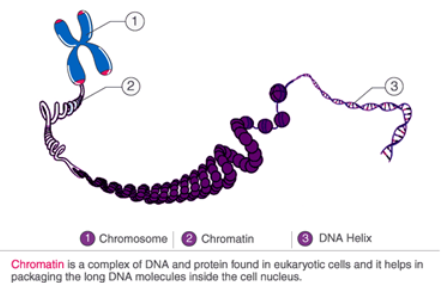
- In the nucleus of each cell, the DNA molecule is packaged into thread-like structures called chromosomes. Each chromosome is made up of DNA tightly coiled many times around proteins called histones that support its structure.
- DNA is a long molecule that contains our unique genetic code. DNA is composed of two strands that wrap around each other to form a double helix shape.
- Humans have 22 pairs of numbered chromosomes (autosomes) and 1 pair of sex chromosomes (XX or XY). Each pair contains two chromosomes, one coming from each parent, i.e. half of the children’ chromosomes are from their mother and a half from their father.
Major findings about the Y-Chromosomes:
- The findings show that the Y chromosome evolved to have extensive variation in its size and structure among individuals.
- The Y chromosome is important for the development of male sex characteristics. It carries the sex-determining region Y (SRY) gene, which codes for a protein that promotes the development of the testicles and blocks the development of female organs such as uterus and fallopian tubes.
- Y-Chromosome contains 62,460,029 base pairs of DNA. It is 30 million more than the most current reference genome.
- They also identified 41 new protein-coding genes and provided insight into noncoding regions known as satellite DNA, which don't carry blueprints for proteins.
- The team explained that the Y chromosome contains the largest block of condensed, noncoding DNA known as heterochromatin. This region is made up mainly of two repetitive DNA sequences, appearing in the same 1-to-1 ratio throughout the terms of the number of times they were found in the chromosome.
- Assembling complete sequences of 43 Y chromosomes across space and time not only helps in investigating sex chromosome’s evolution but also human evolution more generally.
Use of Technology in Agriculture
In News: G20 to support digital agriculture ecosystem.
About
Digital Agriculture encompasses the utilization of Information and Communication Technologies (ICT) and data ecosystems to deliver timely and tailored information and services, aimed at improving the profitability, sustainability, and efficiency of agricultural practices.
Digital agriculture Includes:
- Agricultural Biotechnology: Such as the creation of microorganisms for precise agricultural applications.
- Precision Agriculture (PA): Relies on ICT to optimize the allocation of resources.
- Digital and Wireless Technologies: Including systems for monitoring weather, robotics, drones, and various wireless devices.

Benefits of Digital Agriculture:
- Enhances agricultural productivity: Leveraging digital tools and data-driven insights can result in improved crop management, ultimately optimizing yields and overall production.
- Mitigates soil degradation: Precision farming techniques have the potential to reduce soil erosion and nutrient loss, safeguarding the health of the soil.
- Reduces chemical usage in crop production: By precisely applying inputs like fertilizers and pesticides, digital agriculture can minimize its environmental footprint.
- Optimizes water resource utilization: Digital sensors and data play a crucial role in precise irrigation, reducing water wastage and enhancing overall water efficiency.
- Promotes modern farming practices: The dissemination of information through digital platforms empowers farmers to adopt cutting-edge practices and innovations.
- Elevates the socio-economic status of farmers: Enhanced productivity and reduced costs can lead to improved income and livelihoods for farmers, positively impacting their socio-economic well-being.
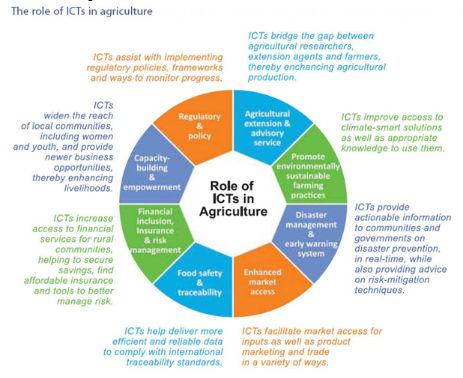
Government Initiative:
- AgriStack: An assemblage of technology-driven interventions in agriculture designed to offer comprehensive services throughout the entire agricultural and food value chain.
- Support for Startups: India currently boasts a thriving ecosystem of more than 1,000 agri-tech startups that play a pivotal role in providing inventive solutions to address various challenges within the agricultural value chain.
- Digital Agriculture Mission: A government initiative focused on implementing projects utilizing cutting-edge technologies such as AI, blockchain, remote sensing, drones, and robots to propel advancements in the field of agriculture.
- Unified Farmer Service Platform (UFSP): A platform that facilitates seamless interoperability among information technology systems within the agriculture sector, thereby enhancing the delivery of services to farmers.
- National e-Governance Plan in Agriculture (NeGPA): A program leveraging information and communication technology to provide timely access to agriculture-related information, including platforms like Farmers Portal and mkisan, which offer valuable advisories and support.
- Strengthening/Promoting Agricultural Information System (AGRISNET): A scheme aimed at bolstering the IT infrastructure of the Agriculture Department and improving information dissemination through platforms such as mkisan.
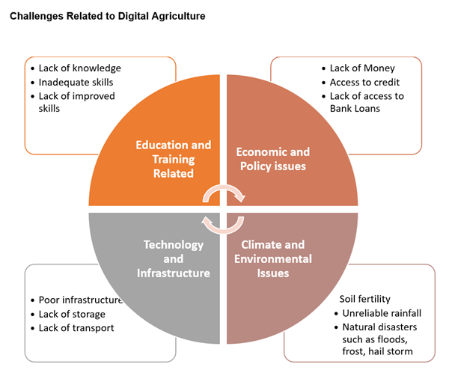
National Space Day - Edukemy Current Affairs
In News: Recently, The Prime Minister visited the ISRO Telemetry Tracking and Command Network (ISTRAC) in Bengaluru and addressed the ISRO team about the success of Chandrayaan-3.
About:
- Prime Minister Narendra Modi commended ISRO scientists for inspiring a generation and creating a lasting impression on children’s brains.
- He announced that August 23rd will be observed as ‘National Space Day’ to celebrate science, technology, and innovation.
- The Prime Minister celebrated the achievement of Chandrayaan-3 as a significant scientific milestone that demonstrates India’s prowess in space exploration.
- He also announced that the point of Chandrayaan-3’s landing would be known as ‘Shiv Shakti.’
- According to experts, India’s space sector would grow to $16 billion in a few years from $8 billion, said PM Modi.
- He acknowledged the contribution of women scientists and referred to the Chandrayaan-2 landing site as ‘Tiranga,’ highlighting its significance in inspiring efforts and overcoming failures.
- He emphasized the role of space technology in governance, linking it to initiatives like Swachh Bharat Abhiyan, education, healthcare, and disaster management.
- He encouraged ISRO to organize hackathons on ‘Space Technology in Governance’ to make governance more effective.
Somatic Genetic Variants - Edukemy Current Affairs
In News: Scientists have known of somatic variants for many years, but recently advances in genome sequencing unveil the impact of somatic genetic variants on human health, from cancer development to immune disorders, driving innovation in disease detection and treatment strategies.
Somatic Genetic Variants or Somatic Mutation:
- It refers to alterations in the DNA sequence that occur specifically within the cells of an individual's body (somatic cells), excluding the germline cells (sperm and egg cells).
- Somatic genetic mutations occur after birth during development and are not inherited from parents.
- Somatic mutations can occur for various reasons, such as errors during DNA replication, exposure to environmental factors (like radiation or chemicals).
Impacts of Somatic Mutation on Human Health:
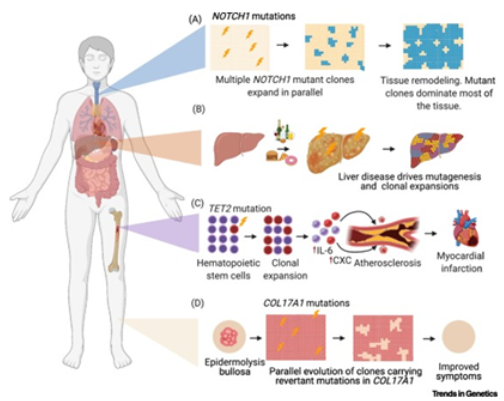
- Cancer Development: Somatic genetic variants can drive the uncontrolled cell growth and division characteristic of cancer, leading to tumour formation.
- Neurological Disorders: Accumulated somatic mutations in brain cells can contribute to neurological conditions, affecting cognitive and motor functions.
- Aging and Tissue Function: Gradual accumulation of somatic mutations with age can impair tissue function and contribute to age-related diseases.
- Immune System Dysfunction: Somatic variants can disrupt immune cell development and function, leading to autoimmune disorders and immunodeficiencies.
Potential Utilization of Somatic Genetic Variants:
- Early Detection of Diseases: Somatic variants can serve as diagnostic and prognostic markers for diseases in a very early stage.
- Personalized Treatment Plans: Knowledge of an individual's somatic mutations allows personalized treatment plans.
- Healthier Aging: Studying somatic mutations associated with aging can shed light on the aging process and age-related diseases, potentially leading to interventions for healthier aging.
Medical Textiles - Edukemy Current Affairs
In News: Recently, the Ministry of Textiles organized the ‘Meditex 2023’ International Conference on Scope and Opportunities in Medical Textiles.
About
- Medical textile is a result of the combination of textile technology and medical science known as Medical textiles or Med-tech.
- Some examples of medical textiles are hygienic materials hospital bed sheets, curtains surgical masks, gowns, etc.
- Medical textiles are used in operation theaters, even surgical threads, bandages, artificial bones, ligaments, artificial kidneys, and livers, there are touches of technological and smart textiles everywhere.
Features of Medical Textiles
- Textile materials must be non-toxic.
- Must be resistant to allergens and cancer.
- Textile materials must be biologically compatible.
- Complete good dimensional stability.
- It has air permeability and waterproofing properties.
- Resistant to acid and alkali.
- The quality of the fabric should be good.
- Re-wash and reusable.
Types of Fibers Used in Medical Textiles
Commodity Fiber:
- Natural and Regenerated Fibers: Cotton, Silk, Wood Pulp, Viscose.
- Synthetic fibers: polyester polypropylene, polyethylene, polyamide, PTFA, carbon, glass, silica.
Specialty Fiber:
- Collagen, calcium alginate, chitin, chitosan.
Natural Polyphenols to Combat Alzheimer’s Disease
In News: Potential treatment route for Alzheimer's disease found in natural polyphenol
About
- Naturally occurring plant-based polyphenols (PPs) like tannic acid found in twigs of trees like Chestnut and Oak can modulate the ferroptosis- Alzheimer’s Disease axis to yield a safe, cost-effective strategy for combating Alzheimer’s disease (AD) and reduce the societal burden of this debilitating neurodegenerative disorder.
- Ferroptosis, an iron-dependent form of programmed cell death, has emerged as a significant contributor to the development of AD. Several hallmarks of AD, such as abnormal iron build up, lipid peroxidation, reactive oxygen species (ROS), and reduced activity of the antioxidant enzyme glutathione peroxidase 4 (GPX4), align with the characteristics of ferroptosis.
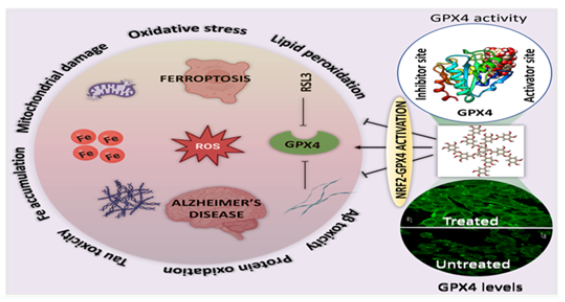
Newspapers for handling food - Edukemy Current Affairs
In News: Recently, the Food Safety and Standards Authority of India (FSSAI) has urged consumers and food vendors to stop using newspapers for packing, serving, and storing food due to health hazards.
Harmful impacts of using Newspapers for handling food:
- The Food Safety and Standards (Packaging) Regulations, 2018, restrict the use of newspapers or similar materials for food storage or packaging.
- Newspapers' ink contains bioactive substances that can contaminate food and be hazardous to human health.
- Additionally, pollutants like mineral oils and chemicals may be present in recycled paper boxes, which might lead to harmful effects and digestive issues.
- Chemicals from printing inks, such as lead and heavy metals, have been shown to contaminate food.
- During distribution, newspapers are exposed to a variety of environmental factors, rendering them vulnerable to bacterial or virus contamination.
- When consumed, contaminants from newspapers can cause foodborne diseases. Food packaged in such materials puts vulnerable populations, such as the elderly and those with compromised immune systems, at higher risk of developing cancer-related health problems.
Food Safety and Standards Authority of India (FSSAI):
- Food Safety and Standards Authority of India (FSSAI) is an autonomous statutory body established under the Food Safety and Standards Act, 2006 (FSS Act).
- It comes under the Ministry of Health & Family Welfare, Government of India.
- Headquarters: Delhi.
- Key functions of FSSAI:
- Set standards for food products
- Develop safe food practices
- License food businesses
- Ensure compliance through inspections
- Test food for standards
- Train and build capacity
- Citizens Outreach
- Structure of FSSAI:
- The FSSAI comprises of a Chairperson and twenty-two members out of which one – third are to be women.
- The Chairperson of FSSAI is appointed by the Central Government.
- The Food Authority is assisted by Scientific Committees and Panels in setting standards and the Central Advisory Committee in coordinating with enforcement agencies.
- The primary responsibility for enforcement is largely with the State Food Safety Commissioners.
- Challenges with FSSAI:
- The “petty manufacturers, retailers and hawkers” are exempted from FSSAI ambit.
- Lack of infrastructure such as food testing laboratories.
- Shortage of qualified manpower and functional food testing equipment in state food laboratories and referral laboratories resulted in deficient testing of food samples.
- Acute shortage of licensing and enforcement officers in the states.
- The body has been only prescriptive in nature and failed to ensure safety, quality and hygiene in food industry.
Society & Social Justice
India Elderly to Make Up 20% of Population by 2050-UNFPA Report
In News: According to United Nations Population Fund’s, “2023 India Ageing Report”, the percentage of elderly population in the country is projected to double to over 20% of total population by 2050 with a “predominance of widowed and highly dependent very old women”.
About the UNFPA report:
- United Nations Population Fund (UNFPA) is a UN agency dedicated to enhancing global reproductive and maternal health. It published a report “2023 India Ageing Report” projecting India's age composition in coming decades.
- The report used data from the 2011 Census, the 2017-18 Longitudinal Ageing Survey in India, population projections of the Government of India and World Population Projection 2022 report
- The report can be used as an important resource for scholars, policymakers, program managers, and all stakeholders involved in elder care.
Key Findings of the Report:
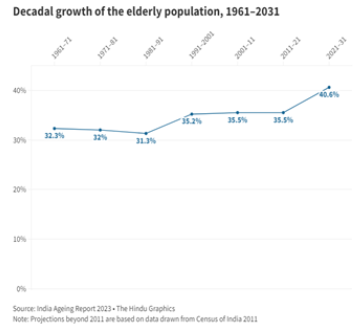
- Doubling of the elderly population: The decadal growth rate of the elderly population of India is currently 41%. Thus elderly population is projected to double to over 20% of the total population by 2050.
- Elderly to surpass Children population: It is being estimated that by 2046 elderly population will have surpassed the population of children (aged 0 to 15 years) in the country.
- Poverty among elderly: More than 40% of the elderly in India are in the poorest wealth quintile, with about 18.7% of them living without an income which affects their quality of life and healthcare utilization.
- Increase in the 80+ population is projected to grow at a rate of around 279% between 2022 and 2050 with a “predominance of widowed and highly dependent very old women”.
- Higher life expectancy of Women: Women, on average, had higher life expectancy at the age of 60 and at 80, when compared to men.
- Regional variation: Life expectancy of women and sex ratio among elderly varies across states and Union Territories.
- Life expectancy of women at 60 years is greater than 20 years in States such as Rajasthan, Haryana, Gujarat, Uttarakhand, Kerala, Himachal Pradesh etc. raising concerns about their social and economic well-being,
- Sex ratio among the elderly has been climbing steadily since 1991, with the ratio in the general population stagnating. In Central India, sex ratio (>60 years population) went from 973 in 2011 to 1,053 in 2021.
- Old-age dependency ratio i.e. elderly people per 100 people between 15 and 59 years, was higher in Southern India, than the national average at around 20 as is true of Western India at 17.
Implication of aging population:
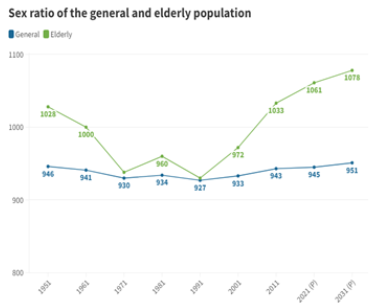
- Increased pressure on social security systems: The elderly population is more likely to be dependent on social security systems, such as pensions and healthcare.
- Increased burden on families: The elderly population is more likely to live with their families, which can put a strain on financial and emotional resources.
- Decreased workforce participation: The ageing population will lead to a decrease in the workforce participation rate.
- Increased healthcare costs: The elderly population is more likely to need healthcare, which can increase healthcare costs.
- Inherently gendered poverty: Poverty is inherently gendered in old age when older women are more likely to be widowed, living alone, with no income, and with fewer assets of their own.
- Feminisation and Ruralisation of older population
- , and policies must be framed accordingly; data show that women, on an average, have a higher life expectancy at the age of 60 and 80 when compared with men.
Recommendation of the report:
- Focus on elderly in disaster-preparedness plans: Elderlies received inadequate support from the government during COVID-19. Public healthcare facilities were not accessible and nobody except NGOs or community-based organisations helped them. Thus policies and plans are required to focus on the needs of the elderly.
- Collection of credible data related to the elderly in India could be done by including questions on relevant issues related to older persons in the upcoming National Sample Survey, the National Family Health Survey, and the Census of India.
- Increasing awareness about government schemes: The report suggested that the government must work on increasing awareness about schemes for older persons, bring all Old Age Homes under regulatory purview, and focus on facilitating in-situ ageing to the extent possible.
- Promoting elderly self-help groups: Government needs to encourage the creation and running of elderly SGHs, and promote elderly people living in multigenerational households.
- Promote in situ aging: Government should encourage in situ (at home) ageing by creating short-term care facilities like creches or day-care facilities.
Suicide Clusters in India - Edukemy Current Affairs
In News: The suicide cluster in Kota is being referred to as a public health emergency. The total suicide victims in 2023 alone has touched up to 26 in Kota.
About Suicides in India:
- Suicide is a deliberate act of self-harm that leads to death. It is a complex issue with many contributing factors, including mental illness, substance abuse, relationship problems, and financial hardship.
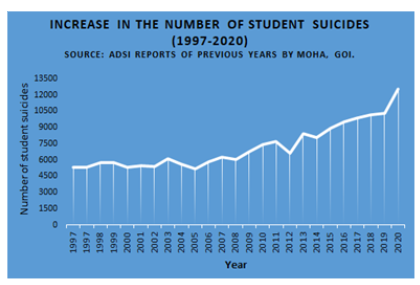
- There has been a rising trend in number of suicides in India. The city of Kota in Rajasthan, has witnessed a notable rise in suicides, particularly among students preparing for examinations making it a suicide cluster.
- US’s Centres for Disease Control and Prevention defines a suicide cluster as a group of suicides, suicide attempts, or self-harm events that occur closer together in time and space than would normally be expected in a given community.
Emergence of Kota as suicide cluster:
- Point cluster: The situation in Kota is identified as a suicide cluster, specifically a point cluster, where suicides are occurring closer together in time and space than otherwise.
- Contagion effect could also be witnessed where one person’s suicide, due to its circumstances and the publicity around it, triggers the risk of suicidal ideation, suicide attempts and/or deaths by suicide in others who are already vulnerable to suicidal thoughts, leading to suicide clusters.
- Suicides throughout the preparation duration: Suicide cluster in Kota are different in terms that these events are occurring not at a specific point in time, but through the year in preparation for examinations.
Reasons for rising Suicide incidences:
- Academic pressure: Students preparing for competitive examinations face immense academic pressure. This pressure can be overwhelming, especially for students who are not coping well academically.
- Parental expectations: Many parents have high expectations for their children, especially when it comes to academics. This pressure can be a major source of stress for students.
- Competitive environment: The competitive environment in Kota is very intense. This can lead to feelings of anxiety and depression, especially for students who are not able to keep up with the pace.
- Homesickness: Many students who come to Kota are from other parts of India. They may feel homesick, lonely and can lead to feelings of isolation and despair.
- Lack of mental health support: There is a lack of mental health support available to students in Kota. Many students are not aware of the resources that are available to them, or they are reluctant to seek help due to stigma.
Initiatives by government to tackle suicides:

- National Suicide Prevention Strategy (NSPS): India introduced the NSPS, aiming to decrease suicides by 10% by 2030.
- Suicide Surveillance Systems: A key target of NSPS is to establish effective suicide surveillance systems within the next three years.
- Mental Health Outpatient Clinics: Another goal under the NSPS is to set up mental health outpatient clinics providing suicide prevention services. This will be achieved under the District Mental Health Programme and is slated for completion within five years.
- Helplines numbers by States: States such as Telangana, Kerala, Andhra Pradesh, Karnataka, and Tamil Nadu have launched helplines for suicide prevention, particularly during the announcement of school leaving and entrance examination results.
- Decriminalization of Suicides: The Mental Healthcare Act (MHCA), 2017, significantly reduced the scope for the use of Section 309 IPC which criminalizes attempt to commit suicide. It made the attempt to commit suicide punishable only as an exception.
Way Forward:
- De-stigmatization: Despite several measures there has been a steady rise in number of suicides in India. Need of the time is to de-stigmatize the discussion around suicides and motivate the distressed to seek help.
- Media Responsibility: Encourage media to report responsibly on suicides to prevent contagion.
- Focus on Prevention strategies to reduce the risk of further suicides need to be implemented.
- Adopt Successful Models: Adopting approaches like the Tomorrow Project in Nottingham, UK, which has successfully halted suicide contagion through community information, meetings, and clinical support.
Identity and Marginality in Northeast India
In News: The Northeast region of India is home to numerous ethnic communities who have migrated from different regions. The tendency of conceptualising the region as a single homogenous territory is problematic.
About the Northeast region:
- The Northeast region comprises the States of Arunachal Pradesh, Assam, Manipur, Meghalaya, Mizoram, Nagaland, Sikkim and Tripura.
- The region has a diverse milieu of population, however the majority of them belong to the Indo-Chinese Mongoloid racial grouping.
- The region is as diverse as India itself in terms of linguistic, cultural and ethnic representation.
Northeast: Not a single homogenous entity:
- Ethnic diversity: According to the 2011 Census of India, the Northeast region is home to over 200 ethnic groups. The largest ethnic group in the region is the Assamese, followed by the Meiteis, Nagas, Bodos, Tripuris, and Mizos.
- Linguistic diversity: The Northeast region is home to over 120 languages. The most widely spoken languages in the region are Assamese, Bengali, Meitei, Nagamese, and Nepali.
- Cultural diversity: The Northeast region is home to a variety of cultures, each with its own unique traditions and festivals. Some of the most popular festivals in the region include the Hornbill Festival (Nagaland), the Bihu Festival (Assam), and the Sohra Festival (Meghalaya).
- Religious diversity: The Northeast region is home to a variety of religions, including Hinduism, Christianity, Buddhism, and Islam. Northeast India has a major cluster of followers of Christianity.
- Historical diversity: The Northeast region has a long and complex history, with each ethnic group having its own unique history and traditions. The region has been influenced by a variety of cultures, including those of China, Myanmar, and Bangladesh.
- Colonial conceptualisation of the region: The homogenous construction of Northeast was developed by British colonists for administrative ease.
Social Reality of Northeast Region:
- Elements of Heterogeneity: The region of Northeast has several elements of heterogeneity based on experiences, contestations and conflicts of different groups.
- Multidimensional issues affecting the society: Social realities of Northeast are influenced by several factors such as indigeneity, policy, economy, migration, land rights, insurgency, militarisation, state violence and laws like AFSPA (Armed Forces Special Powers Act), reservation etc.
- Marginalisation: People from the Northeast region often experience marginalisation and discrimination in other parts of India. This is due to a number of factors, including racism, prejudice, and lack of understanding of the region's unique culture and history.
- Violence: The Northeast region has a long history of violence, both internal and external. This violence has caused immense suffering and displacement, and it continues to impact the lives of many people in the region today.
- Displacement and Land alienation: Displacement is a major challenge in the Northeast region. This is due to a number of factors, including violence, conflict, and natural disasters. Displaced people often face significant challenges, including access to food, shelter, and healthcare.
Condition of Women in Conflict ridden regions:
- Consequences of displacements: Conflict ridden areas have seen large scale displacement which impacts health, food, livelihood and economic security, and the long road to rehabilitation.
- Women as sole Breadwinners: Displaced households have witnessed women shouldering the entire responsibility of the family. Women became the primary breadwinners due to forced displacement, and/or death of their husbands or other male members of the family.
- Health Challenges: Women in conflict zones face a number of health challenges, including malnutrition, post-traumatic stress, and communicable diseases. These challenges are due to factors such as poverty, congested living conditions, lack of awareness, and inadequate healthcare services.
- Marginalisation within marginalised groups: Tribal bodies of Nagaland, which elected its first two women MLAs this year, are opposing 33% reservation for women which they claim will infringe on Naga customary laws protected by the Constitution.
- Pseudo matriarchy: Popular narratives glorifying the matriarchal structure in Khasi society, in reality are only matrilineal with the power resting with maternal male members, and thus inherently patriarchal.

Measuring Hunger Across States
In News: An India-specific hunger index at the level of States and Union Territories helps evaluate the extent of undernourishment at a more localised scale.
About Hunger
Hunger is an uncomfortable or painful physical sensation caused by insufficient consumption of dietary energy. It becomes chronic when the person does not consume a sufficient amount of calories (dietary energy) on a regular basis to lead a normal, active and healthy life.
FAO has used the Prevalence of Undernourishment indicator to estimate the extent of hunger in the world, thus “hunger” may also be referred to as undernourishment.
Status of India on Hunger:
- Despite being a major food producer with extensive food security initiatives, India grapples with significant challenges related to food insecurity, hunger, and child malnutrition.
- According to the 2022 Global Hunger Index (GHI), India ranked 107th among 121 countries, trailing behind Nigeria and Pakistan.
- The GHI is a comprehensive assessment that measures various aspects of undernourishment and hunger at the national level, encompassing factors such as calorie deficiency, child malnutrition, and under-five mortality.
- Over the past five years, India's GHI score has worsened, primarily attributed to the increasing prevalence of calorie undernourishment.
- Child malnutrition is a pressing issue in India, characterized by high rates of stunted growth, underweight children, and wasting.
- The 2022 State of Food Security and Nutrition in the World report highlighted that India has over 224 million undernourished individuals, which equates to more than 22 crore people, with significant disparities observed among different states.
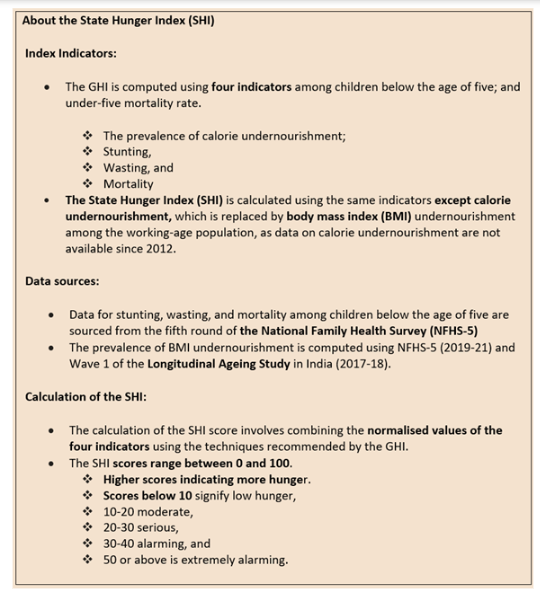
Performance of states in Hunger Index:
- Alarming Hunger: Bihar, Jharkhand, and Chhattisgarh scored 35 on the State Hunger Index (SHI), placing them in the 'alarming' category.
- States Above National Average: Gujarat, Uttar Pradesh, Assam, Odisha, Madhya Pradesh, Tripura, Maharashtra, and West Bengal all scored above the national average, which is 29. These states' performance is akin to that of some African nations like Haiti, Niger, Liberia, and Sierra Leone.
- Moderate Hunger: Chandigarh scored 12, while Sikkim, Puducherry, and Kerala all scored below 16. These states, along with Manipur, Mizoram, Punjab, Delhi, Arunachal Pradesh, Andaman and Nicobar Islands, and Tamil Nadu, are categorized under 'moderate hunger.'
- Serious Hunger: All other states that scored below the national average but above 20 are dealing with 'serious hunger' issues.
- Low Hunger: There are no states in the 'low hunger' category.
Issues Related to the Hunger Index
- Data and Methodology Concerns: The Indian government disputes the GHI findings and raises concerns about the data and methodology used in its calculation. This dispute highlights the need for transparency and consensus in measuring hunger and undernourishment.
- Lack of National Sample Survey (NSS) Data: The absence of recent National Sample Survey data on nutritional intake since 2011-12 is a critical issue. Reliable and up-to-date data is essential for accurately assessing the nutritional status of the population and addressing hunger effectively.
- Climate Change and Food Insecurity: India is vulnerable to the impacts of climate change and extreme weather events, which pose significant threats to the country's food system and poverty alleviation efforts. These shocks can potentially reverse the gains made in poverty reduction and exacerbate food insecurity.
- Non-Communicable Diseases: India is experiencing a rising burden of non-communicable diseases, particularly among the middle class. These diseases are strongly linked to diet and nutrition. Addressing nutrition and dietary patterns is crucial in mitigating the health risks associated with non-communicable diseases and improving overall well-being.
First UN guidance on Children’s Rights and Environment
In News: In a recent directive called General Comment No. 26, the United Nations officially acknowledged and reinforced the rights of children to a clean, healthy, and sustainable environment.
Key Highlights of UN Guidelines on Children’s Rights and the Environment:
- Protection against environmental damages: The UN member states have to take measures to protect children harms caused by environmental degradation and climate change.
- Energy transition: Nations have been urged to equitably phase out the use of coal, oil and natural gas. Ensure a fair and just transition of energy sources and invest in renewable energy, energy storage and energy efficiency to address the climate crisis.
- Inclusive early warning systems: Priority of all nations to establish them to protect children from impacts of the extreme weather events.
- Grants for children rights: Developed countries have been urged to offer grants instead of loans to address issues affecting children’s rights.
- Effective Emissions reductions: The nations have been asked to prioritize emissions reductions to support children’s full enjoyment of their rights in the shortest possible period of time and to avoid irreversible damage to nature. According to UNICEF estimates, reducing carbon emissions can prevent 4,000 to 6,000 child deaths due to heat in Africa every year.
- Mitigating climate change-induced migration: Adaptation frameworks should address climate change-induced displacement and include provisions for ensuring a child rights-based approach to these issues. In 2022, extreme weather events around the world displaced at least 12 million children.
Need for the UN Guidelines on Children’s Rights and the Environment:
- As per WHO-UNICEF-Lancet 2020 report, the future of children around the world, including India, is being threatened by environmental degradation and climate change.
- Water crisis: Approximately 415 million children are living in areas of high or extremely high-water vulnerability. In these regions, risks of drought, groundwater table decline, water stress, annual and inter-annual seasonal variability intersect with low levels of access to water services.
- Health crisis: Children are particularly vulnerable to extreme heat waves, as they have a reduced capacity to regulate their body temperature and protect themselves. Nearly 90 per cent of the global burden of disease associated with climate change is borne by children under five.
- Nutrition crisis: With increasing frequency and severity of droughts, floods and severe weather, food security gets compromised threatening the nutrition of children. According to UN estimates, by 2030, climate change is expected to generate 95,000 more deaths of children under five years of age each year due to malnutrition.
- Education crisis: Climate change and environmental degradation affects children’s ability to go to school, through its impact on health and well-being of both students as well as teachers.
- Social protection crisis: Climate change strains the systems to accommodate the needs of the most vulnerable.
- Climate-related migration: The 2020 Global Trends report by United Nations High Commissioner for Refugees (UNHCR) revealed that out of the 79.5 million people displaced by the end of 2019, around 30-34 million were children.
Initiatives for promoting disability rights
In News: The Department of Empowerment of Persons with Disabilities (DEPwD) in India has embarked on a transformative journey.
About
The Department of Empowerment of Persons with Disabilities (DEPwD) in India is on a path of profound transformation. In its unwavering commitment to fostering a more inclusive society, DEPwD has established crucial collaborations and introduced pioneering programs to catalyze enduring societal change.
DEPwD's five initiatives encompass a range of groundbreaking actions:
- MOU with Council of Architecture: The department collaborates with the Council of Architecture (COA) to mandate universal accessibility courses in Bachelor of Architecture programs. This partnership extends to developing a certified course for architects and civil engineers to conduct accessibility audits in built environments, ensuring compliance with accessibility standards.
- Releasing of Anonymous Data of UDID: DEPwD's release of anonymous data through the UDID portal for research purposes facilitates data-driven decision-making in the disability sector, offering insights at various levels to enhance understanding and inform targeted interventions.
- PM Daksh Portal: PM Daksh Portal is a comprehensive digital platform for Persons with Disabilities seeking training and employment opportunities, offering seamless registration, skill training options, job listings, and streamlined administrative processes.
- Pathways to Access: Courts on Disability Rights: Judgments from India's Supreme Court and High Courts on disability rights have been compiled into a booklet, providing a reference guide for persons with disabilities and stakeholders in the disability sector.
- Online Case Monitoring Portal by CCPD: The Chief Commissioner for Persons with Disabilities adopts a cutting-edge application for handling grievances filed by persons with disabilities, making the entire process paperless and efficient, featuring seamless online complaint filing, automated reminders, and simplified hearing scheduling.
Paryushan 2023 - Edukemy Current Affairs
In News: Recently, Paryushan Parva 2023 has been celebrated by the Jain community.
About:
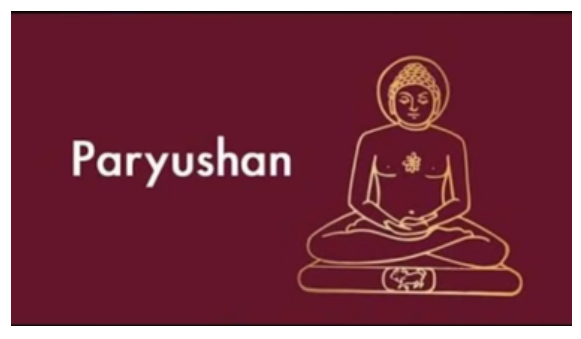
- Paryushan is one of the most important festivals of Jain community people.
- Digambar and Shwetambar both celebrate this festival with great enthusiasm and happiness.
- It takes place in the month of Bhadrapada (August or September in the Gregorian calendar) of the Jain calendar.
- The festival is believed to have originated in the 6th century BC when the Jain teacher Mahavira taught his followers to abstain from violence and to focus on spiritual purity.
- During this auspicious festival, people encourage each other to follow the path of spirituality. This festival is also known as the festival of forgiveness.
Significance:
- For both Shvetambara, who observe the ritual over eight days, and Digambars, for whom the festival lasts 10 days, this is a time for introspection, reflection, and purification.
- It is a time for spiritual growth, with fasting, meditation, and purification rituals. Devotees attend speeches, practice non-violence, and seek forgiveness for their sins.
- Five Duties of Paryushan include Samvatsari (forgiveness and reconciliation), Keshlochan (introspection and self-improvement), Pratikraman (seeking forgiveness for past wrongdoings), Penance (commitment to spiritual growth), and self-criticism and apology for past mistakes.
Santiniketan - Edukemy Current Affairs
In News: Recently, Rabindranath Tagore’s Santiniketan was declared as a Unesco World Heritage.
About
- The UNESCO World Heritage designation acknowledges the cultural and educational significance of Santiniketan, preserving its unique architectural heritage and raising global awareness of Rabindranath Tagore's legacy.
- Santiniketan had its origins as an ashram established by Debendranath Tagore, the father of Rabindranath Tagore, with the vision of creating a sanctuary for meditation and fostering unity among people, regardless of their caste or creed.
- The architectural style of Santiniketan represents a departure from the British colonial and European modernist influences of the early 20th century.
- It draws inspiration from ancient, medieval, and folk traditions across Asia, embracing a form of pan-Asian modernity.
- Architectural structures of Santiniketan, dating back to the 19th century, bear historical significance in the founding of Santiniketan and its association with the universal spirit, symbolizing a revival of religious ideals in Bengal and India.
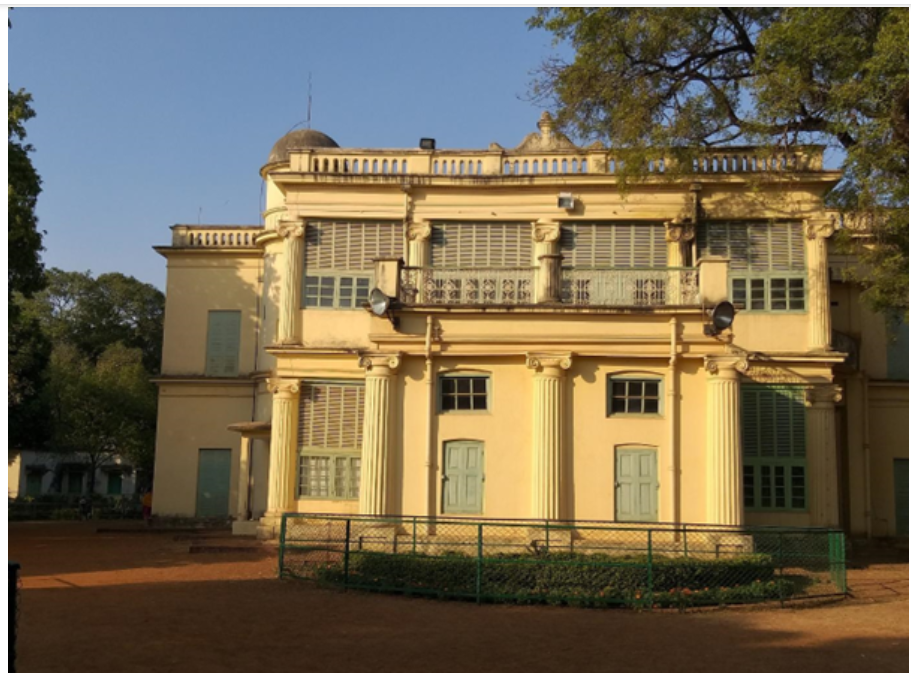
Gifts of Indian Cultural Tradition to G-20 Leaders

Moodbidri - Edukemy Current Affairs
In News: Ancient terracotta figurines found during archaeological explorations at megalithic dolmen site near Moodbidri.
About archaeological Finding
- Recent archaeological excavations near Moodbidri in the Dakshina Kannada district have yielded a remarkable find related to the Megalithic Dolmen site.
- This discovery comprises a collection of unique terracotta figurines that offer valuable insights into the study of the Bhoota cult or Daiva Aradhane. These figurines have been determined to date back to the period of 800-700 B.C.
- The assortment of figurines discovered in this excavation includes depictions of various subjects, such as cow bovines, a mother goddess, peacocks, a horse, and more.
- These findings provide a fascinating glimpse into the cultural and religious practices of the ancient inhabitants of the region.
About Moodbidri
- Moodbidri, located in the Dakshina Kannada district of Karnataka, is a town and taluk situated 34 kilometers northeast of the district headquarters, Mangalore.
- The name "Moodbidri" is derived from the presence of abundant bamboo in the area during ancient times, reflecting its historical significance and the natural resources that once thrived there.
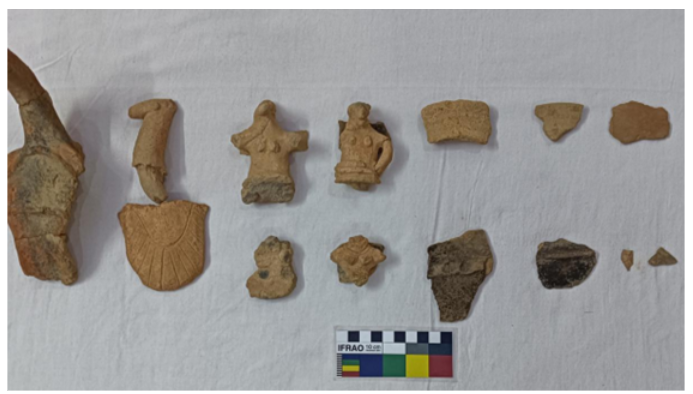
Maritime trade route between India and Europe
In News: The India-Middle East-Europe Economic Corridor, announced at the G20 Summit, traces its historical roots to an ancient maritime trade route connecting the Indian subcontinent and the Europe.
Red Sea Route:
- It refers to an ancient maritime trade route that connected India with the Roman Empire through the Red Sea.
- This route facilitated the exchange of various goods, including luxuries like spices, ivory, pearls, gemstones, and pepper from India to the Roman Empire.
- The trade between Rome and India during antiquity was established by early excavations. Sir Mortimer Wheeler’s work at Arikamedu in the 1930s and 40s confirmed the existence of Indo-Roman trade in the 1st century CE.
- Ongoing archaeological excavations, such as those at Muziris in Kerala and Berenike in Egypt, continue to yield new evidence.
- Recent estimates, supported by the Muziris Papyrus, reveal the immense scale of the Red Sea trade. Custom taxes on goods from India, Persia, and Ethiopia possibly contributed up to one-third of the Roman exchequer’s income.
- The Muziris Papyrus detailed a cargo’s value, highlighting its enormous worth, with one cargo alone being equivalent to the purchase of premium farmland in Egypt or a prestigious estate in central Italy.
- The import tax collected on this cargo alone exceeded two million sesterces. Extrapolating from these figures, Indian imports into Egypt were likely worth over a billion sesterces annually, with tax authorities generating 270 million sesterces.
- The Romans had a great demand for Indian luxuries, including perfumes, ivory, pearls, gemstones, and exotic animals like elephants and tigers. Pepper, India’s major export, was particularly sought after, finding its way into Roman cuisine.
- The flow of goods from Rome to India was limited, with gold being a prominent export. Roman wine was one notable exception, appreciated by Indians.
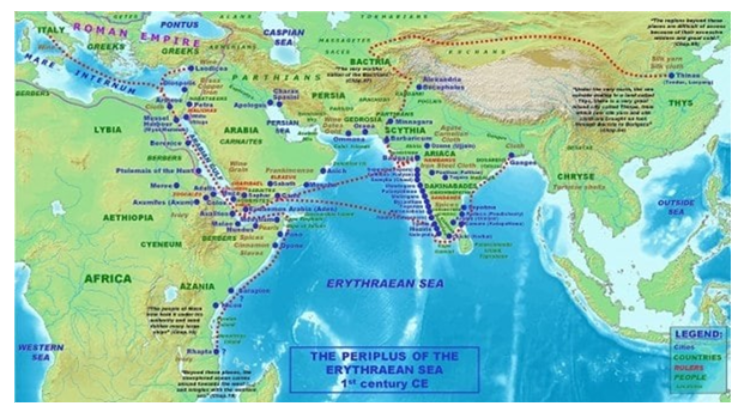
Pre-Common Era Trade:
- Evidence suggests the existence of an Indian diaspora in the Middle East during the time of the Indus Valley Civilization (c. 3300-1300 BCE). This early trade was coastal and involved smaller quantities of goods.
- The trade expanded significantly during Roman times, facilitated by large cargo ships directly connecting the subcontinent and the Roman Empire.
- The conquest of Egypt by the Romans in the 1st and 2nd centuries CE opened up the route to India, leading to a substantial increase in trade.
Organization and Duration of Journeys:
- Highly Organized Trade: Contracts were established between Indian merchants in Kerala and shippers in Alexandria. Goods were transported in containers, similar to modern practices, with references to insurance.
- Understanding Monsoons: Indians recognized the monsoon winds’ seasonal patterns, enabling them to navigate the route efficiently. The journey to Egypt took approximately six to eight weeks, depending on favourable wind conditions.
- Extended Stays: Indian diaspora rented houses in Egyptian ports while waiting for wind patterns to shift, allowing for the integration of Indian culture into these regions.
- Evidence suggests that Indian dynasties were interested in seafaring, as depicted in Ajanta paintings and early Indian coin designs featuring ships.
- Graffiti left by Indian sailors, primarily Gujaratis from Barigaza (modern-day Bharuch), has been discovered in the Hoq caves on the island of Socotra, emphasizing their active participation in the trade network.
Comparing with the Silk Road:
- Indian Centrality: The ancient economic and cultural hub of Asia, the Indian subcontinent, and its ports played a central role in maritime East-West exchange. The concept of the “Silk Road” is relatively recent and inaccurately portrays the ancient trade routes.
- Historical Invisibility: The Silk Road concept was coined in the late 19th century and did not exist in ancient or medieval times. It gained popularity in the 20th century, fostering romanticized ideas about East-West connectivity.
- Recent Politicization: Chinese President Xi Jinping’s Belt and Road Initiative has politicized the Silk Road, making it a central component of Chinese foreign policy.
Tribes India pavilion (G20) - Edukemy Current Affairs
In News: Recently, The Tribal Cooperative Marketing Development Federation of India Ltd. (TRIFED), Ministry of Tribal Affairs is showcasing a wide range of traditional tribal art, artifacts, paintings, and many more at the ‘Tribes India’ pavilion as part of the G-20 Leaders’ Summit in New Delhi’s Crafts Bazaar.
About:
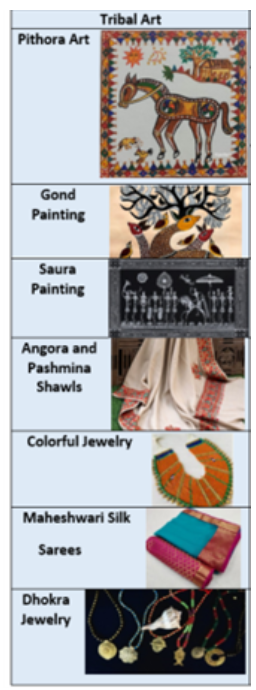
- The Tribes India pavilion at the G-20 Leaders’ Summit in New Delhi showcases a diverse range of tribal arts and crafts, including:
- Pithora Art:
- It is a ritualistic painting characterized by animated figures and lavish use of color.
- These paintings are done by the Rathwa, Bhilala, Naik and Bhil tribes of Gujarat and Madhya Pradesh.
- The paintings speak of the social, cultural and mythological life and beliefs of the tribals.
- The paintings are a medium of propitiation, thanksgiving and commemoration of auspicious occasions.
- Padma Shri awardee Shri Paresh Rathwa is a renowned artist of Pithora art.
- Gond painting from Madhya Pradesh, known for its Intricate and colorful design.
- Saura painting by artisans from Odisha, known for its distinct style.
- Angora and Pashmina shawls from the high altitudes of Leh-Ladakh and Himachal Pradesh, known for its high quality.
- The colorful jewellery by the Konyak tribes of Nagaland appeases the eye.
- Maheshwari silk sarees from Madhya Pradesh: It is worn during religious functions and auspicious events.
- Dhokra jewellery:
- It is carved out of molten metals, beads, colorful glass pieces, and wooden balls.
- Tribal artisans from West Bengal, Odisha, Chhattisgarh and Madhya Pradesh are the architects of these pieces of intrinsic art.
- Pithora Art:
Shiva’s Nataraja form
In News: Recently, the 27-feet-tall 'Nataraja' statue made of 'Ashtadhatu' is installed at the Bharat Mandapam where the G20 summit held.
About:

- This magnificent statue made of ‘Ashtadhatu’ (eight-metal alloy) was crafted by sculptors from Swamimalai in Tamil Nadu, India, and is inspired by three revered Nataraja idols from Chola temples.
- Weighing about 18 tonnes, it was hauled across the country on a 36-wheel trailer.
- The design of the Nataraja statue draws inspiration from three revered Nataraja idols in prominent South Indian temples:
- Thillai Nataraja Temple in Chidambaram.
- Uma Maheswarar Temple in Konerirajapuram.
- Brihadeeswara (Big) Temple in Thanjavur, a UNESCO World Heritage Site.
Nataraja form of Shiva:
- The Nataraja form of Shiva, as a cosmic dancer, became iconic under the Cholas and is renowned for its intricate bronze sculptures.
- Shiva's dance represents the cosmic cycle of creation, preservation, and destruction (Srishti, Sthiti, and Samhara).
- The dance also signifies the passage of time, from creation to dissolution.
- The rhythm of the dance symbolizes the heartbeat of the universe.
- The Nataraja image is encircled by a flaming halo and has four arms.
- The upper right hand holds the damaru (a small drum) symbolizing the rhythm of creation.
- The upper left hand holds the fire (or a flame), symbolizing destruction and transformation.
- The lower right hand is in the abhaya mudra (a gesture of fearlessness).
- The lower left-hand points towards the raised left foot, symbolizing liberation.
- Under his foot, there’s a dwarf-like figure representing illusion, which he crushes, guiding humanity away from delusion.
- Nataraja’s raised feet and gestures also symbolize protection and reassurance, all while he wears a smiling expression.
More Information:
- The sculpture was crafted using the traditional ‘lost wax’ casting method, a technique that dates back thousands of years and was perfected by the Cholas.
- In this method, a detailed wax model is covered with alluvial soil, which, when heated, melts the wax away, leaving a hollow mould for casting molten metal.
- The Cholas, who ruled much of peninsular India from the 9th to the 11th centuries AD, were great patrons of art and culture. They were devout Shaivites, known for constructing elaborate Shiva temples across their territories.
Adopt a Heritage 2.0 - Edukemy Current Affairs
In News: Recently, The Archaeological Survey of India (ASI) has launched a revamped version of the ‘Adopt a Heritage’ programme apart from an Indian Heritage app and an e-permission portal.
About:
Adopt a Heritage 2.0
- It is a revamped version of the earlier scheme launched in 2017.
- It clearly defines the amenities sought for different monuments as per the Ancient Monuments and Archaeological Sites and Remains Act (AMASR Act) 1958.
- It seeks to invite corporate stakeholders to enhance amenities at monuments by utilising their Corporate Social Responsibility (CSR) funds.
- Freedom has been given to companies to either adopt a monument in whole and develop its tourism infrastructure or provide a particular amenity such as drinking water facility or cleaning services for one or several sites.
- Applying procedure for a monument:
- The stakeholders can apply for adopting a monument or specific amenities at a monument through a dedicated web portal.
- The process for selection will be carried out after due-diligence and discussions with various stakeholders and assessing the economic and developmental opportunities at each monument.
- The term of the appointment will be for a period of five years initially, which may be further extended up to five years.
Indian Heritage App:
- It is a user-friendly mobile app which will showcase heritage monuments.
- The app will feature state-wise details of monuments along with photographs, a list of public amenities available, geo-tagged locations, and feedback mechanism for citizens.
e-Permission Portal:
- An e-permission portal is for obtaining permission for photography, filming, and developmental projects on monuments.
- The portal will fast-track the process of obtaining various permissions and solve operational and logistical bottlenecks.
|
Adopt a Heritage Scheme: |
|
London’s India Club
In News: Recently, London’s India Club got closed permanently, which was a historic establishment that served as a meeting place for Indians in the United Kingdom during the independence movement.
About
- London's India Club was established in 1951 by the India League, an organization initially dedicated to advocating for Indian independence and later focused on promoting friendship between India and Britain post-independence. The India Club played a pivotal role in the lives of Asian diaspora communities in Britain.
- London’s India Club situated within the Strand Continental Hotel, this establishment not only offered delectable Indian cuisine but also served as a central meeting point for individuals associated with India in the UK. Its interiors remained remarkably preserved over the years, reflecting a rich history.
- The India Club hosted a variety of groups and activities, including the Indian Journalist Association, Indian Workers Association, and Indian Socialist Group of Britain.
- Throughout its existence, the India Club attracted distinguished visitors, including Dr. Rajendra Prasad, the inaugural President of independent India, Lord Mountbatten, the final Viceroy of India, Jawaharlal Nehru, Dadabhai Naoroji, Bertrand Russell, and MF Hussain, among others. VK Krishna Menon, a diplomat and former Indian Defence Minister, served as one of the secretaries of the India Club.
Old Parliament Building - Edukemy Current Affairs
In News: From September 19, the ongoing special House session moved to the new Parliament building. The old Parliament will be turned into a museum.
Old Parliament Building:
- It is a 164 pillared building designed by British architects Edwin Lutyens and Herbert Baker.
- The building is surrounded by large gardens and the perimeter is fenced off by sandstone railings (jali).
- The foundation stone was laid on February 12, 1921, by the Duke of Connaught.
- On January 18, 1927, Lord Irwin, the viceroy of India at the time, officially opened the building. At first, it served as the Imperial Legislative Council's office.
- After India gained its independence, it served as the country's Constituent Assembly. Later, after the Constitution had been signed and the country became a republic, it became the Lok Sabha and the Rajya Sabha's home in the Indian Parliament.
- When they needed inspiration, Viceroy Lord Hardinge directed Lutyens and Baker to tour the majority of northern and central India's ancient and mediaeval monuments, including Mandu, Lahore, Lucknow, Kanpur, and Indore. As a result, the Rashtrapati Bhavan, the Parliament, and other structures combine Indian and Western architectural styles.
- The Chamber of Princes in the Parliament Building was also used by the Federal Court of India before independence. Afterwards, it served as the Supreme Court’s location for over ten years before the court moved to its own building.
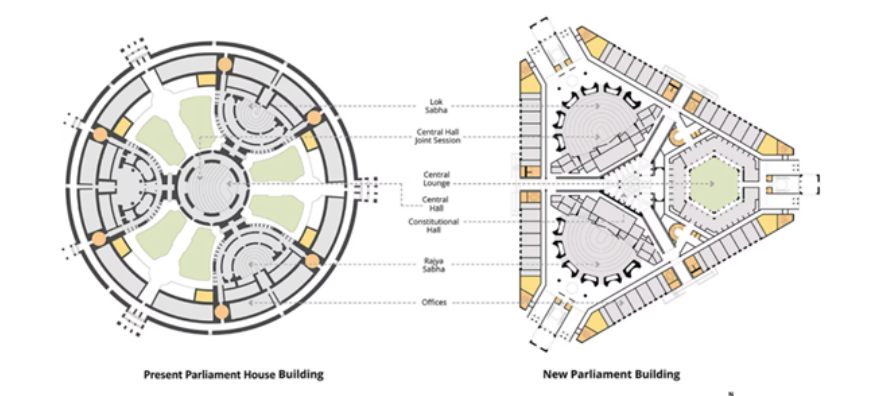
Chausath Yogini Temple:
- The grand Chausath Yogini temple stands atop a hillock in Mitaoli, in the Morena district of Madhya Pradesh.
- It was built around 1323 by King Devapala of the Kachchhapaghata dynasty.
- Dedicated to the 64 (chaunsath in Hindi) yoginis, its architecture is different from the temples dedicated to one deity.
- The temple is circular having diameter of 125 feet, with 64 chambers dedicated to the 64 yoginis, and a central shrine dedicated to Shiva.
- The 64 yoginis are believed to be powerful warriors and sorceresses. According to mythology, a demon, Raktabija, had a boon that made him almost impossible to kill — everytime a drop of his blood fell on the floor, hundreds of offspring would be born off it. However, when Goddess Durga went to battle him, she unleashed an army of 64 yoginis who drank off his blood before it could touch the floor, and Raktabija was finally killed.
- While most Hindu temples have a shikhara, or projecting dome, the Mitaoli temple, like other Chausath Yogini temples, is hypaethral, which means it has no roof.
- The Parliament-like pillars are on the inside of the stone temple complex.
- The central shrine has a slab with perforations, for excess rainwater to drain off.
- The Temple is in a Seismic Zone 3 area. Since its construction in the 1300s, the temple has withstood many an earthquake with almost no visible damage.
- The idols and carvings that would have once adorned the 64 chambers are all gone.
Did the Chausath Yogini temple inspire the Parliament?
- Though there is no evidence Lutyens or Baker ever visited it. They might have seen photographs collected by the Archaeological Survey of India. So even though there is no proof of them emulating Indian monuments, it is not inconceivable that they might have done so.
Reconstructing an ancient ‘stitched ship’
In News: The Ministry of Culture has recently joined hands with the Indian Navy and Goa-based Hodi Innovations to reconstruct an ancient stitched ship, reminiscent of the ships that sailed the oceans on India’s ancient maritime trade routes as many as 2,000 years ago.
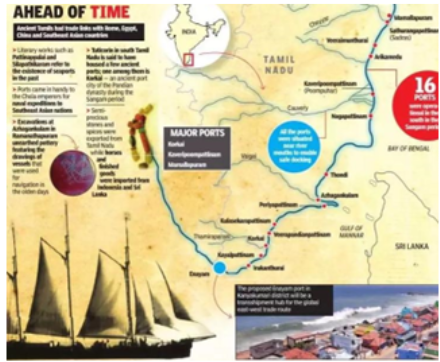
About the project:
- Ministries involved:
- While the Indian Navy is overseeing the ship’s design and construction, the Ministry of Culture has fully funded the project.
- The ministries of Shipping and External Affairs will be supporting in its execution stage.
- It was approved by the National Implementation Committee, chaired by Home Minister.
- The stitching work will be undertaken by a team of traditional shipwrights led by Babu Sankaran.
- Stitching:
- This age-old technique involves shaping the wooden planks using the traditional steaming method to conform to the shape of the hull.
- Each plank will then be stitched to another using cords/ ropes, sealed with a combination of coconut fibre, resin, and fish oil, akin to the ancient Indian shipbuilding practice.
- The ancient stitching technique almost became extinct after the Britishers came to India.
- The earliest known example of a sewn boat is the 40+ metres long funerary boat in Egypt; dating back to 2,500 BC.
- Sewn boat construction techniques were used in many parts of the world prior to the development of metal fasteners, and continued to be used for small boats to reduce construction costs where metal fasteners were too expensive.
- The Voyage:
- Once the ship is ready, the voyage with a seam of Indian Navy crew from Odisha’s Cuttack will be sent to Bali in Indonesia, in 2025, to coincide with Kartik Purnima.
- This also fits in with the larger decolonisation project undertaken, in the run-up to 2047, when independent India turns 100.
- The navigation techniques used for the voyage will also be in consonance with old times, also aiming to show the sophistication India had achieved in this field at the time.
Project Mausam
- Officials say this initiative is in synergy with the Ministry of Culture’s Project Mausam.
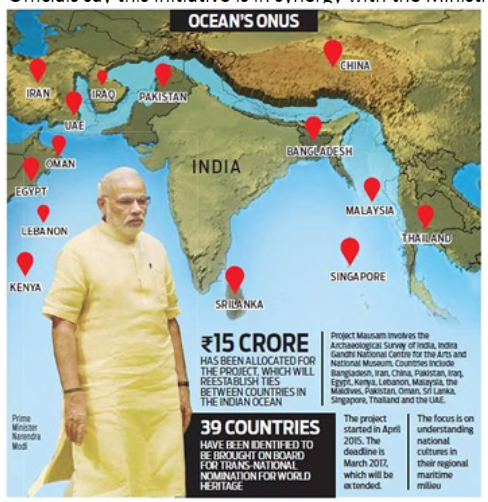
- Project Mausam is said to be India’s answer to the Maritime Silk Road of China, and India plans to move for UNESCO to award transnational heritage status to Project Mausam, which was launched by India at the 38th World Heritage Session at Doha in June 2014.
Adi Shankaracharya - Edukemy Current Affairs
In News: Recently, the Madhya Pradesh Chief Minister unveiled the 108-foot-tall ‘Statue of Oneness’ of Adi Shankaracharya at Omkareshwar.
About Adi Shankara:
- Adi Shankara, also known as Shankaracharya, was born on May 11th, 788 AD, in Kaladi near Kochi, Kerala.
- He attained Samadhi (spiritual liberation) at the age of 33 in Kedartirth.
- Adi Shankara was a devoted follower of Lord Shiva.
- He expounded the Doctrine of Advaita, which emphasizes the concept of Monism and wrote numerous Sanskrit commentaries on important Vedic texts such as the Upanishads, Brahma Sutras, and Bhagavad Gita.
- He held philosophical disagreements with Buddhist philosophers.
Major Works:
- Some of his major works include the "Brahmasutrabhasya," a commentary on the Brahma Sutra.
- He also composed the "Bhajagovinda Stotra," "Nirvana Shatakam," and several Prakaran Granths (philosophical treatises).
Other Contributions:
- Adi Shankara played a pivotal role in revitalizing Hinduism in India, especially during a time when Buddhism was gaining prominence.
- He established four Mathas (monastic institutions) in different corners of India, namely Shingeri, Puri, Dwaraka, and Badrinath, with the aim of propagating Sanathana Dharma (eternal religion).
Advaita Vedanta:
- Advaita Vedanta represents a philosophical stance characterized by radical nondualism, drawing its inspiration from ancient Upanishadic texts.
- According to Advaita Vedantins, the Upanishads unveil the fundamental concept of nonduality known as 'brahman,' which is the ultimate reality underlying all existence.
- Advaitins view Brahman as transcending individuality and the apparent diversity of the empirical world. They assert that the core essence of one's self (atman) is identical to Brahman.
- At the heart of Advaita Vedanta is the notion that atman is pure, non-intentional consciousness.
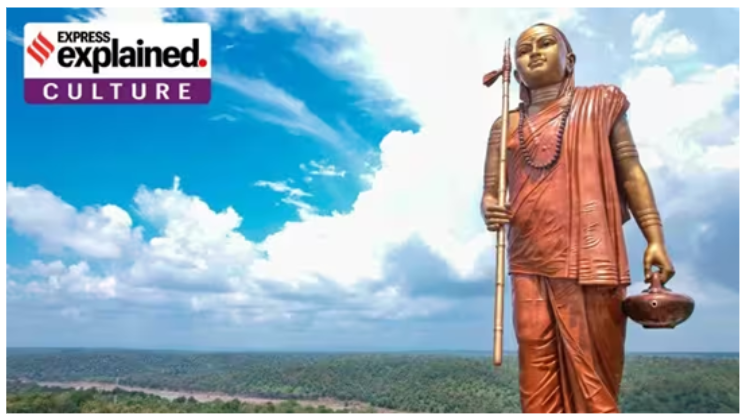
- It is described as singular, non-dual, infinite, and in complete unity with Brahman, lacking any separation or distinction.
Mewar school of painting - Edukemy Current Affairs
In News: Shining the spotlight on the Mewar school of painting
Mewar painting, a prominent school within the realm of Indian miniature painting during the 17th and 18th centuries, belongs to the Rajasthani style and originated in the Hindu principality of Mewar, located in the state of Rajasthan.
Key characteristics of this school of painting include:
- Vibrant and Simple Colors Palette: The works of the Mewar painting school are known for their use of simple yet vivid colors, which contribute to their direct emotional appeal.
- Historical Origin: The earliest known example of Mewar painting dates back to 1605 CE when a series of Ragamala paintings was created in Chawand, a small town near Udaipur. These paintings were attributed to the artist Misardi and served as a significant starting point for the school.
- Notable Collections: Many of the paintings from this series can be found in the collection of Shri Gopi Krishna Kanoria, highlighting their historical and artistic significance.
- Expressive and Dynamic Style: The Mewar painting style is recognized for its expressive and dynamic artistic approach, which continued with some variations until around 1680 in the region.
- Mughal Influence: After 1680, Mughal artistic influence became more evident in Mewar's paintings, leading to a blending of styles and themes.
- Shift towards Portraiture and Ruler's Life: Over time, a growing number of Mewar paintings began to focus on portraiture and depictions of the ruler's life, reflecting the changing interests and preferences of the period. However, religious themes remained popular throughout its development.
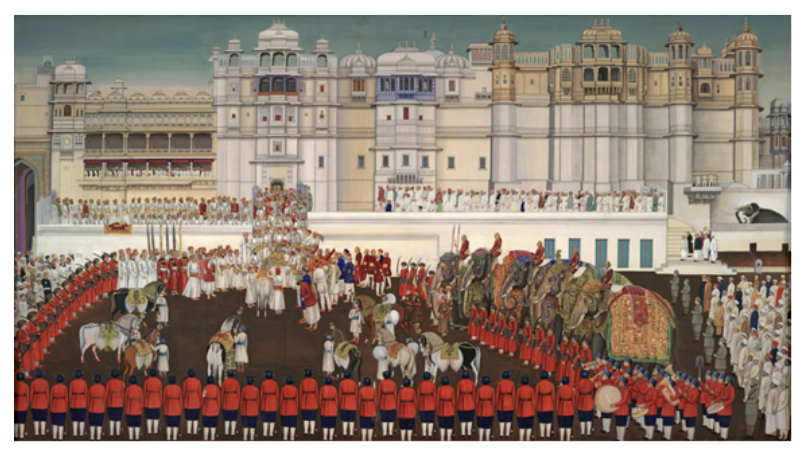

India’s First Lighthouse Festival
In News: India’s First Lighthouse Festival begins in Goa.
About
- India’s First Lighthouse Festival is set to occur with the objective of converting historic lighthouses into attractive tourist destinations.
- It is a component of the 'Lighthouse Heritage Tourism' campaign, which strives to rejuvenate 75 historic lighthouses throughout India and present them as alluring tourist attractions.
- These lighthouses are captivating tourism sites, highlighting their cultural importance and economic opportunities.
Make agriculture less damaging
Exam View: Agriculture Working Group (AWG) of G20; India’s role in Global South.
Context: India with its G20 presidency can benefit the masses in the Global South for whom food and nutritional security is still a challenge, one made worse by climate change.
Decoding the editorial: Agriculture Working Group (AWG) of G20
- The AWG of G20 highlighted priority areas in agriculture.
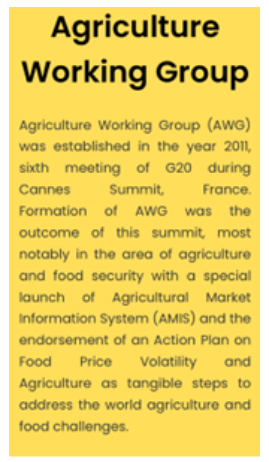
-
- Encourage diversification in agriculture.
- Promoting sustainable agriculture.
- Channelling financial resources towards environmentally conscious and climate-resilient farming.
- Climate-smart farming practices and precision technologies for agricultural production to withstand climate fluctuations.
- Food and nutritional security via higher investment in agri-R&D, especially bio-fortification.
- Strengthening a rules-based, open, predictable, transparent, non-discriminatory, inclusive, equitable and sustainable multilateral trading system.
- Strengthening local, regional, and international agri-food value chains.
- A sustainable multilateral trading system with the WTO at its core, can increase market predictability and boost business confidence.
- The Deccan High-Level Principles as outlined in the ‘Outcome Document and Chair’s Summary’ of the AWG of G20 nations at Hyderabad are:
- Facilitate humanitarian assistance to countries and populations in vulnerable situations;
- Enhance availability and access to nutritious food and strengthen food safety nets;
- Strengthen policies and collaborative actions for climate-resilient and sustainable agriculture and food systems;
- Strengthen resilience and inclusivity in agriculture and food value chains;
- Promote the one health approach;
- Accelerate innovation and the use of digital technology, and
- Scale-up responsible public and private investments in agriculture.
India’s role in Global South
- India can develop technologies to help farmers of the Global South overcome challenges of extreme weather events.
- It could be on the same lines as the application of precision technologies in space that India used in Chandrayaan-3, while spending a fraction of the cost that the US would incur for the same feat.
- The ultimate goal is to enhance the efficiency and resilience of agri-value chains and promote digitisation as a catalyst for agricultural transformation.
- This includes the establishment of standardised agricultural data platforms as digital public goods and harnessing novel digital technologies to revolutionise the agri-food sector.
- Sensor-equipped drips, drones and LEOs (Low Earth Orbits), for instance, can be used in agriculture to get “more from less”, saving the planet’s scarce resources.
- India can disseminate its research in bio-fortification to farmers in the Global South to achieve nutritional security.
- ICAR scientists have already demonstrated that even basic staple crops such as wheat, rice, maize, and millet can be bio-fortified with enhanced iron, zinc, and even anti-oxidants.
- ICAR has created 87 varieties of climate-resistant and nutritious crops.
- These crops were developed as a result of collaboration between national and international organisations.
- India released zinc-rich rice and wheat, which can be shared with countries of the Global South.
- Bio-fortification is much more cost-effective compared to supplementing rice with nutrients, say iron, in our public distribution system.
- But India spends only 0.48 percent of agri-GDP on agri-R&D. This needs to be doubled, if the country has to play the role of a leader.
- India could bring millets to the fore, even on the dining tables of G20 members.
- But much more product innovation and dissemination is needed to make it a part of global cuisine, akin to say quinoa.
- India needs to re-purpose its agri-policies.
- Current policies of open-ended and assured procurement with Minimum Support Price (MSP) for paddy and wheat, coupled with massive subsidies on fertilisers, power, and irrigation, have caused damage to our natural resources, especially soil, water, air, and biodiversity.
Time is running out and the G20 needs to work closer, faster, and smarter with demonstrable results by 2030 to feed this world and also save the planet, by making it green and clean.
India’s role in democratising space
Exam View: Is Outer Space a “Global common”?; Space Race; India’s role.
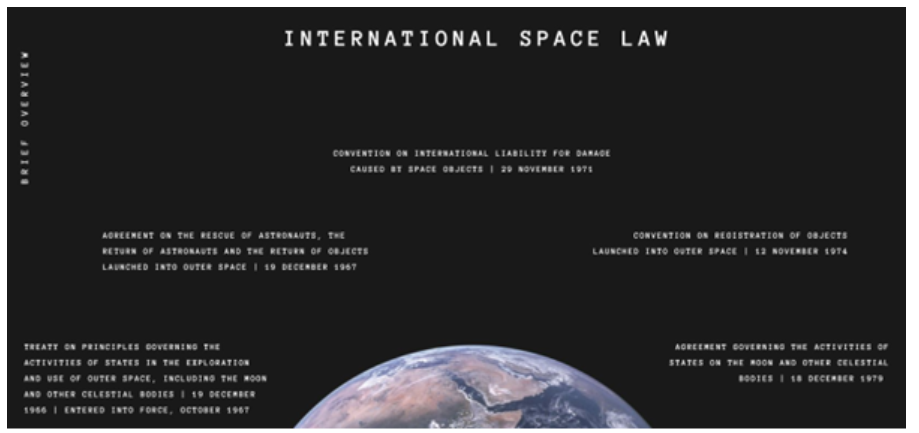
Context: With the success of Chandrayaan 3, India must pursue contributing towards the framing of an international space resource-management framework that balances competing objectives in pursuit of the exploration and use of outer space for peaceful purposes.
Decoding the editorial: Is Outer Space a “Global common”?
- “Global commons” is a concept built upon the legacy of Grotius’s idea of mare liberum (free sea), an idea that aimed to preserve the freedom of access and benefit of all.
- The term is used typically to describe supra-national and global resource domains in which common-pool resources are found.
- The UN identifies four “global commons”, namely
- the high seas,
- the atmosphere,
- Antarctica and
- outer space.
- When rooted in geopolitical or military relevance, “global common” is generally viewed as an enabling concept.
- Security establishments across the world recognise domains beyond the national jurisdictions as vital connecting channels for the international order.
- Others recognise outer space as a vital operational domain for keeping their nation safe while upholding international law.
- If outer space as a “global common” were rejected, high seas would not continue to be regarded as one.
- A collective regional security initiative like the QUAD would be unable to continue its call for the freedom of navigation.
- When rooted in economic and commercial implications of shared resources, “global common” is generally seen as a constraining concept.
- “Commons” is seen as constraining because it is associated with notions of shared ownership, public governance or limitations on use.
- “Commons” is sometimes also associated with the “common heritage of mankind” (CHM) concept.
- It has been expressed in the Moon Agreement, 1979.
- CHM was a new concept that created a territorial status in which the Moon and celestial bodies are themselves not subject to national appropriation, but the fruits and resources of which are also deemed to be the property of mankind at large.
- CHM is not limited to outer space.
- The 1970 UN General Assembly passed a non-binding resolution that “the seabed and ocean floor, and the subsoil thereof, beyond the limits of national jurisdiction, as well as the resources of the area are the common heritage of mankind.”
- After the Moon Agreement, this principle was codified as Article 136 of the United Convention on Law of the Seas, 1982.
Space Race
- In 1957, after Sputnik was launched, geopolitical expediency led the only space-faring superpowers, the US and the USSR to ensure the adoption of UN General Assembly Resolutions 1721 A&B (XVI).
- All space-faring nations have continued to conform and adhere to that settled precedent.
- Over decades of consistent state practice, the principles of the Outer Space Treaty, 1967, have transformed into rules of customary international law.
- Today, outer space is a democratised domain.
- Over 80 countries access outer space, deriving benefits from space-based satellite services for every aspect of their national life, even though there are only 11 space-faring nations (including ESA).
India’s role
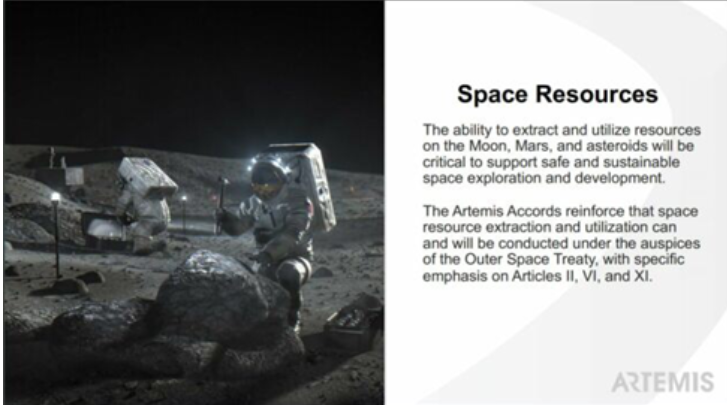
- India’s successes in 2023
- India is now a signatory to the US Artemis Accords.
- The deepening of US-India engagements, particularly iCET.
- The establishment of the US-India Civil Space and Commercial Space Working Groups has met with excitement and expectations.
- The Chandrayaan 3 landing.
- India can play a significant part in determining the content and contours of a future international framework for the management of space resources.
- It must necessarily involve a close examination of the Moon Agreement 1979 (MA) which came into force in 1984.
- It will require a comprehensive understanding of the range of directly and indirectly applicable international law and other frameworks.
- It will also require the participation of all government institutions.
India has had and continues to have robust international cooperation space programmes, including multilateral and bilateral engagements with advanced space powers, and with those looking forward to advancing theirs.
The complex path of biofuel Sustainability
Exam View: About Biofuels; About Global Biofuel Alliance; Challenges to scaling up of Biofuel in India; Measures for decarbonization of transportation.
Context: While electric vehicles are being rapidly adopted, use of biofuels is also being promoted for addressing environmental concerns. The Global Biofuels Alliance formed at the G-20 Summit is expected to strengthen the development of sustainable biofuels, in addition to promoting ethanol uptake.
About Biofuels:
- Biofuels are the fuel derived from the biomass of plants or animal wastes. It is commonly produced from corn, sugarcane and animal waste like cow dung. These come under renewable energy as its sources are renewable unlike fossil fuels.
- These can be used to replace or can be used in addition to diesel, petrol or other fossil fuels for transport, stationary, portable and other applications.
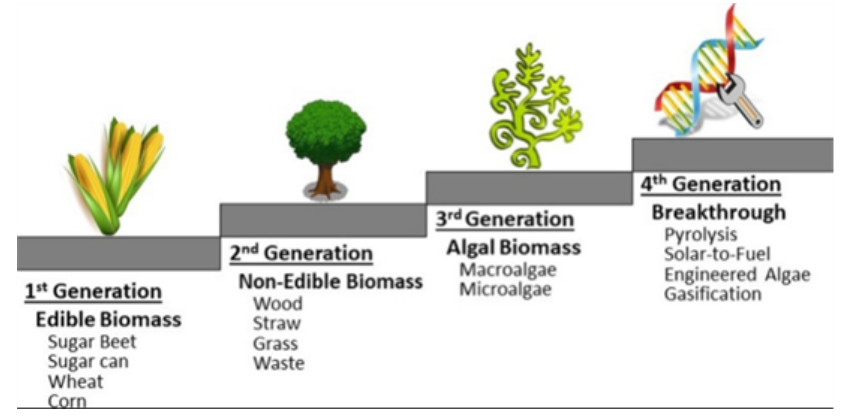
- There are different generations of biofuels based on the source of their production.
Limitations of Electric Vehicles:
Certain limitations of EV require complementary biofuel strategy for decarbonization of transportation:
- Capital Intensive transition: for a transition to EVs, existing internal combustion engine (ICE) vehicles and the supporting infrastructure need to be replaced entirely, which is capital intensive.
- Mining of minerals: the required batteries and critical minerals used in them need to be imported, adding to environmental concerns on how these minerals are mined, among other issues.
- Biofuels, on the other hand, can be used in existing ICE engines and infrastructure with little to no modifications (depending on the blending rates) and offer import independence.
About Global Biofuel Alliance:
- Global Biofuel Alliance is being established by India, Brazil and US which together account for 85% of global Ethanol Production. It will be an international platform for sharing best practices, promoting sustainable biofuel development and enhancing its application.
- It aims to impact global energy architecture and achieve the target of net-zero emissions.
- Objectives of Global Biofuel Alliance are:
- Promotion of International collaboration and cooperation to encourage the acceptance and utilisation of biofuels.
- Development of robust markets for biofuels and facilitating global trade in biofuels.
- Intensification of the use of sustainable biofuels in the transportation sector.
- Development of concrete policy lesson-sharing and provision of technical support for national biofuels programs worldwide.
Challenges to scaling up of Biofuel in India:
- Use of 1st Generation biofuel: 1st generation biofuel sourced from food crops, are primarily used in India. The policy target of achieving 20% ethanol blending (E20) by 2025-26 is also expected to be met by 1G ethanol putting stress on agricultural produce.
- Groundwater depletion could triple during 2040-81. This could be partly attributed to increase in crop water requirements. Thus producing fuel from food crops would become unsustainable.
- Stagnation of crop yield: India’s crop yields have already stagnated, and global warming is expected to reduce yields. So, the strategy to meet blending targets cannot depend on surplus crop production.
- GHG emissions from agriculture sector: Agriculture sector has high direct GHG emissions. Thus depending on a sector with high GHG emissions to decrease emissions from the transport sector is a not beneficial balancing loop.
Measures for decarbonization of transportation:
- Use of Biomass: Biomass should be prioritised for sectors where there are limited low-carbon alternatives. Long-haul aviation and road freight segments, wherein complete electrification might take longer to achieve, could use biomass as an alternative energy source.
- Increasing production of 2G biofuels: For net zero by 2050, biofuel production needs to be tripled by 2030. 2G ethanol could be counted as a sustainable fuel, especially if the production is decentralised, i.e., crop residues do not have to be transported large distances to a central manufacturing plant
- Global Biofuels Alliance could help drive innovation and technology development in establishing an efficient biomass supply chain and smaller-scale decentralised biofuel production units.
Source: The complex path to biofuel sustainability - The Hindu.
Cleantech - Edukemy Current Affairs
Exam view: Green economy; Cleantech solutions for the hinterlands; Steps to scale up.
Context: Cleantech can deliver on development and climate action in the country’s rural areas.
Decoding the editorial: Green economy
- The green economy paradigm provides an optimistic pathway to align development and environmental outcomes.
- Building a solar park or an electric vehicle charging station helps expand the much-needed infrastructure in a developing economy while furthering climate action.
- Reviving millets helps improve farm incomes in rain-fed areas while making our agriculture climate resilient.
- But the critical issue is taking this green economy paradigm to the heart of our development needs in the form of youth looking for jobs, women seeking income opportunities, or farmers waiting to diversify their incomes.
Cleantech solutions for the hinterlands
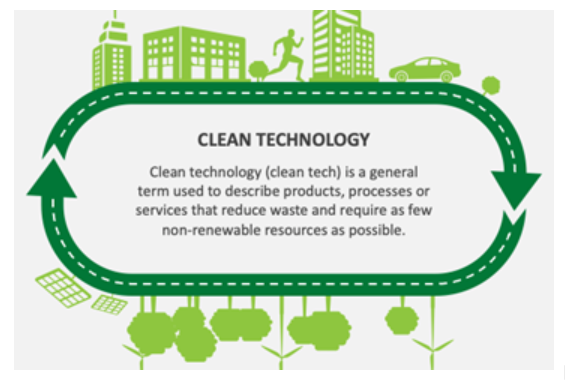
- India’s rural economy that comprises 120 million farmers and 34 million micro-enterprises often struggles with unreliable electricity access and a dependence on expensive and imported diesel.
- Cleantech solutions that are powered by renewable energy can help India reduce its diesel imports, avoid the loss of perishable food and enhance rural livelihood opportunities while posing an investment opportunity worth $50 billion for investors and financiers.
- Examples from recent years
- Solar dryers converting throwaway tomatoes into sun-dried ones in Andhra Pradesh,
- Biomass-powered cold storages helping farmers in Maharashtra selling lemons make a gain that is three to five times that of the original price, or
- Solar silk reeling machines reducing drudgery for thigh-reelers and doubling their income in Odisha.
- Research at the Council on Energy, Environment and Water (CEEW) shows that just 12 such cleantech solutions have the potential to impact at least 37 million livelihoods or about 16% of our rural population.
But this silent revolution now needs a structural boost. There needs to be a three-fold approach to traverse this journey from 50,000-plus to tens of millions.
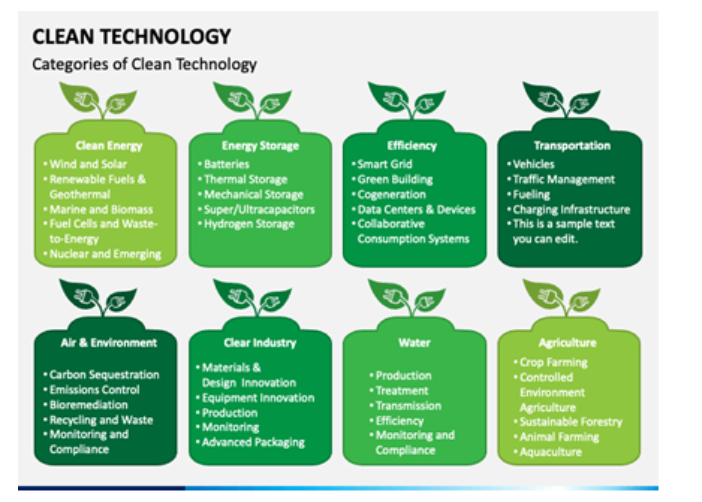
Steps to scale up
- Leverage existing government programmes supporting livelihoods.
- For instance, the Pradhan Mantri MUDRA Yojana can be used to enable the adoption of cleantech solutions.
- The Pradhan Mantri Formalisation of Micro food processing Enterprises (PM-FME) scheme can be used to unlock support for solutions such as a solar dryer, an energy-efficient multipurpose food processor or a solar grain mill.
- The Pradhan Mantri Matsya Sampada Yojana can be leveraged towards adopting solar refrigerators and dryers for fishing communities.
- The Agriculture Infrastructure Fund, which has only seen a 15% fund utilisation against a target of ₹1,00,000 crore, can support the adoption of biomass-powered cold storage and beyond.
- Enable large-scale financing of cleantech solutions.
- It requires supporting bankers’ capacity on credit assessment for cleantech because they have not come across such solutions and the associated cash flows before to make an informed assessment.
- Their risks need to be hedged in the initial stages of the market through partial guarantees.
- Adopting some of these principles helped ‘Powering Livelihoods’, a CEEW-Villgro initiative, unlock 300-plus loans for cleantech solutions to women, self help groups, farmer producer organisations and individual micro-entrepreneurs in rural areas.
- It requires supporting bankers’ capacity on credit assessment for cleantech because they have not come across such solutions and the associated cash flows before to make an informed assessment.
- Enable multi-actor partnerships.
- The challenges faced include
- low product awareness,
- high customer acquisition cost as users need to touch and feel these products before adoption,
- low density of customers for such products in a given area, and
- limited after-sales service and market linkage of the final processed products.
- A holistic ecosystem where
- distributors work with manufacturers to enable technology access at the last mile,
- service providers ensure after-sales services, and
- market-linkage players enable the connection to the market to create a thriving ecosystem for cleantech to impact rural livelihoods at scale.
- For instance, there are solar dyer companies that are not only deploying dryers but are also enabling financing for users to adopt the dryers and buying back the final produce from them to ensure market linkages.
- The challenges faced include
By focusing on cleantech for livelihoods and jobs, especially in rural areas, we can make that green future inclusive.
Women-led climate action - Edukemy Current Affairs
Exam View: Impact of climate change on women; Way forward.
Context: Women in the emerging countries are more vulnerable to climate change because of their dependence on natural resources and labour-intensive work.
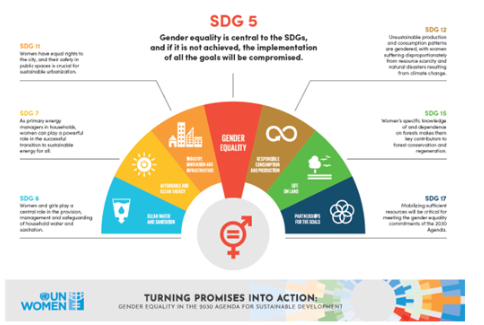
Decoding the editorial: Impact of climate change on women
- Women across the world face severe risks to their health, safety, and quality of life.
- Women are more likely to live in poverty than men.
- It is just one of several social, economic, and cultural variables that makes them more susceptible to the effects of climate change.
- According to estimates, 130 million people could be pushed into poverty by 2050 due to climate change risks, natural disasters, and food inflation, impacting women’s inequality.
- Women in developing and less developed countries are more vulnerable.
- It is because of their dependence on natural resources and labour-intensive work for their livelihood.
- According to the ILO, over 60% of working women in southern Asia and sub-Saharan Africa are still in agriculture, where they are often underpaid and overworked.
- Women in low-income countries engaged in climate-vulnerable occupations such as farming face further issues.
- Women own only about 10% of the land used for farming.
- Women engaged in agriculture do not have access to quality inputs and possess low education and technical knowledge.
- Heat stress affects workers a lot in this sector, especially in South Asia and Africa.
- Changing precipitation patterns and more frequent extreme weather events are just the beginning of the problems.
- Their effects on crop production and food security fall disproportionately on these people, who already face significant challenges in obtaining resources, expertise, and technology.
- Women from low-income households are more at risk.
- It is because they are more responsible for food, water, and other homely unpaid work.
- Women in rural areas are impacted disproportionately by climate change.
- Due to the climate crisis, more time and effort are needed to obtain basic necessities.
- Rural women often shoulder the burden of ensuring access to clean water, adequate cooking fuel, and nutritious food for their families.
- Women may be at increased risk for health and safety because they must travel long distances every day to collect water and fuel.
- Women are more likely to be displaced by climate-related disasters.
- According to a UN study, most (80%) of those displaced by climate-related disasters are women and girls.
- Women, especially those from vulnerable communities, face particular difficulties during and after natural disasters.
- When women are uprooted, they are more susceptible to prejudice and exploitation.
- For instance, after the earthquake in Nepal in 2015, the United Nations Population Fund (UNFPA) found women were more exposed to trafficking and exploitation.
- Separation from social networks, a higher risk of gender-based violence, and decreased access to employment, education, and essential health services, such as sexual and reproductive health care and psychosocial support, are just some gender-specific issues women face.
Way forward
- Invest in women’s education, training
- Investments in women’s education, training, and access to resources are essential if we are to be resilient to the impact of climate change.
- The negative impacts of climate change on people’s living standards can be reduced by teaching them how to practise sustainable agriculture, water management, and energy generation.
- For example, in India, the Self-Employed Women’s Association (SEWA) teaches women farmers how to respond to shifting climate patterns to support themselves better financially.
- Therefore, it is essential to support groups that educate the public, train people to adapt to climate change and invest in women’s education and training in environmentally-friendly farming methods.
- Women’s participation in climate policy decision-making at all levels
- As women face greater risks in climate change, gender parity in decision-making bodies is essential.
- One such programme in South Asia is the Gender and Climate Change Development Programme, which aims to increase women’s influence in policy making by providing them with a stronger voice.
Gender equality and environmental goals are mutually reinforcing and create a virtuous circle that will help accelerate the achievement of the SDGs.
Climate Phenomenon and Food Security
Exam View: El Nino and El Nino Southern Oscillation; El Nino Phase and Climate Change; El Niño and food security; Response to Climate Change phenomenon
Context: There has been a series of disruptive weather and climate phenomena in India this year, demonstrating the complexity of our precipitation system. Western disturbance, which usually brings rain and moisture to the western Himalayas parts of northern India during winters, has remained active late into the summer.
About the El Nino and El Nino Southern Oscillation [ENSO]:
- El Niño is a climate pattern that describes the unusual warming of surface waters in the eastern tropical Pacific Ocean.
- In a normal year, a surface low pressure develops in the region of northern Australia and Indonesia and a high-pressure system over the coast of Peru. As a result, trade winds over the Pacific Ocean move strongly from east to west.
- The easterly flow of the trade winds carries warm surface waters westward, bringing convective storms to Indonesia and coastal Australia. Along the coast of Peru, cold bottom cold nutrient-rich water wells up to the surface to replace the warm water that is pulled to the west.
- In an El Niño year, air pressure drops over large areas of the central Pacific and along the coast of South America.
- There is a weak high in the western Pacific. This change in pressure pattern causes the trade winds to be reduced intensity and sometimes it might even get reversed.
- This reduction allows the equatorial counter-current to accumulate warm ocean water along the coastlines of Peru and Ecuador. This prevents upwelling of cold deep ocean water along the coast of Peru and brings drought to Indonesia and Australia along with rains in South America
- The formation of an El Niño is linked with the Pacific Ocean circulation pattern known as the southern oscillation. El Nino and Southern Oscillation coincide most of the time hence their combination is called ENSO – El Nino Southern Oscillation.
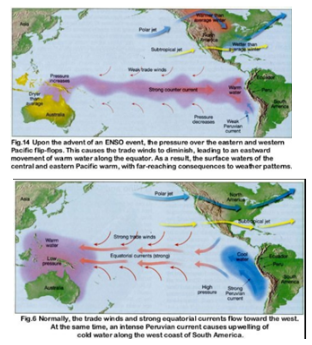
Impact of El Nino Phase on Climate:
- Droughts and water scarcity in South East Asia and Australia. It leads to water scarcity in many parts of India and adversely affects agriculture, causing a decrease in crop yields.
- Forest fires: During El Niño years, drier conditions may increase the likelihood of forest fires, especially in regions prone to such disasters.
- Climate extremes: El Niño can contribute to other climate extremes in India, such as heatwaves and intense cyclones.
- Climate induced disasters: Landslides and flooding in the western Himalaya and northern India leads to destruction of infrastructure and loss of life.
- Inter annual Variability in rainfall: 65% of the inter-annual variability of the southwest monsoon, over many decades, can be attributed to the combined effects of ENSO and the IOD.
Impact of El Niño on food security:
- Affects agricultural processes: El Nino and associated phenomenon affects rain fed agriculture by delaying the start of rains, affecting sowing, hot temperatures negatively influence plant growth and soil moisture.
- Unirrigated lands: More than 50% of agricultural land is unirrigated. Thus any delays in monsoon affects crop growth severely.
- Erratic Monsoons: Breaks in monsoon, delays in its advent and disproportionate rainfall in different regions affects growth of crops and hampers food security.
- Dependence on green water irrigated regions: Even in irrigated areas, many dominant crops require green water (Green water is rain-fed soil moisture tapped by food and cash crops, eventually transpiring into the atmosphere) to different extents. For example, in kharif season, rice paddy under irrigation uses green water to the tune of 35%.
- Growth of Rabi crops: Contributions of green water from northeast monsoon in southeast India and Western disturbance in north plays significant roles in determining the fate of Rabi crops.
Impact of El Nino on northeast monsoon:
- Central India’s highlands, encompassing 36 districts in the states of Madhya Pradesh, Chhattisgarh, and Maharashtra, which are emerging as climate change hotspots critical for our water, food and ecological security.
- NE Monsoon feeds headwaters for five of India’s 10 major river basins thus playing an important role in India’s water security.
Response to Climate Change phenomenon:
- Reducing dependence on water-intensive crops: With introduction of millets agriculture is shifting to less water-intensive crops which may reduce vulnerability of our food systems to phenomena like El Niño.
- Adaptations and alternative crop strategies like shifting to millets and alternative varieties of dominant cereals and advisories to farmers to switch to crops with shorter growing cycles.
- Alternative short-term and long-term management of our dams and reservoirs is required to reduce the risk of dam-based flood disasters and ecological damage to aquatic ecosystems.
The complex path of biofuel Sustainability
Exam View: About Biofuels; About Global Biofuel Alliance; Challenges to scaling up of Biofuel in India; Measures for decarbonization of transportation.
Context: While electric vehicles are being rapidly adopted, use of biofuels is also being promoted for addressing environmental concerns. The Global Biofuels Alliance formed at the G-20 Summit is expected to strengthen the development of sustainable biofuels, in addition to promoting ethanol uptake.
About Biofuels:
- Biofuels are the fuel derived from the biomass of plants or animal wastes. It is commonly produced from corn, sugarcane and animal waste like cow dung. These come under renewable energy as its sources are renewable unlike fossil fuels.
- These can be used to replace or can be used in addition to diesel, petrol or other fossil fuels for transport, stationary, portable and other applications.
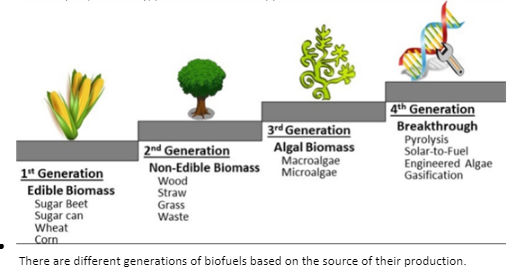
- There are different generations of biofuels based on the source of their production.
Limitations of Electric Vehicles:
Certain limitations of EV require complementary biofuel strategy for decarbonization of transportation:
- Capital Intensive transition: for a transition to EVs, existing internal combustion engine (ICE) vehicles and the supporting infrastructure need to be replaced entirely, which is capital intensive.
- Mining of minerals: the required batteries and critical minerals used in them need to be imported, adding to environmental concerns on how these minerals are mined, among other issues.
- Biofuels, on the other hand, can be used in existing ICE engines and infrastructure with little to no modifications (depending on the blending rates) and offer import independence.
About Global Biofuel Alliance:
- Global Biofuel Alliance is being established by India, Brazil and US which together account for 85% of global Ethanol Production. It will be an international platform for sharing best practices, promoting sustainable biofuel development and enhancing its application.
- It aims to impact global energy architecture and achieve the target of net-zero emissions.
- Objectives of Global Biofuel Alliance are:
- Promotion of International collaboration and cooperation to encourage the acceptance and utilisation of biofuels.
- Development of robust markets for biofuels and facilitating global trade in biofuels.
- Intensification of the use of sustainable biofuels in the transportation sector.
- Development of concrete policy lesson-sharing and provision of technical support for national biofuels programs worldwide.
Challenges to scaling up of Biofuel in India:
- Use of 1st Generation biofuel: 1st generation biofuel sourced from food crops, are primarily used in India. The policy target of achieving 20% ethanol blending (E20) by 2025-26 is also expected to be met by 1G ethanol putting stress on agricultural produce.
- Groundwater depletion could triple during 2040-81. This could be partly attributed to increase in crop water requirements. Thus producing fuel from food crops would become unsustainable.
- Stagnation of crop yield: India’s crop yields have already stagnated, and global warming is expected to reduce yields. So, the strategy to meet blending targets cannot depend on surplus crop production.
- GHG emissions from agriculture sector: Agriculture sector has high direct GHG emissions. Thus depending on a sector with high GHG emissions to decrease emissions from the transport sector is a not beneficial balancing loop.
Measures for decarbonization of transportation:
- Use of Biomass: Biomass should be prioritised for sectors where there are limited low-carbon alternatives. Long-haul aviation and road freight segments, wherein complete electrification might take longer to achieve, could use biomass as an alternative energy source.
- Increasing production of 2G biofuels: For net zero by 2050, biofuel production needs to be tripled by 2030. 2G ethanol could be counted as a sustainable fuel, especially if the production is decentralised, i.e., crop residues do not have to be transported large distances to a central manufacturing plant
- Global Biofuels Alliance could help drive innovation and technology development in establishing an efficient biomass supply chain and smaller-scale decentralised biofuel production units.
Source: The complex path to biofuel sustainability - The Hindu.
Striking a Green Balance - Edukemy Current Affairs
Exam View: About the Carbon Trading Network; Significance of Carbon Credit System; Initiatives of Indian Government towards Carbon Credit trade; Benefits of setting up Indian Carbon Market
Context: As India develops its economy to meet the growing needs of its people, the country faces a challenge of balancing its climate goals and developmental goals. There is need to curb carbon emissions and adopt practices to mitigate greenhouse gas (GHG) emissions through carbon trade.
Decoding the editorial: The Carbon Trading Network

- Carbon trading network is a market-based approach to reducing greenhouse gas (GHG) emissions. It allows companies that have low or no emissions to sell credits to companies that have high emissions. This offsets the emissions of the polluting company and helps to reduce overall GHG emissions.
- Carbon credits are permits that represent one ton of carbon dioxide or the equivalent amount of another greenhouse gas. They are created to offset the emissions of companies or individuals.
- This mechanism allows a company with low or no emissions to sell credits in the market via a carbon trading framework or carbon exchange.
Significance of Carbon Credit System:
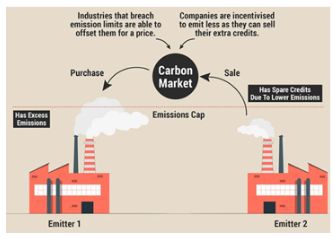
- Carbon credits can assist companies in meeting sustainability targets. These outfits can purchase credits or fund programmes that create carbon credits.
- Mobilisation of resources through transferring of capital from carbon emitters to those who invest in reducing carbon footprints.
- Limited decarbonization avenues for some industries such as cement, chemicals, iron and steel production and non-ferrous metals which have limited scope for decarbonization. Carbon credits can help these companies to meet the requirements in the initial stages of transformation.
Initiatives of Indian Government towards Carbon Credit trade:
- The Centre is planning to set up the Indian Carbon Market (ICM) by establishing a national framework that will help in decarbonising the domestic economy by pricing GHG emissions via trading in carbon credit certificates.
- Carbon credits can assist companies in meeting sustainability targets where outfits can purchase credits or fund programmes that create carbon credits.
- The draft framework for the Indian Carbon Credit Scheme 2023 was recently notified by the Union government. The Bureau of Energy Efficiency functioning under the Ministry of Power has been tasked to develop the Carbon Trading Scheme in tandem with MoEFCC.
Benefits of setting up Indian Carbon Market:
- Investment Mobilisation: ICM will help mobilise investments for the transition to a low-carbon ecosystem. It will also help India lower the emissions intensity of its GDP by 45% by 2030 compared to the 2005 levels.
- Fillip to Energy Transition: India does have an energy savings-linked market mechanism. However, carbon credit trading will give a fillip to energy transition due to its greater scope for covering the country’s potential energy segments.
- Sectoral emission targets and benchmarking: ICM would help in setting GHG emissions intensity targets and establish sectoral benchmarks in sync with the domestic emissions trajectory, according to the climate goals.
- Flexibility to specific sectors: Although the ICM would be regulated, it will offer flexibility to companies in hard-to-abate segments to augment their GHG emission efforts through carbon market credits.
- Incentivise technological upgrade: The mechanism could help attract finance and technology for sustainable projects that can generate carbon credits. The ICM can be an effective channel in mobilising a major proportion of funds required for the low-carbon transition.
- Nudge Effect: The Centre’s decision will also create more awareness, change and innovation across hard-to-abate industries. Placing a price tag on carbon footprints would have a direct impact on industries.
- Aligning with national and international requirements: Carbon-related tariffs such as CBAM (Carbon Border Adjustment Mechanism) will start influencing trade directly, businesses would need to factor in both national and international implications. ICM can facilitate such integrations.
End of Old Multilateralism and Rise of New World Order
Exam View: Multilateralism; Multilateralism in in Post-Cold War world; End of traditional multilateralism; Impact to China’s aggressive policies on multilateralism; Features of New Multilateralism
Context: Post Cold-War multilateralism, characterised by global cooperation and coordination on issues such as trade, security, human rights, and environmental protection, has reached its lowest point. This is being witnessed in the declining cooperation in East Asia Summit in Jakarta and G20 summit in Delhi.

Decoding the Editorial: About Multilateralism:
- Multilateralism can be defined as a philosophy of increased regional and global cooperation and coordination in the period after the end of the Cold War in 1991.
- This was facilitated by the absence of major conflicts between the two superpowers, the United States and the Soviet Union, and their respective allies.
Multilateralism in in Post-Cold War world
- End of Cold War: It facilitated in creating favourable conditions for an intensive phase of multilateralism.
- Evolution of European Union: Europe moved towards rapid regional economic integration and expansion under the banner of the European Union.
- Association of Southeast Asian Nations in Asia, provided the framework for intensifying regional economic and political cooperation.
- End of Power Rivalry between Europe and Asia: Increased regional cooperation and growth in multilateralism in Europe and Asia was facilitated by the end of the great power rivalry in both continents.
- Engagement of Russia with Western countries: Russia was drawn into the Group of Seven leading Western countries, making it the G8 and also engaged in consultations with NATO.
- China-USA partnership: China became a close partner for the US on economic and political fronts. Integration of China into the WTO in 2001 gave a huge boost to Beijing’s economy.
End of traditional multilateralism:
- Russia’s annexation: Russian occupation and annexation of Ukraine’s Crimean Peninsula in 2014 marked the first major crisis of the post-Cold War security order in central Europe.
- The current Russia- Ukraine conflict has further been a huge blow to the multilateral philosophies.
- China’s aggressive border policy: Over the last decade, China’s growing unilateral efforts to alter the borders with neighbours has created suspicion and reduction in trust for multilateral policies to continue.
- Economic Leverage: China has tried to use the world’s dependence on its economy for political and strategic gains, causing distrust.
- Shift in Chinese policies: Xi Jinping’s reversal of policies from the 1980s, which aimed for a peaceful periphery and shared prosperity, has negatively impacted regional and global institutions.
Impact to China’s aggressive policies on multilateralism:
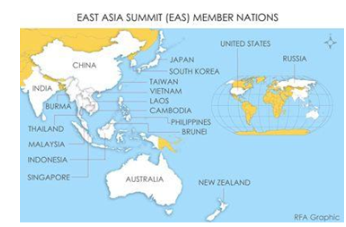
- Rise of new security institutions like the Quad, the AUKUS that brings together Australia, Britain, and the US, and the trilateral compact in Northeast Asia between the US, Japan and South Korea.
- Decline in centrality of ASEAN: ASEAN-led regional institutions struggle to cope with China’s aggressive territorial expansionism. Furthermore rise of security institutions raises questions about continuing centrality of the ASEAN in shaping the regional order in Asia
- Economic Diversification: Nations like Japan and the US are trying to reduce their economic dependence on China by diversifying trade partnerships.
- Increased engagement of India with USA: It became clear that it was in the interest of India to have a “unipolar world” led by the US, rather than a “unipolar Asia” dominated by Beijing.
Features of New Multilateralism
- Regional stability through Quad Collaboration: At the Jakarta meeting, India emphasised that Quad is not in competition with ASEAN but will complement its efforts to promote regional stability through more bilateral and minilateral security cooperation.
- Re-globalization: India is focusing on a diversified and democratic globalisation characterised by multiple centres of production and not just of consumption.
- Push for collective solutions despite crisis in multilateralism: India’s G-20 efforts to pursue a range of consequential issues, like modernising the global tax regime and reforming the multilateral development banks.
- Voice of Global South: India prioritises the concerns of the Global South in the G-20 agenda, aiming to enhance cooperation between developed and developing nations, rather than reviving old confrontational politics.
India-Middle East-Europe Corridor: Catalyst to new world order
Exam View: About IMEC; Movement of Goods through IMEC; Significance of IMEC
Context: The signing of MoU for development of India-Middle East-Europe Corridor during G20 has been a landmark event. It has immense potential to put India, Middle East and Europe on collective path to growth, triggering regional and global cooperation
About India-Middle East-Europe Corridor (IMEC):
|
Features |
Description |
|
Name |
India-Middle East-Europe Corridor |
|
Type |
Multimodal trade and transit corridor |
|
Objective |
Promote trade and investment between India, the Middle East, and Europe |
|
Route |
The corridor will connect India to Europe through the Middle East. The exact route is still being finalised, but it is expected to pass through countries such as Iran, Turkey, Greece, and Bulgaria. |
|
Modes of transport |
The corridor will use a mix of road, rail, and sea modes of transportation. |
|
Status |
The corridor is still under development. However, a number of projects have been completed or are underway, such as construction of new roads & railways. |
|
Key projects |
The Chabahar Port in Iran The International North-South Transport Corridor (INSTC) The Baku-Tbilisi-Ceyhan (BTC) pipeline Jordan-Haifa Land Route |
Movement of Goods through IMEC:
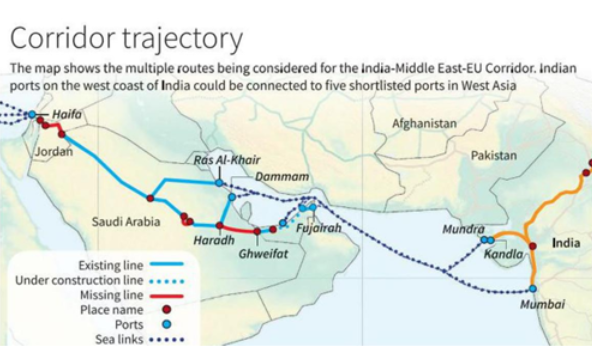
- India to Arabian Gulf (Sea Route): IMEC links major ports of western India including JNPT, Kochi, Kandla and Mundra with major shipping ports of the Gulf, including Jebel Ali, Fujairah, Ras Al-Khair, Dammam, Duqm, and Salalah.
- Gulf ports to West Asian ports on the Mediterranean (Land Route): From these ports, cargo will be transported by the Saudi rail network on their north-south line to the port of Haifa in Israel through Jordan.
- Mediterranean Ports to European Ports (Sea Route): Haifa, being a deep seaport, can handle bulk container trains and carry cargo to European ports like Piraeus, Kavala (Greece), Trieste, La Spezia (Italy), Marseille-Fos (France), Barcelona, and Valencia (Spain).
- European Ports to hinterlands of Europe (Land Route): Road container trailers or container cargo trains will thereafter transport goods across Europe.
Significance of IMEC:
- Economic Benefits: IMEC is expected to boost trade and investment between India, the Middle East, and Europe, leading to economic growth and job creation.
- Reliable and Cost Effective transport solution: It envisions a reliable, cost-effective railway and ship-to-rail transit network to supplement maritime and road routes, enabling goods and services to move between India, the UAE, Saudi Arabia, Jordan, Israel and the EU.
- Reduce transportation time due to shorter routes as compared to Suez Channel route, making it more efficient to move goods and services between these regions.
- Development of Infrastructure: This proposed economic corridor project would help deal with the lack of infrastructure needed for growth in lower and middle-income nations
- Promotion of Intra-regional Connectivity: It will promote Intra-regional connectivity and enhance trade, prosperity and connectivity.
- Geopolitical Benefits: IMEC provides connectivity to accelerate the development and integration of Asia, the Arabian Gulf, and Europe as a new locus of global power.
- IMEC will also enhance India's strategic position in the region, giving it a greater say in global affairs.
- Reduction of dependence on Suez Canal, a major chokepoint in global trade.
- Counter to Chinese Belt and Road Initiative (BRI): India Middle East Europe Corridor (IMEC) is an ambitious counter to China’s BRI project.
- Geopolitical Stability in Middle East: This Corridor will help to bring countries in the Middle East together and establish that region as a hub for economic activity instead of as a “source of challenge, conflict or crisis”
- Environmental benefits:
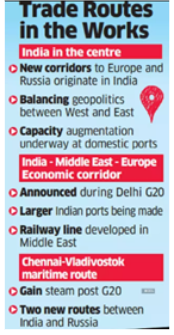
-
- Hydrogen Fuel pipelines: IMEC, envisages the laying of cables for electricity and a pipeline for transporting clean hydrogen. The greening of this project will contribute to the global effort to lower greenhouse gas emissions.
- Reduced fuel usage due to decreased travel time because of shorter routes and consequently lesser pollution.
Challenges for IMEC
- Non-binding MoU: The MoU of IMEC does not create any rights or obligations under international law, and is only a political commitment.
- Implementation challenges: Early implementation and construction of the corridor is a challenge due to the need to develop and commit to an action plan with relevant timetables.
- Financial Sourcing: The corridor would require massive finance for its construction, which is a challenge considering the recession and difficulty in mobilization of private sector finance.
- Chinese resistance: The corridor faces the challenge of Chinese pushback as China has already invested heavily in the BRI project and is making considerable investments in the Middle East.
Source: https://epaper.indianexpress.com/3764158/Delhi/September-19-2023#page/13/2
G-20 diplomacy and shifting world order
Exam view: India’s successes in G20; China’s perception, need for caution; Emerging world disorder.
Context: Euphoria about the G-20 outcome under India’s presidency needs to be tempered given the many dark clouds on the global horizon despite India’s amazing success in producing a consensus Declaration.
Decoding the editorial: India’s successes in G20
- Consensus on the Russia-Ukraine war.
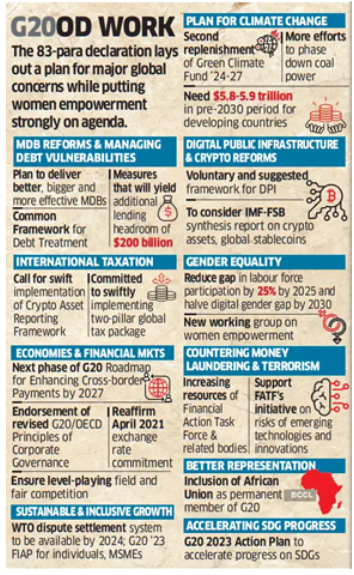
-
- Consensus on the Ukraine conflict became possible with the West agreeing to ‘climb down’ from its demand not to point fingers at Russia for the Ukraine conflict, and giving up on the insistence to proclaim Russia as guilty.
- The difference between two Declarations is that while Bali was accusatory in tone, New Delhi sought a resolution to the conflict.
- Russia and China have since hailed the New Delhi Declaration in sharp contrast to their criticism of the Bali Declaration.
- The New Delhi Declaration has something for everyone.
- The establishment of an India-Middle East-Europe Economic Corridor Plan.
India, as the host, could rightfully take a large measure of credit for this result. However, India, for its own sake, has to be wary, given the fluid situation across the globe with China’s perception and the return of two blocks.
China’s perception, need for caution
- G20 is not a platform for resolving geo-political and security issues.
- China might have welcomed the Delhi Declaration, but there is inherent foreboding in its affirmation that the G-20 was intended to be a ‘forum for economic cooperation’.
- India-Middle East-Europe Economic Corridor Plan should not become a geo-political tool.
- While welcoming the establishment of an India-Middle East-Europe Economic Corridor Plan, China has sent an implicit warning that it should ‘not become a geo-political tool’.
- India remains an obvious target for China and is in its ‘cross-hairs’.
- While many in the West view China’s situation of ‘debt deflation and demographic decline’ as an opportunity, they remain oblivious to the reality of China’s known capacity to resort to various means to overcome its problems.
- The West’s acknowledgment of India's growing economic strength, and India’s membership of the Quad, call for abundant caution on India’s part, since China is unlikely to take kindly to either.
Emerging world disorder
- The ‘rules-based world order’ has become a ‘catch-all phrase’ of merely one segment.
- There is a return of two antagonistic blocs, and shrinking space for the non-aligned.
- The U.S. is strengthening and expanding the North Atlantic Treaty Organization (NATO).
- It has been encouraged by the stalemate in the Ukraine conflict and the eclipse of Russia’s hope of a quick walkover in Ukraine.
- A new NATO is set to become even more dependent on the U.S. for military supplies and capabilities.
- Outside Europe, a number of non-NATO allies are being inveigled to join a U.S.-led alliance to counter ‘authoritarianism’ (represented by Russia and China).
- Russia and China, in turn, are deepening their ‘strategic alignment’.
- Countries such as North Korea are cementing their relations with this bloc.
- China is exploiting its frontage in the Pacific Ocean to openly challenge U.S. naval power here.
- Russia and Türkiye have deepened their relationship based on shared interests.
- Russia is once again seeking to expand its footprint in Africa, and Russia’s recent agreement to supply food grains to African States at subsidised prices, or even for free, is aimed towards this end.
- Fading non-alignment
- It is proving increasingly difficult for countries to remain non-aligned in the truest sense of the word.
- Even existing formations such as BRICS (Brazil, Russia, India, China and South Africa) are tending to find the situation untenable.
- Given the multiplicity of relationships and the ‘lattice work’ of security agreements that have emerged, the space for non-alignment has dramatically shrunk.
With the strengthening of rival camps holding divergent visions of the international order, the world confronts a dismal future.
Gap Between Law and Justice - Edukemy Current Affairs
Exam View: Criminal laws in India; Basis of criminal laws: Universal individualism; Ignored in criminal laws: Social production; Need for reimagining the criminal justice system; Way forward.
Context: The Indian Penal Code, 1860 will be replaced by the Bharatiya Nyaya Sanhita Bill, 2023, the Criminal Procedure Code, 1898 will be replaced by the Bharatiya Nagarik Suraksha Sanhita Bill, 2023 and the Indian Evidence Act, 1872 will be replaced by the Bharatiya Sakshya Bill, 2023.
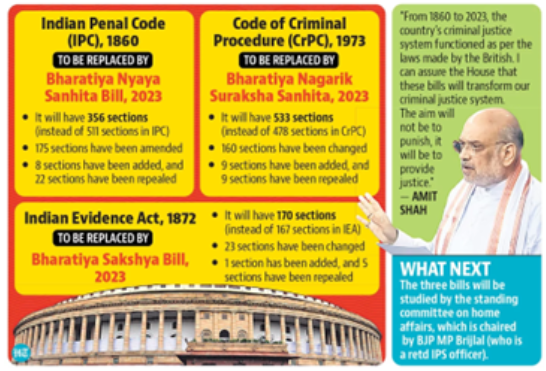
Decoding the editorial: Criminal laws in India
- Strengthening law and order is the intended aim of the new bills, according to the statement of objects and reasons.
- The Bills assume that the law can maintain “public order” by reducing crimes.
Basis of criminal laws: Universal individualism
- The system of criminal law in India is premised on the idea of Universal individualism.
- Under this, the responsibility for crimes lies solely with individual offenders.
- It universally ascribes free will and complete autonomy to all individuals over their decisions, irrespective of their social context.
- But the role of criminal law in achieving this goal is often exaggerated.
- With its exclusive focus on blaming and punishing individual offenders for crimes, criminal law obscures the socially rooted nature of crimes.
Ignored in criminal laws: Social production
- A person’s decision making process and their ability to cope with risks is greatly influenced by their environmental factors.
- Environmental factors like socio-economic status, social upbringing, education, family and friendships, interact with individual psychological and biological factors and influence individual responses to different situations.
- Understanding the dynamics of the social production of crime raises difficult questions about the obsessive and singular focus of criminal law on individual criminal responsibility.
- In fact, the continued prevalence of many crimes is deeply influenced by the socio-cultural realities of our society.
- For instance, the rape culture in our society is a constant and violent reminder of this dynamic.
Need for reimagining the criminal justice system
- The main purpose of the law and order discourse is “demonstrative rather than substantive.”
- Adopting the legislative reform route offers the illusion of strict action from the state without any worthwhile and long-term efforts towards addressing real problems that plague the criminal justice system.
- The potential of criminal law is grossly overstated as it routinely blames individual for crimes.
- It also hides the operations of power that characterise criminal justice administration.
- Along with selective criminalisation and arbitrary application, the disproportionate impact of the force of criminal law on the poor, the vulnerable and the powerless is well-documented across the world and India is no exception to that.
- Therefore, any claims about the neutrality of criminal law and its administration is suspect.
- The strenuous tensions between law and justice play out in violent terms in the context of criminal law.
Way forward
- Invoke the framework of “criminal justice” rather than the significantly narrower idea of “criminal law”.
- The legislative reforms can play an extremely limited role in preventing crimes and strengthening law and order.
- The law, by itself, can deliver very little of the reforms we need.
- Fundamentally reconfigure institutions that play a role in delivering criminal justice.
- A reconfiguration that is sufficiently invested in fairness, justice, and being effective for both victims and accused persons.
- Our system fails victims and survivors as much as it fails accused persons and mere legislative changes will not change that.
- The institutional imagination of our police, investigation mechanisms, criminal courts, prosecution and defence services, prisons, and support services in criminal justice administration needs urgent and fundamental reconsideration if we are truly interested in an “overhaul”.
Apart from that widespread textual borrowing, there is no overhaul in the approach to criminal law or criminal justice that the new Bills seek to usher in. The empty rhetoric of “overhaul” and “decolonisation” seek to convey something that these Bills come nowhere close to delivering.
Source: https://indianexpress.com/article/opinion/columns/gap-between-law-and-justice-8954360/
Green path to G20 development goals
Exam View: The Leaders’ Declaration; Green Development Pact; Foundations of the Pact; The four-part relay.
Context: The new GDP, Green Development Pact, can serve as a bridge between the Global South and the North.
Decoding the editorial: The Leaders’ Declaration
- In the G20 Leaders’ Summit, the adoption of the Leaders’ Declaration on the first day.
- It is a sign that India could bridge divisions and deliver a cooperative and collaborative outcome, rather than a combative stalemate, at a time when multilateralism seemed particularly fractured.
- The 83-paragraph Declaration, with consensus among all member countries, underscores peace, prosperity, people and the planet, and bringing it all together is an important pact.
Green Development Pact
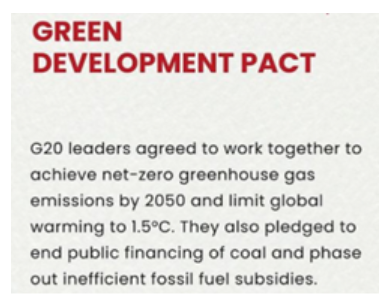
- The G20 comprises the world’s largest economies accounting for over 80% of global gross domestic product (GDP).
- Through the Leaders’ Declaration, however, New Delhi has given “GDP” a new meaning, a Green Development Pact.
- This does not choose between development and environment but seeks to align people-centric growth with planetary sustainability.
Foundations of the Pact
- It focuses on resource efficiency and sustainable consumption.
- The G20 unanimously adopted the High Level Principles on Lifestyles for Sustainable Development.
- It’s a push for sustainable lifestyles to lower our resource footprints and it sends out the signal to create circular economies at scale, from metals and minerals to plastics and packaging.
- The emphasis on an inclusive energy transition.
- This is crucial for bringing the energy transition closer to people.
- The pact endorses a target to triple renewable energy capacity and notes the voluntary action plan to double the rate of improvement in energy efficiency by 2030.
- It announces a Global Biofuels Alliance.
- It seeks transparent and resilient global markets for hydrogen.
- And it calls for diversified and responsible supply chains for critical minerals and semiconductors.
- It focuses on climate and sustainable finance.
- The Leaders’ Declaration finally endorses the need for trillions of dollars for the billions of people living in the Global South, in particular $5.9 trillion needed by developing countries to achieve their climate targets by 2030, as well as $4 trillion needed per year for clean energy.
- Recognising the importance of leveraging the role of multilateral development banks, the pact calls for blended finance and risk-sharing facilities.
- It links the triple planetary crises by drawing attention not only to the climate crisis but also reducing plastic pollution and preserving biodiversity.
- These include the G20 Global Land Initiative to reduce land degradation, the HighLevel Principles for a Sustainable and Resilient Blue/Ocean-based Economy, and sharing of best global practices on water.
- It focuses on building disaster-resilient infrastructure.
- India introduced a Disaster Risk Reduction Working Group into the G20.
- It will be incumbent on member countries, all of whom have faced weather extremes, to ensure robust early warning systems and include people as stakeholders in and enablers of resilient infrastructure.
The four-part relay
- While there is a language to phase down unabated coal power, efforts to get an agreement on a phase-down of all fossil fuels could not get consensus.
- If these seeming contradictions have to be squared, the G20 Leaders’ Summit must be viewed as the first leg of a four-part relay.
- India has kicked off this race with a comprehensive Leaders’ Declaration, which includes the Green Development Pact.
- The next leg is the UN General Assembly and the UN SDG Summit next week, when non-G20 leaders can propose their visions for doubling down on the energy transition and climate sustainability.
- Next, the baton will pass to the World Bank annual meetings in Marrakech in October.
- G20 leaders have called for the reform of the MDBs.
- Close to $200 billion of additional lending could be possible with the proposed reforms.
- The anchor of the race will be the COP28 climate meetings in Dubai in November-December.
There is a need for effective multilateralism and hard resources to show solidarity with the vulnerable and commit to the planet.
Source: https://epaper.hindustantimes.com/Home/ShareArticle?OrgId=1597b5de6bd&imageview=0
PM-PRANAM - Edukemy Current Affairs
Context: Promoting PRANAM will help the government reduce subsidy bills and fiscal deficits if it picks up.
Decoding the editorial: PM-PRANAM
- Union Budget 2023–24 launched the PM-PRANAM (PM Programme for Restoration, Awareness, Nourishment and Amelioration of Mother Earth).
- Its objective is to promote the balanced use of chemical and alternative fertilizers, generating awareness of regenerative agriculture (RA).
- It has no separate budget. A 50 percent subsidy savings will be provided to States/UTs.
- Most of it will likely be used for infrastructure creation and (green) technology innovation.
- The rest will be paid as incentives to farmers, panchayats, FPOs, and SHGs who can help reduce input costs and generate awareness toward RA adoption.
Regenerative agriculture
It is an outcome-based food production system that
- Nurtures and restores soil health;
- Protects the climate;
- Restores the water resources and biodiversity; and
- Enhances farms’ productivity and profitability.
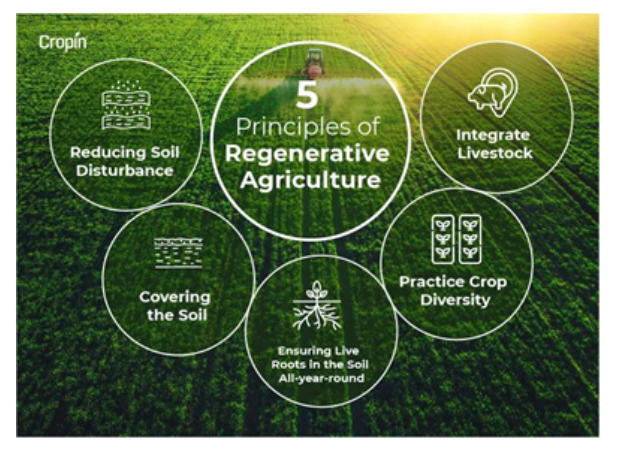
Plusses and minuses
- Minus: The subsidy burden on chemical fertilisers is high.
- It is at about ₹2.25-lakh crore for FY 2022-23, which is 39 percent higher than FY 2021-22’s figure (₹1.62-lakh crore).
- The subsidy bill has increased significantly even though fertiliser consumption shows that nitrogenous fertiliser consumption, especially urea, has not declined from 2012-13 until 2021-22 (P).
- Plus: Promoting PRANAM will help the government reduce subsidy bills and fiscal deficits if it picks up.
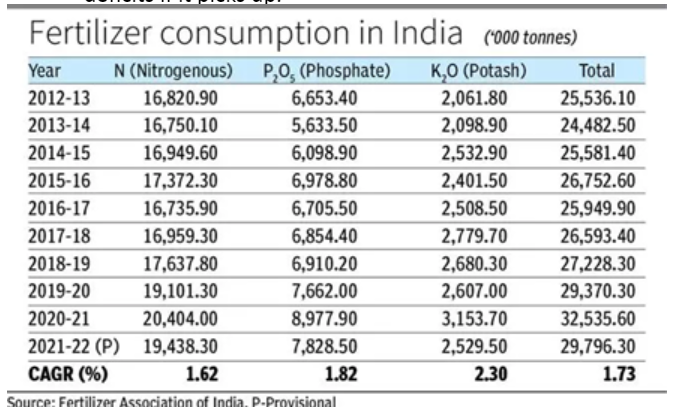
- Minus: The low efficacy of alternative fertilisers to enhance crop yield could slow its adoption.
- Plus: A gradual phase-out of subsidies on chemical fertilisers can stimulate alternative or bio-fertiliser adoption.
- The retention pricing scheme, which safeguards chemical fertiliser (urea) manufacturers, can be phased out to promote alternative fertiliser production.
- Minus: Knee-jerk reaction of chemical fertiliser firms.
- A 12 percent return on the fertiliser (chemical) firms fixed under the retention scheme will disappear, possibly resulting in a knee-jerk reaction of chemical fertiliser firms for their survival.
- Plus: Farmer fertiliser cooperatives can exploit this as an opportunity since they have been into biofertilizer production, although on a small scale, since 2009-10.
- PRANAM can increase its economies of scale and help the existing distribution network stock alternative fertilisers.
- However, the margin on bio-fertiliser sales should be worked out to incentivise sales and distribution networks.
- Minus: Awareness regarding alternative fertilisers is low. Demonstrating alternative fertilisers on farmer fields is critical, especially after the Sri Lankan food crisis, to showcase higher productivity, and certification of such products can help farmers or their organisations realise a remunerative price. Plus:
- Plus: To this end, 10,000 Bio-Input Resource Centres will be set up over the next three years, creating a national-level distributed micro-fertiliser and pesticide manufacturing network.
Ridding India of food insecurity
Exam view: Food insecurity; Failed macroeconomic policy; The significance of the Green Revolution; Initiatives to work on.
Context: Ensuring that Indians have permanent access to a healthy diet is the most important task of economic policy today.
Decoding the editorial: Food insecurity
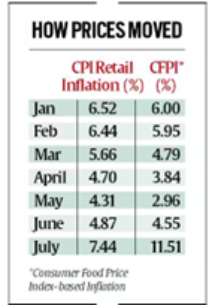
- The ‘State of Food Security and Nutrition in the World’ of the Food and Agriculture Organization (FAO) estimates the figure for India in 2021 is devastating:
- An estimated 74% of the population cannot afford a healthy diet.
- Given a population of 1,400 million, this makes for approximately one billion Indians.
- The trend in the price of food in Mumbai city over 2018-2023 found that while the cost of preparing a thaali at home has risen by 65%, in this period, the average wage of a manual worker rose by 38% and that of a salaried worker by 28%.
- The implied reduction in purchasing power is considerable, and it would be reasonable to expect that food consumption has been impacted.
- The latest National Family Health Survey undertaken over 2019-21 reported a rise in the prevalence of anaemia, mostly induced by nutrient deficiency, which is in line with the above findings.
- This suggests that the FAO’s finding, that over half of India cannot afford a healthy diet, is plausible.
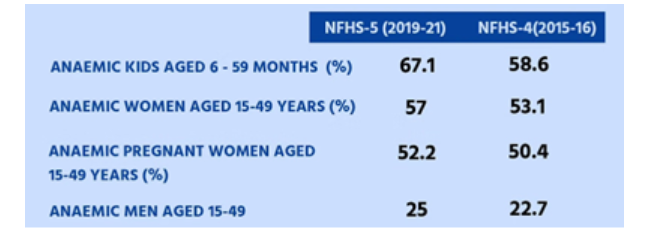
Failed macroeconomic policy
- It relied on controlling inflation, which has proved to be useless in the context.
- The Reserve Bank of India has failed in this task, with the inflation rate mostly higher than the target for four years by now.
- Its approach of contracting output when the inflation rate rises, misleadingly termed “inflation targeting”, does nothing to manage food inflation stemming from the supply side.
- It is necessary to intervene on the supply side to ensure that food is produced at a steady price by raising the yield on land.
The significance of the Green Revolution
- The government engineered a Green Revolution in the 1960s, which orchestrated a supply-side response by providing farmers with high-yielding seeds, cheap credit, and assured prices through procurement.
- Some mistakes were made:
- The rampant use of chemical fertiliser, fuelled by subsidy, which degraded the soil.
- There was also the reliance on procurement prices rather than productivity increase to ensure farm incomes, which fuelled inflation.
- The policy was almost exclusively focused on cereals rather than pulses, the main source of protein for most Indians.
- India should be focused on correcting these mistakes now and lowering the cost of producing food.
- The first Green Revolution had a specific agenda of making India self-sufficient in food.
- A second agricultural revolution is needed now to contain the rising price of food.
- Procurement prices, cash transfers, the Public Distribution System, and priority lending required of public sector banks are not sufficient.
- Yield increasing interventions on the farm are needed to at least contain the cost of production, if not to actually lower it.
Initiatives to work on
- Attention is needed to extend irrigation to 100% of the net sown area.
- Increased public expenditure on irrigation is not reflected in an increase in irrigated area, whether due to waste or the diversion of funds has not been established.
- An end to restrictions on leasing of land.
- The ongoing fragmentation of already small land holdings lowers the capacity for productivity-enhancing capital investment, for which leasing is a solution.
- A quickening of agricultural research.
- India’s network of public agricultural research institutes needs to be energised to resume the sterling role they had played in the 1960s.
- The re-institution of extension.
- Finally, extension has now more or less vanished from where once the gram sevak was a familiar figure in the village, playing a crucial role in the dissemination of best practices. It must be revived.
- Promoting cooperative federalism.
- In the 1960s, the States that were chosen for the spread of the new technology worked closely with the central government.
- This would have to be replicated with the central government taking the States along in a spirit of cooperative federalism.
- At the same time, it may be asked if the States are playing their part to enhance agricultural productivity rather than relying on food allocations to their Public Distribution System from the central pool.
In order to ensure that all Indians have permanent access to a healthy diet, no approach consistent with ecological security must be off the table.
Source: https://www.thehindu.com/opinion/lead/ridding-india-of-food-insecurity/article67296175.ece
Propelling India’s development
Exam View: Aiming for the moon; Criticism of the moonshot development strategy; Inequalities, a hurdle for progress; Reinstate state support.
Context: India must redouble efforts to make economic growth more inclusive and broad-based.
Decoding the editorial: Aiming for the moon
The momentous steps India had taken in the decades immediately after Independence may be characterised as a ‘moonshot’ approach to development deploying, modern industrialisation to shake off the ills of the past.
- Space research: When India started space research in the 1960s, many thought it was being reckless as India was sinking some of its limited resources in a highly uncertain enterprise.
- This year, India became the first nation to land a rover on the south pole of the moon, followed up with a mission to study the sun.
- Technical institutes: Between 1951 and 1961, India established five Indian Institutes of Technology, which in no time grew into globally respected academic centres.
- The first two Indian Institutes of Management were inaugurated in 1961.
- Public Sector Industries: During the two decades of the 1950s and 1960s, a number of public sector units were established in diverse areas of industrial production.
- It included steel, fertiliser, machine tools, electric machinery, drug production, and petrochemicals.
- Private enterprises: The technological capabilities built through state support provided the base for the flourishing of private enterprise in many sectors.
- Professionals, who were earlier trained in India’s public universities, have found leadership positions globally, which has deepened India’s strategic importance.
Criticism of the moonshot development strategy
- The time needed for a new technology to come to fruition is too long.
- It is not only that the benefits from a technology are long in coming, but they are also difficult to be kept exclusive for private profiteering.
- Its heavy reliance on public investment.
- It is precisely because of the ‘public good’ nature of technologies that public sector support becomes crucial for developing them.
- Even the Internet emerged from a research programme funded by the United States government, with military objectives, in the late 1950s.
- However, this investment did not waver for lack of short-term commercial viability.
- The investments being ‘misdirected’.
- Being a labour surplus country, India should have stuck to its comparative advantages in labour-intensive industries, such as garments or footwear.
Inequalities, a hurdle for progress
The lacklustre record for India’s development strategy was not on account of the government doing too much in the area of technology building. It was because the state or the government could not intervene effectively to reduce inequalities.
- Unsuccessful land reforms:
- Ownership of assets continues to be very low among the socially oppressed communities, including Dalits or the Scheduled Caste (SC) population.
- Lack of access to education:
- The lack of assets translate into hurdles in acquiring education, given that India has consistently underinvested in basic education for the masses.
- Unequal labour market:
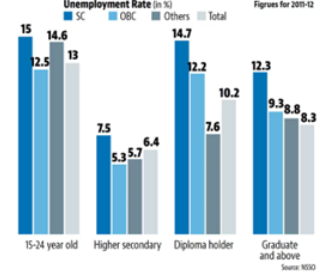
-
- The historically determined inequalities in the social spheres get replicated in the labour market.
- In 2021-22, 38.2% of all SC workers were ‘casual’, earning their livelihoods mostly out of hard manual labour; the corresponding proportion was 11.2% for workers belonging to the (‘other’) general category castes (Periodic Labour Force Survey data).
- Lopsided industrial and economic growth:
- Domestic demand comes largely from the upper income classes, who constitute only a small, though substantial in absolute numbers, segment of the population.
- This has slowed down the growth of manufacturing of high-quality, mass-consumption goods, including food products and garments.
- Entrepreneurship too has emerged from a narrow social base.
Reinstate state support
- India must reinstate technological efforts to stand a chance in fast-growing economic fields, be it semiconductors or biotechnology.
- India must reinstate support for its industries.
- After 1991, India abandoned planning for industrial growth assuming, mistakenly, that there is no role for industrial policy in a globalised economy.
- Both the United States and China are lavishing government support for their industries.
Creative industries can boost economies
Exam View: Creative industry in India; Boosting economies: India and the UK.
Context: Arts and culture exchanges between India and the UK contribute to economic growth and foster understanding between cultures.
Decoding the editorial: Creative industry in India
- Prime Minister (PM) in his opening address to the G20 Culture Ministers’ summit in Varanasi spoke of the value artists and craft workers contribute to the economic success of creative industries.
- The G20 Leaders Declaration emphasizes how culture is a key driver of the SDGs.
- The Nataraja, a statue of Hindu lord Shiva as the cosmic dancer, installed next to 'Bharat Mandapam', the main venue of the G20 Summit, is pictured in Delhi.
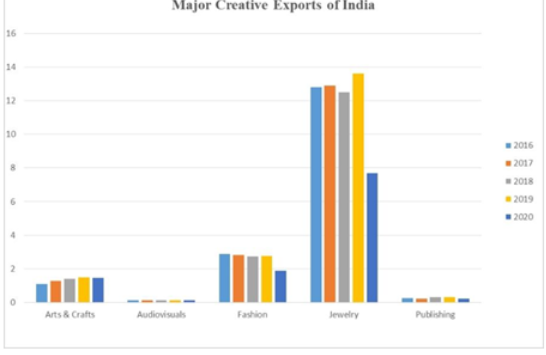 Boosting economies: India and the UK
Boosting economies: India and the UK
- Cultural exchange: Arts and culture make tangible the “living bridge” between these countries.
- India’s Symphony Orchestra is touring concert halls across the UK later this year.
- The renowned Aditi Mangaldas dance company is premiering its new dance show at Sadler’s Wells Theatre in London in October.
- Aakash Odedra from Leicester, UK will be performing in Delhi as part of a new series of events led by the Kiran Nadar Museum of Art.
- The recent partnerships with the UK’s science museum group and the National Council for Science Museums for an exhibition on vaccines and their evolution.
- It shows how the mutual exchange of skills, talent, and creativity can enrich lives in India and the UK.
- It is a first-of-its-kind creative fellowship for skills exchange to develop young art talent in Scotland and India between Edinburgh Printmakers and Flow India, the Natural History Museum, and the Bihar Museum.
- The “Econario” sculpture graces the G20 Together We Art exhibition.
- Economic benefits: The contribution of the individual artists and those who support them to the economy should not be underestimated.
- In the pre-Covid period, India’s creative industries contributed 2.5% to India’s Gross Domestic Product (GDP) and the UK’s creative industries contributed 6% to the UK’s GDP.
- The UK's creative industries have grown 1.5 times faster than other industry sectors in the past decade.
- In Bengaluru and Hyderabad, the growth in tech, arts, gaming, and Artificial Intelligence coupled with India’s rapid digital transformation over the last five years has led start-ups to scale up.
- This is echoed in the UK government’s vision for creative industries which aims to add one million jobs in MSMEs and creative start-ups by 2030, an increase of 43%.
- Collaborations:
- The UK can learn from the sustainable practices of the Indian arts sector and from the cultural practices in Indian cities.
- The India-UK collaboration in the creative sectors has great potential to inform cultural policy development for the future.
- The British Council is enabling enduring connections between both countries catalyzing this exchange.
- The UK minister of arts and heritage, had met cultural policymakers, artists, and arts sector leaders in Delhi before heading to the G20 Culture Ministers meeting in Varanasi in August.
The creative economy is set to get a huge boost with the culture ministry’s G20 vision for One Family working together to deepen opportunities for all through the cultural industries and the UK’s longstanding commitment to India.
Source: https://www.hindustantimes.com/opinion/creative-industries-can-boost-economies-101695402454143.html
State of Working India (SWI 2023) report
Exam View: State of Working India (SWI 2023) report; The findings; The 2017-2021 period; India’s growth strategy.
Context: A new report is out called the State of Working India (SWI 2023) and it has used official employment and unemployment data to understand how economic growth impacts employment.
Decoding the editorial: State of Working India (SWI 2023) report
- It has been brought out by the Centre for Sustainable Employment within the Azim Premji University (APU).
- The report stands out because APU academics and researchers have used official employment and unemployment data to arrive at the results.
- This is the fourth edition of SWI and it focuses on “a long-run view of India’s structural transformation experience and its implications for three key social identities: caste, gender, and religion”.
- SWI 2023 analyses data from 1983 to 2023 and uses a whole host of official data sources including
- Periodic Labour Force Surveys (PLFS),
- National Family Health Surveys (NFHS),
- Census 2011, and
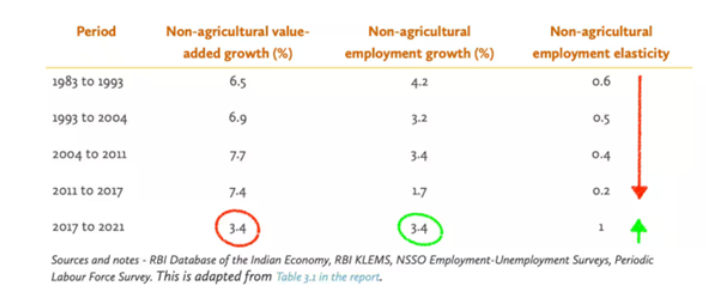
-
- Economic Census 2013.
The findings
- The impact of economic growth on employment in the aggregate.
- A good way to measure this relationship is to look at employment elasticity of growth.
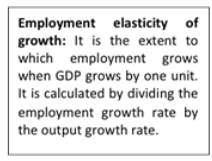
-
- As can be seen in TABLE 1, employment elasticity has consistently fallen between 1983 and 2017, showing that a 1% increase in GDP leads to a less than 1% increase in employment.
- The table shows that since the 1980s, non-farm output, that is GDP from sectors other than agriculture, consistently grew much faster than non-farm employment.
- The impact of economic growth on different segments of the Indian economy.
- As data shows, factors such as caste, religion, age and gender tend to have a considerable impact on how the benefits of growth get distributed in the economy.
- The need to appreciate the quality of the jobs being created.
- For instance, providing “casual labour” at an MGNREGA worksite or a construction worksite or working part-time in one’s family enterprise without any pay (“self-employment”) are very poor substitutes for holding a job that provides a regular wage.
The 2017-2021 period
- The employment elasticity went up sharply during this period. However, this simple observation can be misleading, as observed by APU.
- There has been a fall in output growth.
- The non-farm employment growth rate improved during this period, but
- The non-farm output growth (the denominator in this formula) also fell quite sharply.
- The quality of jobs has fallen.
- When the economy does well and employers find it worthwhile to create new jobs, the kind of jobs that are created are regular wage jobs or, at least, casual labour jobs.
- But instead, what has been created in this phase is self-employment.
- This is the kind of work that pays no regular wage with the remuneration distinctly below other categories of jobs.
- Between 2017 and 2021, there was a slowdown in overall regular wage job creation but formal jobs (with a written contract and benefits) as a share of all regular wage work rose from 25% to 35%.
- In 2020-21 (pandemic year) regular wage employment fell by 2.2 million.
- The biggest losers in the process were the women.
- While half of the lost employment is accounted for by women, only a third of the increase in formal employment accrued to women.
- So in net terms, women lost out on formal employment in this period. Not only that, there was a shift towards self-employment due to distress.
India’s growth strategy
- Different experts have different solutions for India
- Doubling down on boosting labour-intensive manufacturing, even if it is for just domestic consumers.
- Shifting to “green” manufacturing can provide India with an opportunity to redo the industrial revolution.

- A framework for a National Employment Policy was outlined in the previous (2021) SWI report.
One Health - Edukemy Current Affairs
Exam View: Climate change, more infections; Surveillance and reporting; One Health.
Context: In its latest report, the Intergovernmental Panel on Climate Change (IPCC) delivers a stark warning that climate change heightens the global risk of infectious diseases.
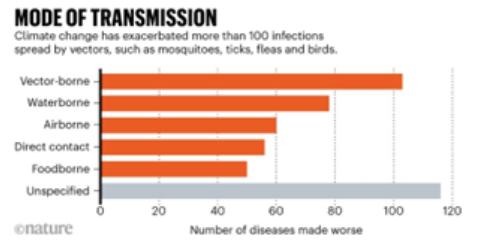
Decoding the editorial: Climate change, more infections
- Mosquito-borne disease outbreaks:
- The periodicity no longer follows expected patterns.
- Dengue manifests in two to three peaks throughout the year.
- Variability in temperature, precipitation, and humidity disrupt disease transmission cycles.
- These also alter the distribution of the vectors and animal reservoirs that host the parasite.
- Heat has been proven to interfere with the genomic structure of pathogens, changing their infectivity and virulence.
- Human-animal interaction:
- Habitat loss forces disease-carrying animals to encroach upon human territory, increasing the risk of human-animal interaction and the transfer of pathogens from wildlife to humans.
- Viruses which do not harm animals can be fatal for humans.
- Nipah virus, which has been causing outbreaks in Kerala for many years now, is a good example.
- Infectious diseases:
- An analysis of 2022 published in Nature Climate Change warns that humans now face a broader spectrum of infectious agents than ever before.
- Over half of all-known infectious diseases threatening humans worsen with changing climate patterns.
- Diseases often find new transmission routes, including environmental sources, medical tourism, and contaminated food and water from once-reliable sources.
- Invasive species:
- While ecosystems shape local climates, climate change is transforming ecosystems.
- This dynamic introduces invasive species and extends the range of existing life forms.
- Both these trigger upheavals in ecosystems that are complex and confound ecologists and epidemiologists to predict outbreaks.
Surveillance and reporting
Over the past two decades, India has improved its reporting of outbreaks.
- The Integrated Disease Surveillance Programme (IDSP)
- It was rolled out in a few States in 2007.
- From reporting 553 outbreaks in 2008, it last reported 1,714 in 2017.
- The Integrated Health Information Platform (IHIP)
- IDSP was phased out in favour of a new, web-enabled, near-real-time electronic information system called IHIP.
- It was launched in seven States in 2018.
- It added 20 additional disease conditions over IDSP’s 13 and could present disaggregated data to its users.
- Tragically, the programme, which would have enabled real-time tracking of emerging disease outbreaks, has not delivered on expectations.
- The current design of surveillance is not adequate for the emerging disease scenario.
One Health
- Meaning:
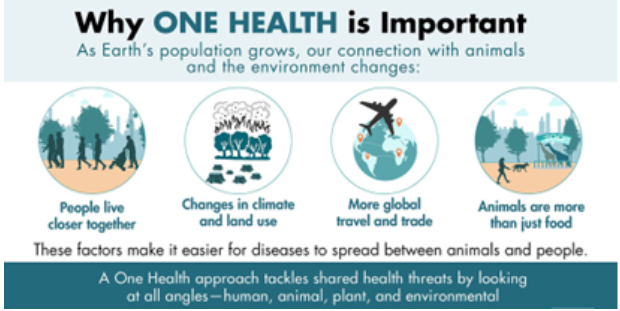
-
- A unified approach, termed One Health which integrates monitoring human, animal, plant, and environmental health, recognises this interconnectedness.
- Objective:
- This approach is pivotal in preventing outbreaks, especially those that originate from animals.
- It encompasses zoonotic diseases, neglected tropical diseases, vector-borne diseases, antimicrobial resistance, and environmental contamination.
- India’s strategy for one health:
- India must launch One Health and infectious disease control programmes by building greater synergies between the Centre and States and their varied specialised agencies.
- Animal husbandry, forest and wildlife, municipal corporations, and public health departments need to converge and set up robust surveillance systems.
- They will need to build trust and confidence, share data, and devise logical lines of responsibility and work with a coordinating agency.
- So far, the Office of the Principal Scientific Adviser to the Prime Minister has been taking this lead but with new World Bank and other large funding in place, this will need greater coordination and management.
Globally, there is an obsession with the enigmatic “disease X,” but it is the familiar annual cycles of known agents such as influenza, measles, Japanese encephalitis, dengue, diarrhoea among others that will continue to test the public health system. The re-emergence of Nipah in Kerala is a wake-up call, that mere biomedical response to diseases is inadequate. Embracing the One Health paradigm is our best defence.
Subverting the idea of India - Edukemy Current Affairs
Context: For the first time a high-level committee headed by a former President of India, has been set up to examine the proposal of simultaneous elections. The government’s ‘simultaneous elections’ agenda goes much further than the other ideas of ‘oneness’ it propounds; it will spell a deepening of centralisation.
Decoding the editorial: Simultaneous elections
- While several committees since 1999 have examined the proposal, the push to introduce and make permanent simultaneous polls once every five years has come over the past decade.

- This, however, is perhaps the first time that a high-level committee is headed by a former President of India, a most unusual appointment that is meant to impose a stamp of legitimacy on the recommendation.
The selling of a simplistic idea
- It is part of the “One India” agenda of the current government.
- It will save expenditure and help avoid the disruption of administration during elections.
- Evidence from one study conducted of voting percentages between 1971 and 2004 showed that voter turnout in the States is lower when Assembly elections are held separately from those to the Lok Sabha.
The truth
- The burden of government expenditure on elections is not so large. Governance does indeed become affected when
- The party holding office in New Delhi is forever in an election mode.
- The ruling party or coalition at the Centre refuses to take national decisions fearing what impact it will have in one State or the other.
- The ruling party sees every election from a municipal election upwards as a must-win poll.
- Disrupting the basic structure
- A higher voter participation should be increased through other means rather than with a set of measures that will turn parts of the Constitution upside down.
- A number of scholars and commentators have also pointed out that one way or the other, major constitutional changes will need to be made to the constitutional terms of the legislature and rules for unseating a government.
- After the first round of curtailing/extending the tenure of elected State governments, making simultaneous polls a permanent feature will require either fixed-term governments, or the end of no-confidence motions, or “super-majorities” to unseat governments, or greater powers in the hands of the President/Governors, or a combination of such drastic changes.
- The alterations will in effect change the Basic Structure of the Constitution.
- A project to wipe out diversity
- The entire “One Nation, One X” agenda is part of a political project with the message that only one government, one political party and one leader can deliver and will transform India.
- The “One Nation, One Election” agenda goes much further than “One Nation, One Tax”, “One Nation, One Ration Card” and the like in imposing this “oneness”.
- If implemented, it will permanently increase the administrative and political centralization of power in the hands of the Union Government and correspondingly weaken the States.
- All of this will reduce the importance of State governments, with the idea of federalism being given a body blow.
- There will be a corresponding concentration of power in New Delhi.
- There is the larger well-known ideological agenda of denying India its strength in heterogeneity.
As Y.V. Reddy, the chairman of the Fourteenth Finance Commission, pointed out, elections are meant to hold governments accountable for their record of governance, and yet when they turn out to be frequent they are being faulted for disrupting governance. Only the electorate that now has the power to decide if they want to live with this particular idea of “One India”.
Pragyan rover confirms sulphur
In News: Recently, Chandrayaan-3’s Pragyan rover has confirmed the presence of sulphur on the moon’s surface, near its south pole.
About:
- The Laser-Induced Breakdown Spectroscopy (LIBS) instrument onboard the Chandrayaan-3’s rover has made the first-ever in-situ measurements on the elemental composition of the lunar surface near the south pole.
- The analysis has also revealed the presence of elements like aluminium, calcium, iron, chromium, titanium, manganese, silicon, and oxygen on the lunar surface.
- The Pragyan rover is still actively searching for the presence of hydrogen.
Laser-Induced Breakdown Spectroscopy (LIBS)
- LIBS is a rapid chemical analysis technology that employs short laser pulses to create micro-plasma on a sample’s surface.
- The LIBS technique involves using intense laser pulses to analyse materials, creating hot and localized plasma whose emitted light is then studied to determine the material’s elemental composition.
- Advantages of LIBS:
- Requires no sample preparation.
- Offers rapid measurements, often within a few seconds.
- Covers a wide range of elements, including lighter ones.
- Supports versatile sampling protocols, including surface rastering and depth profiling.
BRIGHT STAR-23 - Edukemy Current Affairs
In News: An Indian Air Force (IAF) contingent is participating in Exercise BRIGHT STAR-23, a multilateral, tri-service exercise hosted biennially at Cairo (West) Air Base, Egypt.
About:
- Exercise BRIGHT STAR is a biennial multilateral tri-service exercise.
- This multinational exercise was launched in 1980 as part of the US-brokered peace treaty between Egypt and Israel.
- This marks the first time that the IAF is participating in Ex BRIGHT STAR-23, joining contingents from the United States of America, Saudi Arabia, Greece, and Qatar.
- The Indian Air Force contingent will consist of five MiG-29, two IL-78, two C-130 and two C-17 aircraft.
- Personnel from the IAF's Garud Special Forces, as well as those from the Numbers 28, 77, 78 and 81 Squadrons, will be participating in the exercise.
- Objective:
- To practice planning and execution of joint operations.
- Besides leading to the formation of bonding across borders, such interactions also provide a means to further strategic relations between participating nations.
Other exercises between India and Egypt:
- Exercise Cyclone-I:
- It Is a bilateral exercise between the special forces of the Indian Army and the Egyptian Army.
- The first edition of the exercise was held in Jaisalmer, Rajasthan in January 2023.
Also in the News:
- AUSINDEX-23 is a biennial maritime exercise between the Indian Navy and Royal Australian Navy.
Mass protest in Barcelona against possible amnesty for Catalan separatists
In News: Tens of thousands demonstrate in Spanish region’s capital as Pedro Sánchez weighs move in attempt to form government.
Barcelona, city, seaport, and capital of Barcelona provincia (province) and of Catalonia comunidad autónoma (autonomous community), northeastern Spain, located 90 miles (150 km) south of the French border. It is Spain’s major Mediterranean port and commercial centre.
About Catalonia
- Catalonia is an autonomous community in the north-eastern corner of Spain.
- Catalonia consists of four provinces: Barcelona, Girona, Lleida, and Tarragona.
- It is bordered by France (Occitanie) and Andorra to the north, the Mediterranean Sea to the east, and the Spanish autonomous communities of Aragon to the west and Valencia to the south.
- Since the 2010s there has been growing support for Catalan independence. On 27 October 2017, the Catalan Parliament declared unilaterally independence following a disputed referendum.
Important Location to Remember:
- Madrid
- Leida
- Aragon
- Tarragona
- Barcelona
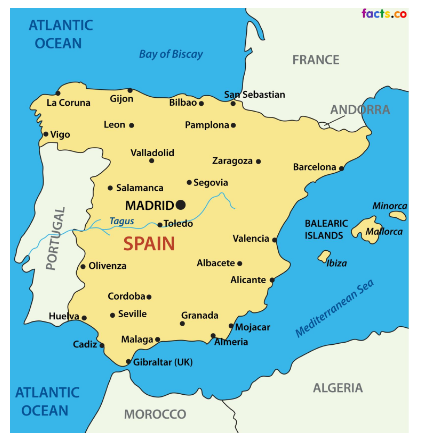
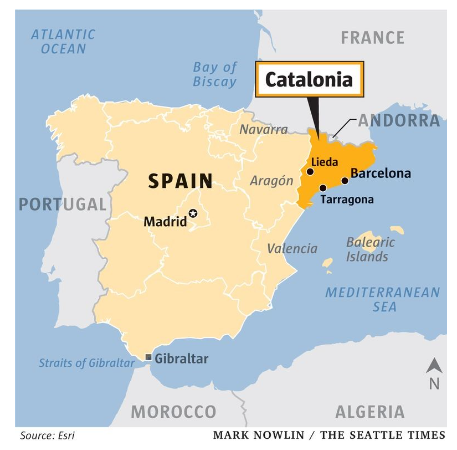
Fifth International Conference on Chemicals Management – Bonn
In News: Delegates at a United Nations (UN) Conference in the German city of Bonn adopted a new global framework to reduce environmental risks from chemicals and waste on September 30, 2023.
About Bonn
Bonn is located on the Rhine River, about 24 km south of Cologne. From 1949 to 1990 it was the provisional capital of West Germany, and it served as the seat of the German federal government from 1990 until 1999–2000, when the government completed its move to Berlin (designated the capital in 1991).
- Convention on Migratory Species (UNEP/CMS) – Bonn Convention
- International Conference on Chemicals Management – Bonn
About Germany
- Germany is bounded at its extreme north on the Jutland peninsula by Denmark.
- East and west of the peninsula, the Baltic Sea and North Sea coasts, respectively, complete the northern border.
- To the west, Germany borders The Netherlands, Belgium, and Luxembourg; to the southwest it borders France.
- Germany shares its entire southern boundary with Switzerland and Austria. In the southeast the border with the Czech Republic corresponds to an earlier boundary of 1918, renewed by treaty in 1945.
- The easternmost frontier adjoins Poland along the northward course of the Neisse River and subsequently the Oder to the Baltic Sea.
Important Location to remember:
- Country Share Land Border with Germany
- County share their border with Baltic Sea
- Riven on which Bonn Located
The EU Member States – Denmark, Sweden, Finland, Estonia, Latvia, Lithuania, Poland and Germany – and Russia are all directly bordering the Baltic Sea.
Pnemonics to learn Baltic sea Countries: RUDE Germany SELL Poland and Finland.
RU – Russia, DE- Denmark, Germany, S- Sweden, E- Estonia,L- Latvia, L – Lithuania,Poland and Finland
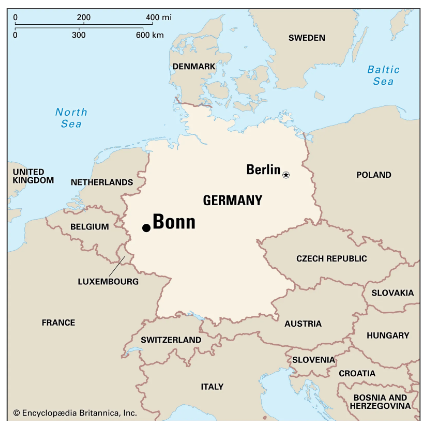
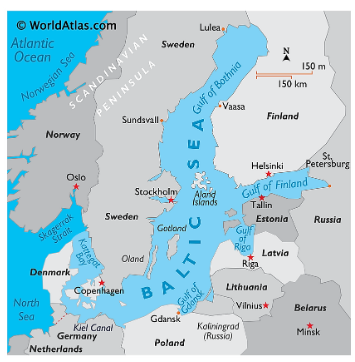
Kosovo-Serbia Conflict - Edukemy Current Affairs
In News: Serbian protesters and NATO (North Atlantic Treaty Organization) peacekeepers recently clashed in Kosovo, leading to more than 60 injuries. It is the most serious violence seen in the region in over a decade.
Geography:
- Serbia: Serbia is a landlocked country in eastern Europe that shares borders with Hungary, Romania, and Bulgaria.
- Kosovo: Kosovo is a small landlocked region that lies to Serbia’s southwest, sharing borders with North Macedonia, Albania, and Montenegro. Many Serbs consider Kosovo the birthplace of their nation.
- Kosovo declared independence from Serbia in 2008, but Serbia does not recognize Kosovo’s statehood.
Important Location to remember:

- Kosovo
- Rudare
- Mitrovica
- Pristina
- Tirana
- Montenegro
- Leposavic
- Zubin Potok
- Prizren
Other
- Countries boundary Adriatic Sea
- Country Boundary Serbia
- Why Serbia-Kosovo were in news?
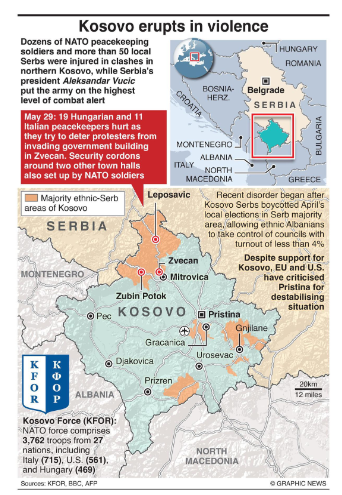
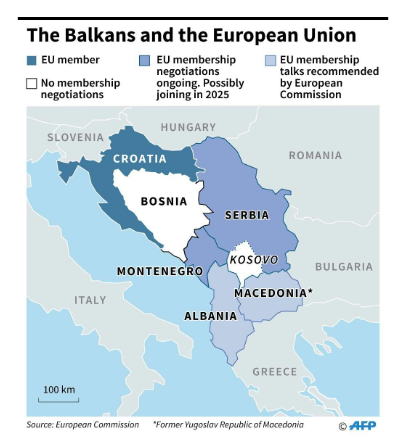
Turkey-Syria Conflict
In News: Turkey steps up strikes on militants as conflict escalates in Syria. Turkish security forces attacked Kurdish militants in northern Syria and eastern Turkey, and Ankara said it will continue to destroy their capabilities across the region as conflict escalated on Friday nearly a week after a bomb attack in Ankara.
Important Location to remember
- Euphrates River
- Aleppo
- Raqqa
- Deir al-Zour
- Damascus
Other
- Countries Boundary Syria and Turkey
- Country Boundary Black Sea
- Pnemonics – GTRBRU
- Georgia, Turkey, Russia,Romania, Bulgaria, Ukraine
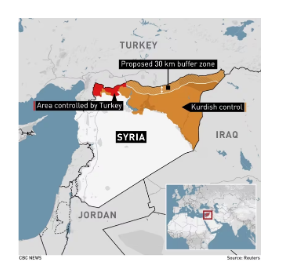
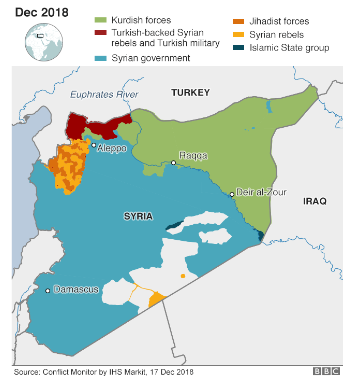
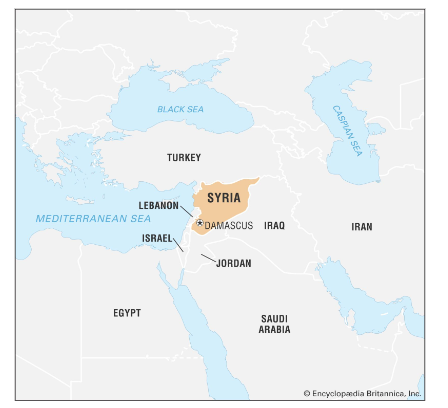
Asian Games – Hangzhou, China
Recently, the 19th Asian Games (of 2022, held in 2023) came to a close at the Hangzhou Olympic Sports Centre Stadium (also called Big Lotus) in China. Hockey player PR Sreejesh was India’s flagbearer at the parade of athletes.
- The 20th Asian Games will be held in Japan in 2027.
What are the Key Highlights of Asian Games 2023?
- India’s Milestones:
- India’s Medals Tally:
- With an unprecedented haul of 107 medals (28 gold, 38 silvers and 41 bronze), India set a new benchmark for themselves at the Asian Games 2023 in Hangzhou, the People’s Republic of China.
- At the 2018 Asian Games in Jakarta, India performed well and returned with 70 medals, including a haul of 16 gold medals.
- It was the first time in Asian Games history that India’s medals tally crossed the three-figure mark. By doing so, they became the only fourth country after China (383), Japan (188) and the Republic of Korea (190) to win 100 or more medals in a single edition of the Asian Games.
- With an unprecedented haul of 107 medals (28 gold, 38 silvers and 41 bronze), India set a new benchmark for themselves at the Asian Games 2023 in Hangzhou, the People’s Republic of China.
- Athletes Performance:
- Athletics turned out to be the most productive sport with a total of 29 medals - six gold, 14 silver and nine bronze.
- Hockey:
- The India men's hockey team won an Asian Games gold and booked a Paris Olympics berth with a 5-1 thrashing of Japan.
- India’s Medals Tally:
- Introduction of New Sports:
- 2023 Games saw two medal sports make their debut: e-Sports and Breakdancing.
- Apart from them, Cricket, and board games - Go, Xiangqi, and Chess returned to Asian Games in this edition after not featuring in the 2018 Asiad.
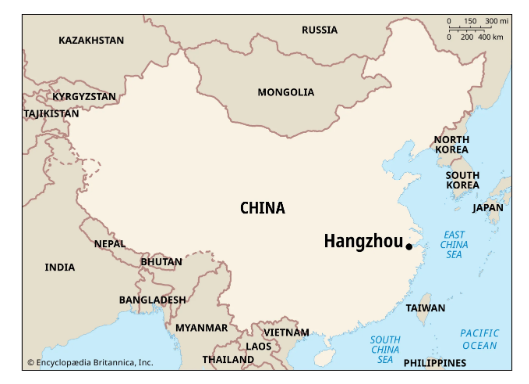
Location in News - India
- Surat - Gujarat - Kakrapar Nuclear Power Plant
- Shivamoga – Karnataka – Asiatic Wild Dog
- Kole Wetlands – Kerala – Threat to Alien Plants
- Purana Qila – Delhi – Excavations
- Bhojwetlands – Madhya Pradesh – Ban cruise boats
- Nadugani and Nilgiris – TamilNadu – Lion Tailed Macaques
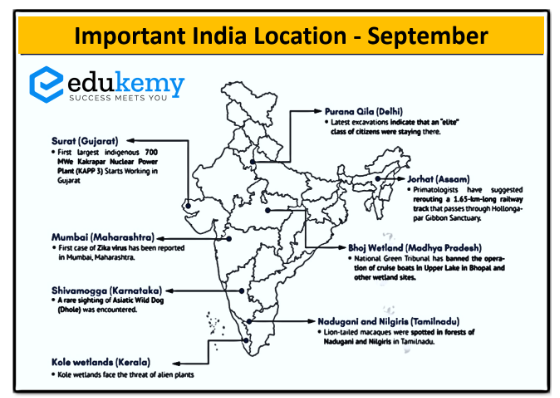
Share the article
Get Latest Updates on Offers, Event dates, and free Mentorship sessions.

Get in touch with our Expert Academic Counsellors 👋
FAQs
UPSC Monthly Current Affairs refers to a compilation of relevant and significant news, events, and developments from various fields that are important for the UPSC (Union Public Service Commission) civil services examination. This curated collection helps aspirants stay updated with recent happenings, enhancing their knowledge and analytical skills, which are crucial for various stages of the UPSC exam, including the Preliminary, Main, and Interview rounds.
UPSC Monthly Current Affairs plays a crucial role in UPSC preparation as it helps aspirants cover a broader range of current affairs topics within a specific time frame. By reviewing monthly current affairs, aspirants can gain a deeper understanding of significant events and issues, analyze their implications, and connect them with the UPSC syllabus. It aids in building a holistic perspective and enhances the ability to answer questions effectively.
UPSC Monthly Current Affairs provides a comprehensive overview of important events and developments across various domains. It covers national and international news, government policies, economic updates, scientific advancements, environmental issues, social issues, sports events, cultural festivals, and more. The content typically includes summaries, analysis, infographics, and practice questions to facilitate effective learning and revision.
You can access UPSC Monthly Current Affairs through various sources and platforms:
- Online Education Websites: Websites like Edukemy, Unacademy, BYJU'S, and others often provide monthly current affairs compilations tailored specifically for UPSC aspirants.
- Newspapers and Magazines: Reputed newspapers like The Hindu, The Indian Express, and magazines like Yojana and Kurukshetra provide comprehensive coverage of current affairs. Many coaching institutes also compile and publish monthly magazines focusing on UPSC-related current affairs.
- Mobile Apps: There are dedicated mobile apps that are available on platforms like Google Play Store and Apple App Store that provide UPSC-focused current affairs content. Edukemy's app is the best in the industry for current affairs preparation.
- YouTube Channels and Podcasts: Many educators and institutes have YouTube channels and podcasts that discuss and analyze current affairs topics relevant to the UPSC exam. Visit Edukemy's YouTube channel and get covered with all the current affairs required for UPSC preparation.
- Coaching Institutes: Many offline and online coaching institutes like Edukemy offer UPSC Monthly Current Affairs as part of their study materials or subscription plans.
When accessing UPSC Monthly Current Affairs, ensure that the content is reliable, well-researched, and covers a wide range of topics relevant to the UPSC syllabus. It's essential to stay updated with national and international developments, government policies, socio-economic issues, and more to excel in the UPSC exam.


